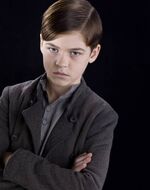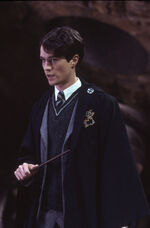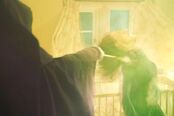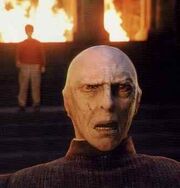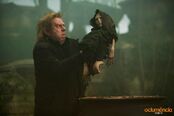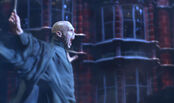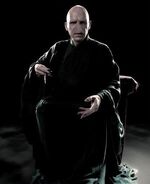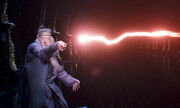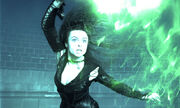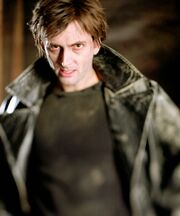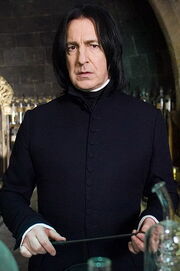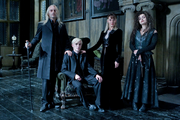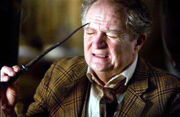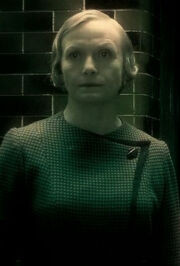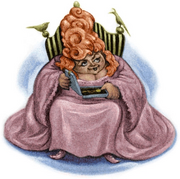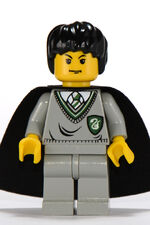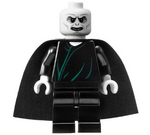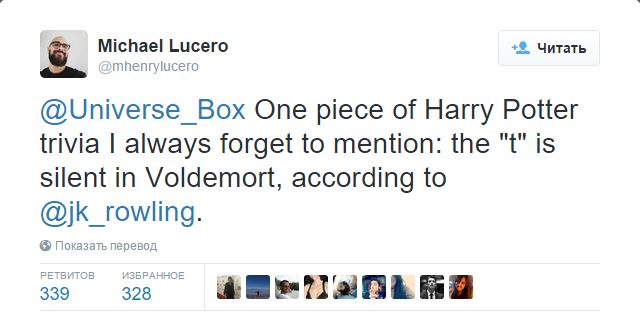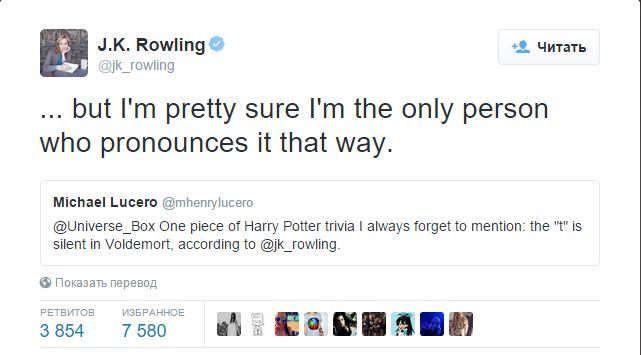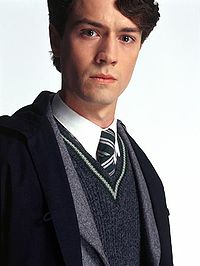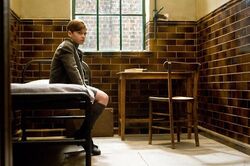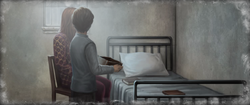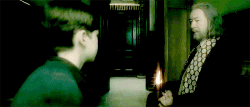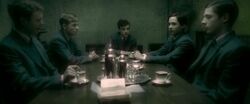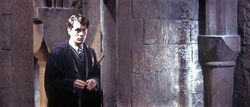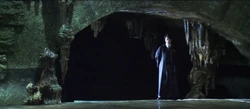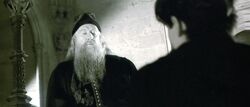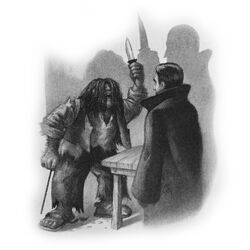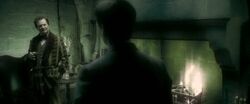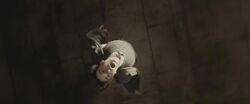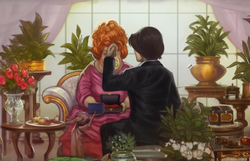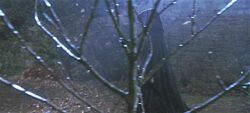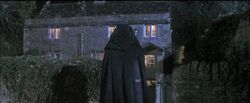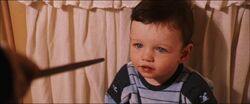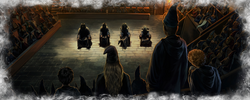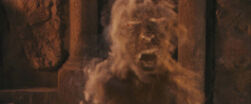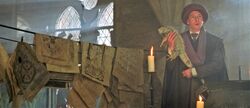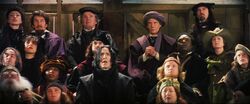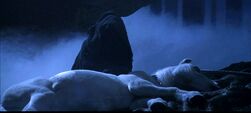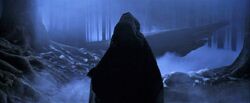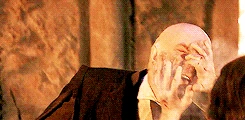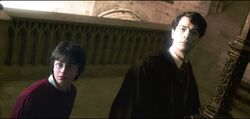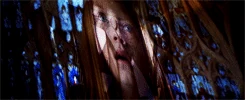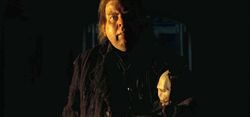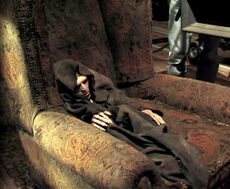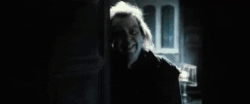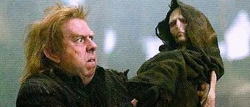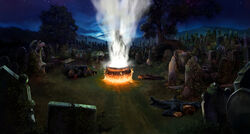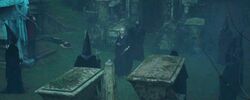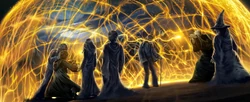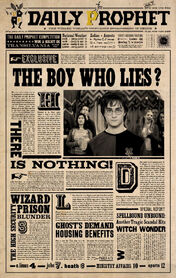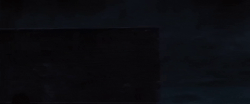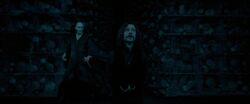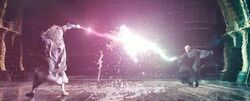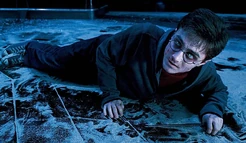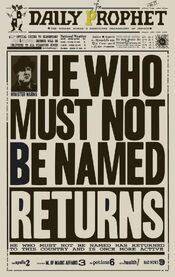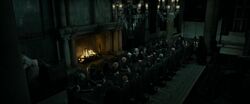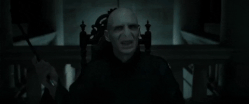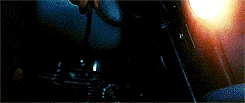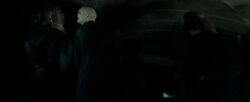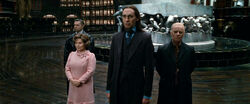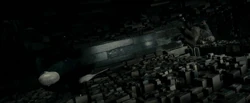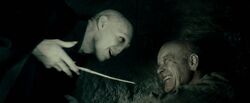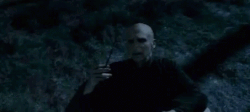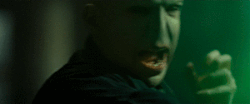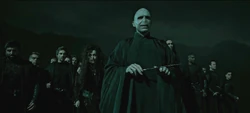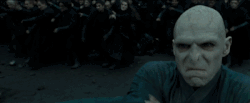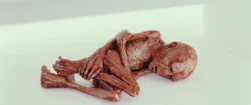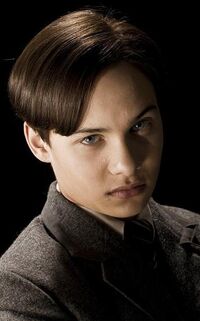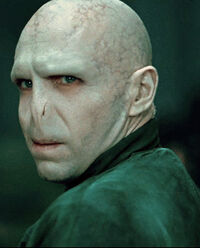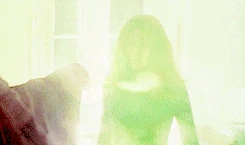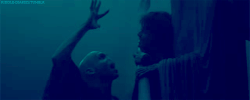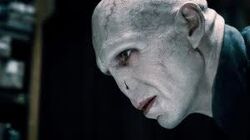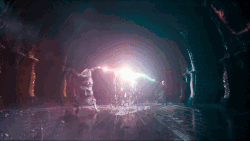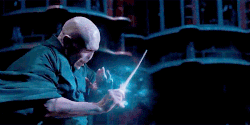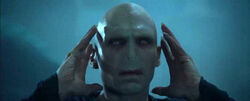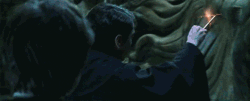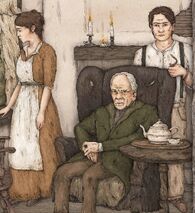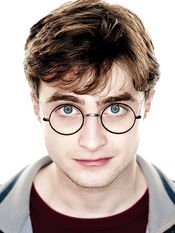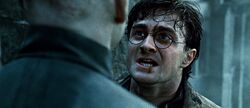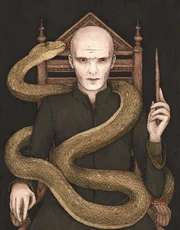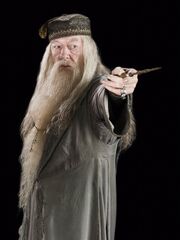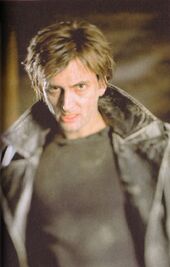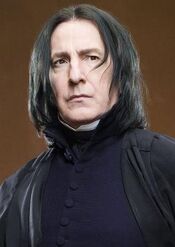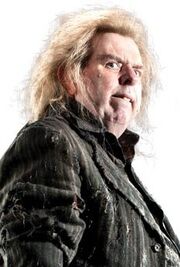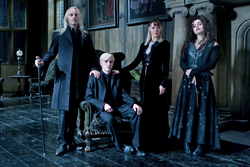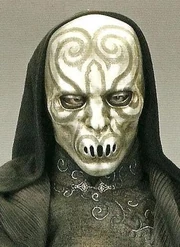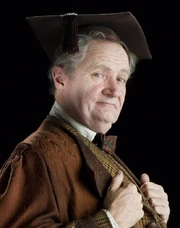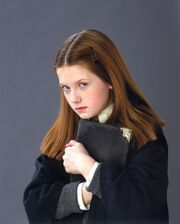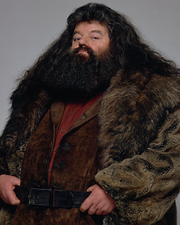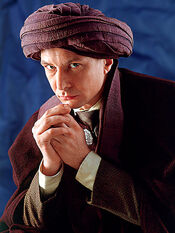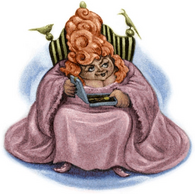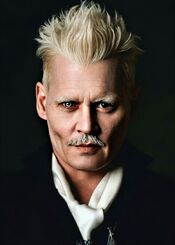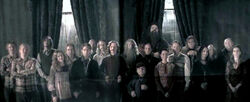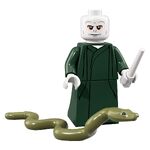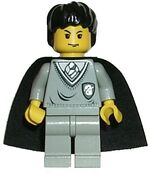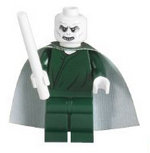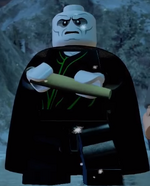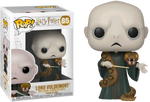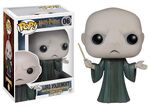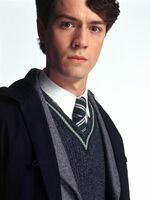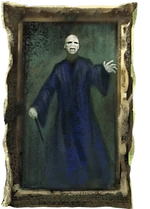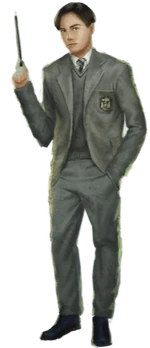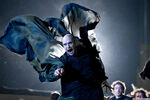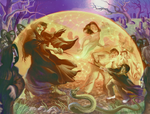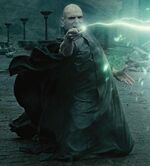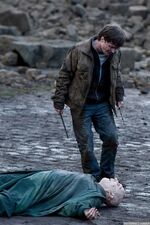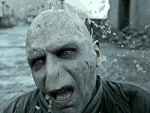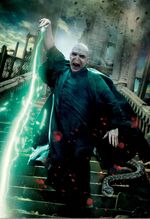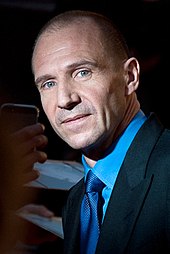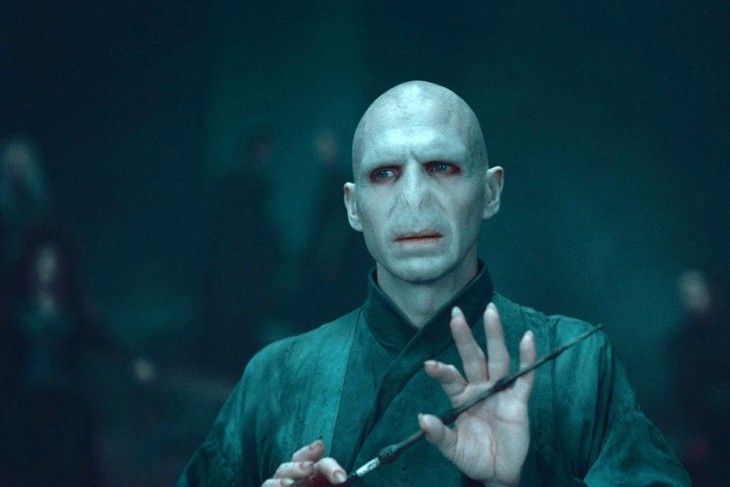
|
Внимание!
Информация в этой статье (или разделе) содержит спойлеры из пьесы «Гарри Поттер и Проклятое дитя»! |
[Просмотр]
| Теперь тебе всё понятно? Я так называл себя еще в Хогвартсе, естественно, лишь среди самых близких мне друзей. Я не собирался вечно носить имя этого ничтожества, моего магловского папочки. Я, в чьих жилах с материнской стороны течет кровь великого Салазара Слизерина! Называться именем вульгарного магла, который отказался от меня еще до моего рождения, обнаружив, что его жена, видите ли, колдунья? Ну уж нет! И я, Гарри, создал себе новое имя. Я знал: наступит день, и это имя будут бояться произносить все волшебники, потому что я стану самым великим магом мира! |
Трансформация Тома Реддла в лорда Волан-де-Морта
Том Марволо Реддл (англ. Tom Marvolo Riddle) — главный антагонист в серии романов о Гарри Поттере; тёмный волшебник, обладающий огромной магической силой и практически достигший бессмертия при помощи чёрной магии, а точнее — с помощью Крестражей. В волшебном мире больше известен как Лорд Волан-де-Морт (англ. Lord Voldemort).
Его боятся до такой степени, что даже имя его, как правило, не произносят. Большинство героев называют его «Сам-Знаешь-Кто» или «Тот-Кого-Нельзя-Называть», а его последователи, Пожиратели смерти, называют его «Тёмный Лорд», а обращаются к нему «Повелитель».
Гарри Поттер, однако, не боялся произносить его имя изначально, потому что вырос среди маглов и впервые услышал о Волан-де-Морте только в одиннадцать лет. Он не знал о его злодействах и не обладал предубеждениями, присущими большинству. Позже, в кругу других волшебников, уважая их чувства, он называет Тёмного Лорда «Сами-Знаете-Кто», но в конце концов, следуя примеру Дамблдора, всё же берёт себе за правило всегда называть его по имени. Со временем, с некоторой опаской, его примеру следуют Гермиона Грейнджер и Джинни Уизли. Некоторые члены Ордена Феникса, например Сириус Блэк, Римус Люпин и Альбус Дамблдор, всегда без каких-либо колебаний называли полное имя Волан-де-Морта.1
Биография
Происхождение
Том Реддл является полукровкой. Он сын чистокровной волшебницы Меропы Мракс и магла Тома Реддла-старшего, которые были официально женаты. Однако, отец Тома находился под воздействием любовного зелья, которым его поила Меропа. И когда жена, забеременев, перестала опаивать Тома Реддла-старшего, он мгновенно охладел к ней и бросил без средств к существованию и её, и ещё не родившегося сына.
С материнской стороны Том Марволо Реддл является прямым потомком одного из четырёх сооснователей Хогвартса Салазара Слизерина и легендарного Кадма Певерелла. Что добавило Тому веса в собственных глазах: ведь Слизерины и Певереллы — древнейшие роды волшебников.
Рождение и детство
Том Марволо Реддл родился поздно вечером 31 декабря 1926 года в Лондоне, в сиротском приюте, куда из последних сил добралась его мать, Меропа Мракс. Через час после рождения малыш стал сиротой. Перед смертью мать успела сказать сёстрам, принимавшим роды, что мальчика следует назвать Томом в честь его отца, и Марволо, в честь деда, а фамилию дать — Реддл. Поскольку оборванная нищенка не принесла с собой ни пенса, ребёнка растили и воспитывали исключительно на взносы благотворителей. Как, впрочем, и большинство воспитанников приюта миссис Коул.
Вскоре нянечки заметили странности у этого мальчика. Том с раннего детства почти не плакал, держался обособленно, и даже отчуждённо. И главное: со временем вокруг него стали происходить странные и страшные вещи. Поэтому, когда неизвестно откуда в приют пришёл необычно одетый человек и представился преподавателем некой школы, куда хотели принять Тома Реддла, миссис Коул была только рада.
Школьные годы. Учёба в Хогвартсе, 1938—1945
Том Реддл в возрасте 11 лет
1 сентября 1938 года Том при распределении попадает в Слизерин. Скоро он узнает, что легендарный основатель этого факультета, как и сам Том, умел разговаривать со змеями. Это подогревает его стремление узнать о своём происхождении. Считая, что мать, будучи волшебницей, ни за что бы не умерла такой молодой, даже ни чем в общем-то и не болея, он полагает магом своего отца. Позже Том проверяет фамилию «Реддл», но никаких упоминаний о волшебниках с такой фамилией не находит. Ему приходится признать, что его отец был маглом. Тогда он пытается узнать что-то о матери. Имея только одну зацепку, кроме владения языком змей — имя деда с материнской стороны «Марволо», Том выходит на семью Мраксов.
В школе Том был всегда со всеми вежлив, выдержан, учителя отмечали у этого красивого сироты искреннюю тягу к знаниям, это был лучший ученик не только на факультете, но и во всей школе. Постепенно вокруг него начала собираться довольно пёстрая толпа единомышленников самого разного возраста и склада характера. В школе начались разные, не слишком хорошие, нехорошие и откровенно ужасные происшествия (как, например, смерть когтевранки Миртл Уоррен). Но надёжно связать эти случаи с компанией Тома Реддла не удавалось: Лорд Волан-де-Морт (к тому времени он уже был известен среди своих под этим именем) держал своих людей в ежовых рукавицах, не позволяя ни на йоту нарушить школьные правила прилюдно, или навлечь на себя хоть тень подозрения. Многие из этих учеников впоследствии стали Пожирателями смерти.
Реддл активно интересуется Тёмными искусствами. Его познания шагнули так далеко, что уже на пятом курсе он не только узнаёт о крестражах — самой тёмной магии в мире, но и создаёт себе один из них. На шестом курсе он выведывает у профессора Слизнорта кое-какие подробности о возможности изготовления нескольких крестражей, но начальные знания Том почерпнул из древней книги «Тайны наитемнейшего искусства», хранившейся в запретной секции библиотеки Хогвартса. Позже Альбус Дамблдор, заняв пост директора, изъял её из библиотеки и спрятал в своём кабинете: не дело не окрепшим духовно студентам узнавать такие вещи.
Ещё учась в школе, Том Реддл познал вкус убийства. В июне 1943 года, под взглядом вызванного Томом василиска гибнет маглорождённая когтевранка Миртл Уоррен, а буквально через месяц Волан-де-Морт хладнокровно насылает смертоносное заклятье на родного отца, деда и бабушку. При этом виновным в их убийстве делает брата матери, предварительно ограбив его. Впрочем, пока что Том убивает не просто так, ради прихоти, а, так сказать, для пользы дела. Разорвав с помощью убийства свою душу, Реддл создаёт крестражи. Смерть Миртл послужила для создания крестража-дневника, а гибель отца и деда с бабкой позволили сделать крестраж из кольца Марволо Мракса.
Том Реддл в 16-летнем возрасте
Заметьте, юноше всего шестнадцать, а он способен на такую сильную магию. Да, пригласивший Реддла в свой «Клуб Слизней» профессор Слизнорт не ошибся: потенциал этого волшебника был поистине колоссальный.
После школы
По окончании Хогвартса в начале лета 1945 года Том Реддл попытался получить работу преподавателя в этой школе. Но директор Диппет по совету Альбуса Дамблдора отклонил его кандидатуру, мотивируя слишком юным для профессора возрастом Тома. Тогда Реддл, ко всеобщему удивлению, поступает на работу в лавку «Горбин и Бэркес». В его обязанности входит личная встреча с потенциальными клиентами магазина и переговоры о купле-продаже различных артефактов. Нередко Том приходил в дом к волшебнику, чтобы уговорить его продать по сходной цене ту или иную вещицу в «Горбин и Бэркес». Такая, казалось бы, непрестижная работа давала мистеру Реддлу и широкую сеть знакомств, и допуск к самым различным раритетам волшебного мира, даже если эти вещи никогда не были ни проданы, ни выставлены на всеобщее обозрение. Умеющий, если это нужно, расположить к себе любого, Волан-де-Морт всегда добивался желаемого. Увлечённый идеей о крестражах, он выискивает артефакты, связанные с именами основателей Хогвартса, и у одной из клиенток «Горбина и Бэркес» находит два из них: Медальон Слизерина и Чашу Пуффендуй. Втеревшись в доверие к хозяйке этих вещей, он убивает её, сваливает вину на её домового эльфа и крадёт Медальон и Чашу.
Начало активной деятельности
Вскоре после убийства и кражи Волан-де-Морт увольняется из «Горбин и Бэркес» и отправляется в путешествие, в котором встречается с тёмными магами и усиленно изучает Тёмные искусства. Он собрал своих старых последователей, которые стали называть себя Пожирателями смерти[17]. Также Волан-де-Морт продолжал делать крестражи. Втайне он сделал пять крестражей, таким образом изорвав и искалечив свою душу до такой степени, что это повлияло даже на его внешний облик. По возвращении из странствий, по расчётам, зимой 1968-69 года, он пришел к Дамблдору, к тому времени ставшему директором, в Хогвартс, проситься на место преподавателя.
| В комнату вошел Волан-де-Морт. Черты его были не теми, какие почти два года назад явились Гарри в большом каменном котле, в них было меньше змеиного, глаза пока еще не так сильно отливали багрецом, да и само лицо не превратилось в маску. И все же оно не было больше лицом красавца Тома Реддла. Это лицо казалось обожженным, черты утратили резкость, стали словно восковыми, перекошенными; белки глаз теперь уже навсегда налились кровью, хотя зрачки и не превратились пока в узкие щели, какими (как было известно Гарри) им предстояло стать. Длинная черная мантия окутывала Волан-Де-Морта, а лицо его было таким же белым как снег, поблескивавший у него на плечах. |
В 1970 году началась Первая война волшебников. Началось всё точечными исчезновениями волшебников, которые мешали Волан-де-Морту и его приспешникам. Постепенно противостояние набирало обороты. Пожиратели Смерти начали направо и налево убивать маглов и вступавшихся за них волшебников. Жертвой слуг Тёмного Лорда мог стать любой. Волшебное сообщество сначала было шокировано появлением этой банды и не сразу среагировало на её преступления. Только когда на сторону Волан-де-Морта переметнулись великаны, оборотни и другие недобрые создания, маги поняли: это не просто бандитский беспредел, это — война.
Поначалу организованное сопротивление оказал только созданный Альбусом Дамблдором Орден Феникса, но впоследствии и Министерство магии смогло дать достойный отпор. Особенно после того, как Отдел магического правопорядка возглавил Барти Крауч.
Исчезновение
Волан-де-Морт убивает Лили Поттер
Волан-де-Морт неожиданно узнал от своего верного сторонника Снегга часть пророчества, где говорилось о мальчике, который родится в конце июля и в будущем одолеет Тёмного Лорда. Под описание подходили два младенца: родившийся 30 июля 1980 года Невилл Долгопупс и появившийся на свет днём позже Гарри Поттер. Волан-де-Морт решил, что в пророчестве говорилось о втором мальчике, и решает убить его, пока тот ещё в колыбели. Однако в ночь на 31 октября 1981 года Волан-де-Морту не удалось убить Гарри из-за того, что мать Гарри не отошла с дороги, как ей предлагал Волан-де Морт, и тем самым добровольно принесла себя в жертву ради сына, дав ему древнюю жертвенную материнскую защиту. Заклинание Авада Кедавра отрикошетило от мальчика и попало в Волан-де-Морта. При этом часть души Тёмного Лорда откололась и проникла в Гарри. Так Гарри стал шестым крестражем.
Том Реддл
Попытки возвращения
-
Волан-де-Морт в Подземельях Хогвартса
Волан-де-Морт ушёл в леса Албании. Там он скрывался до 1991 года, постоянно пытаясь вернуть себе тело и магическую силу. Но ему это не удавалось: бестелесному Тёмному Лорду нужна была помощь, а бывшие соратники либо сидели в Азкабане, либо наслаждались мирной жизнью, успешно доказав свою непричастность к преступлениям Волан-де-Морта. Максимум, на что сейчас хватало сил Тому Реддлу — это овладеть телом какой-нибудь мелкой зверюшки, но и та быстро погибала.
Наконец Волан-де-Морту повезло: в его леса забрёл Квиринус Квиррелл — молодой преподаватель Хогвартса. Молодой, доверчивый, наивный. Как раз такой, которого легко взять под контроль, и который будет выполнять все указания Хозяина. Квиррелл привозит Тёмного Лорда в Лондон, где пытается похитить из Гринготтса философский камень.
После неудачи (как раз за пару часов до этого Рубеус Хагрид забрал камень) Волан-де-Морт вселяется в Квиррелла, чтобы самолично присматривать за слугой. Однако в конце учебного года, когда первокурсник Гарри Поттер увидел истинное обличье профессора, Квиррелл сгорел от руки Гарри (сработала защита крови матери) и Волан-де-Морт покинул его тело. Он возвратился в своё прежнее укрытие.
Незадолго до гибели тела Волан-де-Морт доверил свой первый крестраж — дневник — Люциусу Малфою. Однако честолюбивый Малфой решил занять кресло директора Хогвартса, а заодно — опозорить семью своего давнего недруга Артура Уизли. Не зная о том, что это крестраж, Малфой подсунул дневник дочери Артура, Джинни. Девочка, вкладывая свою душу в дневник, постепенно слабела, а Реддл-из-дневника набирал силу. В конце учебного года он уже вышел из дневника и едва не погубил Джинни. Однако Гарри Поттер в очередной раз схватился с юным Волан-де-Мортом и уничтожил дневник. Так Тёмный Лорд вновь потерпел фиаско.
Возрождение
В течение 1993-1994 годов Волан-де-Морт по-прежнему скрывался в лесах Албании. Но в 1994 году к нему добрался его трусоватый слуга Питер Петтигрю, который начал помогать ему в подготовке к обряду возрождения.
Волан-де-Морт, составляя очередной маниакальный план, включил в него и своего заклятого врага — подросшего к тому времени Гарри Поттера. Для этого он послал в Хогвартс своего верного слугу Барти Крауча-младшего, а сам, заняв дом отца в Литтл-Хэнглтоне (того самого отца, которого убил в шестнадцатилетнем возрасте), начал набираться сил. С помощью змеи Нагайны[19] и различных зелий, которые готовил для него Петтигрю, он укреплял своё хлипкое тельце, в котором влачил на тот момент своё жалкое существование. В это же время он создаёт последний крестраж — помещает часть своей души в змею Нагайну. По плану Волан-де-Морта Барти Крауч-младший должен был обеспечить участие и победу Гарри Поттера в Турнире Трёх Волшебников, превратить Кубок Турнира в портал и доставить мальчишку Тёмному Лорду. Ведь в соответствии с обрядом возрождения надо было сварить зелье, в которое входили бы кровь врага, кость отца и плоть слуги. Врагом, от которого Тёмный Лорд хотел получить кровь, должен был стать Гарри Поттер.
24 июня 1995 года, в день третьего и последнего состязания Турнира Трёх Волшебников, Тёмный Лорд соединил все три элемента и наконец-то возродился, обретя тело. К нему вернулась вся магическая мощь, которую он когда-то потерял, и кроме того, он мог теперь преодолеть заклятие Жертвы, защищавшее прежде Гарри. Но радость его была омрачена тем, что Поттер в очередной раз ускользнул от него, воспользовавшись очередной неучтённой Тёмным Лордом магической особенностью.
Подчинение магического сообщества
- Начиная с 1995 года Волан-де-Морт стал подчинять себе магов и склонять к сотрудничеству различных тёмных созданий. Но в первую очередь он решил докопаться до истинного смысла пророчества. Для этого он хотел узнать его полностью, догадываясь, что упустил что-то очень важное. Однако все попытки извлечь запись пророчества из Отдела тайн не увенчались успехом: её мог взять из архива только тот, о ком говорится в пророчестве. То есть либо сам Тёмный Лорд, либо Гарри Поттер. Тогда Волан-де-Морт через имеющуюся с мальчиком связь посылает тому ложные видения, с помощью которых ему удалось заманить Гарри в Отдел тайн, где за нужную запись пророчества началась настоящая битва. Но сражение закончилось для Волан-де-Морта неудачей: пророчество в пылу сражения разбилось, а Пожиратели были арестованы. Более того, министр магии Корнелиус Фадж своими глазами увидел Волан-де-Морта и наконец-то поверил в его возвращение, от чего отрекался весь прошлый год.
Волан-де-Морт сражается с Дамблдором в атриуме Министерства магии
Исподволь Волан-де-Морт укрепляет свои позиции. Для начала он приказал Драко Малфою убить Дамблдора. Кстати, прекрасно понимая, что миссия Малфою-младшему не по плечу. По правде говоря, Дамблдора Тёмный Лорд планировал убить попозже. Сначала «наказать» Драко за невыполненное задание (а на самом деле — наказать его отца за проваленную миссию в Министерстве). А потом поручить это дело Северусу Снеггу. Снегг говорит об этом с Дамблдором ещё в июле 1996 года. Поэтому они договариваются о том, что Дамблдора убьёт Снегг вместо Малфоя. Тем более, что старый директор смертельно болен и к концу учебного года, так или иначе, умрёт.
Обо всём этом Волан-де-Морт не знает: Снегг великолепно играет свою роль двойного агента. Поэтому Тёмный Лорд принимает известие о смерти Дамблдора с удовлетворением.
В течение года Тёмный Лорд сам и с помощью Пожирателей вербует новых сторонников. Одни — (дементоры и оборотни) — идут к нему сами, других же (великаны) надо обольщать и уговаривать… Некоторые маги примыкают к Волан-де-Морту по своей охоте, других заставляют шантажом, третьих вербуют, предварительно наложив на них заклятие «Империус». В последнем случае самым значимым «приобретением» был крупный министерский чиновник Пий Толстоватый. После переворота в Министерстве магии и убийства министра Скримджера он занимает пост министра магии и по сути становится главой марионеточного правительства.
Поиски непобедимой волшебной палочки и смерть
Постоянные неудачи в поединках с Поттером побудили Волан-де-Морта искать волшебную палочку получше. От похищенного мастера Олливандера он узнаёт о том, что его палочка и палочка Поттера — близнецы, и очень неохотно сражаются друг с другом. Но и «взятая напрокат» палочка Люциуса Малфоя не только не смогла убить Поттера, но и была уничтожена в бою неизвестным заклинанием, произвольно выпущенным палочкой Гарри.
Волан-де-Морт допрашивает Грин-де-Вальда
Продолжая пытать Олливандера, Волан-де-Морт добывает у него сведения о существовании древней непобедимой Бузинной палочки и начинает усиленно её искать. Он убивает бывших владельцев палочки — Грегоровича и Грин-де-Вальда и, наконец, выйдя на её след, похищает палочку из гробницы Дамблдора.
При этом Волан-де-Морт не оставляет надежды поймать Гарри Поттера и убить его. Все люди Тёмного Лорда предупреждены: жизнь Поттера принадлежит Хозяину, его убивать нельзя! Несколько раз Пожиратели смерти были очень близки к тому, чтобы доставить Волан-де-Морту Гарри Поттера:
- Торфинн Роули и Антонин Долохов чуть было не поймали Гарри Поттера, Рона Уизли и Гермиону Грейнджер в кафе, определив их местоположение с помощью заклятия Табу.
- Также с помощью Табу егеря взяли в плен Золотое Трио и доставили в поместье Малфоев. Лишь наличие у ребят меча Гриффиндора помешало Беллатрисе Лестрейндж вызвать Волан-де-Морта немедленно. Этого хватило, чтобы ребята устроили побег.
- В гостиной Когтеврана Алекто Кэрроу поймала Поттера и даже вызвала Волан-де-Морта с помощью Чёрной Метки. Тёмный Лорд был в это время занят, да и ложных вызовов уже накопилось достаточно, поэтому он не стал спешить на зов. Тем более, что приближалась развязка их противостояния.
Волан-де-Морт на магической дуэли с Гарри Поттером
Позже Волан-де-Морт узнал, что пока он выискивал Бузинную палочку, Поттер охотился за его крестражами. Поиски Бузинной палочки Волан-де-Мортом с одной стороны, и не менее активные поиски крестражей Гарри Поттером с другой, привели обе стороны к замку Хогвартс, где между армией Волан-де-Морта и защитниками Школы разгорелась финальная битва. На момент открытого сражения между Поттером и Реддлом все крестражи Тёмного Лорда были уничтожены и юноше удаётся победить самого страшного тёмного мага XX века. Нельзя сказать, что именно Поттер убил Волан-де-Морта, поскольку Тёмный Лорд умер от собственного (правда, отражённого Гарри) заклятия «Авада Кедавра».
Внешний вид и личные качества
По описаниям, у возродившегося Волан-де-Морта очень бледная кожа, белое как мел и похожее на череп лицо, ноздри как у змеи, красные глаза с вертикальными зрачками, высокое скелетоподобное тело и длинные тонкие руки с неестественно длинными пальцами. Ранее, во время обучения в Хогвартсе, он был описан как очень привлекательный молодой человек с аристократической осанкой, с тонкими чертами лица, впалыми щеками, тёмными глазами и чёрными волосами. Альбус Дамблдор считает, что такие значительные изменения во внешности имели причиной поступки и деяния самого Тома: «С годами лорд Волан-де-Морт все больше утрачивал человеческий облик, и происходившие с ним превращения имели только одно объяснение: увечность его души вышла далеко за пределы того, на что способно обычное зло».
Волан-де-Морт ненавидит маглов и маглорожденных волшебников. Это тем более вызывает удивление, когда узнаёшь, что сам Волан-де-Морт — полукровка. Очевидно, обида на мать, которая смирилась со своей смертью и оставила своего новорождённого сына беззащитным в этом мире, и ещё большая обида на отца, который отказался от матери ещё до рождения ребёнка, сыграли свою роль в становлении этого отношения. Обида, что отец своим магловским происхождением «подпортил» такую блестящую родословную (как же, ведь Мраксы — прямые потомки самого Салазара Слизерина!). Обида, что мать дала ему такое обычное имя, да ещё и в честь какого-то магла-отца, как бы перечеркнув яркую, неповторимую индивидуальность сына. Всё вместе побудило Тома Реддла выдумать себе звучное имя и всеми силами доказывать окружающим и себе самому, что маглов среди его предков не было. И быть не могло. В шестнадцать лет Том Реддл убил своего отца и его родителей и изменил своё имя, перейдя по анаграмме от имени «Том Марволо Реддл» к «Лорд Волан-де-Морт», видимо, психологически отказываясь таким образом от своего происхождения. Хотя сам факт своего полукровия Волан-де-Морт не скрывал: он публично говорит об отце-магле и вызывает всех своих пожирателей прямо на его могилу.
Волан-де-Морт продвинулся в изучении магии, особенно в области Тёмных искусств, возможно, глубже, чем кто-либо из ныне живущих волшебников. Но в двух случаях, по его словам, он не смог вспомнить вовремя о важных вещах — о лечебном действии слёз феникса, плакавшего над Гарри в Тайной комнате, и о силе древней магии, связанной с любовью и самопожертвованием (вещи, недоступные его пониманию — по мнению Дамблдора).
Между судьбами Тома Реддла и Гарри Поттера можно заметить много общего — оба сироты, росли среди маглов не в самых удачных условиях, пока не были приняты в Хогвартс, который оба стали считать своим домом. У обоих персонажей чёрные волосы, тонкие черты лица и способность разговаривать со змеями. Это иллюстрирует одну из идей серии, высказанную Дамблдором, о том, что сущность человека определяется его выбором, а не его способностями.
Автор серии книг о Гарри Поттере, Джоан Роулинг, предположила, что главный страх Волан-де-Морта — «унизительная смерть», а его боггартом будет собственное безжизненное тело. В зеркале Еиналеж, показывающем самое горячее желание смотрящего, он бы увидел себя всемогущим и бессмертным. Дамблдор предполагал, что Волан-де-Морт тайно боится трупов и темноты, впрочем, по его словам, «в таких случаях мы боимся лишь неизвестности». Как выяснилось во время сражения в Министерстве Магии, Волан-де-Морт не может понять, что бывают вещи хуже смерти.
Если говорить о личных качествах, Волан-де-Морта можно назвать осторожным, сообразительным и спокойным стратегом. На четвёртом и пятом году обучения Гарри Поттера в Хогвартсе Волан-де-Морт планировал длительные, рассчитанные на целый год операции: первая была связана с его возвращением в тело, вторая — с вторжением в Отдел тайн Министерства Магии.
Волан-де-Морт, так боящийся собственной смерти, абсолютно равнодушен к чужой. Он убивает с поразительной лёгкостью, особенно, если человек ему больше не может пригодиться. Это отсутствие элементарного сочувствия к кому бы то ни было шокирует даже его последователей.
Магические способности
Уже в детстве маленький Том наводил страх на других жителей приюта.
Судя по воспоминанию Дамблдора, в котором Гарри побывал на шестом году своего обучения в Хогвартсе, Волан-де-Морт с самого детства демонстрировал выдающиеся магические способности. С довольно раннего возраста, ещё не зная, что он волшебник, Том Реддл вполне сознательно экспериментировал с магией, не зная о том, что эти его необычные способности — именно магия. Он умел перемещать предметы, не дотрагиваясь до них, а также управлять животными без предварительной дрессировки и организовывать неприятные ситуации для детей из приюта, которые имели неосторожность чем-то ему не угодить.
Поступив в Хогвартс, Том Реддл спрятал и свою неприязнь к людям, и свою гордыню, и многие другие отрицательные качества, как кошка прячет когти. Он становится лучшим учеником Хогвартса, старостой факультета Слизерин, позже — старостой школы, а учителя отмечали его одарённость, вежливость и стремление к знаниям. Когда это было ему выгодно, Том мог очаровать кого угодно. Это внешнее впечатление не могло обмануть только Дамблдора. Но, пока всё было в рамках приличия, он лишь приглядывал за Томом.
Волан-де-Морт известен как величайший из легилиментов и окклюментов мира — то есть, он лучше других умеет проникать в чужой разум и защищать свой от внешнего вторжения. При помощи легилименции Волан-де-Морт почти всегда может определить, лгут ему или нет. Легилименты видят в сознании других эмоции и обрывки воспоминаний, которые могут противоречить словам, сказанным человеком. Противостоять легилименции можно только при помощи специальной методики защиты своих мыслей — окклюменции, которой тоже в совершенстве владеет Волан-де-Морт.[21]
Том призывает Василиска на парселтанге
Также Волан-де-Морт умеет разговаривать со змеями на змеином языке — он «змееуст». Эта способность досталась ему от Салазара Слизерина. Обычно маги связывают это умение со склонностью к тёмной магии. Хотя Альбус Дамблдор вскользь замечает, что змеиный язык не является неоспоримым признаком принадлежности волшебника к когорте Тёмных магов. Владение змеиным языком передалось также Гарри Поттеру после неудавшейся попытки Волан-де-Морта убить его. Дамблдор говорит, что в этой попытке Тёмный Лорд нечаянно передал Гарри часть своих умений и сил. Дамблдор говорит правду, хотя, по своему обыкновению, не всю… Во время этой попытки душа Волан-де-Морта неожиданно для него самого раскололась в очередной раз и часть её вошла в ребёнка, превратив его в крестраж. Таким образом, помимо знания и желания самого Тёмного Лорда, создалась очень крепкая и не имеющая аналогов связь между этими двумя людьми. Джоан Роулинг на одном из форумов обмолвилась, что после победы над Волан-де-Мортом Гарри перестал владеть языком змей.
Известно, что Волан-де-Морт — один из очень немногих тёмных магов, решившихся и сумевших создать крестражи. Это части души, отделённые и спрятанные тёмным магом для того, чтобы фактом их существования обеспечить себе бессмертие. Крестраж можно создать только совершив убийство и тем самым разорвав свою душу. Дамблдор также полагает, что Волан-де-Морт — единственный маг в истории, который создал более одного крестража.
Волан-де-Морт в дуэли с Гарри Поттером
Волан-де-Морт умело действует в дуэлях. Заклинания и контрзаклинания, превращение направленных против него объектов в другие, перемещение в пространстве — такие действия он выполняет за считанные секунды. Он умело трансгрессирует и способен летать даже без метлы. Также он мастер тёмной магии и сильнейший тёмный колдун XX века. Считается, что по уровню владения магией он может сравниться только с Альбусом Дамблдором. Сам Дамблдор утверждал, что самые сложные его заклинания окажутся бесполезными, если Волан-де-Морт вернётся к своей прежней силе.
Взаимоотношения
Семья
С первого дня своей жизни маленький Том Реддл остался без опеки родителей и близких. Очевидно, что в сиротском приюте он не нашёл друзей, к которым испытывал бы привязанность. Это значительно повлияло на дальнейшую жизнь юного волшебника. Не познавший родительской заботы и ласки, мальчик вырастает жестоким и холодным, не способным к сильным чувствам — любви, дружбе, состраданию. И поэтому в шестнадцатилетнем возрасте Том хладнокровно убивает своих единственных родственников — отца, дедушку и бабушку.
Альтернативная реальность
Взрослый Волан-де-Морт не стал создавать семью так как, очевидно, что ни к одной из женщин он не испытывал сильных чувств. Хотя это не мешало ему состоять в интимных отношениях со своей самой верной сторонницей Беллатрисой Лестрейндж. Будучи бессмертным, Волан-де-Морт не горел желанием иметь детей, во всяком случае до Хэллоуина 1981 года. После своего возвращения Темный Лорд, похоже, передумал, поскольку незадолго до Битвы за Хогвартс у Беллатрисы и Волан-де-Морта родилась дочь Дельфи — очень магически сильная волшебница и наследница Салазара Слизерина, владеющая языком змей. Примерно в возрасте месяца-двух девочка потеряла обоих родителей, убитых в битве за Хогвартс, и была передана на воспитание Юфимии Роули.
В пьесе «Гарри Поттер и Проклятое дитя» упоминается, что вернувшись из Азкабана, Родольфус Лестрейндж, верный слуга Темного Лорда и преданный муж Беллатрисы, сообщил Дельфи, кто она такая, а также рассказал о пророчестве, которое предсказывало возвращение Тёмного Лорда. Дочь Волан-де-Морта захотела вернуть своего отца и почти преуспела, но была остановлена четырнадцатилетними Альбусом Северусом Поттером и Скорпиусом Малфоем, наряду с Гарри, Джинни, Роном, Гермионой и Драко в Годриковой впадине, 31 октября 1981 года, когда Дельфи собиралась подстеречь Тёмного Лорда и отговорить его от нападения на дом Джеймса и Лили Поттеров. Сам Волан-де-Морт в тот вечер так и не встретил свою взрослую дочь. Однако, в одной из альтернативных реальностей победивший Лорд воспитал дочь достойной наследницей, сделал её своей правой рукой с титулом «Авгурия Темного Лорда» и наделил большой властью в магической Британии.
Нагайна
Волан-де-Морт по-особому относился к Нагайне — змее, ставшей одним из его крестражей. Складывается впечатление, что Нагайна — единственное живое существо, к которому Темный Лорд действительно проявляет заботу, хотя, возможно, такое обращение обусловлено просто тем, что в Нагайне была запечатана часть души хозяина. Альбус Дамблдор предполагал, что подобное благодушие Волан-де-Морта в отношении к Нагайне подчеркивает его происхождение от Салазара Слизерина. Лорд тепло относился к змее, ласково обращаясь к ней на парселтанге и никогда не гневался на неё. Даже после того, как Нагайне не удалось задержать Поттера в Годриковой Впадине, Волан-де-Морт никак не наказал её. Тот же Дамблдор отмечал, что между Волан-де-Мортом и Нагайной слишком тесная связь, даже для змееуста.
Альбус Дамблдор
Дамблдор во время дуэли с Томом
Альбус Дамблдор — это единственный человек которого Волан-де-Морт не только боялся, но и по своему уважал, считал равным себе. И думается, причиной были не только непревзойдённые магические способности Дамблдора, а скорее то, что этот человек был единственным, кто дальше всех проник в его тайны, первым, кто смог бросить ему вызов, когда Волан-де-Морт начал действовать в открытую. Ещё в школе Дамблдор смог разглядеть в юном Томе Реддле черты жестокости, лицемерия, жажду власти. Но, с другой стороны, он ничего не сделал, чтобы мальчика остановить. Вероятно, эта ошибка и привела к тому, что в мире появился самый тёмный волшебник всех времён и народов — Волан-де-Морт. Дамблдор осознал свою вину и всю свою оставшуюся жизнь положил на исправление этой ошибки.
Гарри Поттер
По иронии судьбы, главным врагом для Волан-де-Морта становится его случайный крестраж и дальний родственник — Гарри Поттер.
Пожиратели Смерти
Беллатриса Лестрейндж
Беллатриса Лестрейндж — самая преданная сторонница Волан-де-Морта
Беллатриса Лестрейндж — очень сильная магически, прекрасно обученная и опытная в боях колдунья, лучший младший командир в армии Волан-де-Морта. Кроме того, Беллатриса имела репутацию одного из самых фанатичных Пожирателей смерти, близких Темному Лорду. Волан-де-Морт отдал ей на хранение один из своих крестражей, чашу Пенелопы Пуффендуй, что доказывает высокое доверие. После исчезновения Темного Лорда осенью 1981 года, Беллатриса не разделила взглядов своих «коллег», отрекшихся от прошлых деяний и не пошевеливших и пальцем, чтобы отыскать Повелителя. Беллатриса в компании мужа, деверя и Барти Крауча-младшего, положила все силы на поиски Лорда, в ходе которых были запытаны до невменяемого состояния родители Невилла, мракоборцы Долгопупсы. На суде Беллатриса не отреклась от Лорда, но с гордостью заявила, что уверена в возвращении своего Повелителя и будет его ждать. Даже четырнадцатилетнее заключение в Азкабане с дементорами у каждой двери не сломило Беллатрису, и в январе 1996 года её мечта сбылась — Темный Лорд освободил её и остальных узников-Пожирателей. Он высоко оценил преданность Лестрейнджей и обещал наградить их превыше всех ожиданий.
Несмотря на то, что Беллатриса связана узами брака с Родольфусом Лестрейнджем, она свободно говорит о Волан-де-Морте в романтической манере. А если же кто-нибудь осмелится показать хоть малейшее неуважение к её «боссу», Беллатриса немедленно начинает возмущаться и всячески восхваляет личность Волан-де-Морта.
Её романтическая любовь и влечение к Волан-де-Морту (полностью подтвержденные Роулинг в интервью) заметно выделялись на фоне взаимоотношений прочих Пожирателей со своим владыкой, где виден главным образом страх. В поместье Малфоев, когда Волан-де-Морт обитал там, Беллатриса заметно покраснела, а глаза её наполнились слезами счастья после похвалы от него. В 7 книге, во время перемирия в битве за Хогвартс, она обращается к Лорду как будто к возлюбленному.
Складывается впечатление, что и Волан-де-Морт придавал Беллатрисе больше значимости, нежели своим остальным соратникам. Можно вспомнить чувство абсолютного, всепоглощающего счастья, которое охватило Лорда Волан-де-Морта при освобождении Беллы с соратниками из Азкабана, что почувствовал по их связи даже Гарри Поттер. После завершения схватки с Дамблдором в Министерстве Магии в июне 1996 года, Тёмный Лорд схватил придавленную статуей Беллатрису и трансгрессировал в безопасное место. Таким образом, она стала единственной из группы Пожирателей смерти, кому Волан-де-морт удосужился помочь, несмотря на то, что после проникновения в мысли Гарри он сам испытывал страшную боль. Когда же Молли Уизли убила Беллатрису в ходе Битвы за Хогвартс, Волан-де-Морт закричал от бешенства, разом раскидал троих сильных противников и собрался мстить за её смерть, то есть среагировал не менее сильно, чем на уничтожение Нагайны, своего последнего крестража. Таким образом, нельзя утверждать, что чувства Беллатрисы остались полностью безответными, хотя привязанность к ней Лорда и не дотягивает до любви.
Альтернативная реальность
Как бы то ни было, втайне ото всех Беллатриса имела интимную связь с Волан-де-Мортом, что привело к беременности женщины и рождению девочки, которую назвали Дельфи. Весьма странно, что Волан-де-Морт, уверенный в том, что крестражи обезопасят его от смерти, а соответственно и не имеющий нужды в наследнике, решил согласиться на рождение ребенка. Возможно, таким путем он просто решил вознаградить Беллатрису, но не исключено, что мысль о полностью преданном ему, магически сильном сыне или дочери, наследнике Салазара Слизерина, после Албанской ссылки показалась ему куда более привлекательной чем до. Ведь будь у него ребенок до Хэллоуина, он вполне мог бы вырасти и отправиться спасать отца — как и делает, кстати, Дельфи в пьесе. В то же время, обладая эгоистичным и эгоцентричным характером, Тёмный Лорд мог в основном просто пользоваться преданной любовью Беллатрисы, подпитывая свое эго, не более. Возможно, он выбрал Беллатрису в качестве сексуального партнера, опираясь прежде всего на родословную и статус её семьи. Возможно, он считал, что их отпрыск будет «генетически непревзойденным», а ещё желал, чтобы род Слизеринов, в случае если с ним что-то произойдет, продолжил существование.
Барти Крауч-младший
Барти Крауч-младший, самый молодой из последователей Тёмного Лорда
Один из самых преданных Пожирателей Смерти, Барти Крауч-младший, присоединился к Волан-де-Морту приблизительно в конце 1970-х. После исчезновения своего Повелителя в октябре 1981 года Крауч вместе с Беллатрисой, Родольфусом и Рабастаном Лестрейнджами отправился к Долгопупсам, чтобы выведать у них информацию о местонахождении Темного Лорда. В конечном счете они свели Фрэнка и Алису с ума и впоследствии были отправлены в Азкабан. Оттуда его вызволила мать — она пожертвовала собой ради спасения сына из тюрьмы и с помощью оборотного зелья превратилась в его копию, достаточно быстро умерев в его обличии в Азкабане. Барти-младший долгое время считался мертвым, но на самом деле находился под «домашним арестом», а точнее, под Империусом отца. Когда в 1994 году Волан-де-Морт узнал, что сейчас происходит с этим верным последователем, то вместе с Питером Петтигрю отправился вызволять соратника. После возвращения к хозяину Барти оставался всё таким же фанатично преданным Волан-де-Морту. Тот, очевидно, ценил работу Крауча-младшего и доверял ему, поскольку поручил достаточное сложное задание — отправиться в Хогвартс и доставить оттуда Гарри Поттера. Крауч блестяще справился с поручением — с помощью оборотного зелья превратился в мракоборца Аластора Грюма, обеспечил участие Поттера в Турнире Трёх Волшебников, помог ему пройти все испытания и под конец подсунул Кубок, обращённый в портал. Когда же после возрождения Тёмного Лорда Поттер смог вернуться в Хогвартс, Крауч-младший решил собственноручно разделаться с мальчиком. Но тут удача его покинула, он был остановлен, разоблачён и в итоге получил Поцелуй дементора.
Северус Снегг
Профессор Северус Снегг
Северус Снегг примкнул к сторонникам Волан-де-Морта во время Первой магической войны. Он был очень преданным Пожирателем смерти и рассказал Тёмному Лорду часть услышанного пророчества о ребенке, рожденном на исходе июля, который сможет победить его. Со временем Волан-де-Морт решил, что речь шла о годовалом Гарри Поттере, мать которого, Лили Поттер, Северус продолжал любить. Снегг немедленно просит Лорда Волан-де-Морта пощадить мать ребенка, но, по-видимому, получает согласие только при условии, что миссис Поттер будет благоразумна и не будет мешать убивать своего сына. Понимая, что Лили ни за что не отойдет от Гарри, и что Повелитель не остановится ни перед чем и запросто убьет и её, и всех, Северус связывается с Альбусом Дамблдором на Холме и становится шпионом директора в обмен на предоставление Лили сильной защиты.
Не прошло и десяти дней после встречи на Холме (см. слова Фаджа в 3 книге), как наступает Хэллоуин 1981 года. Лили всё равно гибнет, а Темный Лорд, давший ей выбор жить или умереть, попадает под собственную Аваду, отраженную материнской защитой Лили.
После смерти Лили и падения Волан-де-Морта, Снегг, не попавший в Азкабан только стараниями Дамблдора, остается учительствовать в Хогвартсе на 13 спокойных лет. Когда же в июне 1995 года Волан-де-Морт вернулся и призвал Пожирателей смерти, Снегг к нему не явился вместе со всеми. Темный Лорд выразил сомнение в лояльности Северуса и заочно приговорил его к смерти. Однако, Снегг появился через 2 часа, и объяснил свое опоздание тем, что явился по приказу Дамблдора, который надеется сделать Северуса своим шпионом. Снегг сообщил, что за столько лет успел войти в постоянное доверие к Дамблдору, и обещал приносить Лорду сведения из Хогвартса. Тёмный Лорд, обманутый окклюменцией высокого уровня, которой научился Снегг, готовившийся к этой проверке целых 13 лет, поверил в его искренность и принял обратно в ближний круг Пожирателей.
Снегг укрепил свою позицию в стане противника убийством Альбуса Дамблдора; на самом деле, и этот момент был оговорен Северусом с Дамблдором заранее, но об этом никто и не догадывался. Своим поступком Снегг добился того, что Тёмный Лорд сделал его своим самым доверенным советником, а после падения Министерства магии Снегг получил место директора в Хогвартсе. Незаметно для Волан-де-Морта, Снегг продолжает бороться с ним, как завещал Дамблдор, и защищать учеников.
Снегг в последние минуты своей жизни
Когда Волан-де-Морт развязал Битву за Хогвартс и вызвал Снегга в Визжащую хижину, тот заметил, что Тёмный Лорд установил специальную защиту вокруг своей змеи Нагайны. Их диалог свелся к тому, что Волан-де-Морт, в надежде получить всю мощь Бузинной палочки, приказал своей змее убить Снегга…
Вполне возможно, одной из причин доверия Волан-де-Морта к Снеггу являются их похожие истории. Оба были единственными детьми в семье отца-магла и матери-волшебницы. Оба не испытывали к своим отцам ничего, кроме ненависти. Оба гордились происхождением с материнской стороны. Оба росли в бедности. Оба учились на Слизерине и были весьма способными студентами. Оба преуспели в изучении окклюменции и тёмных искусств. Оба рассматривали Хогвартс, как свой настоящий дом. Но в то же время, существовали и принципиальные отличия: не только в масштабе фигуры Волан-де Морта, сравнимой только с фигурой Дамблдора, но и в том, что Снегг мог любить, сострадать и жертвовать собой, а Волан-де-Морт — нет.
Питер Петтигрю
Питер Петтигрю
Питер Петтигрю, гриффиндорец и Мародёр — один из самых подлых и трусливых слуг Волан-де-Морта. В поисках мощного покровителя он ещё осенью 1980 года тайно перебежал на сторону Темного Лорда и год шпионил, принося Пожирателям информацию об ордене Феникса, который тогда потерял многих бойцов. В октябре 1981 года Петтигрю добровольно донес Волан-де-Морту, что семья Поттеров спряталась под защитным заклинанием Фиделиус, назначив Хранителем его, Питера. Петтигрю не только предал друга и его семью с маленьким ребенком, но и подставил другого друга, Сириуса, под Азкабан. После исчезновения своего хозяина Петтигрю припрятал палочку Лорда, а потом 12 лет жил в облике крысы, постоянно находясь в страхе. После того, как в 1993 году его разоблачили, Хвост в панике отправился искать Волан-де-Морта. Отыскав своего повелителя в лесах Албании, вернулся с ним в Великобританию. Хотя Питер и относился с отвращением к тому, что осталось от некогда великого тёмного волшебника, он смог выполнить все поставленные задачи и успешно произвести обряд воскрешения, тем самым вернув Волан-де-Морта к полноценной жизни. Тёмный Лорд, однако, понимал, что Питер делал всё только из страха, а не из преданности, и презирал такого помощника. Хотя он и подарил Хвосту серебряную руку, она его же и задушила в 1998 году, когда замешкавшийся Петтигрю проявил мимолётное милосердие к Поттеру и его друзьям.
Семья Малфоев
Люциус, Драко, Нарцисса Малфои и Беллатриса Лестрейндж
Люциус присоединился к Волан-де-Морту после школы, в первой половине 1970-х годов. Достаточно быстро Люциус расположил к себе Темного Лорда, создав себе репутацию верного помощника. Незадолго до своего исчезновения Волан-де-Морт передал Люциусу один из собственных крестражей, дневник, но тот распорядился им на редкость бестолково. Не зная истинной сущности «тетрадки», Малфой для реализации своих планов подкинул вещицу Джинни Уизли летом 1992 года, и в результате крестраж был уничтожен. Ещё задолго до этого Люциус оказался одним из Пожирателей, которые после падения Повелителя отреклись от своего прошлого. Он утверждал, что всё время находился под заклятием Империус и не может нести ответственности за свои действия. В результате, Малфой-старший не был привлечён к какой-либо ответственности.
Когда Волан-де-Морт вернулся и призвал Пожирателей на кладбище, он был весьма разочарован тем, что Люциус никак не пытался отыскать его все эти годы. Однако, несмотря на все оплошности со стороны Малфоя-старшего, после возрождения Темного Лорда он всё равно вошел в круг самых приближённых лиц. В июне 1996 года Люциус возглавил группу Пожирателей, вторгшихся в Отдел Тайн с целью захватить пророчество. Задание было провалено, Малфоя и прочих увезли в Азкабан, а общественность поняла, что Волан-де-Морт действительно вернулся.
После такого провала Волан-де-Морт был страшно недоволен Малфоями и приказал сыну Люциуса, Драко, сделать практически невозможное — убить Альбуса Дамблдора (угрожая при этом расправой над самим Драко и над членами его семьи в случае провала). После нескольких неудачных попыток Драко смог-таки обеспечить выполнение этого задания, но прежнего расположения к своим близким со стороны Волан-де-Морта так и не вернул. Оставаясь жить в их поместье, Тёмный Лорд, помимо всего прочего, заставлял юношу выполнять грязную работу — истязать провинившихся Пожирателей.
Когда в 1998 году Поттер с друзьями сбежал из поместья, Волан-де-Морт буквально рвал и метал из-за того, что Малфои вновь его подвели. Надо полагать, им при этом досталось сильнее, чем когда-либо прежде, а после того, как Тёмный Лорд узнал о похищении из банка чаши Пуффендуй, они и вовсе едва не погибли от его руки. Подобное отношение к своим подручным всегда было характерно для Волан-де-Морта, но в этот раз оно впервые вышло ему боком, — на протяжении всей Битвы за Хогвартс Малфои, по сути, беспокоились только о своём сыне, оставшемся в замке. Когда же Тёмный Лорд убил Поттера (по крайней мере, полагал, что убил) и отправил Нарциссу для окончательной проверки, та его попросту подставила, самым наглым образом соврав ему прямо в лицо. Это привело к тому, что Гарри внезапно «ожил», шокировал Пожирателей и в итоге убил Волан-де-Морта…
Гораций Слизнорт
Гораций извлекает воспоминания о Томе Реддле, которых стыдился всю жизнь.
Профессор Гораций Слизнорт преподавал зельеварение и был деканом Слизерина в годы обучения Тома Реддла в Хогвартсе. Гораций заметил недюжинный потенциал Тома и пригласил его в «клуб Слизней» — сообщество своих любимцев. Именно от Слизнорта Реддл, воспользовавшись своим обаянием и навыками убеждения, узнал интересующую его информацию о крестражах. Слизнорт заметно смутился от такого диалога, в особенности после вопроса о создании более одного крестража, но Реддл смог убедить декана в том, что это «чисто академический интерес». Обладая такими сведениями, Реддл решительно поставил себе цель разделить душу на семь частей. Слизнорт же, наблюдая за тем, что творил Волан-де-Морт, так устыдился, что решил подправить своё воспоминание о той беседе. Слизнорт много лет прятался от набиравшего силу Темного Лорда в Хогвартсе и ушел оттуда сразу после падения Волан-де-Морта, в ноябре 1981 года, уступив место Снеггу. Как только слухи о возвращении Волан-де-Морта подтвердились, Слизнорт снова стал прятаться, теперь по чужим магловским коттеджам, постоянно переезжая. В результате Дамблдор опять пригласил его в Хогвартс, где через год Слизнорт и оказался под властью Темного Лорда. Однако, несмотря на все страхи Горация, оказалось, что Темный Лорд не держал на него зла, правильно полагая, что его старый учитель сам будет молчать про крестражи. Так Слизнорт нормально работал Мастером зелий и деканом Слизерина в 1997-98 годах, не ссорясь с Пожирателями. Во время Битвы за Хогвартс, однако, Слизнорт вел себя геройски, защищая школу. Он не только привел подкрепление, но и сам не побоялся храбро сразиться со своим лучшим и самым знаменитым учеником.
Обитатели приюта
Миссис Коул, работница приюта
Том Реддл вырос в магловском приюте, куда успела добраться его мать, умершая вскоре после рождения сына. Отношения Тома с воспитателями и с другими детьми не заладились, что и понятно, учитывая, что у сильных волшебников стихийная магия проявляется чуть ли не с рождения (см. статью про Макгонагалл на Pottermore). Том с детства имел способности легилимента и мог заставить окружающих говорить правду. К нему сползались змеи и говорили с ним. Том стремился укрепить своё влияние среди остальных обитателей сиротского дома, используя магию, и наказывал тех, кто не соглашался с его авторитетом, отбирая у них дорогие им вещи, которых у Тома набралась целая коробка. Том был одиночкой, вокруг него происходили странные вещи, а с теми, кто ему насолил — различные неприятности и беды. Один раз двое детей, Эми Бенсон и Деннис Бишоп, спускавшиеся с ним в пещеру, перепугались до смерти. В другой раз кролик поссорившегося с ним мальчика, Билли Стаббса, повесился «совершенно самостоятельно». Всё это вызывало острое неприятие окружающих, а директриса была намерена сдать проблемного ребенка в психиатрическую лечебницу или, по крайней мере, угрожала ему этим. Поэтому Том и посчитал вначале Альбуса Дамблдора, явившегося к нему для беседы, врачом-психиатром. В целом, Реддл терпеть не мог жизнь в приюте и никогда не считал его своим домом.
Хепзиба Смит
Хэпзиба Смит
Том Реддл впервые встретился с Хепзибой Смит, выполняя поручения своих работодателей Горбина и Бэркеса, в надежде уговорить её продать различные артефакты в их заведение. Зарекомендовав себя вежливым и умным молодым человеком, очаровав старушку своим даром убеждения и респектабельным внешним видом, он заставил её вновь почувствовать себя привлекательной женщиной, хотя и не имел к ней никаких чувств. В результате Хепзиба решила показать Тому свои главные драгоценности — медальон Салазара Слизерина и чашу Пенелопы Пуффендуй. Глаза у будущего Тёмного Лорда моментально загорелись, и он решил избавиться от приторной старухи ради приобретения этих вещей. Спустя несколько дней Хепзибу обнаружили мертвой, причем было установлено, что она отравилась, выпив какао с ядом. Виновной признали домашнего эльфа Похлёбу, а та и не отрицала своей причастности — Реддл «подкорректировал» её память.
Этимология
- Оригинальное имя (прозвище) «Voldemort» имеет французское происхождение, приблизительное значение словосочетания «vol de mort» — «полет смерти» либо «вор смерти».
- Фамилия «Реддл» (правильное произношение «Риддл») в переводе с англ. Riddle означает «загадка», «тайна», что очень точно характеризует этого персонажа, начиная со второй книги, где мы и узнаем его фамилию. Имя «Том» происходит от имени «Томас» («Фома»), которое в переводе с арамейского языка означает «близнец», «похожий».
Особенности перевода
| Переводы |
|---|
| Оригинальное имя: |
| Voldemort |
| РОСМЭН: |
| Волан-де-Морт |
| «народный перевод»: |
| Волдеморт |
| Марии Спивак: |
| Вольдеморт |
| Бялко-Левитова: |
| Волдеморт |
Несколько странный перевод РОСМЭНа обусловлен, по-видимому, попыткой переводчика провести параллель между Волан-де-Мортом и булгаковским Воландом. На деле, у большинства читателей, в силу возраста ещё не читавших «Мастера и Маргариту», Волан-де-Морт ассоциируется либо с воланами на платье, либо с бадминтоном. Тем не менее, РОСМЭН попытался продолжить ассоциативный ряд и в книгах: Grindelwald пишется как Грин-де-Вальд, дабы показать его общность с Волан-де-Мортом. Когда в свет вышла вторая книга, в которой объяснялось, как с помощью анаграммы (перестановки букв в слове) Том Марволо Реддл вывел свой псевдоним (английский оригинал — Tom Marvolo Riddle превращался в фразу «I am Lord Voldemort»), переводчикам пришлось подгонять второе имя Тома под нужный расклад букв. Так появился Том Нарволо Реддл. А в «Принце-Полукровке» появляется оригинальное «Марволо».
Перевод этого имени на различные языки
За кулисами
- В фильмах Рэйфу Файнсу (исполнителю роли Волан-де-Морта) на лицо помимо грима наложили «компьютерную маску», благодаря которой Темный Лорд «избавился» от обычного носа, а получил взамен лишь две змеиные прорези вместо ноздрей.
- Также в дополнительных материалах издания фильма «Гарри Поттер и дары Смерти: часть 1» на Blu-ray говорится, что Файнса снабдили накладным лбом, который позволил сделать надбровные дуги Тёмного Лорда тяжелыми и помог создать «глубокую тень, залегшую в глазах этого тёмного волшебника».
- В фильме «Гарри Поттер и Кубок Огня» Волан-де-Морта также наделили раздвоенным змеиным языком, однако в следующих сериях фильма его язык выглядит вполне обычно.
- Хиро Файнс-Тиффин, сыгравший 11-летного Тома Реддла, является племянником Рэйфа Файнса, сыгравшего Волан-де-Морта после возрождения.
- В шестом фильме на роль Тома Реддла взяли Фрэнка Диллэйна, а не Кристиана Коулсона, который играл Тома Реддла в «Гарри Поттер и Тайная Комната» из-за того, что Коулсону на тот момент исполнился 31 год, и он никак не походил на шестнадцатилетнего юношу.
- Компания Lego (занимающаяся производством детских конструкторов, среди которых есть и серия «Лего Гарри Поттер») выпустила минифигурки 4-х разных «вариантов» Волан-де-Морта: лицо на затылке у Квирелла, Том Реддл в юности и заново возродившийся Волан-де-Морт (в двух вариантах).
- Роулинг официально подтвердила, что Волан-де-Морт надо произносить без «т» на конце.[22]
- Морт, в переводе с латинского «мёртвый».
- Оригинальное имя Волан-де-Морта, Lord Voldemort, переводится с французского как «полет смерти».
- Волан-де-Морт имеет большую популярность в социальных сетях. Одной из её причин является реклама на российском канале ТНТ. Во время недели показов фильмов про Гарри Поттера сотрудники телеканала смонтировали рекламу фильмов под две оригинальные песни: «Виновата ли я, что мне нравится Волан-де-Морт» (на мотив песни «Виновата ли я, что люблю…») и «Во всем виноват Волан-де-Морт».
Моменты с ним из фильмов
Harry Kills Quirrell — Harry Potter and the Philosopher’s Stone
Tom Riddle Harry Potter and the Chamber of Secrets
Возрождение Темного Лорда (Волан-де-Морт). Гарри Поттер и Кубок огня. 2005.
Harry Potter and the Goblet of Fire — Voldemort returns part 3 (HD)
Dumbledore and Voldemort Duel Harry Potter and the Order of the Phoenix
The Final Battle Harry Potter and the Deathly Hallows Pt. 2
Появления
Минифигурка LEGO Том Реддл Минифигурка LEGO Волан-де-Морт
- Гарри Поттер и Философский камень (Первое появление)
- Гарри Поттер и Философский камень (фильм)
- Гарри Поттер и Философский камень (игра)
- Гарри Поттер и Тайная комната (Первая идентификация как «Том Реддл»)
- Гарри Поттер и Тайная комната (фильм)
- Гарри Поттер и Тайная комната (игра)
- Гарри Поттер и узник Азкабана (Только упоминание)
- Гарри Поттер и узник Азкабана (фильм) (Только упоминание)
- Гарри Поттер и узник Азкабана (игра) (Только упоминание)
- Гарри Поттер и Кубок Огня
- Гарри Поттер и Кубок огня (фильм)
- Гарри Поттер и Кубок Огня (игра)
- Гарри Поттер и Орден Феникса
- Гарри Поттер и Орден Феникса (фильм)
- Гарри Поттер и Орден Феникса (игра)
- Гарри Поттер и Принц-полукровка (Только в воспоминаниях)
- Гарри Поттер и Принц-полукровка (фильм) (Только в воспоминаниях)
- Гарри Поттер и Принц-полукровка (игра) (Только в воспоминаниях)
- Гарри Поттер и Дары Смерти
- Гарри Поттер и Дары Смерти: Часть 1
- Гарри Поттер и Дары Смерти: Часть I (игра)
- Гарри Поттер и Дары Смерти: Часть 2
- Гарри Поттер и Дары Смерти: Часть II (игра)
- Гарри Поттер и проклятое дитя. Части 1 и 2
- Гарри Поттер и Проклятое дитя (пьеса)
- Гарри Поттер. Рождение легенды
- Гарри Поттер. Герои. Маги и маглы
- Гарри Поттер. Фантастические существа
- Harry Potter: A Pop-Up Book
- LEGO Гарри Поттер: Персонажи Волшебного Мира
- LEGO Гарри Поттер: Построй свой Волшебный Мир
- LEGO Гарри Поттер: годы 1-4
- LEGO Гарри Поттер: годы 5-7
- LEGO Creator: Гарри Поттер
- LEGO Гарри Поттер (серия)
- Волшебный мир Гарри Поттера
- Wizarding World
- Гарри Поттер: Коллекционная карточная игра
- Гарри Поттер для Kinect
- Harry Potter: Hogwarts Mystery (В форме боггарта)
- Harry Potter: Wizards Unite
- Harry Potter: Magic Awakened (Только упоминание)
Примечания
|
Ссылки
Её содержание и структура являются образцовыми для всей Гарри Поттер Вики.
|
п•о•р Пожиратели Смерти |
||
|---|---|---|
| Основатель | Лорд Волан-де-Морт |  |
| Пожиратели Смерти | Гойл-старший · Крэбб-старший · Джагсон · Антонин Долохов · Алекто Кэрроу · Амикус Кэрроу · Беллатриса Лестрейндж · Родольфус Лестрейндж · Рабастан Лестрейндж · Уолден Макнейр · Мальсибер · Мальсибер-старший · Трэверс · Эван Розье · Розье старший · Торфин Роули · Яксли · Август Руквуд · Селвин · Нотт-старший · Эйвери · Питер Петтигрю · Барти Крауч-младший · Гиббон · Уилкис | |
| Предатели | Игорь Каркаров · Северус Снегг · Регулус Блэк Люциус Малфой · Драко Малфой |
|
| Помогавшие персонажи | Фенрир Сивый · Струпьяр · Нарцисса Малфой · Долорес Амбридж · Квиринус Квиррелл · Голгомаф | |
| Помогавшие организации | Министерство Магии (1997-1998) · Егеря | |
| Помогавшие существа | Великаны · Дементоры · Акромантулы · Оборотни · Инферналы | |
| Под заклятием Империус | Стэн Шанпайк · Пий Толстоватый |
|
п•о•р Владельцы «Даров Смерти» |
||
|---|---|---|
| Бузинная палочка | Смерть (создатель) · Антиох Певерелл · Эмерик Отъявленный · Эгберт Эгоист · Годелот · Геревард · Варнава Деверилл · Локсий · Аркус или Ливий · (нет точных данных кто именно) · Майкью Грегорович · Геллерт Грин-де-Вальд · Альбус Дамблдор · Драко Малфой · Лорд Волан-де-Морт (не подчинялась) · Гарри Поттер | 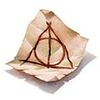 |
| Воскрешающий камень | Смерть (создатель) · Кадм Певерелл · Марволо Мракс · Морфин Мракс · Лорд Волан-де-Морт · Альбус Дамблдор · Гарри Поттер | |
| Мантия-невидимка | Смерть (создатель) · Игнотус Певерелл · Сын Игнотуса Певерелла · Иоланта Певерелл · (несколько поколений Поттеров) · Генри Поттер · Флимонт Поттер · Джеймс Поттер · Альбус Дамблдор · Гарри Поттер · Джеймс Сириус Поттер · Альбус Северус Поттер |
Воландемор? Волан-де-морт? Воландеморт? Волдеморт? Волдемор? Злой волшебник без носа? Том Риддл? А может все же Тот, кого нельзя называть? Вариантов в произношении имени главного злобного волшебника в книжках и фильмах про Гарри Поттера не так много, но Джоан Роулинг решила расставить все точки над i. И поводом стало сообщение в Twitter, на который отреагировала Роулинг.
«Буква T не произносится в имени Волдемора.»
«Но я уверена, что я единственная, кто произносит имя именно так», — ответила на это Джоан Роулинг в Twitter.
Так что многочисленные споры можно закрывать.
Волдемор, и точка.
Больше статей на Shazoo
- Руперт Гринт с радостью бы вернулся к роли Рона Уизли в новой части «Гарри Поттера»
- Хелена Бонем Картер: Роулинг имеет право высказывать свое мнение
- Дэниэл Рэдклифф: Я осудил слова Роулинг, потому что многие дети-трансгендеры любят «Гарри Поттера»
Тэги:
- Кино
- Harry Potter
- J.K. Rowling
- Дизайн и Арт
-
- Эта статья является частью цикла статей о волшебном мире Гарри Поттера.
| Оригинал | Росмэн | Народные переводы | Мария Спивак | Бялко-Левитова |
|---|---|---|---|---|
| Voldemort | Волан-де-Морт | Волдеморт | Вольдеморт | Волдеморт |
| Персонаж мира Гарри Поттера | |
 Ральф Файнс в роли Волан-де-Морта в фильме Гарри Поттер и Кубок Огня |
|
| Волан-де-Морт | |
|---|---|
| Пол | Мужской |
| Цвет волос | Лысый (раньше чёрные) |
| Цвет глаз | Красные (раньше тёмные) |
| Факультет | Слизерин |
| Чистота крови | Полукровка |
| Сторона | Возглавляет Пожирателей Смерти |
| Волшебная палочка | 13½ дюймов, тис, перо Феникса (Фоукса) |
| Первое появление | «Гарри Поттер и философский камень» |
Лорд Волан-де-Морт (англ. Lord Voldemort), он же Том Марволо Реддл (англ. Tom Marvolo Riddle; 31 декабря 1926 — 2 мая 1998) — тёмный волшебник, обладающий огромнейшей магической силой и практически достигший бессмертия при помощи чёрной магии, враг Гарри Поттера.
Имя Волан-де-Морт может происходить от фр. vol de mort — «полет смерти». Джоан Роулинг достаточно хорошо знает французский и подрабатывала частными уроками.
Поскольку имя «Волан-де-Морт» он составил из букв своего настоящего имени, оно является анаграммой имени «Том Марволо Реддл» (при перестановке букв получается «Я Лорд Волан-де-Морт», что в оригинале выглядит как «Tom Marvolo Riddle ⇒ I am Lord Voldemort»). При переводе фразы на русский I am было пропущено, имя Marvolo сменилось на Нарволо, фамилия Riddle — на Реддл, при этом значение английского слова riddle (загадка, головоломка, тайна) при переводе фамилии утрачено. Имя Voldemort, для сохранения анаграммы, передано как Волан-де-Морт. Возможно, переводчик также проводил параллели и с известным русскоязычному читателю персонажем с именем Воланд.
Лорд Волан-де-Морт появляется в пяти из семи книг(непосредственно с Гарри он встречается в первой, второй, четвёртой, пятой и седьмой книгах), а в фильмах его играют Ричард Бреммер, Кристиан Коулсон и Ральф Файнс.
Волан-де-Морта в мире волшебников боятся до такой степени, что даже имя его, как правило, не произносят. Большинство героев называют его «Сам-Знаешь-Кто» или «Тот-Кого-Нельзя-Называть», а Пожиратели Смерти называют его «Тёмный Лорд» (как Сивилла Трелони, пророчествуя, и многие другие). Гарри Поттер, однако, никогда не боялся произносить его имя, со временем, с некоторой опаской, его примеру следуют Гермиона Грейнджер и Джинни Уизли. Некоторые члены Ордена Феникса, например, Альбус Дамблдор, Сириус Блэк и Римус Люпин всегда без каких-либо колебаний называли полное имя Волан-де-Морта. В седьмой части Министерство Магии запрещает произносить имя Волан-де-Морта: на имя накладывают заклинание(Табу), которое отслеживает местоположение говорящего.
Содержание
- 1 Происхождение
- 2 Внешний вид и личные качества
- 3 Магические способности
- 3.1 Время до школы
- 3.2 Учёба в Хогвартсе
- 3.3 Возможность летать
- 3.4 Знание легилименции
- 3.5 Змееуст
- 3.6 Крестражи (Хоркраксы)
- 3.7 Дуэли
- 4 Биография
Происхождение
| Салазар Слизерин | |||||||||||||||||
| Томас Реддл | Мэри Реддл | Марволо Мракс | |||||||||||||||
| Том Реддл Старший | Меропа Мракс | Морфин Мракс | |||||||||||||||
| Том Марволо Реддл (Волан-де-Морт) |
|||||||||||||||||
Внешний вид и личные качества
По описаниям, у Волан-де-Морта очень бледная кожа, белое как мел и похожее на череп лицо, ноздри как у змеи, красные глаза со змеиными зрачками, тонкое скелетоподобное тело и длинные тонкие руки с неестественно длинными пальцами. Умирая при родах, Меропа Мракс вспоминала отца своего ребенка — она хотела, чтобы сын был на него похож. Миссис Коул считала, что ее желание разумно — так как Меропа была дурна собой. Волан-де-Морт не только носил имя своего отца-магла, но и очень походил на него внешне. Во время обучения в Хогвартсе он был описан как очень привлекательный молодой человек с впалыми щеками, аристократической осанкой, тёмными глазами и чёрными волосами. Значительные изменения во внешности, как считают маги, произошли по причине использования Волан-де-Мортом очень сложной тёмной магии.
Как считает Гарри, Волан-де-Морт ненавидит маглов и нечистокровных волшебников. Вероятно, это признак некоторой ненависти к себе, поскольку сам Волан-де-Морт — нечистокровный волшебник. Том Реддл убил своего отца и его родителей и изменил своё имя, перейдя по анаграмме от имени «Том Марволо Реддл» к «Лорд Волан-де-Морт», видимо, психологически отказываясь таким образом от своего происхождения.
Волан-де-Морт продвинулся в изучении магии, возможно, глубже, чем кто-либо из ныне живущих волшебников. Но в четырех, как минимум, случаях, по его словам, он не смог вспомнить вовремя о нужных вещах — о лечебном действии слёз феникса, плакавшего над Гарри в Тайной комнате, о силе древней магии, связанной с любовью и самопожертвованием (вещи, недоступные его пониманию, по мнению Дамблдора) и силе древней магии, связанной с тем, что частица его души находится в Гарри Поттере.
Между Томом Реддлом и Гарри Поттером можно заметить много общего — оба сироты, росли среди маглов не в самых приятных условиях, пока не были приняты в Хогвартс, который оба стали считать своим домом. У обоих персонажей чёрные волосы, тонкие черты лица и способность разговаривать со змеями. Однако огромная разница между ними иллюстрирует одну из идей серии, высказанную Дамблдором, о том, что сущность человека определяется его выбором, а не его способностями. Из пятой книги мы узнаем, что по предсказанию ни один из них не может жить, пока жив другой. В седьмой книге это предсказание трактуется на новый лад — они могут либо оба жить, либо должны оба умереть (ибо часть души Гарри Поттера — есть осколок души Волан-де-Морта).
Автор серии книг о Гарри Поттере, Джоан Кэтлин Роулинг, предположила, что главный страх Волан-де-Морта — «унизительная смерть», а его боггартом будет его безжизненное тело (боггарт — магическое существо, принимающее ту или иную форму в зависимости от того, чего больше всего боится человек, находящийся рядом). В зеркале Еиналеж он бы увидел себя всемогущим и бессмертным, что по свойствам этого зеркала соответствует его самому большому желанию. Дамблдор предполагал, что Волан-де-Морт тайно боится трупов и темноты, впрочем, по его словам, «в таких случаях мы боимся лишь неизвестности». Как выяснилось во время сражения в Министерстве Магии, Волан-де-Морт не может понять, что бывают вещи хуже смерти.
Если говорить о личных качествах, Волан-де-Морта можно назвать осторожным, сообразительным и спокойным стратегом. На четвёртом и пятом году обучения Гарри Поттера в Хогвартсе, Волан-де-Морт планировал длительные, рассчитанные на целый год операции: первая была связана с его возвращением в человеческое тело, вторая — со вторжением в Отдел Тайн Министерства Магии.
Магические способности
Время до школы
Судя по воспоминанию Дамблдора, в котором Гарри побывал на шестом году своего обучения в Хогвартсе, Волан-де-Морт с самого детства демонстрировал выдающиеся магические способности. Меропа Мракс родила своего сына в стенах приюта, в котором после ее скоропостижной смерти и воспитывался мальчик, который с младенчества отличался от других детей. «Знаете, он почти не плакал»,- говорит миссис Коул Дамблдору, принесшему Тому письмо из Хогвартса. Когда Тому Реддлу ещё не исполнилось одиннадцати лет (тогда он ещё не знал о том, что он волшебник), он вполне сознательно экспериментировал с магией, не зная, что это магия. Он умел перемещать предметы, не дотрагиваясь до них, а также управлять животными без предварительной дрессировки и организовывать неприятные ситуации для детей из приюта, которые его раздражали. Том Реддл был готов принять новость о том, что он волшебник. «Я знал, что я ОСОБЕННЫЙ», — сказал он Дамблдору, находясь во власти счастливого возбуждения (которое почему-то его не красило). Том не нуждался в друзьях и воспринимал других детей в Приюте скорее как объекты манипуляции, уже в столь нежном возрасте привыкнув быть хозяином положения. Одной из отличительных особенностей поведения Тома Реддла является коллекционирование своеобразных сувениров, на память о случаях особенно неприятного для окружающих проявления своих магических способностей. Привычка, которая впоследствии трансформируется в создание крестражей. Крестражами в случае Волан-де-Морта станут вещи, принадлежащие великим магам волшебного мира, в том числе и ему самому (Нагайна). Именно в них посредством сложного заклинания Темный Лорд станет заточать некоторую часть своей души.
Учёба в Хогвартсе
В Хогвартсе Том Реддл был лучшим учеником, и учителя отмечали его одарённость и стремление к знаниям. Учась в Хогвартсе, Том впервые открыл Тайную комнату и выпустил Василиска, который стал причиной смерти Плаксы Миртл. Однако, когда появилась угроза закрытия школы, Том нашёл «виновного» — третьекурсника Рубеуса Хагрида, увлекавшегося разными опасными животными. Том застал Хагрида с Акромантулом Арагогом, и Хагрида исключили из Хогвартса.
Ещё во время учёбы в Хогвартсе Том собрал вокруг себя группу преданных ему единомышленников, которые стали предшественниками Пожирателей Смерти. Тогда же он придумал себе новое имя вместо имени презираемого им отца-магла, которым его назвала мать: Лорд Волан-де-Морт.
Возможность летать
После своего возвращения в собственное тело Темный Лорд обрел способность летать, не применяя никаких магических катализаторов (палочки, зелий и т. п.). Доказательством служит то обстоятельство, что, утратив заимствованную палочку прямо в полете, он не упал как камень на землю, а потребовал у подчиненных дать ему другую палочку, при этом превосходно продолжая левитировать.
Знание легилименции
Волан-де-Морт известен как величайший из легилиментов мира — то есть он лучше других умеет проникать в чужие разум и память. При помощи легилименции Волан-де-Морт почти всегда может определить, лгут ли ему. Легилименты видят в сознании других эмоции и обрывки воспоминаний, которые могут противоречить словам, сказанным человеком. Противостоять легилименции можно только при помощи специальной методики защиты своих мыслей — окклюменции, которой Волан-де-Морт также владеет. Возможно, единственным, кто мог не допускать Волан-Де-Морта в свои мысли, был Северус Снегг.
Однако, применение легилименции к Гарри Поттеру причиняет ему ужасную боль. Возможно, причиной этому — соприкосновение, уязвленной темной магией и многочисленными убийствами, души Волан-де-морта с душой Гарри совершенно противоположной Волан-де-Мортовой (в этом случае нет большой разницы между разумом и душой, как в шестой части говорил Дамблдор.)
Змееуст
Также Волан-де-Морт умеет разговаривать со змеями — он змееуст (англ. parseltongue). Эта способность досталась ему по наследству от Салазара Слизерина, и маги традиционно связывают это умение со склонностью к тёмной магии. Владение змеиным языком передалось также Гарри Поттеру, после неудавшейся попытки Волан-де-Морта убить его, когда часть души Волан-де-Морта стала частью души Гарри Поттера.
Крестражи (Хоркраксы)
Известно, что Волан-де-Морт — один из очень немногих тёмных магов, решившихся и сумевших создать крестражи. Это части души, отделённые и спрятанные тёмным магом для того, чтобы фактом их существования обеспечить себе бессмертие. Крестраж можно создать, только убив другого человека. Дамблдор полагает, что Волан-де-Морт — единственный маг в истории, который когда-либо создавал более одного крестража. Согласно предположению Дамблдора, Волан-де-Морт рассчитывал расчленить свою душу на 7 частей, и успел сознательно расчленить только на 6: 7-й крестраж он собирался сделать, убив Гарри. Лорд Волан-де-Морт действительно разделил душу на 7 кусочков: дневник Тома Реддла, чаша Пенелопы Пуффендуй(Helga Hufflepuff), кольцо Марволо Мракса «с гербом Певереллов», медальон Салазара Слизерина, Нагайна, пропавшая диадема Кандиды Когтевран (Rowena Ravenclaw), сам Гарри Поттер. Именно эти многочисленные расчленения, по мнению Дамблдора, являются главной причиной физического и нравственного уродства Волан-де-Морта. В предпоследней книге Дамблдор описывает метаморфозы, происходившие с Томом Реддлом по мере увеличения количества Крестражей — Том становился все более отрешенным и неживым человеком. Дамблдор думал, что Том Реддл собирался оставить несколько крестражей в Хогвартсе, исходя из предположения, что тот оставлял крестражи в местах особенных достижений (первый триумф в магии, убийство первого человека, первый настоящий дом и т. д.)
Дуэли
Волан-де-Морт умело действует в дуэлях. Заклинания и контр-заклинания, превращение направленных против него объектов в другие, перемещение в пространстве — такие действия он выполняет за считанные секунды. Волан-де-Морт, по мнению многих, сильнейший темный маг на Земле. Считается, что по уровню владения магией он может сравниться только с Альбусом Дамблдором. Сам Дамблдор утверждал, что самые сложные его заклинания окажутся бесполезными, если Волан-де-Морт вернётся к своей прежней силе. Однако причиной его главных и возможно единственных поражений является его неосведомлённость в старейшей магии: так, магия любви Лили Поттер к своему сыну спасла Гарри и, более того — на некоторое время уничтожила физическую оболочку Темного Лорда. Другим примером является заключительная битва между Волан-де-Мортом и Гарри Поттером — победителем из нее выходит Гарри лишь благодаря неосведомленности Темного Лорда о том, что его палочка — Бузинная палочка(«Жезл Смерти») сочла своим хозяином Гарри, поскольку он победил её предыдущего хозяина(Драко Малфоя,ему она должна была достаться от его чистокровных предков), забрав его палочку в бою и тем самым подчинил её себе.
Биография
31 декабря 1926-ого года в магловском приюте родился Том Марволо Реддл. Его мать звали Меропа, она была колдуньей и потомком одного из основателей Хогвартса Салазара Слизерина. Его отец, Том Реддл-старший, был маглом. Его мать умерла после рождения ребёнка. Реддл ушел от Меропы, когда та решилась не поить его любовным зельем, а проверить, не останется ли он с ней, т.к. она была беременна. В отчаянии Меропа и не предприняла ничего, чтобы выжить. И вскоре умерла в скитаниях. Однако Меропа успела дать ребенку имя его отца — Том, и своего отца — Марволо. Отец ребёнка, Том Реддл-старший, не знал о сыне. Том воспитывался в приюте.
Все считали его странным. Няня в приюте говорила, что когда он был маленький, то никогда не кричал, а когда стал чуть старше, он стал мучить детей. Однажды он убил кролика и сказал, что тот сделал это с собой сам. Дети в приюте его боялись. Он был не таким как все. У него начали проявляться магические способности и он, более или менее научившись их контролировать, использовал их против приютских детей. Также он обнаружил, что может разговаривать со змеями. Он не считал себя сумасшедшим или странным. Он думал, что он особенный. И так оно и оказалось. По крайней мере из детей, среди которых он рос, он был особенным.
Летом, когда Тому было одиннадцать лет, к нему пришёл профессор Дамблдор, который тогда ещё преподавал в Хогвартсе трансфигурацию. Дамблдор пришёл для того, чтобы сообщить ему о том, что Том волшебник и что он зачислен в школу чародейства и волшебства «Хогвартс». Том принял Дамблдора за профессора из психиатрической больницы. Думал, что няня в приюте вызвала его, а потому он очень грубо с ним разговаривал поначалу. Дамблдору пришлось поджечь с помощью палочки платяной шкаф, а потом его потушить, показав, что вещи не сгорели. Это он сделал для того, чтобы доказать Тому, что он не считает его психом, а заодно и то, что он волшебник. Том на удивление быстро поверил в это . Он узнал где и что ему надо купить и как добраться до школы, а остальное были уже его собственные заботы. Ему не нужна была помощь.
И вот в сентябре он приехал в Хогвартс. Он понятия не имел о том, кем были его родители. И кто был его предок. Он лишь знал, что был назван в честь отца. Но он думал, что его отец был волшебником, а мать — маглом. Он ищет информацию о своем отце и понимает, что её нет, а это значит, что его отец — магл. Тогда он стал узнавать что-то о матери. И он понял, что он наследник Слизерина. Том очень хорошо учился в Хогвартсе. Он был очень способным учеником. Все учителя любили его.
На пятом курсе Тома назначают старостой Слизерина. В конце пятого курса, когда ему было шестнадцать лет, он нашел вход в тайную комнату — и узнал, как его открыть. Он выпустил из неё василиска и организовал серию нападений на грязнокровок. В конце концов василиск случайно убил девушку по прозвищу Плакса Миртл (англ. Moaning Myrtle). После этого случая Хогвартс хотели закрыть, но Том не мог допустить этого. Замок был его вторым домом. И он знал, что единственным способом избежать закрытия Хогвартса является поимка виновника. Он не хотел возвращаться в приют. Он терпеть не мог маглов, а сам приют вызывал у него отвращение. Тогда он решил подставить Хагрида. Он знал, что тот приобрел яйцо акромантула — огромного говорящего паука — на первом курсе, и знал, что паук до сих пор живёт у него. Свидетельству Тома поверили. Поверили, что это Арагог (так звали паука) — чудовище из тайной комнаты. Ему поверили, несмотря на то, что Хагрид был с виду не сильно умным и тем более не производил впечатление человека, способного найти тайную комнату, ведь Хогвартс обыскивали несколько раз и не нашли её, а тут полувеликан-третьекурсник. Даже Тому потребовалось пять лет, чтобы найти вход и открыть её.
Тем не менее, Хагрида исключили и сломали его волшебную палочку, а Арагог сбежал в тёмный лес и создал себе колонию из пауков-гигантов.
После этого Тома наградили за заслуги перед школой. Его награды до сих пор стоят в Хогвартсе. Затем Том сдает СОВ и уезжает на каникулы в приют.
Однако он ещё посетил дом Мраксов в Литл-Хэнглтоне, где жил его дядя Морфин Мракс, надеясь застать Марволо Мракса, уже покойного. Затем, руководствуясь словами Морфина, он отправился в особняк, где жил его отец со своими родителями. Том убил их. Позднее полиция маглов была поставлена в тупик картиной смерти. Том вернулся в дом Морфина Мракса, брата его матери, украл у него кольцо Марволо и с помощью магии подставил Морфина Мракса. Сделал так, чтобы в министерстве подумали, что это Морфин убил Тома Реддла-старшего и его родителей. Морфина заключили в Азкабан.
На шестом курсе Том решил поговорить с главой своего факультета профессором Слизнортом На нём уже было украденное им кольцо. Он спросил Слизнорта о крестражах. Он спросил о том, что будет, если создать их семь. Осенью Том создал свой первый крестраж — это дневник. Он понимал, что не может открыть комнату, пока учится в школе, а потому создал дневник-крестраж как инструкцию по открытию тайной комнаты.
Том пошёл на седьмой курс. Последний год обучения в школе. Лучший ученик школы, идеальный студент. Ему пророчили большое будущее и хороший карьерный рост. Том увлекался тёмными искусствами. Самые близкие его друзья, а скорее обожатели — он никогда не был с ними наравне — называли его Волан-де-Мортом. Те года, что Том учился в школе, были очень жестокими для некоторых студентов, но Том с первыми его последователями всегда были как-то в стороне. Только Дамблдор всегда знал, что происходит на самом деле.
В конце года Том сдал ЖАБА и ушел из школы. Был 1945 год. В сентябре как раз закончилась вторая мировая война.
Однако, вопреки ожиданиям, после окончания школы Том исчез. Он подрабатывал в Горбин и Бэрк. Он много где побывал, изучая тёмные искусства. Погружаясь в его тонкости. Это его увлекало, втягивало с головой… Он подвергся такому количеству различных магических трансформаций, что его лицо стало мало узнаваемым через годы. Мало что осталось от его былой красоты. Красивый талантливый мальчик превратился в ужасного человека с изуродованным лицом и стал самым злым магом столетия, известным как Лорд Волан-де-Морт. Почти никто не знал его настоящего имени.
Он создал ещё несколько крестражей из реликвий основателей Хогвартса.
В начале семидесятых Волан-де-Морт начал агитировать людей, искать сторонников, которые поддержали бы его идеи чистой крови. Самые близкие его приспешники стали Пожирателями Смерти. Многих магов, которые не хотели добровольно вступать в ряды сторонников Темного Лорда, под заклятием Империус заставляли совершать всякие зверства, такие, как убийство маглов. Они не могли этому сопротивляться.
Влияние Волан-де-Морта увеличилось. Он привлек на свою сторону великанов, которые убивали людей. Он использовал неприязнь волшебного мира к великанам против него же самого, пообещав, что не станет дискредитировать их, как другие волшебники.
Чтобы отметить дом, в котором Пожиратели Смерти совершали убийство, они использовали «темный знак» — парящий в воздухе образ черепа со змеей.
Волан-де-Морт решил стать преподавателем защиты от тёмных искусств, но Диппет ему не дал эту должность по совету Дамблдора. С тех пор ни один преподаватель не задерживается на этой должности больше года. Есть мнение, что Волан-де-Морт ее проклял.А тем временем Дамблдор стал директором Хогвартса — одного из немногих безопасных мест того времени.
Через несколько лет предсказательница Сивилла Трелони делает предсказание. Волан-де-Морт узнаёт о пророчестве от Северуса Снегга, который его подслушал. В нём говорится о мальчике, который способен убить его, когда вырастет. Тогда Волан-де-Морт решает убить его до тех пор, пока тот вырастет. Под параметры подходило только двое мальчиков — Невилл Долгопупс и Гарри Поттер. И он решил, что это Поттер. На Поттеров тем временем наложили заклятие Доверия и назначили хранителем секрета друга отца Гарри Питера Петтигрю. Но тот сдал их Волан-де-Морту. Темный Лорд убил родителей Гарри, но когда попытался убить Гарри, то получилось так, что он сделал последний, седьмой крестраж, а его заклинание отскочило в него самого. Он стал меньше духа. Он стал ничем.
Десять лет он скитался по лесам Албании и ещё неизвестно где, прятался, пока не встретил там молодого Квиррела и не склонил на свою сторону. Квирел стал преподавателем защиты от тёмных искусств. Волан-де-Морт вселился в него и хотел заполучить философский камень. Но его попытки обернулись крахом благодоря Гарри Поттеру.
На следующий год дневник-крестраж, который Том сделал, учась в школе, попал в руки одиннадцатилетней девочке Джинни Уизли. Она открыла ему душу, в результате чего стала одержима Волан-де-Мортом. Она открыла тайную комнату и стала напускать василиска на грязнокровок. Она не понимала, что делает. Том управлял ей. Но он опять не смог вернуться. И опять из-за Гарри Поттера. Он убил василиска и уничтожил дневник.
Спустя год, его бывший соратник Питер Петтигрю, предавший своих друзей, вернулся к нему. Вернулся только потому, что ему больше некуда было идти. Его разоблачили. Узнали, что он анимаг. Он помог Волан-де-Морту возродиться. И для возрождения Темному Лорду потребовалась кровь врага… И он взял кровь Гарри Поттера. Лорд Волан-де-Морт вернулся…
Но вернулся он тайно. Большинство людей считало Гарри, который якобы видел возрождение Темного Лорда, сумасшедшим. Так и всех, кто ему верил, во главе с Дамблдором. Министерство упорно закрывало на это глаза. Однако Волан-де-Морту долго не удалось отсидеться в тени министерских баталий. В конце учебного года он заявился в министерство и, сражаясь там с Дамблдором и Поттером, был обнаружен министром магии Корнелиусом Фаджем. Волан-де-Морт перешёл к более активным действиям.
Он начал стремительно и целенаправленно убивать всех, кто мог помешать ему прийти к власти. Наиболее громкими стали убийства Амелии Боунс (главы Департамента исполнения магического законодательства) и Эммелины Вэнс, отвечавшей за безопасность премьер-министра маглов. Начались таинственные исчезновения. Самым известным стало похищение Олливандера — мастера-изготовителя волшебных палочек. Дементоры покинули Азкабан и начали нагонять страх на всю страну. «Пожиратели Смерти» начали массовые убийства маглов. Министерству Магии становилось всё сложнее скрывать от магловского общества правду. Тьма и холод на долгие два года окутали Британию.
Разумеется, после всех этих событий Фадж не мог остаться Министром Магии. Новым Министром стал Руфус Скримджер, экс-глава Отдела Мракоборцев. Но новый министр не долго оставался в министерском кресле. На свадьбе Билла и Флёр стало известно (благодаря Кингсли Брустверу), что Скримджер убит. Следующим министром стал Пий Толстоватый, находящийся под заклятием Империус, наложенным пожирателем смерти Яксли.
Увлечённый идеей о непобедимой бузинной палочке, следующие полгода Волан-де-Морт тратит на её поиски. Ошибочно полагая, что причина связи его палочки и палочки Гарри в родстве сердцевин (перья одного феникса), он ищет ей замену в самой «смертоносной и непобедимой волшебной палочке, за которой на страницах истории тянется кровавый след». В ходе поисков он убивает второго могущественного тёмного волшебника — Грин-де-Вальда, заточённого к тому времени в тюрьму Нурменгард, так как тот отказался выдать местоположение бузинной палочки. В это же время к поискам палочки приступает и Гарри, в надежде, что она поможет ему победить Волан-де-Морта. В конечном счёте, он отказывается от этой идеи, и палочка достаётся Тёмному лорду.
Заполучив её и не веря, что она принадлежит Гарри Поттеру, направляет её против её хозяина. Палочка не слушается Темного Лорда и убивает его. Однако, если бы Темный Лорд атаковал Гарри Поттера своей обычной палочкой, а не Бузинной, а, поскольку у Гарри в тот момент была лишь палочка Драко Малфоя, не имевшая родства с палочкой Темного Лорда, и учитывая, что заклятие Авада Кедавра невозможно отразить, возможно победа была бы за Волан-де-Мортом.
|
Волшебный мир «Гарри Поттера» |
|||||||||||||||||||||||
|---|---|---|---|---|---|---|---|---|---|---|---|---|---|---|---|---|---|---|---|---|---|---|---|
| Книги: | Предыстория • Философский камень • Тайная комната • Узник Азкабана • Кубок Огня • Орден Феникса • Принц-полукровка • Дары Смерти • Фантастические животные: места обитания • Квиддич сквозь века • Сказки барда Бидля | ||||||||||||||||||||||
| Фильмы: | Философский камень • Тайная комната • Узник Азкабана • Кубок Огня • Орден Феникса • Принц-полукровка • Дары Смерти | ||||||||||||||||||||||
| Игры: | Философский камень • Тайная комната • Узник Азкабана • Кубок Огня • Орден Феникса • Принц-полукровка • Чемпионат мира по квиддичу • Lego Creator: Гарри Поттер • Lego Creator: Harry Potter and the Chamber of Secrets | ||||||||||||||||||||||
| Персонажи:
|
|
||||||||||||||||||||||
| Организации: | Хогвартс (Факультеты) • Министерство магии • Орден Феникса • Пожиратели смерти • Отряд Дамблдора • Ежедневный пророк • Придира • Клуб слизней • Г.А.В.Н.Э. • Инспекционная дружина | ||||||||||||||||||||||
| Дисциплины Хогвартса: |
Защита от тёмных искусств • Зельеварение • Трансфигурация • Заклинания • Уход за магическими существами • Травология • Прорицания • Древние Руны • Арифмантика • Маггловедение • История магии • Астрономия | ||||||||||||||||||||||
| Локации: | Локации мира Гарри Поттера • Большой Зал | ||||||||||||||||||||||
| Значимые события: |
Турнир Трёх Волшебников • Битва за Хогвартс | ||||||||||||||||||||||
| Пародии и подражатели: |
Порри Гаттер • Таня Гроттер • Ларин Пётр • Барри Троттер • Наука побеждать • АнтиГарриПоттер | ||||||||||||||||||||||
| Дж. К. Роулинг • Warner Brothers • Bloomsbury • Electronic Arts • Росмэн • Фэндом |
Wikimedia Foundation.
2010.
- «You see? It was a name I was already using at Hogwarts, to my most intimate friends only, of course. You think I was going to use my filthy Muggle father’s name forever? I, in whose veins runs the blood of Salazar Slytherin himself, through my mother’s side? I, keep the name of a foul, common Muggle, who abandoned me even before I was born, just because he found out his wife was a witch? No, Harry. I fashioned myself a new name, a name I knew wizards everywhere would one day fear to speak, when I had become the greatest sorcerer in the world!«
- — Tom Riddle’s transformation into Lord Voldemort[src]
Tom Marvolo Riddle (31 December 1926[20] – 2 May 1998), later known as Lord Voldemort or, alternatively as the Dark Lord, You-Know-Who, or He-Who-Must-Not-Be-Named was an English half-blood[3] wizard considered to have been the most powerful and dangerous Dark wizard of all time.[21][22] He was amongst the greatest wizards to have ever lived, often considered equal or more powerful to Albus Dumbledore.[23][24][25] Tom Riddle was conceived whilst his father, Tom Riddle Senior, was under the effects of a love potion supplied by his mother, Merope Riddle. When the enchantment was lifted, Tom’s father abandoned his pregnant wife and returned to Little Hangleton. His mother died moments after giving birth to and naming him. She named him after his father (Tom) and maternal grandfather, Marvolo Gaunt. Tom was raised in the Muggle-run Wool’s Orphanage.
Tom began attending Hogwarts School of Witchcraft and Wizardry in 1938 and was sorted into Slytherin house. During this time, Tom opened the Chamber of Secrets and used its monster, the Basilisk, to attack Muggle-born students, resulting in Myrtle Warren’s death. He also spent several months as a purchasing agent for the Dark artefacts shop Borgin and Burkes. He began his quest to attain immortality between the years of 1943 and 1998, creating his first Horcrux at the age of sixteen. While attending Hogwarts, Tom Riddle was made a prefect in 1942 until his graduation in 1945.
Splitting his own spirit into a total of eight fragments, Tom created an unprecedented seven Horcruxes, with one made later in his life, unintentionally and without his knowledge — Harry Potter. Abandoning his ‘Muggle’ name, he became the self-proclaimed Lord Voldemort, which is an anagram of his birth name. In the First and Second Wizarding Wars, he commanded a veritable army of wizards and Dark creatures; committed countless murders and atrocities; and eventually succeeded in taking over the Ministry of Magic.
Voldemort was ripped from his body in 1981 after attempting to kill Harry Potter. Although unable to die, he was not able to regain a permanent and physical body until 1995, thus spending the intervening fourteen years as ‘a shell, less than the meanest ghost‘. He was finally killed by his own backfiring curse after Harry Potter and Albus Dumbledore succeeded in destroying all of his Horcruxes.
Unknown to most, however, Voldemort’s legacy and bloodline would live on through his daughter Delphini, whom he conceived with his loyal follower Bellatrix Lestrange. The conception is thought to have occurred sometime after the Battle of the Department of Mysteries in 1996 and before Voldemort’s death at the hands of Harry in 1998 .
Riddle’s broken and mutilated soul was then trapped in Limbo for eternity, unable to move on to the afterlife or even return as a disembodied spirit.
Biography
Family lineage
- «The Gaunts, a very ancient wizarding family noted for a vein of instability and violence that flourished through the generations due to their habit of marrying their own cousins.«
- — Description of the House of Gaunt[src]
By Harry Potter’s time, Tom’s family on his mother Merope’s side were the last known members of the House of Gaunt. The Gaunts were an ancient, and formerly wealthy, wizarding family, noted for producing individuals with violent and unstable personalities due to generations of inbreeding.
Some notable members of the Gaunt family include:
- Corvinus Gaunt, Tom’s maternal ancestor, and a Parselmouth who hid the Chamber of Secrets entrance in a girls’ restroom at Hogwarts School of Witchcraft and Wizardry;
- Rionach Gaunt, the mother of Ilvermorny founder Isolt Sayre; and
- Gormlaith Gaunt, the sister of Rionach; maternal aunt of Sayre; maternal great-aunt of Rionach Steward and Martha Steward; and, it is believed, the ‘last of the Irish branch of the Gaunt family’.[26]
Because of the Gaunt family’s love for grandeur, along with little sensibility at their indulgences, the family gold was gambled away and gone long before the last known heirs of the lineage were born. Likewise, a tendency to ‘marry their own cousins’ to ‘keep their bloodline pure’, following the beliefs of their ancestor Salazar Slytherin, caused the heirs to the Gaunt name to suffer the ill-effects of generations of inbreeding and incest.
In North America, in what would later become the state of Massachusetts in the United States, the descendants of the Irish branch of the Gaunt family, through the Sayre’s line, were thought to have died out sometime in the 17th or 18th century. Rionach Steward, Sayre’s Half-blood daughter and the Defence Against the Dark Arts teacher at Ilvermorny, was also rumoured to have inherited the ability to speak Parseltongue from her mother. Unwilling to further Slytherin’s bloodline, since she viewed him as a Dark wizard, Rionach never married or had children, and she later died without heirs.
However, Rionach was unaware that another branch of the Gaunt family was still present, alive and well, across the ocean in England. It was from this line of Gaunts from which, centuries later, another Half-blood descendant, Tom Marvolo Riddle, would be born.
Rionach’s sister Martha, unlike her sibling, married a No-maj (Muggle) friend of the nearby Pocumtuc Native American tribe. Born a Squib, without any magical powers, Martha felt ostracised within the growing American wizarding community, despite being the child of an important family. In the end, due to the emotional pain caused by being unable to perform magic, and the stigma of being the the only Squib to grow up at Ilvermorny, Martha decided to live her life henceforth as a Muggle.[26]
Tom’s maternal grandfather, Marvolo Gaunt, and his maternal uncle, Morfin Gaunt, claimed to be the last known male, pure-blood descendants of Slytherin by the early 20th century. As such, they regarded themselves as ‘royalty’ for their ancestry, despite their poverty, squalor, lack of education, and mental and physical disorders from centuries of familial inbreeding.
Tom’s father, Tom Riddle Senior, was a wealthy Muggle living in the village of Little Hangleton, near the Gaunt shack, who was forced into a relationship with Merope Gaunt through the suspected use of the Imperius Curse or a love potion.[27] After some time, it is speculated by Albus Dumbledore that Merope discontinued her bewitchment of Tom, in the hopes that he had really fallen in love with her, or would at least stay for their child’s sake. To Merope’s great sorrow, Tom Snr fled from her after he came to his senses and regained his free will and never wanted to see her again.[28]
Early life (1926–1938)
- Mrs Cole: «He scares the other children.«
- Albus Dumbledore: «You mean he is a bully?«
- Mrs Cole: «I think he must be, but it’s very hard to catch him at it. There have been incidents… Nasty things… Billy Stubbs’s rabbit… well, Tom said he didn’t do it and I don’t see how he could have done, but even so, it didn’t hang itself from the rafters, did it?«
- — Mrs Cole informing Albus Dumbledore of Tom Riddle’s life at Wool’s Orphanage[src]
Tom in his room at Wool’s orphanage, where he spent the majority of his childhood
Tom Marvolo Riddle was born on 31 December 1926 at Wool’s Orphanage in London. His mother Merope staggered to the door of the orphanage, gave birth to Tom there, and died shortly after. Riddle grew up in the dingy orphanage, completely unaware of his wizarding heritage. Since the Muggle orphanage staff did not know anything about his mother, they did not know about his magical background. Instead, they believed that Merope was a circus worker, as Mrs Cole told Dumbledore shortly before his first meeting with Riddle. It is unknown whether or not the staff relayed this to Riddle before his first encounter with Dumbledore.[28]
Despite his ignorance of his mother’s true background, Riddle did have some grasp on his abilities beyond that of normal magical children of his same age, and an unusually high degree of control over them. He could move objects with his mind and cause them to float wherever he wished, manipulate animals and creatures as he wished, speak Parseltongue, and use his power to inflict harm on other orphans. After getting into a fight with fellow orphan Billy Stubbs, he used his powers to hang the boy’s rabbit from the rafters. On one occasion, he took two other orphans, Dennis Bishop and Amy Benson, into a cave, where he performed an act, likely with his powers, so horrifying that the two orphans were traumatised into silence. Afterwards, he may have told them, in some means, not to tell anyone what happened in the cave. Riddle also stole from other orphans and hid their things in his cupboard like trophies.[28]
Discovery of being a wizard
- Harry Potter: «Did you know, sir? Then…?«
- Albus Dumbledore: «Did I know that I had just met the most dangerous Dark wizard of all-time? No.«
- — A memory of Dumbledore meeting Tom Riddle for the first time[src]
Dumbledore visiting 11-year-old Tom Riddle at Wool’s Orphanage
When Riddle was eleven, Dumbledore, who at the time was the Transfiguration teacher at Hogwarts, talked to Mrs Cole, who informed him of how unusual the boy was, sharing tales of his extraordinary influence over the other children. When Dumbledore was at last introduced to the boy, Riddle at first believed him to be a doctor or psychiatrist of some sort, coming to take him to an asylum because of what the staff had seen. He was convinced after Dumbledore demonstrated his power by using a Flame-Freezing Charm on Riddle’s cupboard and revealed that Hogwarts was a school for people with magic, whereupon Riddle realised that was what his abilities were.
Tom also mentioned his proficiency for Parseltongue in this same meeting, asking if it was a common gift amongst wizards, to which Dumbledore gave no reply. Dumbledore also admonished Riddle for stealing from others and made him return the items with his apologies. He also warned Riddle to stop his misbehaviour, as Hogwarts had an honour code whereupon lying, cheating and stealing were not tolerated.[28]
At a very early age, it was clear that Riddle displayed a desire to be different and set apart from others (as it was hinted when he mentioned his dislike of his own name, because it was such a common name).[28]
Dumbledore proving to Riddle that he was a wizard
Riddle was not surprised upon being informed by Dumbledore that he was a wizard — he was, in fact, eager to believe that he had special gifts that no normal person had. Riddle also showed an eminent fear of death, considering it a human weakness. He claimed that his mother could not have been a witch, because if she was magical, then she would have been able to avoid dying, and thought his father was a wizard. He asked if his father was an alumnus of Hogwarts, to which Dumbledore said he did not know offhand.[28]
Riddle’s abuse of his wizarding powers alarmed Albus. He resolved to keep a close eye on him, something he should have done in any case, seeing as he was ‘alone and friendless‘. Dumbledore also warned Riddle that at Hogwarts he would be introduced to the laws that controlled the usage of magic in the wizarding world, and that law-breakers were punished with severity not by Hogwarts but the Ministry of Magic. Riddle’s demeanour changed after Dumbledore reprimanded him; he became more guarded and shielded his real reactions to things, adopting a kinder persona. Dumbledore provided Riddle with enough information to find Diagon Alley and Platform Nine and Three-Quarters. He also provided Riddle with a stipend from school funds so that he could purchase his books and equipment.
Travelling on his own to Diagon Alley, Riddle bought some second-hand robes and spell books for himself, along with his wand, which was thirteen-and-a-half inches, made of yew with a phoenix feather core from Ollivanders. Little did Riddle know that very wand would, in the future, share the same wand core as Harry Potter. Garrick Ollivander later said that the wand was very powerful; Voldemort was very pleased with it until the wand failed him during his confrontation with Harry Potter in the Little Hangleton graveyard.
Hogwarts years (1938–1945)
- Tom Riddle: «Sir, I wondered what you know about…about Horcruxes?«
- Horace Slughorn: «Project for Defence Against the Dark Arts, is it?«
- Tom Riddle: «Not exactly, sir, I came across the term while reading and I didn’t fully understand it.«
- — Tom Riddle inquiring about Horcruxes[src]
Riddle was educated at Hogwarts from 1938 to 1945, and was sorted into Slytherin House, a nod to his ancestor Salazar Slytherin. During summer breaks, he was forced to return to the Muggle orphanage, which he despised and dreaded more than any other place on earth.[8][28]
The Slug Club, of which Tom was a member of during his education
Riddle described the way he was seen as ‘poor, but brilliant, parent-less, but so brave, a school prefect, a model student‘.[8] Due to his exceptional acting abilities and handsome looks, he was able to convince virtually all of the Hogwarts staff and instructors that his kinder façade was his true personality. The sole exception to this was Dumbledore, who, though not necessarily suspicious of Riddle, never forgot about his misdeeds at the orphanage, nor his unsettling behaviour during their first meeting. In turn, Riddle realised that he had been careless in showing Dumbledore his true character upon their first meeting, and never attempted to win him over as he had with his other instructors. In time, he came to fear and despise Dumbledore.[28]
Tom Riddle during his time at Hogwarts
Over time, Riddle gathered to himself a gang of Slytherin thugs, a motley composition of ‘the weak seeking protection, the ambitious seeking some shared glory, and the thuggish gravitating toward a leader who could show them more refined forms of cruelty‘, most of which would become the first Death Eaters. Riddle claimed they were his friends, and made it appear so in public, but in truth, they amounted to little more than servants, and he cared almost nothing for them. He often manipulated them into committing petty crimes and other misdeeds, but none of these incidents were reliably traced back to the group.
Opening the Chamber of Secrets
- «The last time the chamber was opened, a Mudblood died.«
- — Draco Malfoy, regarding the first opening of the Chamber of Secrets[src]
Tom standing in the Chamber of Secrets
Upon arriving at Hogwarts, Riddle became obsessed with his heritage and began researching it with an insatiable hunger. He focussed solely on the identity of his father, still thinking him to be the magical parent, as he had held onto his beliefs that death was a Muggle consequence and a weakness. He searched for his father’s name in the school trophy room, in the records of Hogwarts prefects and in records of wizarding history, but found nothing to suggest his father had even attended Hogwarts. He was eventually forced to accept that his father was the Muggle parent, and that his mother was the magical one. It was around this time that Riddle gave himself the alias ‘Lord Voldemort’, to spare himself of the reminder of his ‘filthy Muggle father‘,[29] who he later learned had abandoned his wife after learning she was a witch (although in reality he left her after she stopped controlling him with a love potion).
Using his middle name, Marvolo, which was taken from his maternal grandfather, Riddle discovered his mother’s heritage and the Gaunts’ bloodline connection with Salazar Slytherin. Once Riddle learned of his ancestry, it was not long before he discovered the existence of the Chamber of Secrets under Hogwarts, during his fifth year, and tamed the Basilisk which dwelt within. As the Heir of Slytherin through his mother’s family, Tom was able to open the Chamber Slytherin had left behind in order to ‘purge the school of all those who [were] unworthy to study magic‘ — in Riddle’s and Slytherin’s eyes, Muggle-borns.[8]
A 16-year-old Riddle during the 1943 opening of the Chamber of Secrets threatening Hagrid
Around 13 June 1943, the Basilisk petrified many at Hogwarts, with its last victim being a student named Myrtle Warren, who was killed in the girls’ bathroom when she saw the Basilisk’s yellow eyes. In light of this incident, the Hogwarts Board of Governors decided that Hogwarts was to be closed. During that year, Riddle made a special request that Headmaster Armando Dippet would allow him to stay at school over the summer break. However, Dippet informed him of the governors’ decision, and denied his request.
Realising that the Chamber would need to be closed and the culprit caught in order to keep the school open (and not have to return permanently to the orphanage), Riddle framed fellow student Rubeus Hagrid and his pet Acromantula, Aragog. He convinced Dippet that Aragog was the monster that had terrorised the school. He also noted that Hagrid was keeping a dangerous pet, though this was shallow hypocrisy considering the monster he commanded. Hagrid was expelled, and Riddle ironically received an engraved trophy for Special Services to the School.[8]
Dumbledore ‘keeping an annoyingly close watch‘ on Tom
Dumbledore, who did not believe that Hagrid was responsible for the killing, managed to arrange for him to be kept on as Hogwarts’s groundskeeper. Distrusting Riddle, Dumbledore kept an ‘annoyingly close’ watch on him after that. Due to this, Riddle realised that he would not be able to risk opening the Chamber while still a student. As such, he would use this murder to eventually preserve a part of his soul within his own school diary, the very first of his seven Horcruxes, hoping it would one day lead someone to finish Salazar Slytherin’s ‘noble work’.
Murder of the Riddle family
- Morfin Gaunt: «I thought you was that Muggle, you look mighty like that Muggle.«
- Riddle: «What Muggle?«
- Morfin Gaunt: «That Muggle what my sister took a fancy to, that Muggle what lives in the big house over the way, you look right like him. Riddle. But he’s older now, in ‘e? He’s older ‘n you, now I think on it… he come back, see.«
- — Riddle confronting his maternal uncle[src]
Morfin Gaunt telling his nephew about the latter’s heritage
Around August 1943,[30] Riddle went to Little Hangleton to learn about his mother’s family. While at the Gaunt Shack, he met his uncle Morfin Gaunt, with whom he was far from impressed. Morfin mentioned offhandedly at one point during this meeting that he thought that Tom looked ‘mighty like that Muggle‘, Merope’s husband, Tom Riddle Snr. Riddle immediately demanded the identity of the Muggle in question, and Morfin told Riddle the full story of his Muggle father, which infuriated Tom to the point of seeking revenge. Riddle stunned Morfin and took his wand, went over to the Riddle House and, using his uncle’s wand, murdered his father, grandfather, and grandmother with the Killing Curse.
Riddle covered up his crimes by altering Morfin’s memory, causing him to believe that he was the killer. When the Ministry of Magic investigated the crime, Morfin, who had previously served three years in Azkaban for using magic in front of and against Muggles, freely admitted to the deed and was sentenced to life imprisonment in Azkaban. Tom took the Gaunt family’s signet ring from Morfin and later on would preserve another part of his soul within it to make his second Horcrux, wearing it like a trophy at Hogwarts.[28]
Learning about Horcruxes
- Riddle: «How do you split your soul?«
- Horace Slughorn: «Well, you must understand that the soul is supposed to remain intact and whole. Splitting it is an act of violation, it is against nature.«
- Riddle: «But how do you do it?«
- Horace Slughorn: «By an act of evil — the supreme act of evil. By commiting murder. Killing rips the soul apart. The wizard intent upon creating a Horcrux would use the damage to his advantage: He would encase the torn portion —«
- — Discussion of how Horcruxes were made[src]
Young Riddle asking Professor Slughorn about Horcruxes
During his sixth year, Riddle questioned Professor Slughorn, who was taken in by Riddle’s charisma, about the possibility of creating more than one Horcrux, something Slughorn felt deeply ashamed of in later years. In his mid-teen years, Riddle already sought to make himself immortal; being unable to find any recorded information on creating multiple Horcruxes. He wanted to split his soul into seven, as this is the most powerful magical number, and asked the experienced and knowledgeable Slughorn for an opinion before attempting this unknown feat. Slughorn answered all of Riddle’s questions under the belief it was merely academic curiosity but was deeply horrified at the thought of creating multiple Horcruxes.
Riddle splitting his soul for the first time
Riddle succeeded in doing so at some point during this year, creating his first Horcrux in the form of the aforementioned diary and his second in the form of the inherited ring. During Riddle’s seventh year at Hogwarts, he was made Head Boy, earned outstanding marks in every examination he took, and received a Medal for Magical Merit. Riddle was regarded as one of the most brilliant students ever to attend Hogwarts, a fact admitted by Dumbledore himself.
After Hogwarts (1945–1949)
- Albus Dumbledore: «Rumours of your doings have reached your old school, Tom. I should be sorry to believe half of them.«
- Riddle: «Greatness inspires envy, envy engenders spite, spite spawns lies. You must know this, Dumbledore.«
- — A business intercourse between a headmaster and his old student[src]
Borgin and Burkes, Voldemort’s former place of employment
After graduating, Riddle immediately approached Dippet and asked him for a chance to teach Defence Against the Dark Arts, and to remain at Hogwarts, for reasons that he did not confide with the then-headmaster — Hogwarts being his true home at heart, using the influential position as a teacher to recruit students into his future army, and to continue to learn the castle’s magical secrets. Dippet rejected this offer, deeming the boy too young, but invited Riddle to reapply in a few years, if he was still interested in the post, something that Dumbledore heavily advised against.
Shortly before leaving Hogwarts, however, Riddle charmed Helena Ravenclaw, the daughter of Rowena Ravenclaw and the ghost of Ravenclaw House, into telling him the location of her mother’s diadem, which she revealed as a hollow tree deep within a far-flung forest in Albania. He presumably travelled there at her instruction, murdering an Albanian peasant along the way before retrieving the diadem, which he later preserved a third part of his soul within to make his third Horcrux.[31]
Upon his return to Britain, Riddle was offered several positions in the Ministry of Magic, but ended up working at Borgin and Burkes, to the disappointment and surprise of many. Riddle set to persuading witches and wizards to part with their valuable magical heirlooms — a job at which he was very good.[28]
The rise of the Dark Lord (1950–1970)
Murdering Hepzibah Smith
- «But before they were sure beyond doubt that the cup and the locket were both gone, the assistant who had worked at Borgin and Burkes, the young man who had visited Hepzibah so regularly and charmed her so well, had resigned his post and vanished. His superiors had no idea where he had gone; they were as surprised as anyone at his disappearance. And that was the last that was seen or heard of Tom Riddle for a very long time. «
- — Tom disappearing after murdering Hepzibah Smith[src]
Hepzibah Smith showing Riddle Slytherin’s Locket
While working at Borgin and Burkes, Riddle befriended Hepzibah Smith, a wealthy but elderly descendant of Helga Hufflepuff. Between 1955 and 1961,[28][32] Hepzibah showed Riddle her two most valuable treasures: his ancestor’s locket and her ancestor’s cup. Tom’s eyes flashed red with avarice upon seeing these objects, seeing the locket to be rightfully his as Slytherin’s heir and the cup as a reminder of Hogwarts, as well as a priceless artefact.
Riddle murdered Hepzibah, by using a ‘little known poison’, to steal these coveted objects and vanished without a trace. He again covered his tracks well by implanting another false memory into an innocent bystander — Hokey, Hepzibah’s house-elf. Hokey admitted to accidentally putting poison into Hepzibah’s cocoa, which was believed, as Hokey was elderly herself and thus believed to be senile. Meanwhile, Riddle immediately resigned his post at Borgin and Burkes and fled with the cup and locket, subsequently turning them into two more Horcruxes using the murders of Hepzibah and an unidentified Muggle tramp.[28]
Lord Voldemort’s request
- «I have experimented; I have pushed the boundaries of magic further, perhaps, than they have ever been pushed —«
- — Tom regarding the magical experimentation he did while abroad[src]
Riddle disappeared for ten long years. He slipped deeper into the Dark Arts, travelled extensively, consorted with disreputable people, began to become distorted in appearance and lose his handsomeness due to splitting his soul so many times, and began to use the alias ‘Lord Voldemort’ openly. He also severed contact with Slughorn, who became upset for not living up to the Potions Master’s employment offers.
Ten years after Hepzibah Smith’s murder, Riddle appealed once more to the Headmaster of Hogwarts, now Albus Dumbledore, for the position of Professor of Defence Against the Dark Arts. After a short, superficially amiable chat, Dumbledore directly confronted Riddle regarding why he had requested the position, as he knew full well that Riddle had no desire whatsoever to teach. Riddle, unable to make an open request of Dumbledore due to the malicious nature of his true intentions, simply left after a final, gentle rebuke from his former teacher. From that day on, Hogwarts was never able to keep a Defence Against the Dark Arts teacher for more than a year, which was attributed by Dumbledore to a curse by Riddle. The visit to Hogwarts was not fruitless, however, for Riddle used the opportunity to hide the diadem in the Room of Requirement, where he believed it would never be found.[28][31]
Voldemort, as Riddle was now exclusively called, spent the next few years before the First Wizarding War gathering followers in witches and wizards who called themselves, collectively, Death Eaters.[33] Some were supportive of his cause to dominate Muggles and Muggle-borns; while others were greedy for domination, wealth and fame; and yet others joined the Dark Lord out of fear. Voldemort considered them more like servants than friends or family. According to Sirius Black, Voldemort also used tricks, jinxes, and blackmail to get people to willingly join him.
At some point around this time, Voldemort greatly enhanced his skills in Legilimency, to the point that Snape claimed he was the most accomplished Legilimens the world had ever seen. Voldemort could read, control and unhinge the minds of others, and could almost always tell when he was being lied to. According to Severus Snape, Voldemort often enjoyed telepathically invading the minds of others, creating visions designed to torture them into madness. Only after extracting the last exquisite ounce of agony, only when he had them literally begging for death, would he finally kill them.
First Wizarding War (1970–1981)
- «He was takin’ over. ‘Course, some stood up to him — an’ he killed ’em.«
- — Voldemort’s actions during the First Wizarding War[src]
Voldemort wearing a hooded cloak during the First War, as a possible means to invoke fear
In 1970, Voldemort started the First Wizarding War by taking advantage of one of the wizarding world’s greatest weaknesses: the beings and creatures that they had outcast. The Dark Lord recruited the giants, who had long ago been driven by Wizardkind into the mountains, and werewolves, who were persecuted by most witches and wizards. Many feared the goblins would also join him, as they were restricted from wand use, but it never happened. In fact, Voldemort murdered a family of goblins near Nottingham at some point during the War, for an unknown reason (possibly anger at the neutrality of the goblins, or no reason at all). Voldemort’s army caused widespread destruction and mayhem during the war.
Bartemius Crouch Snr, who was the head of the Department of Magical Law Enforcement at the time and was known for his fanatical hatred of the Dark Arts, issued an edict that gave Aurors authorisation to use Unforgivable Curses on Death Eaters without warning, and suspects were sometimes handed over to the Dementors without a Wizengamot trial. Many innocent people were locked away. Due to the atrocities committed by the Death Eaters and Voldemort, and his terrifying persona, people were even afraid to speak his name, and he was referred to as ‘You-Know-Who’ or ‘He-Who-Must-Not-Be-Named’.
Under the staunch protection of Dumbledore, the only person Voldemort truly feared, Hogwarts remained a safe place of learning throughout the entire war. The Order of the Phoenix was created by Dumbledore at this time to fight against Voldemort. The war itself lasted for eleven long years.[34]
Visiting the Lee family
Eventually, Lord Voldemort visited the home of the father of Barnaby Lee. Mr Lee told his son he was capable of anything if he could become as strong as the Dark Lord, showing faith in his master. He later drowned Barnaby’s pet Kneazle.[35]
Testing his Horcrux’s defences
- «To the Dark Lord — I know I will be dead long before you read this, but I want you to know it was I who discovered your secret, I have stolen the real Horcrux and intend to destroy it as soon as I can, I can face death in the hope, that when you meet your match, you will be mortal once again. -R.A.B.«
- — Regulus Black’s letter to Voldermort before his untimely death[src]
Lord Voldemort preparing to murder wizards and witches who opposed him
In 1979, Voldemort decided to test the defences around his Horcruxes. He placed Slytherin’s locket in the crystal cave, and asked Regulus Black, a loyal 18-year-old Death Eater to lend him his house-elf, Kreacher. Voldemort took the elf with him to the cave, forced him to drink the Emerald Potion, and left him to die on the Crystal Cave Island. Kreacher was able to escape using house-elf magic, and told Regulus of what had happened. Over the years, Voldemort created an army of Inferi from the people he had killed to further strengthen his defences. Upon hearing Kreacher’s story, Regulus, who had already been somewhat uncomfortable with the reality of being a Death Eater, decided to defect.
From clues left behind by Voldemort, he deduced that his master had created a Horcrux in order to become immortal. He took a duplicate locket and placed a note inside for Voldemort to find, then ordered Kreacher to take him to where the real locket was hidden. Kreacher guided Regulus past the cave’s defences. At the island, with the basin of potion containing the locket, Regulus ordered Kreacher to take it once the potion was gone and replace it with the fake one, then escape without him and find a way to destroy the Horcrux. Regulus drank the potion himself, and when he tried to get water from the lake to quench his thirst, he was dragged to his death by the Inferi. Kreacher obeyed his master’s orders and switched the lockets before escaping. However, despite his best efforts, he was unable to destroy the Horcrux.
During this time, Voldemort gave his old diary to Lucius Malfoy, one of his most loyal Death Eaters, and ordered him to hide it. Malfoy kept it safe in his manor, but the Dark Lord never told him that the diary contained a fragment of his soul. Voldemort informed him only that the diary was cleverly charmed and smuggling it into Hogwarts will cause the reopening of the legendary Chamber of Secrets and send the Basilisk living inside the chamber to finish Slytherin’s idea of cleansing the school of all Muggle-borns, thus proving that Voldemort was Slytherin’s true heir.
Voldemort also left the Hufflepuff’s cup in the care of Bellatrix Lestrange, another one of his loyal Death Eaters. Bellatrix, much like her brother-in-law Lucius, was ordered to hide it, so she stored it in her family vault at Gringotts Wizarding Bank, which was considered to be impossible to plunder. She treated the object with extreme priority, although Voldemort hadn’t informed her that the cup was a Horcrux. The cup was protected by the bank’s extensive security measures, but Lestrange casted some protective curses on it, like a spell which would cause any object to multiply exponentially if touched by anyone other than the vault’s owners or to cause the object itself to glow hot as fire and burn the flesh of anyone trying to remove it without authorisation.
Probably during this time he returned Gaunt’s ring to the Gaunt shack. He placed the ring inside a golden box and hid it beneath the shack’s rotting floorboard, setting up many protective enchantments to deter outsiders from entering the shack and finding the ring. He also placed a powerful curse on the ring as well, one that would quickly lead to the death of the ring’s wearer if not stemmed.
The prophecy
- «The one with the power to vanquish the Dark Lord approaches… Born to those who have thrice defied him, born as the seventh month dies… And the Dark Lord will mark him as equal, but he will have power the Dark Lord knows not… And either must die at the hand of the other for neither can live while the other survives… The one with the power to vanquish the Dark Lord will be born as the seventh month dies…«
- — Sybill Trelawney’s first prophecy[src]
Ten years into the war, when Voldemort was at the height of his dominion, a prophecy was given by Sybill Trelawney to Albus Dumbledore which predicted the fall of the Dark Lord. This prophecy was given in the Hog’s Head Inn during an interview for the position of Professor of Divination.[34] This prophecy was overheard by Death Eater and informant Severus Snape.[28] According to Dumbledore, Snape only heard half of the prophecy and was then thrown out by the barman, Aberforth Dumbledore, Albus’ brother. He relayed to Voldemort what he had heard, not realising that he had missed an important part of the message.[34]
Trelawney’s description of the night’s events was a bit different however, as she stated that after feeling ‘ill’, Aberforth burst into the room with Snape in tow, whom he had caught eavesdropping at the door. This is in contrast with Dumbledore’s description of events. However, this may be due to the fact that Dumbledore had wished to conceal the identity of the spy from Harry, and told him a simplified version of the events. In any case, Voldemort received only the first part of the prophecy. Feeling threatened, he sprang into action to prevent the fulfilment of the prophecy.
There were, at the time, two babies to whom the prophecy could have referred — Harry Potter, the half-blood son of James and Lily Potter; and Neville Longbottom, the pure-blood son of Frank and Alice Longbottom. Both families had sought to thwart Voldemort three times, and both families were members of the Order of the Phoenix. Both children in question were born at the end of the seventh month, July. Voldemort chose to target Harry instead of Neville; Dumbledore suspected this was because Harry shared a similar family heritage with Voldemort, both of them being half-bloods.[34]
First fall from grace
- «Lily, take Harry and go! It’s him! Go! Run! I’ll hold him off!«
- — James Potter moments before his death[src]
Voldemort killing Lily Potter with the Killing Curse
Some time after Harry’s birth, Peter Pettigrew, member of the Order of the Phoenix and the Potter’s Secret Keeper began working as a Death Eater for Voldemort. On 31 October 1981 he told Voldemort of their location. The Dark Lord travelled to the Godric’s Hollow and with the Potter’s Fidelius Charm broken, he simply walked into their home. Once inside he proceeded to murder James and Lily, who did not have their wands. However, when he used the Killing Curse on Harry, it rebounded and seemingly obliterated his body. This happened because Lily lovingly sacrificed her life to protect her son, creating a powerful defence of ancient magic around Harry which protected him for many years.[12] After eleven years of domination and warfare, Voldemort was defeated for the first time.
Infant Harry Potter facing death for the first time
It was at this point that Voldemort’s next Horcrux was unknowingly created. Years of experimentation, murder, and deliberately ripping apart his soul into so many Horcruxes had rendered the remainder of his soul so unstable that, when his body was destroyed, a small shard of his soul broke apart from the rest and latched onto the only other living being in what remained of the room: Harry Potter himself. The soul shard latched onto Harry’s own soul, granting him some of the Dark Lord’s own powers and providing him with a latent connection to Voldemort’s own mind. Ironically, Harry became the Dark Lord’s sixth Horcrux, the desired number Voldemort wanted in order to split his soul into seven pieces. What remained of Voldemort’s mangled soul swiftly escaped from the ruins of the house that same night.
Missing years (1981–1994)
- «I was ripped from my body, less than spirit, less than the meanest ghost, but still, I was alive.«
- — Lord Voldemort regarding his fall from power[src]
Death Eaters’ trial
After Voldemort’s first fall from domination, the Death Eaters dispersed and attempted to return to normal life. Many claimed they had been under the Imperius Curse, while others stayed true to their master and continued his work, most notably the Lestrange family, who were eventually taken into custody, convicted at trial, and imprisoned in Azkaban. Most of them however, managed ultimately to remain free and to reintegrate into society.[36]
Voldemort’s disembodied soul
Voldemort lost his physical form and magical powers, but he remained alive in ghostly form. The Horcruxes he had created kept his spirit bound to the physical world. He retreated to the forests of Albania, where he had previously found his fifth Horcrux, and waited for his faithful Death Eaters to find him, but many of them now believed him dead, and those still faithful to him were either dead or in Azkaban. His one remaining power was possession.
He gained physical form by inhabiting animals, mainly snakes, though he disliked doing so because the bodies of such animals were ill-equipped to perform magic, and because his possession significantly reduced their lifespans; none of his hosts survived for too long and he would be forced back to spirit form. Additionally, any help that he could have potentially rendered himself required the use of a wand, and animals, obviously, could not be used for this purpose. Voldemort did not dare enter the communities to possess humans, as he knew that Aurors were still abroad, looking for any signs of him.[12]
Search for the Philosopher’s Stone
- «Harry Potter… See what I have become? Mere shadow and vapour … I have form only when I can share another’s body… but there have always been those willing to let me into their hearts and minds…. Unicorn blood has strengthened me these past weeks… you saw faithful Quirrell drinking it for me in the forest… and once I have the Elixir of Life, I will be able to create a body of my own…. Now… why don’t you give me that Stone in your pocket? Don’t be a fool. Better save your own life and join me … or you’ll meet the same end as your parents…. They died begging me for mercy….«
- — Voldemort speaking to Harry Potter through Quirrell[src]
Quirinus Quirrell, Voldemort’s temporary host
In 1991, Voldemort formed a plan to regain his physical body. Hogwarts Professor Quirinus Quirrell had made a voyage to Albania, where his foolish and gullible mind was vulnerable to Voldemort. He latched onto Quirrell’s body and came back to England with him.
Somehow, Voldemort learned of the Philosopher’s Stone, and how it could somehow return him to his physical form. He ordered Quirrell to steal the stone from a Vault 713 in Gringotts Wizarding Bank so he could make the Elixir of Life. Voldemort discovered the Stone had been removed earlier that same day, and through Quirrell’s connections at Hogwarts, learned it was hidden at the school.[12]
The same year that Voldemort set to the task of stealing the Stone, Harry Potter began his first year at Hogwarts. There were many barriers protecting the Stone. Severus Snape, who had switched sides near the end of the war and become a professor of Potions, was suspicious of Quirrell and hounded him relentlessly. On 31 October, Quirrell released a troll in the Hogwarts dungeons as a distraction and sneaked to the Third Floor Corridor, where the Stone was being hidden. Snape followed him and blocked him off, but he had been bitten on the leg by the three-headed dog Fluffy in the process.[12] Voldemort was not to be stopped.
Quirrell jinxing Harry Potter’s broom
Later in the year, during a Quidditch match between Gryffindor and Slytherin, Voldemort ordered Quirrell to kill Harry Potter. Quirrell jinxed Harry’s broomstick to throw him off, but Snape tried to save Harry with a counter-curse. Hermione Granger, observing the crowd through binoculars to figure out who was jinxing the broom, saw Snape discreetly uttering the counter-curse incantation but erroneously assumed he was performing the actual curse. Running to Snape’s stand and setting fire to his robes to distract him and make him stop, she accidentally knocked Quirrell over. This meant that Quirrell broke the necessary eye contact for performing his spell correctly.
Drinking unicorn blood
- «The hooded figure raised its head and looked right at Harry — unicorn blood was dribbling down its front. It got to its feet and came swiftly toward Harry — he couldn’t move for fear.«
- — Voldemort feasting on Unicorn blood[src]
Hooded Quirrell drinking unicorn blood in place of his master
Throughout the year, hosting Voldemort’s soul drastically weakened Quirrell’s body. Voldemort ordered Quirrell to prey on unicorns in the Forbidden Forest and drink their blood so he could gain strength from the unicorn’s healing abilities and keep Quirrell alive. Quirrell met Harry, Draco Malfoy, and Fang there, and was about to attack Harry until the centaur Firenze rescued him. About a week before Harry’s exams, Harry overheard a conversation between Voldemort and Quirrell, in which the Dark Lord ordered the Defence teacher to try to get the stone again. Potter mistook the conversation for an argument between Snape and Quirrell, because after the match with Hufflepuff he saw the Potions Master trying to intimidate Quirrell.
Quirrell preparing to attack Harry in the Forbidden Forest
Voldemort, perfectly aware of Hagrid’s love for magical creatures from their school days and well knowing that Fluffy belonged to the half-giant, forced Quirrell to trick the Hogwarts groundskeeper into telling him how to get past the three-headed dog. One day at the Hog’s Head in Hogsmeade, a hooded Quirrell met Hagrid and enticed him into a card game with the wager of a dragon egg.[12] Hagrid assumed that the mysterious man was a dragon dealer and fellow dangerous creature enthusiast. Under the influence of a fair amount of mead, Hagrid divulged to Quirrell that playing music for Fluffy would put him to sleep.
In the Underground Chambers
On 4 June 1992, Voldemort ordered Quirrell to send a fake letter to Albus Dumbledore, asking him to go to the Ministry of Magic. Voldemort moved forward with his goal, moving through the security barriers to the Mirror of Erised. Quirrell saw himself presenting the stone to his master, but could not figure out how to get it.
Quirrell’s death and Voldemort fleeing away
It was only when Harry arrived, believing he was protecting the Stone from Snape, that Voldemort saw a way to get it. Dumbledore would later say, ‘Only those who wanted to find the stone, but not use it, could get it from the mirror.’ Voldemort figured this out, and Quirrell attacked Harry. When he touched Harry, however, his hands blistered and burned. Harry placed his hands on Quirrell’s face, severely injuring him. However, before Quirrell could harm Harry, Dumbledore appeared, and Voldemort’s soul fled, killing Quirrell in the process. Voldemort returned to the Albanian forest, weaker than ever. He had to wait yet again for someone to help him.
Reopening the Chamber of Secrets
- Voldemort: «Well, how is it that you — a skinny boy with no extraordinary magical talent — managed to defeat the greatest wizard of all time? How did you escape with nothing but a scar, while Lord Voldemort’s powers were destroyed?«
- Harry: «Why do you care how I escaped? Voldemort was after your time….«
- Voldemort: «Voldemort is my past, present, and future, Harry Potter….«
- — Voldemort revealing his true identity to Harry Potter[src]
Diary Riddle showing Harry Potter one of his memories
When Voldemort, after an unsuccessful attempt to steal the Philosopher’s Stone, was still hiding in Albania, Lucius Malfoy was still in possession of his diary. In the summer of 1992, Arthur Weasley began conducting raids on several wizarding households to confiscate Dark or illegally enchanted objects under his recently proposed Muggle Protection Act. Before Malfoy Manor could be raided, Lucius sold several of his more incriminating possessions at Borgin and Burkes and set in motion the old task that Voldemort assigned him which involved reopening the Chamber of Secrets. At Flourish and Blotts Malfoy planted the diary on eleven-year-old Ginny Weasley, who brought it to Hogwarts. By doing this, he hoped to kill two birds with one stone: he would rid himself of any ties connecting to the Dark Arts and he would discredit Arthur Weasley.
The diary possessing Ginny and causing her to write messages on the wall
Ginny began writing in it, and found that a sixteen-year-old Tom Riddle was answering. She found comfort in the diary, confiding it with her worries, not knowing she was being manipulated. Riddle would always have sympathy. The diary slowly drained the life and energy from Ginny, transferring it to itself. Under the diary’s control, Ginny re-opened the Chamber of Secrets and released the Basilisk, which petrified several students. While possessed, she also killed Hagrid’s roosters and wrote threatening messages on the school corridors in rooster blood. Ginny became upset and confused, knowing that the diary was doing something to her, and tried to flush it down the toilet in Moaning Myrtle’s bathroom. Harry and Ginny’s brother Ron accidentally stumbled upon it, and Harry began communicating with the diary.[8]
Destruction of the diary
Tom Riddle watching Harry and an unconscious Ginny in the Chamber of Secrets
When Ginny saw that Harry had the diary, she stole it back for she did not want Harry to find out all the things she had written in the diary, or what she had done while under its influence. When this piece of Voldemort’s soul was ready to take his physical form from Ginny’s life, the diary lured her into the Chamber while ignoring her pleas and cries for mercy. Harry found Ginny in time and destroyed the Basilisk with Godric Gryffindor’s Sword. Fawkes also arrived, summoned by Harry’s profound devotion and loyalty to Dumbledore.
This encounter and Horcrux is what revealed Voldemort’s past as ‘Tom Marvolo Riddle’ to Harry. At first, Harry thought he was an ally, and asked him to help. Then, when revealing his future identity to Harry, Riddle implied that he wanted to kill Harry in revenge for destroying him over even continuing Salazar Slytherin’s wish of purging the school of Muggle-borns. Instinctively, Harry used the Basilisk’s fang to stab the diary, thinking it would destroy its dark power.[8] Not only was the diary destroyed, but Harry also unknowingly destroyed one of Voldemort’s Horcruxes.[28] As Dumbledore surmised, the shard of Voldemort’s soul that contained his core identity was still in hiding in Albania and remained unaware of these occurrences for at least another year and a half.
Return to full strength (1994–1995)
- «‘I have my reasons for using the boy, as I have already explained to you, and I will use no other. I have waited thirteen years. A few more months will make no difference. As for the protection surrounding the boy, I believe my plan will be effective. All that is needed is a little courage from you, Wormtail — courage you will find, unless you wish to feel the full extent of Lord Voldemort’s wrath —«
- — Voldemort informing Wormtail of his plot to murder to Harry Potter[src]
Gathering the old comrades
Peter Pettigrew holding a weakened and immobile Voldemort
In the summer of 1994, when Voldemort had all but given up hope of obtaining any help from his former servants, Peter Pettigrew, also known as ‘Wormtail’, who had faked his own death years earlier and hid from authorities in his Animagus form of a rat, travelled to Albania. Wormtail, tired of travelling and hungry, decided to eat something in an inn near the forest in which Voldemort was hiding. He was found there by Bertha Jorkins, a Ministry of Magic worker, who was on holiday in Albania. Although she recognised Peter, Pettigrew lured her into Voldemort’s forest hideout and overpowered her, before handing her over to the Dark Lord. Upon torturing her, Voldemort was surprised to find that someone had put a powerful Memory Charm on her.
After breaking the charm, Voldemort learned from her that this year the Triwizard Tournament would be held at Hogwarts and that Alastor Moody, an ex-Auror, will teach Defence Against the Dark Arts. She also revealed to him that Bartemius Crouch Jnr, one of his loyal Death Eaters, who had been imprisoned in Azkaban after his fall and was thought to be dead, is alive. Bartemius Crouch Snr was concealing his son at his home after helping him escape prison.
Jorkins had stumbled upon Crouch Jnr at his house, and Crouch Snr placed a Memory Charm on her so that she would not report it.[36] Voldemort, unable to possess her body and mind, which were damaged by the spells he cast, murdered her. Voldemort, knowing also that Wormtail had been deemed dead by the wizarding community, and would have attracted too much attention, didn’t possess his body as well. Together, they built a rudimentary body that Voldemort used for travel and performing magic. While in this form, Voldemort was forced to drink a Rudimentary body potion made from unicorn blood and venom from Nagini, a snake he befriended, to sustain his life. At some point, after Jorkin’s murder, he turned Nagini into his last Horcrux, believing his soul being in seven pieces.
Knowing that Dumbledore was sure to have seen to it that the Philosopher’s Stone was destroyed, Voldemort knew he would not be able to use the Elixir of Life to create a new body for himself.[11] Voldemort decided to attempt an old piece of ritualistic Dark Magic to create a potion that would restore him to a body. He made plans to travel to England in order to obtain two of the three key ingredients: a bone from his father and the blood of his most hated enemy, Harry Potter. The third ingredient, the flesh of a servant willingly given, he would obtain from Wormtail himself.
Triwizard Tournament plot
- «But I am not a man, Muggle. I am much, much more than a man. However…why not? I will face you…Wormtail, come turn my chair around.«
- — Voldemort revealing himself to Frank Bryce, before murdering him[src]
Voldemort plotting to use Harry Potter to facilitate his return before killing him
Returning to the Riddle House in Little Hangleton, Voldemort set his sights on finally killing Harry Potter. He considered kidnapping Harry during the 422nd Quidditch World Cup, where protection from his relatives and Dumbledore would not be so effective, but he was not strong enough to do it with the whole horde of Ministry employees running about, and instead began to concoct a plan to have the boy delivered to him instead, which led to Bartemius Crouch’s infiltration of Hogwarts School of Witchcraft and Wizardry under the guise of the far-famed Auror Alastor Moody, whom he eventually learned that Albus Dumbledore had persuaded to come out of retirement to fill the role of Defence Against the Dark Arts teacher for the 1994–1995 school year.
Voldemort murdering Frank Bryce with the Killing Curse
As they were discussing their plans, Voldemort and Wormtail were unaware that a Muggle caretaker of the Riddle House, Frank Bryce, who has been suspected by the villagers for the murder of the Riddle family for a half of a century, had been standing behind the door eavesdropping on their plans. When Nagini arrived in the corridor and spotted him, she informed Voldemort in Parseltongue about his presence. Voldemort invited him into the room and after a short conversation he killed him for overhearing their plan.[36]
Eve of war
During the Quidditch World Cup, Barty Crouch Jnr escaped from his father’s enchantments and cast the Dark Mark, but was quickly recaptured again. Voldemort and Wormtail went to the Crouch estate, where Voldemort placed Crouch Snr under the Imperius Curse and freed Crouch Jnr for good.[36] Voldemort ordered Crouch Jnr and Pettigrew to capture Moody at his home. When they did it, Crouch placed Moody under Imperius Curse and created Polyjuice Potion which he used to impersonate Moody for the entire school year. He influenced the Tournament for months, ensuring that Harry would be the one to get to the Triwizard Cup first which, unbeknownst to anyone, was a Portkey. Meanwhile Voldemort returned to the Crouch estate with Wormtail, where they ordered Crouch Snr to continue about his business as usual.[36]
When Crouch Snr started to show signs of resisting the Imperius Curse, Voldemort decided it was no longer safe to allow him to leave the house, and instead made him stay home under the presumption of being sick. In late May of 1995 Crouch Snr continued to fight through Voldemort’s control and eventually escaped due to Wormtail’s negligence.[36]
Voldemort quickly alerted Crouch Jnr to stop his father at all costs as he surmised that Crouch was intending to tell Dumbledore all about his past actions and Voldemort’s plans. Upon Jnr’s success, Voldemort spared Pettigrew from being given to Nagini as meat instead opting to punish him with the Cruciatus Curse.[36]
Return of Lord Voldemort
- «And then I ask myself, but how could they have believed I would not rise again? They, who knew the steps I took, long ago, to guard myself against mortal death? They, who had seen proofs of the immensity of my power in the times when I was mightier than any wizard living?«
- — Voldemort expressing his resentment towards his Death Eaters[src]
Pettigrew preparing to place Voldemort inside the cauldron
On 24 June 1995, Harry, in the spirit of sportsmanship, requested Cedric Diggory to tie with him for the win. When they both touched the Portkey, they were transported to a Little Hangleton graveyard where Wormtail and Voldemort were waiting. Under Voldemort’s orders, Pettigrew murdered Cedric with the Killing Curse and went on to have Harry tightly bound and gagged to the Riddle family tombstone.[36]
Voldemort’s rebirth
After Wormtail had placed Voldemort’s rudimentary body into a cauldron containing the near finished potion, he added the first two ingredients, one of which was his hand, causing it to turn from a poisonous-looking blue to burning red before he proceeded to obtain Harry’s blood and added it to the potion for his master’s rebirth.[36] Once the final ingredient was added, the potion turned blinding white, sending out bright sparks as it simmered before dying down and a thick white steam issued from the cauldron: the ritual was now complete, Voldemort regained his physical body, and emerged from the cauldron. Calling on Wormtail to robe him, the reborn Dark Lord took some time examining his body and getting reaccustomed to it. Then he called for his servant to show him his arm and used the now activated Dark Mark to summon his Death Eaters.
Summoning the Death Eaters
- «I remember only forcing myself, sleeplessly, endlessly, second by second, to exist. … I settled in a faraway place, in a forest, and I waited…. Surely, one of my faithful Death Eaters would try and find me… one of them would come and perform the magic I could not, to restore me to a body .. , but I waited in vain. …«
- — Voldemort admonishing his Death Eaters for failing to resurrect him sooner[src]
Voldemort confronting his Death Eaters over their lack of faith in his eventual return
Those who were perhaps most loyal to him, save for those who willingly went to Azkaban in his name, appeared. Voldemort welcomed them before he scorned them for believing him to be dead and informed them that he would expect better of them now that he had returned.
The Dark Lord told the Death Eaters of the events that had led to his first downfall, his years in hiding before he tried to steal the Philosopher’s Stone by possessing Quirrell and eventual defeat before finally of how Pettigrew had located him, and they set out to orchestrate his resurrection. He rewarded Wormtail by constructing a silver hand.[36]
Duel in Little Hangleton
- «You have been taught how to duel. Harry Potter? We bow to each other. Harry, Come, the niceties must be observed…. Dumbledore would like you to show manners…. Bow to death, Harry. … I said, bow, Very good, And now you face me, like a man … straight-backed and proud, the way your father died….«
- — Voldemort preparing to duel Harry Potter[src]
Voldemort torturing Harry with the Cruciatus Curse
Voldemort then set his attention on Harry, and began to mock and humiliate the boy before the Death Eaters. He then had Harry untied so he could force the young wizard into a duel where the Dark Lord had a greater advantage over Harry. When Harry refused to observe the formalities of a wizard’s duel, Voldemort used the Imperius Curse to force Harry to bow to him. After inflicting the Cruciatus Curse on Harry several times and attempting the Imperius Curse again, which Harry was able to resist the second time, Voldemort was ready to end the one sided duel and kill Harry once and for all. Yet as Voldemort cast Avada Kedavra, Harry simultaneously cast Expelliarmus and their twin-core wands became locked in Priori Incantatem.[36]
Voldemort duelling Harry in a battle of wills, echoes appearing as a result of Priori Incantatem
People who had been killed by Voldemort’s wand came out as spectral visions: First, Diggory, next Bryce, then Jorkins, and followed by Lily and James Potter. They encouraged Harry, while distracting Voldemort. Harry pulled away and had enough time to grab Cedric’s body and the Triwizard Cup to return to Hogwarts infuriating Voldemort who had lost his chance at killing Harry right then and there which resulted in Harry alerting Dumbledore to Voldemort’s return which then created obvious obstacles in his plans to regain his power over the Wizarding World.[36]
Back at Hogwarts, Crouch Jnr was discovered by Dumbledore and Harry but was subjected to the Dementor’s Kiss before he could be put on trial before the Wizengamot.[36] Thus, the only knowledge of Voldemort’s return was Harry’s word, which was vigorously disputed by the Ministry of Magic. Voldemort was able to grow in power in secret,[34] concentrating on recruiting many wizards as well as the giants to his side in addition to stealing the full record of the prophecy regarding himself and Harry.
Second Wizarding War (1995–1998)
Bid for the prophecy
- Voldemort: «You have done well to tell me this. Very well … I have wasted months on fruitless schemes, it seems…. But no matter … We begin again, from now. You have Lord Voldemort’s gratitude, Rookwood….«
- Augustus Rookwood: «My Lord … yes, My Lord.«
- Voldemort: «I shall need your help. I shall need all the information you can give me.«
- Augustus Rookwood: «Of course, My Lord, of course … anything …«
- Voldemort: «Very well … you may go. Send Avery to me.«
- — Voldemort speaking with Augustus Rookwood about his desire to steal the prophecy[src]
In 1995, Dumbledore reconvened the Order of the Phoenix once more, using Sirius Black’s family home at 12 Grimmauld Place as headquarters. Harry, Ron and Hermione Granger set up a similar organisation at Hogwarts called Dumbledore’s Army, which was originally created to thwart the Ministry’s meddling at the school under Dolores Umbridge.[34]
Daily Prophet article showing the Ministry trying to libel Harry Potter and anyone who believed him
Thanks to the Ministry’s denial of Voldemort’s return and the Daily Prophet’s smear campaign against Dumbledore and Harry, the general public was left unaware and ignorant of his presence, making it easy for his operations to run smoothly and without interference. Eventually, Voldemort travelled to Azkaban and freed several of his most loyal Death Eaters, such as Bellatrix Lestrange. Voldemort had little trouble with this, as many of the Dementors were happy to obey him. The Dark wizards returned to his side thereafter.[34]
Voldemort’s first attempt at securing the prophecy was to have Malfoy put Order member Sturgis Podmore under the Imperius Curse and send him to take the prophecy. However, Sturgis was unable to get into the Department of Mysteries.
Voldemort breaking Azkaban’s gates
His next attempt was to use the Imperius Curse on an Unspeakable named Broderick Bode. He was ordered to retrieve the prophecy, but was seriously injured in the process and was put into a permanent ward at St Mungo’s Hospital for Magical Maladies and Injuries. From this, Voldemort learned that the only people who could retrieve a prophecy are the people who are included in the prophecy. Voldemort could not risk going into the Ministry himself, so he used a telepathic link through Harry’s scar to cause him to go there instead.[34]
Battle of the Department of Mysteries
- «You do not seek to kill me, Dumbledore? Above such brutality, are you?«
- — Voldemort duelling with Albus Dumbledore[src]
Voldemort’s false vision of torturing Sirius Black
Members of Dumbledore’s Army, including Harry, Hermione, Ron, Ginny, Neville, and Luna Lovegood went to the Department of Mysteries seeking to rescue Sirius Black, whom they believed to be trapped there. Harry wound up retrieving the prophecy from its shelf. At once, Death Eaters appeared, demanding Harry hand over the prophecy. Dumbledore’s Army fought back, and during the battle that ensued, the prophecy was destroyed. Voldemort was forced to come to the Ministry, but upon learning of its destruction he attempted to snuff out Harry’s life.[34]
Voldemort duelling Dumbledore in 1996 after the Battle of the Department of Mysteries
Voldemort’s attempt was foiled by Dumbledore, and a fantastic duel ensued. Despite Voldemort’s overwhelming magical abilities, much to his great frustration, Dumbledore quickly gained the upper-hand against the Dark Lord, calmly avoiding and deflecting Voldemort’s barrage of attacks while also maintaining the offensive, despite not even fighting to kill. Though he deflected all of Dumbledore’s attempts to contain him, and even managed to nearly kill his former teacher, Voldemort was eventually trapped in an orb of water that he was forced to Disapparate out of.
Harry possessed by Voldemort
Voldemort then attempted to possess Harry instead, hoping Dumbledore would kill the boy in an attempt to destroy Voldemort himself, but Harry’s heart, full of grief over the loss of his godfather Sirius, was able to force Voldemort out of his mind. With both the loss of the prophecy and his failure to kill Harry and defeat Dumbledore, Voldemort aborted his mission, dragging Bellatrix along as he fled, but not before Minister for Magic Cornelius Fudge and the other Ministry officials arrived, witnessing for themselves that the Dark Lord had, in fact, returned. After a year of operating secretly, Lord Voldemort’s cover was now blown and the remaining Death Eaters incapacitated by the Order, including Lucius, were taken into custody and sent to Azkaban.[34]
Sometime following this, Voldemort would secretly engage in a sexual relationship with Bellatrix Lestrange. Out of this union would be born their daughter Delphini, who would be given over to be raised by the Rowle family, a family sworn to Voldemort.[37] At another point, Voldemort discovered that Malfoy had been careless with the diary Horcrux and it had been destroyed, leaving Voldemort highly furious.
The start of open war
- «I have been careless, and so have been thwarted by luck and chance, those wreckers of all but the best-laid plans. But I know better now. I understand those things that I did not understand before. I must be the one to kill Harry Potter, and I shall be.«
- — Voldemort discussing Harry Potter’s triumphs and his own failures[src]
The Daily Prophet confirming Voldemort’s return
With Voldemort no longer needing to keep his actions silent, the Second Wizarding War had begun. The Dementors left Azkaban to side with the Dark Lord, who could offer them more scope for their powers. As a result, there were many attacks by Voldemort’s army. Mass Muggle killings were rampant; what was claimed to be a hurricane to the Muggle world was in fact a rampage by the giants, whom Voldemort had drawn into allegiance. Voldemort himself duelled and killed Amelia Bones, the Head of the Department of Magical Law Enforcement, who was described as having put up a good fight against him and as one of the greatest witches of the age.[28] Dementor attacks were daily, the effect on the Muggles manifested in severe depression and grim weather. Voldemort attempted to blackmail Cornelius Fudge, and when he stood his ground, the Dark Lord initiated the destruction of the Brockdale Bridge, sending at least twelve cars into the water.
In July 1996, Voldemort required a spy within Hogwarts and inducted Lucius Malfoy’s son Draco as a Death Eater. Forced to concede he could not fight and win against his old teacher, the Dark Lord ordered Draco to kill Dumbledore, for he wished to punish Lucius for his failings by giving his son a task he could not do. If Draco failed, he would meet terrible consequences. However, Draco was able to sneak a group of Death Eaters into Hogwarts through a pair of Vanishing Cabinets that connected Borgin and Burkes with the Room of Requirement. The Battle of the Astronomy Tower ensued.[28] Voldemort’s plans were carried out when Snape used the Killing Curse on Dumbledore, as Draco himself was unable to bring himself to commit murder despite the threat he was under. Although the Death Eaters fled Hogwarts, the intrusion of the castle signified that there was no longer a single place safe from the Dark Lord.[28]
Meeting at Malfoy Manor
- «For those of you who do not know, we are joined here tonight by Charity Burbage who, until recently, taught at Hogwarts School of Witchcraft and Wizardry. Yes … Professor Burbage taught the children of witches and wizards all about Muggles … how they are not so different from us … Not content with corrupting and polluting the minds of Wizarding children, last week Professor Burbage wrote an impassioned defence of Mudbloods in the Daily Prophet. Wizards, she says, must accept these thieves of their knowledge and magic. The dwindling of the purebloods is, says Professor Burbage, a most desirable circumstance…. She would have us all mate with Muggles … or, no doubt, werewolves….«
- — Voldemort tormenting Charity Burbage before murdering her[src]
Meeting at Malfoy Manor
Voldemort took over Malfoy Manor as his headquarters. During the summer of 1997, he captured the Hogwarts Professor of Muggle Studies, Charity Burbage, and killed her during a meeting with his Death Eaters before feeding her to Nagini. Voldemort also imprisoned and interrogated the kidnapped wandmaker, Garrick Ollivander, about why his wand could not duel against Harry’s.
Voldemort killing Charity Burbage during the meeting held at Malfoy Manor
Ollivander revealed that their wands shared the same core, and would not work properly against each other. This came as a great relief to Voldemort, who worried that Harry had escaped from him in the graveyard by superior skill. Ollivander told Voldemort that he merely needed another’s wand, and so he took Lucius Malfoy’s. This served as a way to punish and demean the Malfoy family. At this point, he was nearly ready to conquer the Ministry, while insisting that Rufus Scrimgeour must be surrounded entirely before he made his next move.[31]
Battle of the Seven Potters
- «He felt Voldemort before he saw him. Looking sideways, he stared into the red eyes and was sure they would be the last thing he ever saw: Voldemort preparing to curse him once more — «
- — Voldemort attempting to murder Harry Potter during the Battle of the Seven Potters[src]
Harry Potter’s wand acting of its own accord against Voldemort during the sky battle, destroying the borrowed wand
On 27 July 1997, when Harry left 4 Privet Drive for the final time, Voldemort flew to the scene with his Death Eaters to fight the Order of the Phoenix. In the ensuing battle, Voldemort murdered Alastor Moody. When he attempted to attack Harry, Harry’s wand acted of its own accord, releasing golden fire at him and destroying Malfoy’s wand. Before Voldemort could react, Harry reached the protection of the home of Ted and Andromeda Tonks, and Voldemort was forced to retreat.[31]
Voldemort torturing Ollivander
Voldemort returned to his headquarters at Malfoy Manor and, accompanied by Peter Pettigrew, accused Ollivander of deliberately misleading him and tortured him with the Cruciatus Curse. Ollivander told him truthfully that never in wandlore has he ever heard of such a thing happening between two wands. Voldemort ordered Ollivander to tell him everything he knew about the legendary wand known as the Elder Wand.[31]
Ministry take-over
- «The Ministry has fallen. Scrimgeour is dead. They are coming.«
- — Kingsley Shacklebolt warning the Order of the Phoenix[src]
The officials and the puppet minister that Voldemort installed to run the Ministry and enforce the new regime
Shortly after this, the Ministry of Magic was compromised and fell to the power of Voldemort when Minister Rufus Scrimgeour was tortured for information and murdered, with the official version being that he retired. News of this came to the Order of the Phoenix during the wedding of Bill Weasley and Fleur Delacour at the Burrow due to Kingsley Shacklebolt’s Patronus.
Voldemort established a totalitarian police state, with Pius Thicknesse, under the Imperius Curse, serving as a puppet Minister for Magic and Death Eater Corban Yaxley as the Head of the Department of Magical Law Enforcement. The Muggle-Born Registration Commission was created to round up Muggle-borns and imprison them in Azkaban. Harry Potter was declared Undesirable No. 1 with a reward on his head, on the basis he was wanted for questioning over the death of Dumbledore. Severus Snape, meanwhile, took over as Headmaster of Hogwarts, while Death Eater siblings Amycus Carrow and Alecto Carrow became teachers.[31]
Voldemort placed a Taboo on his name which enabled his Death Eaters to instantly locate anyone who spoke it out loud in the open. Voldemort chose not to publicly declare himself Minister of Magic in order to maintain an atmosphere of fear and uncertainty.
The search for the Elder Wand
- «Kill me then, Voldemort!… That wand will never, ever be yours!«
- — Grindelwald confronting Voldemort in Nurmengard[src]
Voldemort interrogating Gregorovitch, seconds before killing him
With his servants taking care of business in Britain, Voldemort left Great Britain to seek out the acclaimed wandmaker Mykew Gregorovitch and obtain the Elder Wand. Eventually, after murdering several people who got in his way, Voldemort found him, but was informed that the wand had been stolen. Voldemort performed Legilimency on Gregorovitch and saw the memory of a young blond boy who stole the wand. Voldemort demanded to know the identity of the thief, but when Gregorovitch didn’t know it, Voldemort killed him.[31]
Voldemort interrogating Grindelwald, seconds before killing him
On Christmas Eve of 1997, Nagini summoned Voldemort to Godric’s Hollow, where Harry and Hermione Granger were visiting the graves of Harry’s parents and investigating the possibility that Bathilda Bagshot might have the Sword of Gryffindor. Harry and Hermione barely managed to escape. However, Voldemort found a picture of the aforementioned blond boy at Bagshot’s home; this boy turned out to be none other than Dark wizard Gellert Grindelwald, whom Dumbledore had defeated in 1945.[31]
Voldemort testing the Elder Wand’s power after removing it from Dumbledore’s tomb
In March of 1998, Voldemort travelled to Austria and broke into Nurmengard prison, where Grindelwald was being held, and demanded to know the location of the Elder Wand. Grindelwald baffled Voldemort by being completely unafraid of him and saying that he welcomed death. Voldemort then murdered him in a rage without gaining any information.
At that moment, Bellatrix Lestrange summoned him by pressing the Dark Mark. Harry Potter had accidentally broken the Taboo an hour prior, and he and his friends, Ron Weasley and Hermione Granger, were captured by a group of Snatchers led by Fenrir Greyback, and were brought to Malfoy Manor. He departed Austria to end Harry’s life, but before he could arrive, they managed to escape with the assistance of house-elf Dobby. The arriving Voldemort caused physical harm for Bellatrix and the Malfoys, and forbade them to leave the manor as punishment.
Shortly after this, Voldemort deduced that Dumbledore, who had defeated Grindelwald, had won the Elder Wand. Voldemort then went to Hogwarts, where he met with Snape and proceeded to break into Dumbledore’s tomb and thus stole the Elder Wand.[31]
Learning of the Horcrux hunt
- «Say it again! Say it again! Impostors? What impostors? I thought Gringotts had ways of revealing impostors? Who were they? And they took? Tell me! What did they take?«
- — Voldemort interrogating a Gringotts Goblin, becoming aware of Harry’s Horcrux hunt[src]
Voldemort, upon learning that one of his Horcruxes, Hufflepuff’s Cup, was stolen, kills the bearers of bad news in a fit of rage
On 1 May 1998, Voldemort was informed by several goblins from Gringotts that Harry Potter and his friends, Ron Weasley and Hermione Granger, had robbed the Lestrange vault. This caused Voldemort to panic, and when he was informed that a small golden cup had been stolen, he flew into a rage. Voldemort massacred all those who told him the news, having realised at that moment that Harry was hunting his Horcruxes. However, he could not figure out how he had discovered his secret when he never told anyone.
In truth, Dumbledore and Harry had worked out, from studying Voldemort’s past, that he had created Horcruxes, and also what they were and where they were hidden. Dumbledore first theorised about the Horcruxes and then passed the knowledge onto Harry; from there, Harry was able to complete the hunt. Voldemort listed all the locations of his Horcruxes in his mind, unaware that Harry was connected to his mind at the time. He unwittingly revealed that his last Horcrux was at Hogwarts, just as Harry previously suspected. This caused Harry, Ron, and Hermione to venture to Hogwarts.
Following these revelations, Voldemort went to check out the Gaunt Shack and the Cave, only to discover to his fury that the Horcruxes stored there were missing and thus were likely destroyed.[31]
Battle of Hogwarts
- «I know that you are preparing to fight. Your efforts are futile. You cannot fight me. I do not want to kill you. I have great respect for the teachers of Hogwarts. I do not want to spill magical blood. Give me Harry Potter, and none shall be harmed. Give me Harry Potter, and I shall leave the school untouched. Give me Harry Potter, and you will be rewarded. You have until midnight.«
- — Voldemort’s ultimatum before the final battle began[src]
Voldemort and his army beginning the siege of Hogwarts Castle
Voldemort then returned to Hogwarts, where the residents had already ousted the Death Eaters teaching there and had begun preparing a defence against him. Voldemort rounded up his entire army of Death Eaters, Snatchers, Werewolves, Giants, and Dementors, and commanded his army to fight the Order of the Phoenix members, professors, and students who were in the castle: the Battle of Hogwarts ensued.
Voldemort ordering Nagini to kill Snape in the Shrieking Shack
Voldemort himself was not present at the opening stage of the battle, as he was staying within the Shrieking Shack, feeling there was no need for him to fight at the time. While in the shack, he investigated why the Elder Wand did not work any differently from his old wand. He came to the conclusion that it needed to accept him as a master and ordered Nagini to kill Snape. He believed this would solve the problem by transferring mastery of the wand to himself, assuming that since Snape killed Dumbledore then he was the current master of the wand.[31]
In the forest
- «Something had happened when he had hit Harry with the Killing Curse. Had Voldemort too collapsed? It seemed like it. And both of them had fallen briefly unconscious and both of them had now returned… «
- — Voldemort after having ‘killed’ Harry Potter[src]
Harry willingly letting Voldemort hit him with the Killing Curse
Voldemort then called a one-hour armistice, requesting Harry in exchange for peace and no further deaths. Unbeknownst to Voldemort, Harry carried within him the seventh Horcrux: the scar on his forehead, which was formed when Voldemort failed to kill him as an infant. When Harry met Voldemort in the Forbidden Forest, Voldemort used the Killing Curse on him almost immediately, but only destroyed the Horcrux, rendering his scar ‘normal’.
What was not revealed to Voldemort was that when he used Harry’s blood three years prior in order to gain himself a new body, the blood passed Harry’s mother’s protection to Voldemort and anchored Harry to the living world through the Dark Lord. Both Harry and Voldemort temporarily fell unconscious, and Voldemort’s maimed soul appeared in Limbo where Harry spoke to Dumbledore.[31]
Final duel
- «You see? Harry Potter is dead! Do you understand now, deluded ones? He was nothing, ever, but a boy who relied on others to sacrifice themselves for him!«
- — Voldemort rejoicing over Harry Potter’s ‘death’[src]
Unsure of what had just happened, Voldemort ordered Narcissa Malfoy to check Harry’s body. Narcissa did so and pronounced Harry dead, eliciting celebration from the Death Eaters. Voldemort then declared that no man could threaten him any more. He degraded Harry’s body by performing the Cruciatus Curse, then forced the captured Hagrid to carry it back to Hogwarts for all to see. Voldemort did not realise, however, that Narcissa had lied to him in order to enter the castle so as to find her son.
Voldemort gloating after Harry’s ‘death’
As Voldemort and his army marched to Hogwarts, Voldemort claimed Harry had been killed while trying to escape. Neville, instead of surrendering, charged at Voldemort. After Neville refused to join him, Voldemort placed a Full Body-Bind Curse and the Sorting Hat on him and set the hat on fire to make an example of him, claiming that Slytherin would be the only Hogwarts House from then on. But at that moment, reinforcements for the Hogwarts defenders arrived. Neville was able to throw off the curse and pulled Gryffindor’s Sword from the Hat, and used it to decapitate Nagini, destroying the last remaining Horcrux. Enraged, Voldemort attempted to kill Neville, but Harry, now beneath his Invisibility cloak, interfered and cast a Shield Charm between them.[31]
Voldemort forcing himself into Hogwarts
During the second round of the Battle of Hogwarts, Voldemort tried to strike down everyone within his reach and his weakened army forced its way into the castle. In the Great Hall, his army was gradually cut down as Voldemort fought Slughorn, Shacklebolt, and Minerva McGonagall all at once and later blasted them away. When Bellatrix Lestrange was killed by Molly Weasley, Voldemort turned his wand on her in rage. At that time, Harry cast a Shield Charm to protect her, and revealed himself to be very much alive. The two wizards then faced each other in the Great Hall.[31]
Death
- «But what does it matter? Even if you are right, Potter, it makes no difference to you and me. You no longer have the phoenix wand: We duel on skill alone … and after I have killed you, I can attend to Draco Malfoy….«
- — Voldemort threatening Harry in his final moments[src]
Here, Harry mentioned that by willingly sacrificing himself to Voldemort, he had protected everyone he cared about in Hogwarts with the same magic his mother created when she died for him. Harry tried to explain to Voldemort that he had magic Voldemort did not have, and a weapon more powerful than his, in addition to warning Voldemort of the fate that lay in store for him if he was unwilling to feel remorse for his actions. Goading him by using his birth name, Harry told him that Snape’s loyalty was with Dumbledore all along, that Dumbledore’s death was planned, and that Snape had not been the master of the Elder Wand; Draco had been.[31]
The final duel between Harry Potter and Lord Voldemort
Originally shocked, Voldemort remained unworried, because Harry did not have his original wand, and he told Harry he would kill him and then dispose of Draco to gain full mastery of the Elder Wand. But Harry revealed that he had already disarmed Draco, so the Elder Wand was now rightfully his. Refusing to believe this, Voldemort fired a Killing Curse at Harry, while Harry countered with his ‘trademark’ spell of Expelliarmus. The Elder Wand refused to kill its true master, and Voldemort’s spell rebounded off Harry’s, killing the Dark Lord once and for all.
Legacy
Post-mortem
- Harry Potter: «Professor, what is that?«
- Albus Dumbledore: «Something beyond either of our help.«
- — Description of Voldemort’s ruined soul[src]
Voldemort’s mangled soul in Limbo for eternity
After his death, Voldemort’s body was moved to a separate chamber away from the Great Hall. It is unknown what happened to it afterwards, but it can be assumed that his body was disposed of. Meanwhile his mutilated soul was trapped in Limbo for eternity, as the soul is meant to stay whole and intact for a proper afterlife. Because of the destruction done to his soul, he was unable to move on or return to the land of the living as a ghost.[38] After his confirmed death, the wizarding world at large seemed to be able to speak his name without any more fear. In the end, Lord Voldemort, who feared death above all, suffered a much more horrific fate.
Return to peace
The death of Lord Voldemort changed the lives of hundreds of thousands of witches and wizards for the better, and Harry Potter was held in high esteem for removing complications of an enormous variety from many peoples’ lives. However, his bloody campaign had left a great deal of damage that would not soon be repaired. Following the restoration of the original timeline, Delphini would attempt to go back in time to the night where Voldemort went after the Potters in Godric’s Hollow and prevent him from doing so, hoping to ensure Voldemort was never defeated. Harry, Albus, Draco, Scorpius, Ginny, Ron, and Hermione would then go back to try to stop her.
During this attempt, the group tried to catch her off guard by making Harry disguise himself as Voldemort. While he was eventually discovered, the group was nonetheless able to prevent Delphini’s plan from succeeding and captured her. However, before they left back into their own time, both Harry and Delphini were forced to witness Voldemort’s attack at Godric’s Hollow, resulting in Harry witnessing his parents’ deaths, and Delphini seeing her father’s first defeat.[39]
During the Calamity which occurred during the 2010s, a portrait of Riddle became one of many things that became Foundables, magical artefacts which appeared throughout the wizarding world without explanation. A memory of a young Riddle also manifested in the world as a Foundable.[40]
Alternate timeline
More than twenty years following his death, Voldemort’s daughter Delphini would attempt to rewrite the timeline in order to bring back her father. Though she would ultimately fail, one of the attempts by Albus Potter and Scorpius Malfoy to change the timeline and save Cedric and prevent his death (unknowingly to them orchestrated by Delphini herself), would result in a temporary timeline where Cedric never died, and where Voldemort succeeded in killing Harry at the Battle of Hogwarts. This alternate timeline where Voldemort both lived and won the Wizarding War would eventually be prevented and changed back into the original timeline through the efforts of Scorpius and the alternate timeline’s versions of Snape, Hermione, and Ron.[41][42]
Physical description
- «The thin man stepped out of the cauldron, staring at Harry…and Harry stared back into the face that had haunted his nightmares for three years. Whiter than a skull, with wide, livid scarlet eyes and a nose that was flat as a snake’s but with slits for nostrils….«
- — Description of Voldemort after his rebirth[src]
Tom Riddle in his youth
During his childhood and early adulthood, Tom Marvolo Riddle was tall and handsome, with pale skin, jet black hair, and dark eyes. When Harry saw him in a memory in the Pensieve, he saw that there was no trace of the Gaunt family in his face, and that he was his father in miniature: ‘tall for eleven years old, dark-haired and pale‘.[8][28] Riddle’s good looks continued to increase as he grew older, and he cunningly used them to charm many of the teachers at Hogwarts. While in Wool’s Orphanage, he wore the standard grey tunic as with all the other children, and switched over to the Hogwarts uniform when he attended the school, gaining the Prefect and Head Boy badges when he attained those positions. When he worked in Borgin and Burkes, he wore a simple black suit.[28] Despite his façade of kindness and politeness, during ecstatic moments (i.e. discovering himself as a wizard and gaining confirmation that creating multiple Horcrux is possible) he was capable of a smile that did not enhance his handsomeness, but instead made him look less human.[28]
Voldemort’s appearance after immersing himself in darkness
However, as he became more involved in the Dark Arts, his good looks gradually left him. His features became increasingly waxy and reptilian, his skin became bone-white, and the sclera of his eyes took on a perpetually blood-shot appearance.[28] After he regained his body, his features became even more warped. In his final body, Voldemort was described as having pale white skin, a skeletally thin body, and dark scarlet eyes with cat-like slits for pupils. He had a chalk-white face that resembled a skull, snake-like slits for nostrils, and large hands with unnaturally long fingers like spider’s legs.
Voldemort also had no hair or lips.[31] He had long, sharp, pale blue fingernails,[36] and took to wearing a black hooded cloak and several sets of elegant black robes and no shoes. Voldemort had a high, cold voice which was sometimes described as being sibilant. The transformation into this monstrous state is believed to have been the result of creating his Horcruxes, becoming less human as he continued to divide his soul. Dumbledore also speculated that Voldemort may have gained his hideous appearance by also undergoing several dangerous magical transformations.[28]
Personality and traits
- «His knowledge remained woefully incomplete, Harry! That which Voldemort does not value, he takes no trouble to comprehend. Of house-elves and children’s tales, of love, loyalty and innocence, Voldemort knows and understands nothing. Nothing. That they all have a power beyond his own, a power beyond the reach of any magic, is a truth that he has never grasped.«
- — Albus Dumbledore on Voldemort’s fundamental limitations[src]
Voldemort was considered by many to be ‘the most evil wizard in hundreds and hundreds of years‘. His evil nature far exceeded that of any common evildoer and Dumbledore stated that he ‘went beyond normal evil‘ in the extent of his crimes. Hagrid claimed that while all Dark wizards ‘go bad’, Voldemort went ‘worse than worse’. Indeed, Voldemort speedily developed into a power-obsessed megalomaniac of the worst kind and the worst of any known Dark wizard, being considered by all to be far more evil than even Gellert Grindelwald. He was unable and unwilling to express remorse or empathy for the countless crimes he had committed. This was a stark contrast to Grindelwald, who proved to display genuine remorse for his crimes and even before his fall, pity for those abused for their magic and even if only a little, care for his followers, all which Voldemort completely lacked. These anti-social traits were seen in his childhood, from stealing to disturbing incidences with other orphans. Dumbledore stated that the young Riddle had a certain disregard for rules. In his adult life, he performed the darkest forms of magic and had no regard for human life. He was a prolific killer, as seen by his killing so many that he created an army of Inferi. Voldemort also did not believe in the concept of good and evil, as he made clear to Harry in their encounter at the Mirror of Erised, and that only power and ‘those too weak to seek it’ truly mattered.
Voldemort murdering Lily Potter without remorse
He was highly intelligent, as evidenced by his top performance at Hogwarts and his tremendous magical achievements, but his interests were narrowly focussed on the usefulness of people, objects, and powers to his goals. His inability to see the larger picture and inattention to events, powers and human traits that were not immediately useful to him was a serious flaw that led to most of his setbacks and ultimately his downfall.
After his first defeat, many (namely Hagrid, Dumbledore, Neville’s grandmother among others) believed that he had yet to be truly vanquished, and would one day return on the grounds that there was not enough humanity left in him to die in the first place. At the same time, due to his excessive evil and brutality, others (namely Cornelius Fudge and a good deal of the wizarding world) would deny he was still alive for a sense of self-comfort, until evidence was given to their very eyes. During his lifetime, including much of his childhood, he was shown to be highly ruthless, cruel, merciless, and sadistic, showing as little mercy to his followers as he did his enemies. According to Dumbledore, he felt no desire or need for human companionship or friendship. The closest he came to caring about another living being was feeling affection for his pet snake, Nagini.
Voldemort thought of everything in terms of power (which he equated to domination through magical ability). He was somewhat wilfully ignorant of people or matters which he considered to have no value. He was dismissive of the unique magic of house-elves due to their social status, and thus was dealt major setbacks by house-elves on two occasions: first Kreacher, who escaped the cave with Slytherin’s locket due to the sacrifice of his beloved master, Regulus Black, and Dobby, who bypassed the defences of Voldemort’s headquarters (because Voldemort had neglected to render it inaccessible to house elves as he had to wizards) and helped Harry escape right before Voldemort could arrive to kill him.
Voldemort had a need for independence that bordered on pathological, and he preferred to operate in secrecy and solitude whenever possible. Dumbledore claimed that even if he had managed to obtain the Elixir of Life, he would have eventually found his dependency on it intolerable because it would have robbed him of his sense of self-reliance. Instead, he preferred to make Horcruxes, which were magical extensions of himself. Voldemort was a sociopathic narcissist, to the point that he frequently referred to himself in the third person as ‘Lord Voldemort’. He detested being common, as when he heard of another person named Tom, he expressed his dislike; Voldemort always considered himself unique and above all others due to his magical powers among an orphanage of Muggles, his rare ability to speak Parseltongue among his schoolmates, and his own esteemed lineage as the Heir of Slytherin. Ironically, Voldemort’s actions to ensure his own league of fame made him no different from any tyrant who would come to fear the ones they oppressed. It was said that if Voldemort looked into the Mirror of Erised, he would see himself, all-powerful and eternal.[43]
- «Voldemort doesn’t march up to people’s houses and bang on their front doors, Harry. He tricks, jinxes, and blackmails them. He’s well-practised at operating in secrecy.«
- — Sirius Black regarding Voldemort’s skill for subtle secrecy[src]
Despite his independent streak, it is not to say Voldemort would completely reject all assistance, if only he was forced into a desperate measure. When he lost his physical form at the Potters’ cottage, he placed his hopes for his faithful Death Eaters to find him and help restore his body, to the point that he even feared that they all abandoned him, and when Peter Pettigrew finally came back to him, he relied on his cowardly servant to brew the potion in order to maintain the rudimentary body as well as carry that body around for transport. In between the time of his first defeat and rebirth, Voldemort came to rely on Quirinus Quirrell to seize the Philosopher’s Stone for him, while using the young wizard’s body as a temporary way to regain a grip on the physical world. Although Voldemort rejected the use of the Elixir of Life for immortality, he would be prepared to drink it to create a new body for himself, but nothing more.
Aside from his desperate times, Voldemort would also rely on his Death Eaters and army of versatile beings to do his bidding, knowing that he could not overtake the Ministry all by himself (or with only a small handful of Death Eaters), or depend on them to handle the more trivial matters that he did not think was worth his effort. He even trusted the conquered Ministry of Magic to his army while he would focus on other matters personally. He entrusted two of his precious Horcruxes to his lieutenant Death Eaters, Bellatrix Lestrange and Lucius Malfoy, knowing they have the resources and skills to provide satisfactory security, but did not tell them the truth of these unholy artefacts, furthering his reliance on their skills over any genuine trust. Overall, Voldemort’s need for solitude and independence is not so much as doing absolutely everything himself, but to make use of everyone around him to the fullest without ever gaining any sentimental attachment to them, as he was easily prepared to discard anyone or anything once they fulfilled their purpose.
Voldemort had very little attachment to anything that did not amplify his fame or existence, as he viewed his followers as nothing more than disposable pawns to carry out his tasks while only valuing their usefulness and physical abilities. Despite doting on pure-bloods, he was willing to execute any of them (or anyone else) if it suited him, even if they were completely loyal to him. Even his wand, which served him powerfully and faithfully for nearly six decades, was disposable when he discovered the even more powerful Elder Wand. The reason he valued his Horcruxes was because they were an extension of himself, thereby giving him independence, which was a reason why he carefully chose objects of extreme fame or importance to become worthy hosts to his precious soul.
Voldemort tormenting Harry Potter
Voldemort did not believe in anyone but himself, nor did he value his fellow human beings except to the extent that they were useful to him. He often described his followers as ‘friends’ and his Death Eaters even as ‘family’, but in no way treated them like an ordinary person does with their friends or family. He demanded his followers’ unswerving loyalty and obedience, spitefully took revenge for their mistakes or even bad luck by torture or going after family members, and mistreated or even killed them at the slightest provocation. His cold-blooded murder of the man he believed to be one of his most powerful and useful followers, Severus Snape, just to be sure he was the true master of the Elder Wand and his callous attempt to sacrifice Draco Malfoy by ordering him to assassinate Dumbledore as punishment for Lucius Malfoy’s blunders, are evidence of this. He was, however, capable of rewarding his followers should they aid him, as he, when otherwise admonishing Wormtail for having fear act as his motivating factor in returning to Voldemort instead of genuine loyalty to him, nevertheless supplied him with a silver hand to replace the one he lost when restoring Voldemort to life, specifically citing that Wormtail had nevertheless proved his usefulness in the past few months.
- «If he could only have understood the precise and terrible power of that sacrifice, he would not, perhaps, have dared to touch your blood… but then, if he had been able to understand, he could not have been Lord Voldemort, and might never have murdered at all.«
- — Albus Dumbledore talking about Voldemort’s inability to understand or comprehend love when talking about the sacrificial protection Harry received from his mother[src]
The fact that Voldemort was conceived through coerced ‘love’ (theorised to be a love potion by Dumbledore or to be the Imperius Curse by Harry)—administered/used by witch Merope Gaunt to Muggle Tom Riddle Snr — was related to his inability to understand love: it was a symbolic way of showing that he came from a loveless union — but of course, everything would have changed if Merope had chosen to live for the sake of raising her son with love. The enchantment under which Tom Riddle fathered Voldemort is important because it shows coercion, and there can’t be many more prejudicial ways to enter the world than as the result of such a union.[44]
As a child at Hogwarts, and in the early years of his adult life, Riddle was considered an intelligent, polite young man who showed an enthusiasm to learn and was able to use his superficial charm to make many do his bidding, thereby showing his skill at being an exceptional master manipulator. He described himself being viewed by others as poor, but brilliant, parent-less, but so brave, a school prefect and a model student.[8] His reputation as a model pupil had earned him the trust and respect of his teachers and of the customers he was sent to deal with at Borgin and Burkes. However, this was all a ruse, as he was very manipulative, with Dumbledore claiming that there were a number of ‘nasty incidents’ that happened throughout his time at Hogwarts that the authorities were never completely able to link to him. In his youth, Voldemort was capable of charming everyone at Hogwarts except Albus Dumbledore and surrounded himself with a group of ‘friends’ which would eventually become his Death Eaters. This was in direct contrast to his behaviour in the orphanage, where he terrorised his fellow residents, openly enough to leave a negative reputation among the children and staff, but discreet enough to avoid prosecution.
Voldemort brutally and sadistically interrogated Gregorovitch before murdering him, even though the wandmaker hadn’t hesitated to talk
Voldemort’s arrogance inevitably led to his major downfall. He suffered from thanatophobia, a pathological fear of death, which he regarded as a shameful and ignominious human weakness. He equated death with being defeated or loss of domination, the ultimate humiliation. His Boggart would be his own corpse, which shows his extreme fear of death.[43] The biggest difference between Harry and Voldemort was that Harry, as the true Master of Death, accepted mortality, which ultimately made him a stronger person than his nemesis.[44] His fear of death and obsession with immortality led him to create seven Horcruxes, a feat unheard of.
Voldemort had an extremely obsessive nature. When Harry glimpsed into his mind, he often saw repetitive imagery, symptomatic of Voldemort’s inability to let go of thoughts or diversify his interests. In his fifth year, he travelled with Voldemort down the locked corridor in the Department of Mysteries for many nights. During the second war, he followed Voldemort’s unfolding obsession with the ‘merry-faced thief’, Grindelwald, and the Elder Wand. He was able to use Voldemort’s compulsive mental check of his Horcruxes to uncover the location of the one he had not yet found: Ravenclaw’s Diadem, hidden at Hogwarts.
- «Have you any idea how much tyrants fear the people they oppress. All of them realise that, one day, amongst their many victims, there is sure to be one who rises against them and strikes back!«
- — Albus Dumbledore regarding Voldemort to Harry Potter[src]
Voldemort’s main obsessions were immortality, pure-blood supremacy, the attempts on Harry Potter’s life, and the search for the Elder Wand. This was reflected in his daily habits as well: he had a magpie-like tendency to collect lots of small objects and hold onto them. As a child, he is shown hoarding things that he stole from the other orphans, which eventually blossomed into his conception of the Horcruxes. This could also have been seen as trophy taking, a trait seen in serial killers. This was especially seen after a particularly cruel act, such as the incident at the Cave, and creating Horcruxes after killing. Dumbledore said to Harry in the Limbo King’s Cross that his obsession with the Elder Wand was to rival his obsession with Harry himself. The Dark Lord stopped at nothing in his many attempts to kill Harry Potter.
The search for the Elder Wand was an extension of his obsession with murdering Harry, which, in turn, was an extension of his preoccupation with immortality (which he felt that Harry’s very existence threatened). Ironically, his obsession of eliminating Harry in person, an obsession seemingly multiplied by every single failed attempt, is what led to his own death. Dumbledore noted that Voldemort was no different from any other tyrant in paranoid fear of an individual rising against him because of his own obsessive actions. This trait could be traced back to his childhood when he was convinced at first that Dumbledore had come to take him to an asylum. In another ironic twist, this indicates that Voldemort failed to make himself unique as he had the flaw of any evil tyrant.
Few ever saw anything troubling about the young Tom Riddle, but Albus Dumbledore observed psychological issues and their potential dark implications from their very first meeting. Dumbledore described a ‘magpie-like tendency’ to collect trophies, as well as a need to obsess over his collection, that led him to make a correct guess at what was behind the secret of his immortality: multiple Horcruxes. Dumbledore noted a similarity between Voldemort and other famous tyrants, in that obsessive actions driven by paranoia can bring about the thing most feared. Tom Riddle remained charming and well-liked as a young adult, and at first seemed to be aiming lower on the scale of ambition than his talents would have supported. He used his stint at Borgin and Burkes to develop his knowledge of the Dark Arts, and to track and collect powerful magical objects. Only a few people ever had an ominous feeling about his imminent rise as a powerful dark wizard: Hepzibah Smith, who saw his eyes flash red with avarice when he saw her treasured artefacts, and, again, Albus Dumbledore, who refused to give him a job teaching at Hogwarts. realising he would use his influence as a teacher to recruit students and do evil.
Gradually taking more and more power, eliminating rivals and those who stood up to him, and transforming his appearance and his social image into a serpentine persona that inspired a level of fear so profound that wizards avoided mentioning his name even after they thought him dead, Voldemort reached the peak of his powers in 1980.
- «I miscalculated, my friends, I admit it. My curse was deflected by the woman’s foolish sacrifice, and it rebounded upon myself. Aaah… pain beyond pain, my friends; nothing could have prepared me for it….«
- — Voldemort explaining how he though the destruction of his body was his own fault[src]
Despite his narcissistic nature, Voldemort could acknowledge his mistakes, as shown when he accepted the fact that the destruction of his body was more his fault then Harry’s, even going so far to openly admit this to his Death Eaters. However, though Voldemort was capable of admitting his mistakes, Harry asserted that he didn’t learn from them, especially relating to matters he did not value such as love. When he was angry, Voldemort was unpredictable: he was capable of being cold and calm, but could also explode with rage and when he lost his temper he never hesitated to slay even his own loyal followers. He expected complete respect from his Death Eaters but did not truly care for any of them in return. He did rescue Bellatrix Lestrange after his duel with Albus Dumbledore, and also screamed and attempted to avenge her after she was killed by Molly Weasley. It is likely, though, that he was furious about the loss of a very powerful and talented servant as well as the mother of his daughter Delphini, rather than truly missing Bellatrix as a person. Bellatrix herself was obsessively in love with him (incidentally, this somewhat mirrored the fascination that Voldemort’s mother had with his father), but he never returned the romantic feelings due to his lack of understanding and desire for love, despite having engaged in a purely physical relationship with Bellatrix which resulted in the birth of their daughter.
One flaw that Voldemort did not possess, despite his egomania, was thinking himself infallible. He acknowledged his mistakes on several occasions, and with the candour and charm that had won him followers in the first place, he sought to make hay of his missteps, openly revealing such unflattering information to his followers and using it to illustrate how he could use his wits to further enhance his powers.
Upon his return, Voldemort showed a degree of calculated humility. He did not announce his rebirth to anyone besides supporters, realising he was not yet strong enough to take on the Ministry. He also showed his followers leniency, even though they had not sought to help him after his downfall, realising he could not afford to mistreat them until returning to full strength.
His first downfall was brought about by his greatest flaw: disregarding that which he could not understand. He did not realise that trying to cast a Killing Curse on a victim after killing a protector who had voluntarily sacrificed themselves would result in the curse rebounding off due to the magic of love.
Voldemort’s talents for sowing discord and mistrust showed during the Second War, as did his violent temper. As he neared the last days of his life, he made error after error, alienating his followers with a grisly display of mass murder in the aftermath of the Gringotts robbery, tipping Harry off to the location of the last unknown Horcrux due to a compulsive mental check of their location accompanied by fear, which he should have known would make the thoughts readable on his and Harry’s soul fragment connection, and neglecting to notice the signs of Harry’s closeness to defeating him, Snape’s duplicity and Dumbledore’s last plan.
Deep under his terrifying demeanour, Voldemort was capable of fear whenever he didn’t feel that things were completely in his control. On some occasions, such as when he tried to murder Harry while he was a defenceless baby, Voldemort displayed cowardice. He was also furious, yet terrified, when he found out that Helga Hufflepuff’s Cup was stolen. Voldemort was also more afraid than Harry was when their wands underwent Priori Incantatem, although he refused assistance from his followers due to his desire to kill Harry unaided. Nevertheless, Voldemort was capable of suppressing and concealing his fears, and confronting the things that threatened him. When he entered Morfin Gaunt’s home as a teenager and confronted his deranged uncle, even Harry could not help but admire Riddle’s complete lack of fear when witnessing the event in Dumbledore’s Pensieve. Gaunt was drunk, unstable and showed murderous inhumanity whilst wielding a knife in teenage Riddle’s face, all of which nonplussed him. Voldemort was even bold enough to engage Albus Dumbledore in a duel, despite Dumbledore being the only wizard Voldemort was ever said to have feared.
Voldemort was also a pathological liar and a hypocrite, even when he was a child. He was sadistic to other children in the orphanage where he grew up and opened the Chamber of Secrets while at Hogwarts, resulting in the death of a fellow student. When confronted by Dumbledore on both occasions he denied any involvement. He also lied to Slughorn about his reasons for wanting to gain knowledge on Horcruxes. A further example of this is how Voldemort deemed himself a ‘Merciful Lord’ with respect for his enemies, when in fact he considered everyone he had killed to be ‘worthless (as he held no regard for them) and nameless’ (he had killed so many that they became vague figures and not people with names to him) and used the words ‘The more the better’ regarding how many people died fighting his army. Despite this, he had an intense hatred of being lied to or anyone trying to deceive him or withhold the truth. As a child, he demanded that Dumbledore tell him the truth in such a forceful way that Dumbledore was deeply unsettled by the young wizard’s demeanour. Upon mastery of Legilimency, he was able to easily tell whether he is being lied to from most people, and would warn them rather menacingly, as he snarled at Pettigrew for trying to deny his fear of the Dark Lord’s mangled temporary body, and told Frank Bryce ‘do not lie to Lord Voldemort’.[36]
Voldemort also announced to Hogwarts after Harry’s supposed demise that he had died whilst trying to run away for fear of his own life, despite knowing full well that Harry had willingly walked to what he believed was his death in the hopes of saving his friends. However, Voldemort did have moments in his life where he was willing to keep his word: after his discussion on Horcruxes with Professor Slughorn he promised not to tell anyone about the subject (though this was mainly for Voldemort’s own safety) and gave Hogwarts a chance to turn Harry Potter over to him and leave the school untouched (however this was only keeping with his ‘Merciful Lord’ façade). He also denied his blood purity having been a half-blood himself.
Despite the fact that he usually maintained a calm, reserved and sophisticated persona, Lord Voldemort was capable of phenomenally explosive and violent fits of rage. His rage would often get the better of him, as shown when he duelled Harry Potter in Little Hangleton, casting curses violently and screaming with fury whilst attacking Harry. He also roared with anger whilst duelling Dumbledore. When he experiences these mood swings, he would instinctively cast Killing Curses at whomever he saw first. The most famous display of fury was when he discovered that Gringotts Bank had been infiltrated, specifically his vault, and he murdered every survivor of the incident simply out of wrath, further supporting his fear of dying.
- «If I say it myself, Harry, I’ve always been able to charm the people I needed.«
- — Voldemort explaining his charismatic ability to manipulate people for his own gain.[src]
Voldemort was shown to be highly intelligent and charismatic, able to inspire many powerful and influential wizards to follow him as his loyal Death Eaters. He could not care less what happened to anyone else, as long as he got what he wanted or avoided discovery for his crimes, shown as how he framed Hagrid, his uncle Morfin, and the House Elf Hokey for murders he had committed himself. He was never concerned with the consequences of his actions, only if they either benefited him or got him into trouble with the law. A prime example of how selfish Voldemort was, is how he killed Severus Snape, arguably the man who had (as far as he knew) served him more faithfully and helpfully than anyone, simply to unlock the full power of the Elder Wand.
However, despite Voldemort’s general malicious ways, he had proven that he was capable of acknowledging the desires of others, but only if those desires did not interfere with his ambitions and were presented by someone whom he deemed a worthy servant. The only time this was ever really seen was when he agreed to Severus Snape’s plea for Lily Evans’ life. Although he did not agree to spare Lily unconditionally, he said he would offer her the chance to live if she did not attempt to stop him from murdering her son. Uncharacteristically, Voldemort followed through on his promise to Snape and gave Lily several chances to step aside. Doing this was what caused Lily’s death to be a willing sacrifice, and in turn, is what protected Harry from Voldemort in the first place.
One odd incident in Voldemort’s life, discovered by Harry through an inadvertent mind-reading, occurred on the night he murdered Lily and James. As he walked down a Godric’s Hollow lane on his way to their house, on his way to kill the infant Harry Potter, in a most unusual act of mercy, he decided to spare the life of a Muggle child who had complimented the impressiveness of his ‘Hallowe’en costume’, not realising that Voldemort was not in costume, but a black-robed wizard with a pale, snakelike face. Killing him was an act Voldemort had deemed ‘unnecessary’. Voldemort’s reasoning for this was not made clear, though it can be surmised that Voldemort had chosen not to use magic until he had arrived at the Potters’ house in case his presence was detected by any spies. Another possibility is that Voldemort simply thought the child was not worth his time or effort.
He also seemed to have respected, and sometimes even admired, bravery and skill, even when displayed by some of his enemies. After his return in 1995, he remarked to Harry that Harry’s father had died ‘straight-backed and proud’. Previously, at the end of Harry’s first year at Hogwarts, he had referred to the Potters as ‘brave’ and said that James Potter ‘put up a courageous fight’. During the Battle of Hogwarts, he appreciated Neville Longbottom’s ‘spirit and bravery’ and wanted him to become a Death Eater, though this was also partially due to Neville being a pureblood. Although not caring for his Death Eaters, he did appreciate loyalty. When he learned that the Lestranges went to Azkaban rather than denounce him, Voldemort was so moved that he promised to reward them beyond their dreams. Similarly, when Harry seemed to take too long to arrive to offer himself to be killed to save the Hogwarts students and staff, he expressed some disappointment at Harry apparently abandoning the school to save himself, as he had hoped his ultimatum would ultimately drive Harry to be killed by him.
Voldemort apparently had a small degree of honour, as just before his duel with Harry in the graveyard and Harry tried to flee, Voldemort deliberately missed his Avada Kedavra and scolded Harry for turning his back on him, insisting that he refuses to kill Harry while the latter’s back was turned and preferred to have Harry facing him when being killed, and during the Priori Incantatem event, he repeatedly insists that none of the Death Eaters interfere even on his behalf. However, it should be noted that he only did this because he was obsessed with wanting to kill Harry himself, and more importantly, he wanted to make sure he saw Harry’s life leave his eyes before him.
Voldemort, an exceptionally powerful wizard
Typical for a Slytherin and unlike his blood traitor mother, especially as the Heir of Salazar Slytherin, Voldemort greatly believed in blood purity. In fact, his beliefs were far more extreme than an average pure-blood supremacist. At the age of 16, Voldemort released Salazar Slytherin’s Basilisk in the Chamber of Secrets in order to purge the school of Mudbloods, thus showing his murderous hatred towards them, and kept a diary Horcrux in order to continue his actions, putting at risk a precious piece of his soul for his ideals. However, he was too much of a coward to give his life for his «cause».
Voldemort’s obsession with blood purity also bred a strong disgust and hatred for the Muggle world. There are several indications — such as the statue Voldemort erected in the Ministry of Magic depicting Muggles being crushed — that Voldemort planned to manipulate and take over the Muggle government of Britain had he been successful. In addition, Voldemort, shortly after his return to physical form, told Harry about his Muggle family, only later to rebuke their memory and herald the return of his ‘true family’.
In his later life, Voldemort claimed that Muggle-borns were actually Muggles who stole magic from real wizards and witches, rather than actually inheriting it rightfully, and so deserved to be severely punished for it. Whether he knowingly made this theory up or truly believed it (or if he was the first proponent of it) is unknown. He ruthlessly murdered Charity Burbage for supporting Muggle-borns. Despite his racist beliefs, however, he allowed the werewolf Fenrir Greyback to join his cause, though he did not consider him an official Death Eater. It is also interesting to note that he was willing to allow Lily Potter to join him, despite the fact that she was Muggle-born. This showed that if the wizard or witch was exceptionally talented, Voldemort was capable of suppressing his hatred towards Muggle-borns and half-bloods, as long as they were willing to serve him.
Despite his hatred towards non-pure-bloods, Voldemort himself was a half-blood. Under his rule for a year, he allowed half-bloods to continue to attend Hogwarts, albeit with less respect. Voldemort was ashamed of his Muggle-sided parentage so much that he denied it, left misleading hints that he was a pure-blood and proudly presented his ancestry from Salazar Slytherin. However, Bartemius Crouch Jnr appeared to be aware that Voldemort was a half-blood, telling Harry that he and Voldemort both had very disappointing fathers (though it was more likely that Voldemort simply relayed the disappointing father part while ignoring his blood status).
Voldemort’s origins were extremely humble, even by Muggle standards: he grew up in an orphanage and his parents were the daughter of the Gaunts, the last decrepit, incest-ridden branch of the Slytherin family, and the son of a haughty, rich Muggle family, who was forced to marry and have a child with Merope. These humble origins made him an unlikely lightning rod for the wizarding aristocracy’s pure-blood supremacist values, but due to his power, ability to trace his lineage directly to Salazar Slytherin, and willingness to give their cause a platform and an apparently sympathetic ally, he gained their support, and, in time, put them into a state of impressed terror that rendered their support unwavering.
Voldemort found it useful to maintain a system of followers drawn from the Slytherin-centric Wizarding aristocracy, disaffected paupers with long-gone noble origins, as well as criminal elements, and in their company spoke like one of them, lecturing on themes of blood purity, Muggle inferiority, and the proper order of society. On one occasion, he even tortured and murdered a witch considered to be a blood traitor, Charity Burbage, for their pleasure. But Voldemort did not truly work for their cause, and only allowed them to set up a pure-blood supremacist regime at the Ministry of Magic for his own reasons: to control the government, to compensate them for their service and to ensure their continued loyalty. Voldemort’s preoccupations were increasing his own dominion and stamping out opposition: the wizarding aristocracy’s concerns were of no real interest to him. The alliance between Voldemort and the Death Eaters was a natural result of Voldemort’s ancestry, of having been raised in Slytherin house, and of promises to help them achieve their ends, but there should be no mistake — Voldemort was merely using them.
Despite claiming his actions were for the ‘noble work’ of purifying the wizarding race, there is evidence that Voldemort treated this with lesser importance than his preoccupations with immortality and domination. During his time studying at Hogwarts, while he used Slytherin’s Basilisk to attack Muggle-born students, ultimately using the Basilisk to murder Myrtle, he didn’t take credit for the crimes at the time, as doing so would result in getting him into trouble with the legal authorities of the magical community. He framed Rubeus Hagrid to both get away with his actions and to keep Hogwarts from closing down, which were both in his interests at the time. Knowing it wouldn’t be safe to open the Chamber of Secrets again with Dumbledore keeping a close eye on him, while he was still at school, he decided to create his Horcrux diary, with the intention of eventually repeating his actions through someone else. It was only after creating his identity of Lord Voldemort, that he began to openly acknowledge himself as the Heir of Slytherin, long after most people would have been able to link him to being both Tom Riddle and the one responsible for opening the Chamber of Secrets the first time round. This shows that while he does not full-heartedly support the pure-blood supremacy ideology (if only using it to enter the elite social circles), he does indeed hold Muggles and Muggle-borns with contempt for their alleged inferiority.
He was more concerned about eliminating threats to his planned eternal domination of the world than ensuring pure-blood supremacy: as demonstrated by his efforts to destroy Albus Dumbledore, Harry Potter, the Order of the Phoenix and any other opposition to his rule. He even went so far as to cast a Taboo on his own name, knowing that the only people who’d dared to speak it were those with the will to oppose him.
Voldemort was also extremely possessive, even toward objects that weren’t of any use to him, such as when he discovered the twin cores of his and Harry’s wands could not kill each other, so he asked for Lucius Malfoy’s wand, but refused to give Lucius his old one, which also complements how egotistical Voldemort was. He also had a tendency to hoard trophies or other oddities from his childhood and transform them into Horcruxes.
Voldemort suffered from delusions of godhood. From an early age, he believed himself to be unique and different to others, telling Albus Dumbledore that he had always believed himself to be special. He frequently referred to himself in third person to further emphasise his own importance, and told Frank Bryce that he was ‘much, much more than a man’. His inner thought processes showed that he perceived himself as ‘most important and precious’, showing the extent of delusions.
Although there was no questioning Voldemort’s intellect, which was vastly beyond genius level, he nevertheless displayed symptoms of the mental instability that had pervaded the Gaunt bloodline from which he was descended. He was known for frequent and violent mood swings, being willing to attack anyone within his line of sight when angered. The Dark Lord’s temper was so feared that even his most loyal supporters would flee to avoid being on the receiving end of his wrath. He also displayed poor impulse control, such as when he chose to fire a Killing Curse at Harry Potter even after being informed that the Elder Wand was loyal to Harry himself.
Furthermore, due to his immense evil and lack of a human soul, he was completely unable to cast the Patronus Charm,[16][17] an incredibly powerful and benevolent protective charm that is a manifestation of positive energy, which Voldemort lacked.
Magical abilities and skills
- «Did I know that I had just met the most dangerous Dark wizard of all time?«
- — Albus Dumbledore on Lord Voldemort[src]
Voldemort demonstrates his power in the Ministry of Magic
Lord Voldemort was the most powerful, skilled and dangerous Dark wizard of all time. He was amongst the greatest wizards to have ever lived, often considered to be the second most powerful wizard in history, his only superior being Albus Dumbledore. Voldemort was extremely talented even while still a student of Hogwarts, with Albus Dumbledore himself saying Voldemort was the most brilliant student to have ever attended Hogwarts. As an adult, Voldemort became a tremendously powerful and accomplished wizard of nearly unrivalled skill, admired and feared by even the most powerful wizards and witches. Combined with his utter megalomania, Voldemort was regarded as the most powerful and most dangerous Dark wizard of all time,[21] being the only Dark wizard to surpass Gellert Grindelwald.
- «You think you know more magic than I do? Than I, than Lord Voldemort, who has performed magic that Dumbledore himself never dreamed of?«
- — Voldemort’s egomaniacal philosophy of magic equating to power, in his last moments[src]
- Magical mastery: Even at a young age, Voldemort proved himself to be a precociously gifted magical prodigy, as he was able to utilise and control magic, without the use of a wand or even knowing the very existence of magic itself, to an unnaturally high level: he had a power to move objects with his mind, to communicate with and control animals, and even inflict harm on those who opposed or annoyed him, which left even Dumbledore astonished.[28] As a student of Hogwarts, Voldemort was acknowledged by Dumbledore to be the most brilliant student in the school’s history. As an adult, Voldemort’s unimaginable power and skill were so great that he successfully terrorised all of Britain and defeated so many that he quickly earned the reputation as the most powerful and dangerous Dark wizard in history, surpassing even Gellert Grindelwald. He performed feats of magic thought impossible and his magical accomplishments eclipsed and dwarfed those of any dark wizard before him. Between his tremendous magical power and skill and profound capability for evil and destruction, Voldemort was thought to be unbeatable, with the only hope of the wizarding Britain during his reign of terror, up until the arrival of Harry Potter, being Albus Dumbledore. Because of this, Dumbledore was widely known as the only wizard Voldemort ever feared. Despite this, during their Duel in the Ministry Atrium, Voldemort proved capable of standing up to Dumbledore, although he was still ultimately held back by Dumbledore and was forced to flee. Possessing an incredibly deep amount of knowledge and understanding of magic, Voldemort had experimented and pushed the boundaries of magic farther than they had ever been pushed, and if he were to be granted a teaching position, he could teach students things that they could gain from no other wizard. Even Dumbledore himself acknowledged that Voldemort’s knowledge of magic was more extensive than any wizard to have ever lived, with presumably only Dumbledore standing as his equal in terms of magical knowledge; additionally, Dumbledore admitted that even his most powerful protective spells and charms, which were further enhanced by the Elder Wand’s legendary powers, could not effectively fight off Voldemort if the Dark Lord was ever at his full power. This degree of immense magical power and deadly skill, coupled with his blatant lack of morals, made him an extremely dangerous adversary indeed. Voldemort’s magical might and knowledge made him capable of overcoming almost any magical protection in his way, making extremely few safe from him, with not even the combined efforts of all the professors of Hogwarts holding Voldemort off for long. Notably, Dumbledore and Alastor Moody were the only single wizards known to be capable of casting defence charms that could keep Voldemort at bay. In addition, although rarely applying this talent, Voldemort was as equally capable in protecting specific places magically as he was in breaking magical protections, as he set up many powerful wards on both the Horcrux Cave and Gaunt Shack to protect his Horcruxes, which were powerful enough to impress Dumbledore. Even though he managed to overcome them, the last and most powerful enchantments in the Horcrux Cave were powerful enough to block out even Dumbledore’s magic. This was made even more impressive by the fact that Voldemort created the defences around the Horcrux cave before 1979, when he was less 55 years old, whereas Dumbledore was more than twice that age at 115 years old, two months before his 116th birthday.
- Control of underage magic: Even before being told that he was a wizard, or having any knowledge of magic or the wizarding world at all, the young Voldemort displayed an exceptional degree of control over his usage of underage magic, which he used to torment many of the other children at the orphanage. He was able to move objects with his mind, control animals to do his bidding, and even make bad things happen to those who annoyed him. Even Dumbledore commented that his powers were surprisingly well-developed for his young age, and that his level of control over them had made him uneasy.
- Dark Arts: Voldemort was unbelievably talented and phenomenally accomplished in the Dark Arts at all levels, widely considered to be the most powerful practitioner of the Dark Arts the world had ever known during his reign of terror. He had a masterful knowledge of the most arcane and complex magic that wizardkind was capable of and could perform them successfully, such as the ability to create Horcruxes and raise an army of Inferi using necromancy and was also highly masterful in the use of all three Unforgivable Curses. Despite being weakened, Voldemort was still able to cast the Cruciatus Curse with enough strength to force Bertha Jorkins to regain the memories that were suppressed by a powerful Memory Charm cast by Bartemius Crouch Senior and an Imperius Curse strong enough to control the latter for half of a year, and although he eventually resisted, he became delirious from it. He had a particular affinity for the Killing Curse, having murdered enough people to create an entire army of Inferi, and was able to cast this curse effectively while still under-aged and using Morfin Gaunt’s wand. Voldemort was also capable of developing extremely powerful dark charms: he placed a jinx on the position of Defence Against the Dark Arts teacher after being refused the post by Dumbledore that would cause something terrible to happen to those who held the post within a year and was powerful enough that not even Dumbledore could lift it, and another on Marvolo Gaunt’s Ring, so as to protect it after it had been made into a Horcrux so that it would kill anyone who touched it. The curse was so strong, even Dumbledore could only contain the curse for some time and Snape, a wizard of exceptional knowledge in countering curses, was only able to suppress the curse for a year. Voldemort was also capable of casting an extremely powerful spell that fired a bolt of blinding and explosive energy that could penetrate the extremely powerful defences that shielded Hogwarts, which was strong enough to hold against the relentless attacks of his Death Eaters. Voldemort also unleashed a torrent of dark energy at Dumbledore that he was able to release into a cataclysmic powerful blast that shattered every glass on the Atrium and even overwhelmed the defensive spell that Dumbledore used to hold it at bay, although it proved able to negate much of the force of the attack, leaving Dumbledore and Harry unharmed and only briefly knocked down. He was also very experienced and skilled in performing the very complex Fiendfyre, as he was able to fully control the cursed fire it creates and can even condense the flaming jet into a single colossal snake, using it against Dumbledore in their duel. He was also capable of performing a wide variety of unique and powerful dark magic wards, as he created the defensive measures of The Cave to protect the locket Horcrux, which included a spell that made it so the entrance can only be opened if blood were to be spilled, as well as another which prevents any attempt to magically summon the Horcrux, and finally, an enchantment on the Potion of Despair that not even Dumbledore was able to overcome. Voldemort was also very knowledgeable in the use of dark potions, having been aware of and able to instruct Peter Pettigrew into brewing the potion that resurrected him fully. He could even craft his own potions, having made the Emerald Potion, which could show the drinker their most hated fears, and also the Rudimentary Body Potion, which he taught Peter how to brew in order to allow him to regain a physical form, albeit a very small and weak one. While possessing Quirrell in his weakened state, Voldemort could cast an unknown lethal curse that emitted a wave of energy that he used against Harry, which also gave him the power to collapse a bridge on Harry and lock down the door out of the Dungeons with a pair of four curses.
- Duelling: Voldemort was a duellist of immense, nearly unparalleled skill, with his only rival being Dumbledore. His abilities were so great that he was capable of matching Minerva McGonagall, Kingsley Shacklebolt and Horace Slughorn (who were masterful duellists themselves) simultaneously and overpower each of them, despite being incapable of harming them lethally due to Harry’s sacrificial protection. He was also able to easily overpower many other prodigious witches and wizards, such as the extremely skilled Amelia Bones, and later also murdered the extremely powerful ex-Auror, Alastor Moody. Voldemort’s duelling style was, ironically, much like Dumbledore’s in its unpredictability: he could instinctively switch styles in the blink of an eye, and was extremely aggressive, using powerful Dark magic to overwhelm his opponents. Apparently, he only chose to face opponents whom he saw as worthy adversaries. Voldemort’s duelling skills were even great enough that he was able to stay in combat and hold his own against the Elder Wand wielding Albus Dumbledore (who wasn’t even fighting to kill), although he was steadily being held back and was eventually forced to abandon his effort and flee. He was the only known wizard in history to face Dumbledore and avoid defeat or capture. Although Harry Potter defeated Voldemort, it was only because he had mastered the Elder Wand, and Voldemort was using it at the time against Harry.
- Potions: Voldemort was exceptionally knowledgeable of potions, as he was aware of an advanced dark Regeneration potion that could resurrect him to full power and corporeal form, which he successfully guided Pettigrew into brewing, allowing him to regain a corporeal body and full power. He possessed such incredible talents and skills in potions that he was capable of inventing advanced potions, such as the Emerald Potion (or the Drink of Despair), which he used to protect Salazar Slytherin’s Locket within the Horcrux cave and would show those who drank it visions of the thing they fear the most and the Rudimentary body potion, which he instructed Peter into brewing to enable him to assume an extremely weak, barely-alive physical form. He utilised poison very effectively, having spilled a little known one into Hepzibah Smith’s evening cocoa to kill her, and making it appear as though the house-elf Hokey mistook the poison as sugar instead.
- «… in a second he had cast upon himself a Disillusionment Charm that hid him even from his own eyes.«
- — Voldemort’s powerful use of the Disillusionment Charm on himself[src]
- Charms: Voldemort was extremely skilful with charms, as he was able to cast a Disillusionment Charm so powerful that it hid him from his own eyes, a very advanced level of magic. He also easily used the Summoning Charm the Sorting Hat from many floors above to punish Neville for opposing him, and then setting it alight with the Fire-Making Spell, and beforehand effortlessly disarming him with the Disarming Charm. He could effortlessly levitate objects out of the way, blast down doors and break locks. He effortlessly levitated the body of Charity Burbage with the charm Mobilicorpus in Malfoy Manor whilst torturing her there. He was capable of performing an incredibly flawless spell to create fabricated memories in his victims, having used the spell twice in his lifetime: first on the House-elf Hokey after having murdered Hepzibah Smith, to falsely implicate her for the crime, and again on his uncle Morfin Gaunt to frame him for the Murder of the Riddle family, both crimes he himself committed. He was effortlessly capable of casting a powerful Shield Charm, allowing him to deflect spells and magical assaults instantly. Before the Battle of Hogwarts, he amplified his own voice to a significant volume so all of Hogwarts could hear him deliver his ultimatum with the Amplifying Charm, that his voice even sounded as if it was coming from the castle walls. He also performed an outstandingly powerful Silencing Charm on the defenders of Hogwarts during the final half of the Battle of Hogwarts to silence all of them, after he had supposedly killed Harry Potter, in a blinding flash of white light, showing his skills in charm-work to be exceptional..
- Apparition: Voldemort was exceptionally proficient in Apparition, and could apparate with pinpoint accuracy even when locked in combat, using this ability to dodge and evade spells when duelling Dumbledore. Voldemort was also able to apparate silently, something that only he and Dumbledore were reputed to be able to do.
- «Then you will find yourself easy prey for the Dark Lord! Fools who wear their hearts proudly on their sleeves, who cannot control their emotions, who wallow in sad memories and allow themselves to be provoked this easily — weak people, in other words — they stand no chance against his powers! He will penetrate your mind with absurd ease, Potter!«
- — Severus Snape explaining to Harry Potter’s exceptional psychic abilities, during their Occlumency lessons[src]
Harry Potter being possessed by Voldemort through Legilimency
- Occlumency and Legilimency: Voldemort was exceptionally adept and gifted in the use of both Occlumency and Legilimency, being able to effectively shield his own mind and penetrate the minds of others. He was particularly talented and skilled in Legilimency, and as an adult, Snape claimed he was the most accomplished Legilimens the world had ever seen. His frighteningly exceptional prowess in Legilimency allowed Voldemort to delve and peer deep into the minds of others without needing to say the incantation or using his wand, seeing their deepest thoughts, and he can even use Legilimency to influence the minds that he invaded. Severus Snape has stated that Voldemort could not only read, but also control and unhinge the minds of others, often enjoying telepathically invading the minds of others, creating incredibly realistic visions designed to torture them into madness (such as the one he sent to Harry Potter in 1996), and only killing them ‘after extracting the last exquisite ounce of agony’, when he had them literally begging for death. He was also able to use Legilimency to briefly possess Harry, even though he had already regained a physical body, which caused Harry so much pain that he even begged for death. Hence, Voldemort could almost always tell when someone was lying. However, when Narcissa Malfoy lied that Harry Potter was dead, Voldemort notably believed her.[34] The most remarkable part about this skill was that he seemed to have already been able to consciously use it while he was still a child in the orphanage. Extremely few people were skilled enough in Occlumency to shield themselves from him. Severus Snape, Albus Dumbledore, Gellert Grindelwald, and also possibly Narcissa Malfoy were notably the only known ones able to block out Voldemort’s Legilimency using Occlumency. Additionally, Harry Potter, despite his link to Voldemort’s mind, discovered that he could block Voldemort’s intrusions into his mind by feeling love, as direct contact with Harry’s mind while he was feeling love was excruciatingly painful for Voldemort with his maimed and diminished soul.[31] Using his mastery of Occlumency, Voldemort was able to block his connection to Harry, preventing him from seeing what he is doing, although it could be broken through when Voldemort was angered enough, which became increasingly so due to Voldemort’s volatile temper rising from the exhaustive search for the Elder Wand and the destruction of his Horcruxes. While it’s unknown if Severus Snape or Albus Dumbledore ever attempted Legilimency on him, it’s likely that neither would be able to penetrate his mind despite being skilled Legilimens themselves.
- Power of possession: Voldemort had the power to possess living creatures and gain complete control over their actions by doing so. While in his spectral form, this was the only remaining power he had access to until his body was restored. Since he told his Death Eaters that this was his only remaining power, he must have been able to use this power during at least the First Wizarding War. Once the possession is done, the victims will have no knowledge of what happened. This form of possession shortens the lifespan of the small animals he inhabits, and in the terms of wizards, his face would appear on the back of their head. In this case, it would seem that his possession is partial, as Quirrell had some (albeit little) control over his actions. It also shortened the host wizard’s life, but he was able to extend it via unicorn blood, and enhanced their magical abilities by combining their own innate powers with his weakened powers.[12] He was also able to possess Harry and presumably others in his physical form.[34] It is unknown if this ability is unique to him, as he is the only one known to use it.
- «Voldemort was flying like smoke on the wind, without broomstick or Thestral to hold him, his snakelike face gleaming out of the blackness, his white fingers raising his wand again –«
- — Voldemort flying without support during the Battle of the Seven Potters[src]
- Flying: Voldemort was able, and invented the ability, to fly without support, defying the law of magic that states objects can only fly through use of a flying charm. He first exhibited this flying ability when in pursuit of Harry Potter over Little Whinging.[31] He frequently used his ability to fly throughout the Second Wizarding War, and was known to have taught Severus Snape how to duplicate the feat.
- «I can speak to snakes. I found out when we’ve been to the country on trips — they find me, they whisper to me. Is that normal for a wizard?«
- — A young Tom Riddle telling Albus Dumbledore about his ability to communicate with snakes[src]
- Parseltongue: Voldemort was a Parselmouth, a trait he inherited from his ancestor, Salazar Slytherin, the magical ability to communicate with snakes.[8][28] It seems that most of his Gaunt ancestors (even his mother, grandfather and uncle) inherited this highly unusual trait; such traits are commonly passed down through families through inbreeding, a practice employed by the Gaunt family.[28] This ability was one that he favoured immensely, as he was extremely capable of communicating with the Serpent of Slytherin[8] and his loyal pet snake and Horcrux Nagini, commanding them to commit horrific actions in his various diabolical plots.
- «Thereafter, I am convinced, he intended to continue to rely on his Horcruxes. He would need nothing more, if only he could regain a human form. He was already immortal, you see… or as close to immortal as any man can be.«
- — Albus Dumbledore explaining Voldemort’s immortality[src]
- Immortality: Voldemort is the only Dark wizard who was known to have created more than one Horcrux. These Horcruxes were his school diary, the Marvolo Gaunt’s Ring, Ravenclaw’s Diadem, Hufflepuff’s Cup, Slytherin’s Locket, Nagini, and Harry Potter himself. As long as these Horcruxes remained active, Voldemort was immortal and undying, even by a magic as powerful as the Killing Curse.[28]
- Transfiguration: Voldemort displayed tremendous and near unrivalled skills in Transfiguration. He easily transfigured Dumbledore’s fire-rope into a black snake during the Battle of the Department of Mysteries.[34] He was also skilful in conjuration, as he could craft silver objects of incredible durability, as seen when he produced a silver shield strong enough to repel Dumbledore’s curse, which was extremely powerful. He could even conjure artificial limbs that possessed far greater strength and immunity to some spells, as he created an artificial silver forearm and hand for Peter Pettigrew non-verbally.[36]
- Defence Against the Dark Arts: As Defence Against the Dark Arts was the subject Voldemort offered to teach when he tried to become a teacher, it can be assumed that despite being far more interested in using dark magic than learning to defend from it, Voldemort had achieved a high score on his O.W.L and N.E.W.T exam and therefore that this was his favourite subject as a student. He was excellently skilled in defending from dark magic in addition to being the most powerful practitioner of the Dark Arts. It can also be assumed that his knowledge of the Dark Arts also made him aware of many advanced defensive spells that few knew of, as he claimed that he could teach students magic they cannot learn from any other should he be the Professor of Defence Against the Dark Arts.
- Spell creation: Voldemort was also extremely capable of inventing his own magical spells, as evidenced with the spell Morsmordre, which summoned the Dark Mark in the sky, being one of Voldemort’s own dark inventions. He and his followers used it to summon a floating, green Dark Mark, usually over the houses of their victims.[36] Voldemort also invented a spell which allowed a witch or wizard to fly without support, something long considered a magical impossibility.[45] He once mentioned to his followers that a few spells of his own invention were used to assist in his rudimentary body.[11] It is also likely that some of the dark spells used to hide and protect his Horcruxes were constructed by him as even Dumbledore had difficulty in overcoming them.
Voldemort’s wandless possible casting of Fiendfyre that took the form of a giant serpent
- Wandless and nonverbal magic: Voldemort was also immensely accomplished at both wandless and nonverbal magic, enough so to be capable of using both effortlessly. He could move objects magically without the incantations to do so normally, using his hand to remove the masks from the Death Eaters who returned to him after his rebirth while he scolded them and easily lifting the grounded Harry Potter up by harshly motioning him and later instantly disarming him with a simple wave of his arm during the Battle of the Department of Mysteries. He was also capable of pushing a dead giant out of his way with a lazy wave of his hand during the Battle of Hogwarts and also magically moving his cloak to restrain Harry Potter with a mere hand gesture. He was capable of casting spells ranging from simple charms to Dark spells and even the most advanced of magic such as the Unforgivable Curses to their full potency without speaking the incantation.
- Wand versatility: Voldemort has shown the ability to use wands other than his own with no handicap. He used his uncle Morfin’s wand to kill his father and paternal grandparents as a teenager and in 1997, he used Lucius Malfoy’s wand for a period of time, and could effectively cast a Killing Curse on Charity Burbage with it. Later, during the same year, he intended on using Selwyn’s wand, though this did not come to be. In the following year, he took ownership of the Elder Wand; despite not unlocking the wand’s full power, he was still able to use his usual level of magic (which was described by himself and Snape to be extraordinary), being able to pressure and ultimately defeat three extremely skilled opponents all at once (Minerva McGonagall, Horace Slughorn and Kingsley Shacklebolt).
Lord Voldemort’s fearsome visage
- Intimidation: Lord Voldemort, due to his virtually unequalled capacity for heinous torture and murder, commanded an extremely intimidating presence, enough to frighten low-level thugs and make them work for him out of sheer fear of how he would react to their refusal. He was able to swiftly intimidate famed wandmakers Garrick Ollivander and Mykew Gregorovitch, both of whom instantly submitted to his malevolent demands, with even the mere sight of him effortlessly terrifying Frank Bryce and likes of the extremely courageous Harry Potter, the latter of whom would become haunted by the crimson eyes and cruel gaze of the Dark Lord for three years. Among the extremely few individuals who did not fear Voldemort included the tremendously fearless Albus Dumbledore (who remained staunch in consistently opposing the Dark Lord), the exceptionally brave Sirius Black and Remus Lupin (who were among the extremely few wizards unafraid to call him by name), along with those who defiantly stood up to Voldemort during his reign of terror and died fighting valiantly against him. He also failed to intimidate Gellert Grindelwald, who mocked him to his face and challenged him to kill him. His inner circle of Death Eaters overwhelmingly feared him and consequentially maintained their fierce loyalty to him at least partly out of fear of what he would do to them otherwise. Indeed, Voldemort’s profound experience in intimidation tactics allowed him to instil great fear into the hearts of wizardkind, to the point that almost all feared uttering his name aloud to one another, with Boggarts even commonly appearing as Voldemort since he represented the worst fear of many members of wizardkind.
- Intellectual genius: Voldemort was not only a great wizard, but also possessed an incredible, genius intellect, as he was considered to be the most brilliant student ever to attend Hogwarts by Dumbledore. His intellect is evidenced by his strategic cunning in being able to mastermind and orchestrate two of the most destructive wars in British wizarding history, with him overwhelming all of the Britain wizarding community and nearly triumphing in both the First and Second Wizarding War. He also proved himself to be a skilled researcher, having successfully discovered his heritage with his middle name, and, by extension, the location of the Chamber of Secrets and his status as the Heir of Slytherin.[29]
- Charisma: Even at a young age, Voldemort displayed remarkable talent for the manipulation of others, being able to manipulate Horace Slughorn into telling him about Horcruxes and gain the trust of every teacher in Hogwarts, with only Albus Dumbledore managing to not be swayed by Voldemort’s charisma. He also surrounded himself with a group of friends who would become Death Eaters, though Voldemort felt no affection for any of them. He was considered charming by most people who met him, and was able to inspire others to follow him. As an adult, his skills in manipulation grew even further, successfully convincing many wizards and witches to join his cause, although Sirius Black noted that Voldemort also used tricks, jinxes, and blackmail to get people to join him. Even when his physical body and magical powers were severely weakened, Voldemort was able to use his charisma to manipulate Quirinus Quirrell into serving him, when Quirrell originally intended to be the other way around. He also earned the trust of Ginny Weasley when she discovered his diary.
- Acting skills: Besides his formidable magical skills and extensive knowledge of magic, as a teenager, Tom proved to be a consummate actor, being able to hide his true nature from almost everyone in Hogwarts except Dumbledore. He was able to convince virtually all of the Hogwarts staff and instructors that his facade of being a model student was his true personality and was able to avoid discovery of him having opened the Chamber of Secrets.
- Leadership skills: Even when he was still only a young student, Riddle was already a very effective leader, as he was able to lead the forerunners of the Death Eaters to effectively sneak past surveillance, being responsible for several nasty incidences that were never connected to them, showing that even at a young age, Riddle was a very competent leader. As he grew older and gained more experience in leading and thus honed leadership skills further, Tom’s style of leadership presumably changed from the original charismatic rule of the Hogwarts gang to the tyrannical and completely ruthless — though no less highly effective — command of his Death Eaters demonstrated throughout both the First and Second Wizarding War. The best example of his efficiency as a leader would be the fact that he, with the help of fewer than forty united Death Eaters, completely overwhelmed and came very close to dominating the entire population of magical Britain during the First Wizarding War and eventually conquered the whole magical Britain during the Second Wizarding War.
- Salesmanship skills: A largely overlooked talent of Voldemort’s was his skills at brokering sales as an assistant at Borgin and Burke’s when he was in his late teens. Even Dumbledore was impressed by his skills as a salesman during his time as an employee of Borgin and Burkes. His charisma and knowledge of various magical artefacts helped him in this job and allowed him to acquire a wide variety of magical relics for his employers at the time. This talent and job allowed him to discover the Locket of Slytherin and Helga Hufflepuff’s Cup in the possession of Hepizbah Smith. He was often reserved for rather delicate matters that took subtlety and persuasion, but which he also masterfully completed.
- Teaching skills: When Voldemort attempted to apply for a position as a teacher at Hogwarts, he expressed full confidence in being able to teach the students things they can gain from no other wizards. Despite his ulterior motives that concludes his lack of desire to genuinely pass down knowledge to the next generation, his years of extensive studies and charisma would have certainly made him a successful instructor; something he intended to take advantage of to influence the students and recruit his future army. It can be assumed that had he been allowed to become the Defence Against the Dark Arts Professor, he would have been able to convince many of his students to join his cause and, given that he claimed to be able to teach them magic they cannot learn from others, he would have most likely successfully created a powerful army of wizards and witches. He had proven himself to be a powerful mentor; among his known feats are personally training Bellatrix Lestrange in the Dark Arts, instructing Peter Pettigrew how to brew advanced dark potions, and teaching Severus Snape unsupported flight. In general, the Death Eaters knew how to perform some spells of his own making, mainly the Morsmordre spell. Even Quirinus Quirrell believed that if he sought out Voldemort’s remains, he would be able to learn some powerful magic from the Dark Lord.
- Alchemy: Voldemort was learned in the ancient art and science of Alchemy, to the point where he was confident that if he was able to steal the Philosopher’s Stone, he would be able to not only use it to produce the Elixir of Life, but also manipulate the process of doing so in a manner that would allow him to ‘create a body of [his] own‘ for his mangled soul to inhabit, thus restoring himself.[12] Dumbledore also seemed to believe that Voldemort would certainly be capable of creating his own Philosopher’s Stone, but chose not to because he would find the dependence on the stone to be intolerable.
- Physical aptitude: Voldemort was in excellent physical condition despite his skeletal physique, with his strength and agility easily overwhelming Harry Potter when he attacked him violently.
- Elemental magic mastery: Voldemort was immensely accomplished in the manipulation of the elements, especially fire.[46] He set Neville and the Sorting Hat aflame with a flick of his wand when he defied him.[31] In addition to fire, Voldemort was extremely proficient with the element of lightning, casting a colossal upsurge of lightning into the sky after acquiring the Elder Wand that could be felt distances away and even blasting through Hogwarts’s shields with a single, immensely powerful bolt of lightning.
- «Inferi have not been seen for a long time, however, not since Voldemort was last powerful… He killed enough people to make an army of them, of course.«
- — Albus Dumbledore explaining Voldemort’s usage of Necromancy in the First Wizarding War[src]
- Necromancy: Voldemort was the only dark wizard known to have the ability to create and control Inferi using the dark art of necromancy, and an army at that, though it is implied that other Dark wizards had used or intended to use them. Even Gellert Grindelwald sought the Resurrection Stone, believing it could create inferi (though the stone only summons the souls of the dead, not animate dead bodies) whereas Voldemort created them without the stone.[31] Indeed, Voldemort was capable of spawning and unleashing an enormous and overwhelmingly powerful horde of Inferi and manipulate them to do a certain task only. His Inferi were particularly aggressive and could not be harmed by many typical offensive spells, although they were very vulnerable to fire.[28]
Name
- Voldemort: «They do not call me ‘Tom’ any more. These days, I am known as—«
- Albus Dumbledore: «I know what you are known as. But to me, I’m afraid, you will always be Tom Riddle. It is one of the irritating things about old teachers. I am afraid that they never quite forget their charges’ youthful beginnings.«
- — Albus Dumbledore talking to Voldemort when Voldemort returned to ask for a job at Hogwarts[src]
Tom Riddle rearranging the letters of his name
Voldemort was born Tom Marvolo Riddle, a name he hated due to it being a common name. When he later learned that his father and namesake was a Muggle, he decided to forge his own name, ‘Voldemort’, from an anagram of his full name (‘Tom Marvolo Riddle’ becomes ‘I am Lord Voldemort’). He used his middle name, Marvolo, to track down his magical heritage, due to it being a wizarding name. During this time, Voldemort had adopted the name ‘The Heir of Slytherin’ after learning about the Chamber of Secrets and his descent from Salazar Slytherin. Using this name, he hoped to create a terrifying legacy of his own. Few people ever knew that Voldemort’s true name was ‘Tom Marvolo Riddle’ to begin with.
At first, this name was used to refer to him or to address him. Later, he became so feared in the wizarding community that nearly everyone referred to him only as ‘You-Know-Who‘, ‘He-Who-Must-Not-Be-Named‘, or ‘The Dark Lord‘, the last one used primarily by his Death Eaters and other supporters. Fudge even wrote it to the Muggle Prime Minister rather than saying it. According to Death Eaters, not pronouncing his name is a mark of respect. Saying his name to Death Eaters was akin to blasphemy. On Potterwatch, he was called ‘Chief Death Eater‘. Most people either flinched, screamed or shuddered when they heard the name spoken.
Albus Dumbledore was one of the few who dared refer to him as ‘Voldemort’, although he preferred to use the name ‘Tom’, using the former in conversation, and the latter when addressing Voldemort himself, showing his fearlessness. In ignoring the name Voldemort, Dumbledore disallowed him the intimidation he sought while appealing to what little remained of his former student deep within Voldemort. Dumbledore also insists on others to use the name ‘Voldemort’, rather than ‘You-Know-Who’, or such varieties, believing that fear in the name would only increase fear of the thing itself. Much later, Harry, despite never fearing Voldemort in name, would use the name ‘Riddle’ in their final confrontation, for the same reasons Dumbledore did. The few other known people who were fearlessly willing to use the name Voldemort aloud were Remus Lupin,[47] Sirius Black[48] and Merula Snyde.[49] Voldemort would hate it when people dared call him by his forsaken name.
After the coup at the Ministry in 1997, the Taboo was placed on the name ‘Voldemort’; speaking the name would summon Death Eaters, Ministry officials, or Snatchers via Apparition. This was used to find those who opposed Voldemort’s rule, as only they would dare speak the name. This was how Harry, Ron and Hermione were found at Tottenham Court Road and before being brought to Malfoy Manor. Also, Kingsley Shacklebolt barely escaped Death Eaters when he spoke it.[31]
After Voldemort’s demise at the Battle of Hogwarts, it would appear that the wizarding world at large would no longer fear in speaking his name aloud, as Draco Malfoy was one of such people. This could be due to the growth of literature and research about his life and heritage, with one book titled Marvolo: The Truth. One reason why the author gave the book that title was to reveal to the Wizarding public the connection between ‘Lord Voldemort’ and his undignified grandfather Marvolo Gaunt, thereby depriving Voldemort of the climate of fear and mystery that he had spent much of his life creating around himself. It could also be that his death was confirmed by thousands of witnesses, unlike his first downfall that only an infant Harry ever witnessed.
Relationships
Family
Parents, grandparents, and uncle
- «You see that house upon the hillside, Potter? My father lived there. My mother, a witch who lived here in this village, fell in love with him. But he abandoned her when she told him what she was…. He didn’t like magic, my father … He left her and returned to his Muggle parents before I was even born, Potter, and she died giving birth to me, leaving me to be raised in a Muggle orphanage … but I vowed to find him … I revenged myself upon him, that fool who gave me his name … Tom Riddle. …«
- — Tom Riddle to Harry Potter, expressing his disdain for the Muggle side of his family[src]
The Gaunts Tom’s family on his mother’s side
Tom Riddle grew up in a Muggle orphanage, not knowing any members of his family. His mother, Merope Gaunt, died shortly after giving birth, never attempting to save herself through magical or other means. His father’s feelings toward him are unknown, as he fled then-pregnant Merope after she stopped drugging him with a love potion, and didn’t track down the whereabouts of their child thereafter. The two met face-to-face in 1943, when Riddle killed his father and paternal grandparents. Riddle was disgusted by his Muggle relatives, and took on the alias ‘Lord Voldemort’ partly out of a desire to be rid of his ‘filthy Muggle father’s name’. Tom Riddle Jnr viewed his father as abandoning his mother for being a witch. Whether this was due to a lack of information or Riddle’s prejudice against Muggles is unknown.
Despite the maternal side of his family being direct descendants of the great Salazar Slytherin, Tom was unimpressed when he found his deranged uncle Morfin living in squalor at the Gaunt Shack, and was not above framing Morfin for murder and stealing his maternal grandfather’s prized heirloom ring. Even as a child, he showed contempt for his mother, and for the weakness of mortality, when he assumed Merope must have been a Muggle if she had been unable to survive. Ironically, it is very possible that Voldemort’s more sociopathic and violent tendencies throughout his life could be a result of the ‘vein of instability’ caused by centuries of inbreeding due to the Gaunts’ narcissistic attitudes towards their Slytherin lineage.
Considering Voldemort’s loathing towards his heritage and true name, coupled with the rather dysfunctional dynamics of the Gaunt and Riddle families, it raises questions about why Merope chose to name him after his father and maternal grandfather. One possibility is that Merope, even after the abuse she had suffered at the hands of her father and husband, still held enough affection for them to name her only son after them. Alternatively, as Merope was on her deathbed while giving birth to the younger Riddle, she was likely reflecting on her life. Considering her Gaunt childhood of abuse, poverty, and isolation, she likely had very few, if any, friends to socialise with before her marriage to the elder Tom Riddle, leaving Marvolo and Morfin as the only men in her life, and ‘Tom’ and ‘Marvolo’ as the few male names that she could think of.
Salazar Slytherin
The only pride Voldemort ever took on his family was that he inherited the blood of the famous Salazar Slytherin from his mother, which he consistently flaunted at every opportunity possible, proudly addressing himself as the ‘Heir of Salazar Slytherin’, while regarding Slytherin as his ‘noble ancestor’.
Harry Potter
- «I shall attend to the boy in person. There have been too many mistakes where Harry Potter is concerned, Some of them have been my own. That Potter lives is due more to my errors than to his triumphs. I have been careless, and so have been thwarted by luck and chance, those wreckers of all but the best-laid plans. But I know better now. I understand those things that I did not understand before. I must be the one to kill Harry Potter, and I shall be.«
- — Lord Voldemort announcing his intention to murder Harry[src]
Harry Potter, his mortal enemy and unintentional Horcrux
Harry Potter became Voldemort’s mortal enemy after the Dark Lord heard part of a prophecy that foretold the birth of an individual destined to destroy him; two infants met the criteria, but for the simple reason that Harry was a half-blood like himself, Voldemort considered him more of a threat than Neville Longbottom. In targeting Harry, Voldemort unwittingly ‘marked him as his equal‘, thus sowing the seeds of his own destruction. Because Harry’s mother willingly sacrificed herself for her son, the curse backfired. Voldemort lost his physical body, and unintentionally transferred some of his powers and abilities to Harry, while a piece of his soul embedded itself in a scar on Harry’s forehead, inadvertently making the boy a Horcrux.[50]
Trelawney’s prophecy stated that ‘The Chosen One’ would have powers the Dark Lord lacked. That power is love, and Dumbledore realised that it was Harry’s abilities, combined with his capacity to love, that would empower him to defeat Voldemort. Unlike Harry, who was mentally, emotionally, and spiritually intact and whose friends supported him out of loyalty and love (platonic affection), Voldemort was psychologically, spiritually, and emotionally shredded, feeling only arrogance, hate, greed, and jealousy; and he controlled his followers through fear, intimidation and coercion. Harry was disturbed to notice many similarities between them — they were both orphans who thought of Hogwarts as their first real homes, and both physically resembled their fathers, and to some degree each other. However, Dumbledore insisted that they differed in one absolutely crucial way — Harry had the ability to love, while Voldemort did not.
While Harry found it difficult to fathom that something so simple as love is the more powerful force, he understood that, once again, it was also about choices: Voldemort’s actions regarding Harry were based on the prophecy, but Harry would choose to fight Voldemort whether or not the prophecy had been made. That choice, and the ability to make that choice, was largely what gave Harry powers that Voldemort lacked and prevented Harry from falling victim to the Dark side. Some years earlier, Dumbledore had stressed to Harry that it is one’s choices that makes a person what they truly are, just as it had with Harry’s father, James, when he chose to overcome his youthful bad behaviour.
- «You won’t be killing any of them. You won’t be killing anyone ever again.«
- — Harry Potter informing Voldemort of his impending doom[src]
Voldemort possessing Harry
Voldemort became obsessed with Harry Potter after he failed to kill the one-year-old boy — livid that a helpless infant caused his downfall. He later sought revenge on Harry to prove that he, Voldemort, was the most feared and powerful wizard of all time. Voldemort’s hatred and desire for revenge was strong enough that, when the Horcrux contained in his diary encountered him in the Chamber of Secrets in 1993, he indicated that even the desire to kill Muggle-borns in the name of Salazar Slytherin as his heir no longer mattered to him compared to trying to target Harry for several months since the start of the school year. Voldemort considered Harry weak in comparison to himself and he always discounted how love’s power has aided Harry. But after possessing Harry’s mind, Harry’s overwhelming emotions for his friends and family were so overpowering and disturbing to Voldemort that they drove him out. As a result, he never attempted to possess Harry again.
- Voldemort: «Potter doesn’t mean that. Who else are you going to use as a shield today, Potter?«
- Harry Potter: «No one. There are no more Horcruxes. It’s just you and me. One of us is going to leave for good.«
- — The final confrontation between Voldemort and Harry at the Battle of Hogwarts[src]
Harry and Voldemort before their final duel
When the two faced off for the last time, Harry urged Voldemort to feel remorse — the only known means of repairing a fractured soul — but Voldemort reacted with disdain. Harry went on to inform Voldemort that despite wielding the Elder Wand, he was not its master; Draco Malfoy won the wand’s allegiance by disarming Dumbledore in the Astronomy Tower, but Harry had disarmed Draco months later. Thus, Harry was the true master of the Elder Wand. In his fury, Voldemort made one last attempt at Harry’s life, but the Elder Wand was loyal to Harry, and the Killing Curse once again backfired on Voldemort. Without his Horcruxes to sustain him, this time the curse finally and completely ended Voldemort’s life. Voldemort and Harry were also related by blood, however distantly, through their shared descent from the Peverells (Voldemort through the Gaunts and Harry through the Potters). This made them distant cousins.
Delphini
It is unknown how Voldemort felt about his daughter Delphini since he died while she was still a baby. However, in the alternative timeline created via a mistake caused by Scorpius and Albus, Voldemort had apparently put Delphini (known as the Augurey) in charge of the Ministry: Dolores Umbridge (Headmistress of Hogwarts in this timeline) constantly informs the Augurey with dispatches about everything that is going on in Hogwarts; the Augurey gives instructions to Draco Malfoy (Head of Magical Law Enforcement of the Ministry of Magic in this timeline), e.g. how to deal with incidents involving wizards killing Muggles and bribing the Muggle Prime Minister with gold in such cases. Some students in Hogwarts openly quote the Augurey’s motto that ‘the future is ours to make’, indicating that the Augurey was probably a famous and respected force as well as an inspiring example in the wizarding world of this timeline.
It is therefore likely that had Voldemort lived, he would have considered her an exceptionally faithful servant, something like his right-hand minion or deputy, and given her more power than he usually allowed his Death Eaters. It’s notable that in this alternative timeline Delphi has her own official symbol — the bird emblazoned in a fascistic manner — that is widely used in this world, just like the Dark Mark, the official symbol of Voldemort. In the office of Head of Magical Law Enforcement in the Ministry there are Augurey flags flying down with this symbol while there are flags with the Dark Mark in Hogwarts. None of the Death Eaters ever had their own individual symbols and none of them ever had individual titles or alias due to having just a collective name for their group, while Delphini was operating under her personal and unique alias ‘the Augurey’ in this timeline, instead of being known just as another top Death Eater.
It is not known why he wanted a child, as he did not feel a need for love and disliked the idea of becoming emotionally attached to anyone, and in addition desired immortality. However, he likely realised that his daughter could become a talented and useful servant as Bellatrix was. It is also likely that he wished to preserve the Slytherin bloodline, on account of Voldemort being the last remaining heir of Slytherin. He kept her birth a secret, most likely because it may have placed her in danger, since Voldemort was considered the most powerful and dangerous Dark wizard of the time.
Delphini was curious about her parents, and wanted to have the chance to know them. She went to great lengths to meet and save her father, even to the point of meddling with time to create a future where he lived, which shows she had some love for him. After she was defeated by her cousin Draco Malfoy, Hermione Granger, Harry Potter and Ron Weasley, she begged for death instead of having to face the fact that she failed her father.
It is rather ironic that Delphini held such strong affection and fascination for her father, a man who felt absolutely no love. The alternative timeline where Voldemort ruled shows that he would have considered Delphini (known as the Augurey in that universe) a faithful servant.
Bellatrix Lestrange
- «The Dark Lord will rise again, Crouch! Throw us into Azkaban, we will wait!«
- — Bellatrix Lestrange proclaiming her loyalty to Voldemort during her trial[src]
Bellatrix Lestrange, his best and most loyal servant
Bellatrix Lestrange was among Voldemort’s most loyal and trusted Death Eaters. She was entrusted with one of his Horcruxes, even though she was kept unaware of what it really was, and stored it in her Gringotts vault. She was fanatically loyal to her master as, after his first defeat in 1981, she did not join many of her fellow Death Eaters in denying their association with him. Instead, she proudly declared that she remained his most loyal servant and that he would surely return. She considered Azkaban a place where she could wait for him, rather than a prison.
Her obsession extended to her being in love with and sexually attracted to him. On at least one occasion, during a meeting of his Death Eaters at Malfoy Manor, her face flushed and her eyes welled up with tears when he praised her.
He did seem to consider her of greater importance than most of his other servants. He may have had at least a superficial affection for her, as he would call her ‘Bella’ like other members of her family would. He seemed to be flattered by her unfaltering devotion as he praised her, along with her husband and brother-in-law during his rebirth and promised that she would be rewarded; Snape later mentions that despite this he was more impressed by Snape’s many years of useful information than Bellatrix’s devotion however. At the conclusion of the Battle of the Department of Mysteries, he grabbed her and Apparated away with her; she was the sole Death Eater who he bothered to help, though this may have been more due to her closer proximity rather than preferential treatment. When she was killed by Molly Weasley during the Battle of Hogwarts, he was furious, and intended to avenge her death when Harry intervened.
Although Bellatrix was married to one of Voldemort’s other loyal Death Eaters, Rodolphus Lestrange, the union seemed to be nothing more than a business-like partnership. It was Voldemort to whom she spoke in a romantic manner. She was outraged by anyone showing him the slightest disrespect. When Harry Potter called him by his name in 1996, she became enraged, due to feeling that he was unworthy of speaking the name.
Unknown to nearly all, it would be revealed years later after their death that Bellatrix and Voldemort had in fact engaged in a sexual relationship, resulting in the birth of their daughter Delphini who, years later, threatened to upset the timeline to be with her father. As Voldemort believed that he could cheat death, through his Horcruxes, he probably did not feel a need to leave a child behind as an heir. It is highly likely that he used the relationship with Bellatrix as a way to reward her for her undying loyalty to him, and for her rather potent and notable successes as his most loyal lieutenant. However, a reward appears to be unlikely considering Bellatrix’s failures at the Ministry.
Because of his egotistical and self-centred nature, he was likely to have been pleased by Bellatrix’s obsessive love for him. Despite believing himself immortal, he may have considered the usefulness of Delphini via the idea of siring a lineage of lieutenants devoutly loyal to him through familial bonds while seeing them as extensions of his own power and authority, much like many kings and tyrants who procreated to expand and solidify their own power through blood ties. He may have also chosen Bellatrix as a mate due to her blood relations and thoroughly proven power as a witch, thus marking her as a potent genetic combination as well as an ideal fit for Voldemort who revelled in his own status and power. A mate of such fortitude and strength would certainly appeal to Voldemort’s pathological need to expand his fame and reputation. Voldemort also may have seen Delphini as a way of extending the power of the Slytherin bloodline beyond himself so as to further showcase his as well as his family’s might and to further terrorise his enemies with the idea of another Dark Lord ruling alongside him. Voldemort may also have been intellectually enthused or curious at the idea of a student with similar powers and potential as himself, highlighting his vanity and ego even further as he had had no living relatives whose powers he could compare his own to or to have learned from.
It is also possible that the conception of Delphini was unintentional as very little is known about her background.
Nagini
- «I think he is perhaps as fond of her as he can be of anything. He certainly likes to keep her close and has an unusual amount of control over her, even for a Parselmouth.«
- — Albus Dumbledore about Voldemort’s affection for Nagini[src]
Nagini coiled around her master Voldemort
Voldemort had a special relationship with Nagini, his pet snake who was also one of his Horcruxes. Nagini was the only living being that Voldemort seemed to genuinely care about; however, due to the fact that Nagini was one of his Horcruxes, he might have cared about the part of his soul inside her rather than Nagini herself. However, Albus Dumbledore speculated that Voldemort cared more about Nagini than any other living creature and that his affection for her had nothing to do with the part of his soul he’d placed inside her; in fact Dumbledore thought that it was because of his feelings for the snake (and that she underlines Voldemort’s ancestry with Salazar Slytherin) that he made Nagini into a Horcrux in the first place. Voldemort often stroked her head, wore her around his neck, and even used endearments and loving words when he spoke to her. During one meeting he demanded the Death Eaters’ silence immediately when he noticed that Nagini was becoming irritated by their jeers and yells.
Nagini never drew the wrath of her master, even when she failed to keep Harry Potter in Godric’s Hollow, though Voldemort generally did not react well to failure. Nagini obeyed her master’s every order, and the two were able to communicate with each other telepathically. Albus Dumbledore noted that Voldemort had an unusual amount of control over her, even for a Parselmouth. He often used her to dispose of his enemies such as Charity Burbage, and also threatened to feed Peter Pettigrew, Antonin Dolohov, and Thorfinn Rowle to her when they failed him.
In 1994, Peter Pettigrew milked the venom from Nagini’s fangs, which he used in a potion that allowed Voldemort to regain a basic physical form. That same year, Voldemort made Nagini a Horcrux with the murder of Bertha Jorkins. Though he had often sent Nagini on personal missions, Voldemort kept her close to him after he discovered Harry was attempting to track down and destroy his Horcruxes. Nagini was beheaded by Neville Longbottom during the Battle of Hogwarts, and Voldemort felt rage and perhaps even grief at the loss of his snake. As Nagini was the last remaining Horcrux, her death allowed for Voldemort’s ultimate defeat.
Albus Dumbledore
- «There is nothing worse than death, Dumbledore!«
- — Voldemort expressing his anger towards Dumbledore[src]
Albus Dumbledore, the one wizard Voldemort always feared
Tom Riddle met Albus Dumbledore at the age of eleven, when the Professor came to invite him to attend Hogwarts School of Witchcraft and Wizardry. Although initially suspicious of Dumbledore, he was at least somewhat impressed by Dumbledore’s demonstration of magic. Tom was pleased to discover that he was a wizard, as it confirmed the suspicions he long had about being ‘special’. The boy disturbed Dumbledore, however, when he admitted to being able to hurt people who displeased him and being able to talk to snakes. Even as Tom became an extremely popular student among his peers and Professors at Hogwarts, Dumbledore remained wary of him, and kept a very close watch on him.
Riddle (then known as Voldemort) returned to Hogwarts years after graduating to request the Defence Against the Dark Arts position from Dumbledore, who had become the school’s Headmaster. Suspecting that Voldemort’s true intentions were far more sinister than he let on, Dumbledore refused him the position; the result of Dumbledore’s refusal was not only that the position of DADA professor became «cursed», but it affirmed Dumbledore’s complete refusal to bend to Voldemort’s will.
- Voldemort: «But nothing I have seen in the world has supported your famous pronouncements that love is more powerful than my kind of magic, Dumbledore.«
- Albus Dumbledore: «Perhaps you have been looking in the wrong places…,«
- Voldemort: «Well, then, what better place to start my fresh researches than here, at Hogwarts? Will you let me return? Will you let me share my knowledge with your students?«
- — Voldemort to Albus Dumbledore requesting for the Defence Against the Dark Arts post[src]
Voldemort despised Dumbledore, not only due to the latter’s continued opposition, but also because Dumbledore’s belief in the triumphant power of love was something that both confused and disgusted Voldemort. Dumbledore was thought to be the only person Voldemort ever feared and one of the few people Voldemort was unable to intimidate, due to Dumbledore being the only wizard whose powers and skill could rival that of Voldemort’s. Dumbledore persisted on referring to him as ‘Voldemort’ to others and addressing him as ‘Tom’ in conversation, a subtle but steadfast refusal to allow Voldemort to dictate the terms of their relationship, and a trait that would later be inherited by Harry Potter. Dumbledore led the efforts against Voldemort in the First Wizarding War; over many years, Dumbledore gathered crucial information about Voldemort’s past and passed it on to Harry Potter, who would essentially take Dumbledore’s place as leader of the opposition in the Second Wizarding War.
In 1996, Dumbledore and Voldemort met face to face in the Ministry of Magic during the Battle of the Department of Mysteries, where Dumbledore addressed Voldemort as ‘Tom’ and said it was foolish of him to come to the Ministry. Voldemort initiated a fierce duel with Dumbledore, during which he tried to murder both Dumbledore and Harry, but was unsuccessful; Dumbledore managed to maintain the offensive in the duel, forcing Voldemort to possess Harry so Dumbledore would kill Harry out of a desire to kill him as well. This too was unsuccessful as Harry was able to exorcise the Dark Lord from his body and mind by focussing on his intense feelings of grief over Sirius’ death. Cornelius Fudge arrived at the Ministry just in time to see Voldemort escape with Bellatrix Lestrange, and was finally forced to acknowledge the truth of Voldemort’s return.
Following his failure to kill either Dumbledore or Harry at the ministry, Voldemort assigned Draco Malfoy to carry out Dumbledore’s assassination. Dumbledore became aware of this plot, and addressed it by arranging his own death with Severus Snape. At the time of his death in 1997, Albus Dumbledore had fully equipped Harry Potter with the physical, mental and emotional tools he needed to defeat Voldemort once and for all in 1998. Later on, during his search for the Elder Wand, Voldemort broke into Dumbledore’s tomb.
Both Voldemort and Dumbledore shared similar traits; they both wielded extraordinary power that made them among the most powerful wizards in history, although Dumbledore had proven to be, perhaps, his only superior, and understood love, which Voldemort was completely unable to do, both were half-blood, although Voldemort knew nothing about Hogwarts until he was 11. Both were recognised as two of the best wizards to go to Hogwarts and were both Prefects and Head Boy. Both created and led their own causes (the Order of the Phoenix and the Death Eaters). Both Dumbledore and Voldemort possessed the Elder Wand during their life and both also held trust in Severus Snape.
Bartemius Crouch Jnr
- «He asked me whether I was ready to risk everything for him. I was ready.«
- — Barty’s servitude to Voldemort[src]
Barty Crouch Jnr, his loyal servant
Another of Voldemort’s most loyal and trusted servants was Barty Crouch Jnr. Barty Crouch was imprisoned in Azkaban with Bellatrix Lestrange and two other Death Eaters. He escaped with the help of his father and dying mother, and the former kept him confined to the Crouch home under the Imperius Curse. When Voldemort learned, by way of torturing Bertha Jorkins, that there was a Death Eater at large who remained loyal to him, Voldemort and Peter Pettigrew overpowered the senior Barty Crouch and freed his son.
In contrast with his real father, Crouch saw Lord Voldemort as a father figure of sorts and, after being disowned by his own father and after his Azkaban year, was fanatically devoted to the Dark Lord. In fact, at that point Crouch was willing to sacrifice and give absolutely everything to serve Voldemort. He also believed that if he finished off Harry Potter, he would be welcomed back, closer to Voldemort than a real son. In essence, Barty’s loyalty is only matched by fellow Death Eater Bellatrix Lestrange. However, Crouch’s loyalty has led him to know many things about Lord Voldemort that even other loyal Death Eaters, such as Bellatrix, do not. Barty knows that Voldemort had a disappointing father, that he suffered the indignity of being named after that father, and that he had the great pleasure of killing said father to ensure the rise of the dark order.
These three common threads helped to fuel Barty’s loyalty. This also implies that Barty is aware of Voldemort’s blood status as a half-blood, but doesn’t care about it, in contradiction to the Death Eaters’ belief of pure-blood supremacy. It could very well be that Voldemort told Barty these similarities between the two, and used them as a way to get Barty to join him. Voldemort seems to have acknowledged Barty’s worth, something his own father failed to do, referring to Barty as ‘his most faithful servant’. However, for all of Voldemort’s public claims, he never truly cared for Barty any more than as a useful servant who is as easily disposable as any other, as Voldemort never wanted a friend.
Barty Crouch Jnr helped Voldemort regain a physical body by capturing and imprisoning Alastor Moody, a retired Auror, who was about to accept Dumbledore’s offer to teach Defence Against the Dark Arts at Hogwarts. Disguised as Moody, Barty Crouch entered Harry’s name into the Goblet of Fire and helped ensure that he would win the Triwizard Tournament. By turning the Triwizard Cup into a Portkey, Crouch made sure Harry was transported to the Little Hangleton graveyard, where Peter Pettigrew used Harry’s blood to concoct a potion that would allow Voldemort to be reborn. After Voldemort failed to kill Harry in the graveyard, Harry returned to Hogwarts, where Barty Crouch attempted to kill him personally, no longer pretending to be Alastor Moody. Harry was saved by Albus Dumbledore, Severus Snape and Minerva McGonagall, and Barty Crouch was given the Dementor’s Kiss. It’s unknown how Voldemort reacted when he learned Crouch’s fate, though he possibly felt some disappointment due to the latter’s loyalty and usefulness.
Severus Snape
- «Perhaps you already know it? You are a clever man, after all, Severus. You have been a good and faithful servant, and I regret what must happen… The Elder Wand cannot serve me properly, Severus, because I am not its true master. The Elder Wand belongs to the wizard who killed its last owner. You killed Albus Dumbledore. While you live, Severus, the Elder Wand cannot truly be mine… It cannot be any other way.«
- — Voldemort just before ordering Nagini to kill Snape[src]
Severus Snape, his formerly loyal servant turned enemy and victim
Severus Snape became a Death Eater in the First Wizarding War. He was extremely loyal to Voldemort until he realised that the Dark Lord planned to murder Lily Evans. Snape appealed to Albus Dumbledore, becoming a spy in exchange for her protection. From that point on, Snape used Occlumency to prevent the Dark Lord from discovering his true allegiance.
After Peter Pettigrew broke the Fidelius Charm cast by the Potters, Lily died and Voldemort disappeared; however, while Snape was unable to save Lily herself, his love for her allowed her son, Harry Potter, to survive. It was because Snape asked the Dark Lord to spare her life that Voldemort gave Lily the option to flee, thus making her death a willing sacrifice. Following the death of the Potters, Snape’s loyalty did not waver, and he swore to protect Harry from the Dark Lord, honouring Lily’s sacrifice.
When Voldemort was reborn and called his Death Eaters to him, Snape did not appear until two hours later. The Dark Lord was suspicious, and feared that Snape had abandoned his service. On Dumbledore’s orders, Severus claimed that his delayed return had secured the Headmaster’s continued trust. The Dark Lord questioned Snape extensively, and found all his answers satisfactory; Snape was then welcomed back to the inner circle.
Voldemort’s trust in Snape was further cemented when the latter murdered Albus Dumbledore; the Dark Lord did not know that Dumbledore had previously arranged the assassination with Snape. Snape became the Dark Lord’s most trusted advisor and was given the position of Hogwarts Headmaster after the Fall of the Ministry of Magic. Unbeknownst to Voldemort, Snape continued to undermine him as much as possible, following Dumbledore’s instructions.
Voldemort coldly orders Nagini to kill Snape
When Minerva McGonagall began to coordinate the defences of Hogwarts Castle for the impending battle against Voldemort, Snape fled, and was summoned to the Shrieking Shack by his Master soon afterwards. Snape saw that the Dark Lord had cast special protection around Nagini, and attempted to leave the Shack to give Harry a message from Dumbledore (as Dumbledore had instructed Snape that, once Voldemort seemed to fear for the serpent’s life, he was to tell Harry that Harry himself was Voldemort’s seventh Horcrux, and therefore had to die) on the pretence that he would find Harry and ensure that he was killed by no hand other than Voldemort’s own. Dismissing Snape’s concerns, Voldemort noted that, since Albus Dumbledore’s murder, Snape had become the true master of the Elder Wand. Voldemort ordered Nagini to kill Snape, and although he claimed he regretted the necessity of this action, he showed neither sadness nor concern for the loss of Snape’s life. Harry, who had witnessed the scene and entered the room upon Voldemort’s departure, approached Snape, who gave him several memories that both revealed his true allegiance and passed on Dumbledore’s message. Snape’s last words reflected his truest motives: he instructed Harry to look at him, so that he would die looking into the eyes Harry inherited from Lily Evans.
In his final duel against Voldemort, Harry revealed that Snape had been loyal to Dumbledore since Voldemort had targeted the Potters. Rather than express shock or betrayal, Voldemort reacted with indifference to these revelations, as he believed that he was now the master of the Elder Wand. Voldemort also spurned Harry’s explanations that killing Snape did not make him (Voldemort) the master of the Elder Wand, and that Draco Malfoy held that position. This mistake soon ended up costing Voldemort his life, thus ensuring that Snape’s sacrifice was not in vain.
One of the possible reasons why Voldemort placed so much trust in Snape was due to their rather similar backgrounds. Both men were the only children of Muggle fathers and pure-blood mothers. Both men’s fathers had nothing but hatred for their sons and wives—Voldemort’s father had abandoned his wife when she was pregnant with their son, while Snape’s father was abusive towards his wife Eileen and their young son. Both Riddle and Snape claimed greater identification with their maternal lineage than their paternal ancestry—the Gaunts and Prince family, respectively. Both men grew up in poverty—Voldemort grew up in an orphanage, while Snape lived in Spinner’s End. In addition, both Riddle and Snape were sorted into Slytherin, and were known for their intelligence. Both men had a passion for the Dark Arts and blood purity in their childhoods, and bestowed grandiose titles onto themselves (Riddle was known as Lord Voldemort, while Snape adopted the name the Half-Blood Prince). Both saw Hogwarts as sort of a real home as opposed to their default home. Voldemort may have seen him as a trusted Death Eater who shared the same hatred for his father as he had for his own. The only thing that differs between Voldemort and Snape’s relationships with their fathers is murder; Voldemort had murdered his own father while Snape did not murder his.
However, there were differences between Snape and Voldemort. Snape had a secret love for Lily Evans for all his life, which motivated him to defect from the Death Eaters and protect her son, Harry Potter, after her death at Voldemort’s hands. Voldemort, on the other hand, disregarded love as a weakness that was beyond his comprehension, and had an allegiance to only himself. This had coincidentally led to his own undoing. Another difference was that while Voldemort grew up completely unaware of the wizarding world until he was eleven, Snape had apparently already known by the time he was nine (likely due to the fact that his mother was a witch and, unlike Voldemort’s mother, was actually present in her son’s childhood).
Peter Pettigrew
- «Your devotion is nothing more than cowardice. You would not be here if you had anywhere else to go.«
- — Voldemort’s low opinion of Pettigrew[src]
Peter Pettigrew, his reluctant servant
Peter Pettigrew, Lord Voldemort’s weakest and most cowardly servant, became a Death Eater during Voldemort’s first rise to domination, and betrayed James and Lily Potter to Voldemort in order to save his own life. After Voldemort’s first defeat, Pettigrew made no attempt to find his master; he transformed into a rat, and passed into the ownership of Percy Weasley. Voldemort accepted Pettigrew as a helpful servant, though made it clear he thought little of his cowardice and was fully aware that Pettigrew came to him for lack of any other options.
In 1993, Sirius Black escaped from Azkaban, where he had been detained after Pettigrew framed him for his own crimes, and Black followed Pettigrew to Hogwarts. By chance, after Harry Potter convinced Black not to murder Pettigrew on the spot, he managed to transform back into a rat, and escaped. With nowhere else to go, Pettigrew fled to Albania to seek protection from Black in the service of Lord Voldemort. Pettigrew proved his usefulness by sending Voldemort Bertha Jorkins, who told them where to find Bartemius Crouch Jnr. Pettigrew later played a key role in Voldemort’s rebirth by sacrificing his hand to the potion that allowed Voldemort to acquire a new body. Despite all this, Voldemort still reviled Pettigrew for his obvious cowardice and past loyalty issues, and spoke in utter contempt for his servant. During meetings and missions, Wormtail was assigned to the most menial of tasks, such as jailer or dogsbody to Severus Snape, highlighting how unimportant he was in the organisation. Despite this, he forced Garrick Ollivander to construct a new wand for Pettigrew, possibly as a further reward for his service.
In 1998, Pettigrew was killed by the silver hand Voldemort had given him when he hesitated during an attempt to strangle Harry Potter, a fate likely similar to whatever punishment Pettigrew would’ve received from Voldemort himself for this.
The Malfoy family
- «Lucius, my slippery friend, I am told that you have not renounced the old ways, though to the world you present a respectable face. You are still ready to take the lead in a spot of Muggle-torture, I believe? Yet you never tried to find me, Lucius…. Your exploits at the Quidditch World Cup were fun, I daresay… but might not your energies have been better directed toward finding and aiding your master?«
- — Voldemort’s disappointment in Lucius’ cowardice and disloyalty[src]
The Malfoy family, his former servants
Voldemort entrusted Lucius Malfoy with a Horcrux: his diary, which made possible the reopening of the Chamber of Secrets. The Dark Lord was enraged to hear, years later, that the diary had been carelessly handed to Ginny Weasley. Lucius appeared not to have known that the object concealed a part of his master’s soul, as in all likelihood, Voldemort had only told him that the object was enchanted to reopen the Chamber.
Lucius pretended to have been under the Imperius Curse after the Dark Lord’s first downfall, and maintained a position of influence within the Ministry of Magic until the Second Wizarding War began. When Voldemort was reborn, he welcomed Lucius into his inner circle, though he reprimanded Malfoy for running from the Dark Mark conjured at the Quidditch World Cup.
Lucius quickly began to lose favour, however, after Voldemort heard about the diary’s destruction. When the Death Eaters under his command lost the Battle of the Department of Mysteries and failed to retrieve the Prophecy, the Dark Lord was extremely displeased; Lucius was sent to prison after the battle and, as punishment for the elder Malfoy’s failure, Voldemort gave his son Draco Malfoy the nearly impossible task of murdering Albus Dumbledore, with the expectation that he, too, would fail, and then be punished accordingly by the Dark Lord. Though Draco more or less succeeded in fulfilling his mission, Voldemort continued to distrust the Malfoys’ loyalty. He dwelt at Malfoy Manor for a while, and suspected that the family resented him for doing so. During his stay at the Manor, Voldemort used Draco as a pawn, forcing him to torture other Death Eaters, which effectively humiliated the Malfoy pride.
The following year, after Harry Potter managed to escape from the Manor, Voldemort tortured Lucius and began to treat him with complete disdain. Malfoy then focussed on rescuing his son from Hogwarts during the Battle of Hogwarts, fearing only for Draco’s life and seemed to abandon all loyalty to the Death Eaters’ cause. In addition, Draco’s defeat at the hands of Harry won the latter the allegiance of the Elder Wand. Voldemort snubbed Lucius’ concerns for Draco and jeered that perhaps the teenager had chosen to ally himself with Harry Potter when he did not leave the school with the other Slytherins.
After Voldemort succeeded in casting the Killing Curse on Harry, Narcissa Malfoy was ordered to confirm the death. Harry was alive, however, and Narcissa, concerned for her son, demanded news of Draco from Harry and, upon learning that Draco was alive and well, lied to the Dark Lord, stating that Harry was dead. She knew that she and Lucius would only be able to return to Hogwarts and reunite with their son if they were part of a victory party. These events allowed Harry to confront Voldemort for the last time. During their final duel, Harry informed Voldemort of Draco’s gaining of the Elder Wand’s allegiance, which Harry himself had earned after his (Harry’s) defeat of Draco a few months earlier. In response, Voldemort stated that these turn of events ‘[made] no difference’ between them and threatened that he would ‘attend to (i.e., kill)’ Draco after killing Harry, likely as punishment not only for Draco’s unintentional interference in Voldemort’s plans, but also for Narcissa’s deception and Lucius’ failures. Fortunately for the Malfoys, this was not to be, as the Dark Lord was killed by a rebounding Killing Curse. Narcissa’s instrumental intervention ensured that the Malfoys were not convicted for their crimes.
By 2020, Draco had become so disillusioned from the Death Eater cause due to his experiences with Voldemort that he (Draco) helped the Trio defeat Voldemort’s daughter Delphini in her plan to save Voldemort from his first downfall back in 1981. What was rather remarkable about Draco’s involvement in this escapade was that Delphini was the illegitimate daughter of Draco’s aunt Bellatrix, and therefore Draco’s cousin. This defiance of Delphini and Voldemort demonstrated that Draco wanted so little to do with his erstwhile master that even having the Dark Lord’s daughter being a blood relative was a repugnant notion to him. Draco also might have been motivated by a desire to redeem himself from his Death Eater past. During this period in his life, Draco also began referring to Voldemort by his name rather than the ‘Dark Lord’ as he did in his youth, which might have been motivated by his self-redemption.
Death Eaters
- «Welcome, Death Eaters. Thirteen years… thirteen years since last we met. Yet you answer my call as though it were yesterday, we are still united under the Dark Mark, then! Or are we?«
- — Voldemort viciously greeting his Death Eaters in Little Hangleton graveyard following his resurrection, expressing his disappointment.[src]
Death Eaters, his devoted servants
Those called Death Eaters were a group of Dark wizards and witches that followed Voldemort, fighting as the upper echelon of his army during both the First and Second Wizarding Wars. However, Voldemort did not take kindly to failure or disloyalty from his servants, and he made sure those who had believed him dead and did not try to find him following his disappearance paid the price upon his return. When he summoned his Death Eaters to the Little Hangleton graveyard, after he regained his body, he tortured and questioned them before forgiving and allowing them back into his service.
Despite many of the Death Eaters claiming to be close to Voldemort, and Voldemort often referring to them as his ‘friends’ and his ‘true family’, the Dark Lord saw them as little more than dispensable servants. The few Death Eaters in whom Voldemort appeared to place any amount of genuine trust were Severus Snape, Lucius Malfoy, Peter Pettigrew, Barty Crouch Jnr, Bellatrix, Rodolphus and Rabastan Lestrange though, as time passed, he lost trust in them due to constant failures or wavering trust.
Some of Lord Voldemort’s first Death Eaters were Avery Snr, Lestrange, Mulciber Snr, Nott, Rosier and Antonin Dolohov. Others were Walden Macnair, Corban Yaxley, Augustus Rookwood, Selwyn, Travers, Thorfinn Rowle, Alecto and Amycus Carrow, Gibbon, Crabbe, Goyle, Jugson, Avery Jnr, Mulciber Jnr, Igor Karkaroff, Evan Rosier and Wilkes.
Like Voldemort himself, many were not above denying any involvement in actions that could get them into trouble with the legal authorities of the magical community. Many were willing to switch their loyalties to avoid danger or punishment, rather than steadfastly supporting their presented views.
After Voldemort’s first downfall: Avery, Jnr claimed to have been under the Imperius Curse and avoided Azkaban but also didn’t attempt to find his master. Voldemort never hesitated to punish Avery for his incompetence or simply for annoying him. The Carrow siblings Amycus and Alecto did not attempt to find him. Given Amycus’ (at the very least) cowardly nature, it is likely that at the very least he would have done all he could to avoid Azkaban. Other Death Eaters who didn’t try to find him were Crabbe, Goyle, and Nott, though Nott claimed to be Voldemort’s most faithful servant only to be silenced by his master.
Other individuals who showed disloyalty were Igor Karkaroff who betrayed many of his former comrades to the Ministry in return for his freedom from Azkaban, and went on to become Headmaster of Durmstrang Institute. Though he was still a pure-blood supremacist and did not accept Muggle-borns into his school, Karkaroff fled following Voldemort’s return and was consequently killed by Death Eaters in 1996. Peter Pettigrew joined Voldemort out of cowardice, but did not attempt to search for him following his first downfall, so he hid from his fellow Death Eaters in the form of the Weasley family pet rat Scabbers and only rejoined him when he was flushed out by Sirius Black who he framed for his own crimes. Walden Macnair claimed to have been under the Imperius Curse to avoid Azkaban and did not attempt to find Voldemort after his first downfall.
Corban Yaxley managed to avoid Azkaban and did not attempt to find Voldemort after his downfall, believing him finished. Despite this he was still given a lot of responsibility such as the task of recruiting Horace Slughorn, leading the Death Eater controlled Ministry of Magic, and escorting Harry Potter to his death.
On the other hand, the Lestrange family remained loyal to Voldemort, with Rabastan Lestrange, his brother Rodolphus Lestrange and sister-in-law to the former/wife to the latter Bellatrix Lestrange (née Black) going to Azkaban instead of publicly forsaking him. Voldemort greatly appreciated their loyalty and promised to honour them beyond the dreams of wizards. It’s unknown how Rodolphus felt about his wife having feelings for Voldemort, though as he himself was highly devoted to his master, he may have supported it.
The Mulciber family served him faithfully with both the Snr and the Jnr Mulciber fighting for him and the younger even going to Azkaban for him. The Rosier family served him faithfully, with Rosier being among his first Death Eaters and Evan Rosier dying for him during the First War.
Other individuals who served him faithfully were Antonin Dolohov, Augustus Rookwood, Travers and Wilkes. The first three went to Azkaban for him while the last was killed by Aurors during the First War. Rookwood was instrumental in Voldemort’s plan to retrieve the prophecy, and was spared Voldemort’s wrath when delivering him bad news (Avery was tortured instead). While Dolohov was one of the more devoted Death Eaters, this did not save him from being brutally tortured when he, along with Rowle, summoned Voldemort before capturing Harry.
Both Regulus Black II and Severus Snape defected after becoming disillusioned with the Death Eater lifestyle. The later also defected to protect Lily Evans whose husband James Potter I and son Harry Potter were targeted by Lord Voldemort for death, whereas the former defected for the welfare of Kreacher.
Gibbon, Jugson, Selwyn, and Thorfinn Rowle were also amongst those who served Lord Voldemort. Whether they had forsaken him or not is unknown.
Although Fenrir Greyback was not a true Death Eater, Voldemort offered him the privilege to wear their robes in exchange for his services. While Voldemort saw Greyback as a valuable asset in threatening to set him loose onto people who refused to cooperate, he did not hold the werewolf in the same regard as genuine Death Eaters, and did not brand him with the Dark Mark. Fenrir joined up with Voldemort not for ideologies, but for greater access to victims of werewolfry infection, and did not attempt to find Voldemort after his first downfall. Regardless, the werewolf did resent the fact that he was not being treated with the same level of respect as Voldemort’s inner circle (such as not having the Mark), many of whom regarded him with disgust and neglect. Indeed, while it is clear that Voldemort only treated all of his subordinates as tools for his bidding, his low respect for Fenrir made it even more apparent.
Armando Dippet
- Tom Riddle: «You wanted to see me, Professor Dippet?«
- Armando Dippet: «Sit down. I’ve just been reading the letter you sent me.«
- Tom Riddle: «Oh.«
- Armando Dippet: «My dear boy, I cannot possibly let you stay at school over the summer. Surely you want to go home for the holidays?«
- Tom Riddle: «No. I’d much rather stay at Hogwarts than go back to that — to that —«
- — Tom Riddle speaking with Headmaster Dippet in his youth[src]
While as a student at Hogwarts, Tom Riddle was a polite and intelligent young man who charmed almost all the staff members of Hogwarts. Headmaster Armando Dippet, in particular, was fond of Riddle. Dippet did not allow Riddle to remain in Hogwarts during the summer holidays due to the Chamber of Secrets opening at the time (unaware that Riddle was the one who opened it), but would have made special arrangements if the situation was safer. When Tom framed Rubeus Hagrid for the crime, Armando accepted the model student’s actions as honest heroism without questioning him, and merited him a Special Award for Services to the School. When Riddle was about to finish his education, he attempted to request Professor Dippet to remain at Hogwarts as the Defence Against the Dark Arts teacher, to which Dippet refused on account that the newly graduated was too inexperienced, but invited him to reapply in a few years if he remain interested.
Horace Slughorn
- «I am not proud… I am ashamed of what — of what that memory shows… I think I may have done great damage that day.«
- — Horace Slughorn talking about Tom Riddle[src]
Horace Slughorn, his former Head of House and one of those who admired him
Professor Horace Slughorn was the Potions master during Tom Riddle’s years at Hogwarts. Tom Riddle was a member of the Slug Club, a ‘collection’ of Slughorn’s favourite students, including students who were well connected, and those who proved to be talented and appeared to have potential for great success. At some point during Tom Riddle’s time at Hogwarts, he asked Slughorn about Horcruxes. Slughorn initially baulked, but under the influence of Riddle’s charm, convinced himself that Tom was asking for ‘purely academic’ reasons and told him what tearing one’s soul would basically entail. Most significantly, Tom asked if it was possible to make more than one Horcrux; while the question shocked and horrified Slughorn, he didn’t deny that it was possible.
With the information he received from Slughorn, Tom Riddle affirmed his decision to create six Horcruxes; ultimately, this would tear his soul into a total of seven separate pieces—seven being the ‘most powerfully magical number’—and allow him to effectively achieve some degree of immortality. Ashamed of having so badly misjudged Tom Riddle, and for the part he played in providing Riddle with such destructive information, Slughorn modified his own memory.
In 1996, Slughorn left retirement and returned to Hogwarts to replace Severus Snape as Potions master. Albus Dumbledore gave Harry Potter the task of being ‘collected’ by Slughorn and retrieving the original version of the memory. Harry managed to get the memory from Slughorn in 1997, with the help of Felix Felicis, copious amounts of mead, and Slughorn’s fondness for Harry’s mother, who had been another of Slughorn’s favourites. The memory confirmed suspicions Dumbledore had about the steps Voldemort had taken to become immortal, which proved to be of vital importance in Voldemort’s ultimate defeat.
During the Battle of Hogwarts, Slughorn, who initially appeared to flee the school, brought reinforcements from Hogsmeade to join the fight against the Death Eaters, and later duelled directly against Voldemort with Minerva McGonagall and Kingsley Shacklebolt.
Ginny Weasley
- «…I was patient. I wrote back. I was sympathetic, I was kind. Ginny simply loved me… No one’s ever understood me like you, Tom… I’m so glad I’ve got this diary to confide in… It’s like a friend I can carry around in my pocket… If I say it myself, Harry, I’ve always been able to charm the people I needed.«
- — Tom Riddle to Harry Potter on his manipulation of Ginny[src]
Ginny in her first year with Tom Riddle’s diary
Although Voldemort had lost his physical body, he managed to approach Ginny Weasley, a first year Gryffindor girl and younger sister of Ron Weasley who had a huge crush on Harry Potter, through one of his Horcruxes: his diary. Tom Riddle’s soul communicated with Ginny through his diary, sympathising with her problems and giving her advice, which made her emotionally vulnerable to Riddle’s influence. As this fragment of his soul was preserved as his sixteen year old self, prior to the later disfigurements, Tom Riddle was able to use his earlier good looks to make girls swoon as he had done decades earlier, in this case making an insecure girl feel valued that a tall, dark and handsome man took an interest in her problems.
Eventually, Riddle was able to possess Ginny, use her to open the Chamber of Secrets and free the Serpent of Slytherin to petrify several Muggle-born students (including Hermione Granger). When Ginny figured out what she had been doing, despite having no memory of what happened during the times she was possessed, she attempted to flush the diary down a toilet; however, as the diary was a Horcrux, it remained undamaged and later ended up in the hands of Harry Potter himself.
A possessed Ginny writing a message on the wall
Ginny, worried the Diary would reveal to Harry things she’d written about her feelings for him, stole the diary back. Riddle possessed Ginny one last time and had her enter the Chamber of Secrets, with every intention of killing her and using her life to restore his own. Harry, however, as a Parselmouth, was able to enter the Chamber, rescue Ginny, and slay the Basilisk with the Sword of Gryffindor. He then used one of the Basilisk’s fangs to stab the Diary, effectively making it the first of Voldemort’s Horcruxes to be destroyed.
Despite being outwardly sympathetic and understanding, Riddle actually felt great contempt for Ginny, viewing her as ‘silly‘ and describing her as ‘stupid little Ginny‘. He considered her ‘boring‘ at first, but thought that her diary entries became ‘far more interesting‘ after he started possessing her as he apparently found her confusion amusing. Ginny’s retrieval of the diary angered Riddle as he had hoped to learn more about Harry Potter. When Voldemort’s lieutenant, Bellatrix, was killed by Ginny’s mother Molly Weasley in retaliation for nearly killing Ginny, Voldemort nearly turned his wand on both mother and daughter. However, this gave Harry the incentive to reveal his being still-alive. Ginny and her surviving relatives all saw Harry defeat Voldemort shortly thereafter. It was unknown to Voldemort that Ginny had won Harry’s heart in her fifth year, but he might have suspected it. In addition, Ginny would marry Harry some point after Voldemort’s death, making her the Dark Lord’s distant cousin-in-law (albeit while Voldemort was dead).
Rubeus Hagrid
- «Monsters don’t make good pets, Hagrid.«
- — Riddle before he turned Hagrid in[src]
Rubeus Hagrid, his determined enemy
Rubeus Hagrid and Tom Riddle were both students at Hogwarts School of Witchcraft and Wizardry in the 1940s, with Hagrid being three years his junior. In 1943, Riddle opened the Chamber of Secrets, unleashing a Basilisk on the school’s Muggle-born students. Most of the students who were attacked ended up petrified, but when the Basilisk finally succeeded in killing one of them, Hogwarts became in danger of closing—a consequence Riddle hadn’t foreseen, which would mean him having to return indefinitely to Wool’s Orphanage. Upon realising the school might not have to close if the perpetrator were caught, Riddle stopped attacking students with the Basilisk, closed the Chamber of Secrets, and framed Hagrid, who was known for his love of dangerous Creatures and at the time was raising Aragog, a young Acromantula, for the crime.
Hagrid managed to protect Aragog and even threw Riddle to the ground when he tried to curse him, making Hagrid the only person to challenge Riddle while he was a student. Despite this, Hagrid was expelled from Hogwarts, and the school was allowed to remain open. Believing in Hagrid’s innocence, however, Professor Albus Dumbledore convinced Headmaster Armando Dippet to allow Hagrid to stay on at Hogwarts as Gamekeeper.
Tom Riddle never felt remorse for framing Hagrid and ruining his life. As Riddle went on to become Voldemort, Hagrid joined the Order of the Phoenix and fought against Lord Voldemort and his Death Eaters in the First Wizarding War. In 1981, Hagrid was devastated when Voldemort murdered his friends James and Lily Potter, but shared in the relief of the rest of the Wizarding world when Voldemort lost his powers and disappeared after failing to kill young Harry Potter. Although many believed that Voldemort was dead, Hagrid, agreeing with Dumbledore, believed that he would one day return to power. Along with the vast majority of the Wizarding community, Hagrid refused to say Voldemort’s name, generally referring to him as ‘You-know-who’ although he once reluctantly said Voldemort’s name when explaining his background to Harry. When Voldemort was searching for the Philosopher’s Stone, he took advantage of Hagrid’s love and knowledge of magical creatures and through Quirinus Quirrell, gathered the secret of subduing Fluffy through music from a drunken Hagrid, who was remorseful afterwards. Since Voldemort had a certain respect for Hogwarts professors, it is not known if that included Hagrid, who taught Care of Magical Creatures. This is unlikely considering Hagrid’s half-giant status.
In 1995, after his resurrection, Voldemort dispatched his Death Eaters to convince the giants to join their side, while Dumbledore had sent Hagrid and Olympe Maxime to do the same. While Hagrid and Maxime were on good terms with the Gurg, Karkus, the Death Eaters supported the giant Golgomath in an uprising that resulted in Golgomath beheading Karkus and taking over the giant colony. The giants then attacked Hagrid and Maxime, who were forced to retreat.
In 1998, Hagrid fought in the Battle of Hogwarts and was captured by the Death Eaters. After Harry sacrificed himself to be killed, Voldemort ordered a grieving Hagrid to carry his friend’s ‘dead’ body in his arms, where it would be clearly visible to Harry’s supporters. When Harry finally defeated the Dark Lord, Hagrid was amongst the first few who were able to congratulate him on his triumph.
Quirinus Quirrell
- «Then … four years ago … the means for my return seemed assured. A wizard — young, foolish, and gullible — wandered across my path in the forest I had made my home. Oh, he seemed the very chance I had been dreaming of… for he was a teacher at Dumbledore’s school… he was easy to bend to my will… he brought me back to this country, and after a while, I took possession of his body, to supervise him closely as he carried out my orders. But my plan failed. I did not manage to steal the Philosopher’s Stone. I was not to be assured immortal life. I was thwarted … thwarted, once again, by Harry Potter. …«
- — Voldemort’s control and possession of Quirrell[src]
Quirinus Quirrell, his loyal servant
Quirinus Quirrell encountered Lord Voldemort’s disembodied soul fragment in the Black Forest of Albania, during his world travels. Originally naively trying to capture the Dark Lord’s remains, Quirrell overestimated himself thinking he could subjugate Voldemort and learn powerful magic from him. With promises of wealth, domination and possibly immortality, Voldemort convinced Quirrell to become his faithful servant, and even to share his body. Quirrell followed orders with a tint of fear, and at times tried, feebly and futilely, to resist the possession.
On Voldemort’s orders, Quirrell returned to London in 1991 and broke into Vault 713 at Gringotts Wizarding Bank to procure the Philosopher’s Stone, only to find that it had been emptied earlier that day and the Stone transferred to Hogwarts School of Witchcraft and Wizardry by Rubeus Hagrid.
Quirrell took the position of Professor of Defence Against the Dark Arts at Hogwarts, with the aim of tracking down the Stone. When he and Voldemort realised Harry Potter was starting at Hogwarts that same year, Quirrell attempted to kill Harry, but was prevented from doing so first by Severus Snape, then, unwittingly, by Hermione Granger.
- Voldemort: «Seize him! SEIZE HIM!«
- Quirrell: «Master, I cannot hold him — my hands — my hands!«
- Voldemort: «Then kill him, fool, and be done!«
- — Voldemort furiously demanding Quirrell kill Harry[src]
Quirrell once again turned his attention to finding the Philosopher’s Stone, and overcame several enchanted obstacles to travel through the Philosopher’s Stone Chambers. Harry followed Quirrell through the Chambers, believing he was actually following Severus Snape, and eventually found Quirrell attempting to retrieve the Stone from the Mirror of Erised in the final chamber. Voldemort ordered Quirrell to use Harry to get the stone, and when the Stone appeared in Harry’s pocket, Harry attempted to conceal the fact by lying about what he saw in the Mirror. Voldemort, seeing through Harry’s lie, offered Harry power and glory, and even the possibility of seeing his parents again, in exchange for joining him and handing over the stone. Upon Harry’s refusal, Voldemort ordered Quirrell to take the Stone by force, but found that Quirrell was unable to touch the boy without enduring excruciating pain as a result of the protection afforded to Harry by his mother’s loving sacrifice. To escape the pain, Voldemort separated his soul from Quirrell’s body and fled, leaving Quirrell to die; Dumbledore noted that this was an act of Voldemort’s mercilessness on his subordinates as much as towards his enemies.
Three years after abandoning Quirrell to his demise, Voldemort expressed to his Death Eaters that he saw Quirrell as a foolish and gullible man whose only value was his position at Hogwarts.
Wool’s Orphanage residents
- «I can make things move without touching them. I can make animals do what I want them to do, without training them. I can make bad things happen to people who annoy me. I can make them hurt if I want to. I knew I was different. I knew I was special. Always, I knew there was something.«
- — A young Riddle explaining his difference and distance from, and disdain for the other Orphanage residents[src]
Tom Riddle grew up at the Muggle orphanage where his mother brought him shortly before her death in 1926.
Tom’s relationship with the other residents of the orphanage was strained, to say the least. Some of the orphanage’s staff, such as Mrs Cole, believed that his mother had originated from a circus due to his middle name. Tom was never given sufficient attention from the staff due to his independent nature nurtured by a lack of parental love, as he rarely cried as an infant, and his peculiar nature distanced him from the others. When Albus Dumbledore, then professor at Hogwarts School of Witchcraft and Wizardry, arrived at the orphanage to invite Tom to attend Hogwarts, Tom initially believed that Mrs Cole, the orphanage’s matron, had called Dumbledore to take him to an asylum; Tom defensively insulted Cole for the one being insane and should be sent to an asylum instead.
Dumbledore discovered that Tom had been bullying the other children, namely Amy Benson and Dennis Bishop, and that he had a habit of keeping trophies to signify the terror he was able to cause. He knew he was different from the other children; he was intelligent and far more powerful than his peers, and had no issue with punishing those who did not do as he told them. When Dumbledore assured him that he wasn’t from an asylum, and that Tom was, in fact, a wizard, Riddle was unusually quick to believe him, having always considered himself ‘special’.
Riddle hated the orphanage, which was a reminder of the poor and common start to his life; ultimately, he thought of Hogwarts as his first and real home. He would dread returning to the facility during the summer holidays, even requesting then-Headmaster Dippet to let him remain in school instead. Upon graduating, Riddle departed from the orphanage for good, distancing himself from it by immersing in the path of dark magic, and refused to use it as a hiding place for one of his Horcruxes.
Hepzibah Smith
Hepzibah Smith, one of his many murder victims
Tom Riddle first met Hepzibah Smith when he worked at Borgin and Burkes. As a polite, handsome, and clever young man with a great capacity to charm and a powerful gift of persuasion, he became friendly with Hepzibah, flattering her and making her feel pretty. He convinced her to show him two of her greatest treasures—Salazar Slytherin’s Locket and Helga Hufflepuff’s Cup—which he planned to steal and turn into Horcruxes. He killed Hepzibah two days later by mixing a lethal and little-known poison into her cocoa, and took the two artefacts.
He was never suspected in her murder, as he framed Smith’s house-elf, Hokey, by modifying the elf’s memory. Prior to her death, Hepzibah realised too late of Tom’s greed for the treasures, which led her affections to falter somewhat. Riddle was remorseless for his role in Smith’s death, and even used it to turn the Cup into a Horcrux.[18]
Gellert Grindelwald
- «Kill me, then, Voldemort, I welcome death! But my death will not bring you what you seek … there is so much you do not understand …«
- — Grindelwald to Voldemort, shortly before Voldemort killed him[src]
Gellert Grindelwald
It is unknown if Voldemort and Grindelwald had ever met each other prior to 1998. It is unknown what Voldemort’s personal views on Grindelwald’s atrocities towards Muggles were or his attempted revolution to subjugate them though it is likely he did not care and took no inspiration from Grindelwald for his own attempted conquests later on. Despite Grindelwald’s status as one of the most powerful dark wizards to have ever existed, inferior only to Voldemort himself, he seemed to have no praise or respect for the elder dark wizard and treated him as merely another person to interrogate in his search for the Elder Wand.
Grindelwald speaking to Voldemort in Nurmengard, seconds before his death
By the time Voldemort visited Grindelwald in his Nurmengard prison in 1998, Grindelwald seemed to know all about him, and claimed that he knew that Voldemort would one day visit him to seek out the Elder Wand. Despite being trapped and completely defenceless against one of the few wizards more powerful than himself, Grindelwald showed no fear towards the Dark Lord, and he laughed, scornfully challenging Voldemort to kill him, using the younger wizard’s chosen name in contempt of his great power, much to the latter’s fury.
Grindelwald refused to tell Voldemort the Elder Wand’s location and taunted him by telling him that he would never be able to master the wand. Furious at his inability to gain information from the former master of the Elder Wand, Voldemort’s fury eventually broke, and he murdered Grindelwald with the Killing Curse.
Ultimately, Grindelwald’s prediction of Voldemort never fully mastering the Elder Wand would become reality, and would cause Voldemort’s own demise during his final duel with Harry Potter.
Order of the Phoenix
Order of the Phoenix, his enemies
The Order of the Phoenix was a secret organisation founded and led by Albus Dumbledore to oppose Voldemort and his Death Eaters.
Though it was unknown to Voldemort till shortly before his defeat, Severus Snape was a member of the Order who had defected from the Death Eaters and worked for Dumbledore as a spy shortly after Voldemort began hunting Lily Potter.
James and Lily Potter were members of the Order who became prime targets for Voldemort during the First Wizarding War, after Voldemort heard of a prophecy foretelling of a child destined to destroy him. This fit the description of their young son, Harry. On 31 October 1981, Voldemort found the Potters after the Fidelius Charm they had cast was broken by Peter Pettigrew. Voldemort killed an unarmed James mercilessly first and ordered Lily to stand aside (since Severus Snape had requested him to spare her), so he could kill Harry. When Lily refused to stand aside, Voldemort killed her as well, making her murder a sacrifice that caused the Killing Curse Voldemort aimed at Harry to backfire; Voldemort lost his body and fled to Albania.
Shortly after Voldemort lost his powers in 1981, the Longbottom family suffered at the hands of Bellatrix Lestrange, her husband Rodolphus, her brother-in-law Rabastan, and Barty Crouch Jnr, who tortured Alice and Frank Longbottom, new parents to Neville Longbottom, to the point of insanity. They became permanent residents of St Mungo’s Hospital for Magical Maladies and Injuries, and Neville was left to be raised by his grandmother, Augusta Longbottom. During the Battle of Hogwarts in 1998, Neville openly defied Voldemort and was tortured. However, he survived, and destroyed Voldemort’s last remaining Horcrux when he beheaded Nagini using the Sword of Gryffindor.
Alastor ‘Mad-Eye’ Moody was a highly skilled Auror and active member of the Order who fought against Voldemort during the First Wizarding War. After Voldemort’s first downfall in 1981, Moody was responsible for rounding up a number of Death Eaters, such as Igor Karkaroff, and killing several others, like Evan Rosier. In 1994, Voldemort ordered Barty Crouch Jnr to kidnap Moody and imprison him in his own trunk. For the next nine months, Crouch used Moody’s hair to brew the Polyjuice Potion that would allow him to take Moody’s place as temporary professor of Defence Against the Dark Arts at Hogwarts School of Witchcraft and Wizardry. In 1995, Crouch used his position at Hogwarts to make sure Harry Potter was transported to the Little Hangleton graveyard, where Peter Pettigrew used Harry’s blood in a potion that allowed Voldemort to be restored to his body.
When Voldemort failed to kill Harry in the graveyard and Harry returned to Hogwarts, Barty Crouch Jnr attempted to murder him personally. Dumbledore, Minerva McGonagall, and Severus Snape rescued Harry, after which Crouch was exposed, and Moody was freed. After Dumbledore’s death in 1997, Moody took charge of the Order of the Phoenix, until he was murdered by Voldemort during the Battle of the Seven Potters. Notably Voldemort seemed to acknowledge Moody’s skills as a wizard as he targeted him personally as the most likely person to be guarding the real Harry.
Nearly all of the Weasley family were active within the Order of the Phoenix. They fought against Voldemort during both the First and Second Wizarding wars. They lost family members such as Fabian and Gideon Prewett, brothers of Molly Weasley, and Fred Weasley, who was killed in the Battle of Hogwarts. Voldemort had previously tried to manipulate Ginny Weasley in 1992, in an attempt to return to physical form, through one of his Horcruxes. Voldemort was furious when Molly defeated Bellatrix, and would have killed her, had Harry not intervened. Most of the Weasley family watched the final duel between Voldemort and Harry, and were witnesses to Voldemort’s death.
Dorcas Meadowes, Caradoc Dearborn, the Bones family, the McKinnon family, Benjy Fenwick and Emmeline Vance were all Order members killed either by Voldemort himself or by his Death Eaters during the First and Second Wizarding Wars.
Media
Harry Potter Deathly Hallows Part 2 Voldemort vs Harry Potter Final Battle Full Scene
Harry Defeats the Dark Lord
Etymology
Lord Voldemort
- Although J. K. Rowling has never quite explained the origins of the name ‘Voldemort’, there are some possible theories. ‘Mors’, or ‘mortum’ is the Latin word for death (which has evolved in many Romance languages as ‘muerte‘ or ‘morte‘, and the English word ‘murder’ indeed has its origins in the same root word as ‘mors’). Therefore, while not necessarily true, the possible meaning of the word ‘Voldemort’ may be either ‘representative of death’ or ‘ambassador of death’. Yet, the most accurate etymology of Voldemort would be the French sentence ‘Vol de mort’ which literally means ‘flight of death’ (accurate considering the murder sprees he committed and his invention of a spell to achieve unsupported flight). It is quite plausible this is the real etymology of his name as J.K. Rowling herself speaks French and had taught it once. ‘Vol de mort’ can also literally mean ‘Theft of death’ in French which can also be accurate since Lord Voldemort’s search for immortality (which would mean he would have to steal his life from death). The Catalan expression ‘vol de mort’, also means ‘flight of death’ or, since ‘Vol’ may also be from the Latin root ‘volo’ (‘I will, wish, want’), may mean ‘death wish’.
- J. K. Rowling has said in an interview that the T in Voldemort is silent.[51] This may be due to the fact that the French word mort, meaning death, has a silent T. The silent T was maintained in the earlier editions of the audio book releases of the novels, but was discontinued in those releases following the release of the films, in which the T was used out loud. In 2015, Rowling again confirmed in an interview that her preferred pronunciation of the name was with a silent ‘T’, though she noted ‘…but I’m pretty sure I’m the only person who pronounces it that way’.[52]
Tom Marvolo Riddle
- Tom is diminutive of Thomas Θωμᾶς, loaned from Aramaic תאומא taʔuma, meaning ‘twin’; cognate with Hebrew תאום təʔōm.[53] This choice can be explained by the fact that, to gain immortality, Tom Riddle divided, twinned in a way, his soul into different pieces so as to survive. Also, τόμος (tomos) is Ancient Greek for ‘slice’ or ‘piece’, which could link his name to the Horcruxes. A further evidence for that connection is Rowling’s comparison of the making of a Horcrux to the splitting of the atom in terms of significance. The word ‘atom’ is derived from the same Ancient Greek word with an added negative prefix, ἄτομος (átomos), meaning inseparable.
- His maternal grandfather’s name Marvolo suggests marvelous, from Latin mirabilis: consisting of from mirari ‘to wonder at’, from root adjective mirus ‘wonderful’ and suffix -bilis, denoting capacity. The name also contains the Latin root volo meaning ‘I wish, want, will, ordain, suppose, maintain that, be willing, to mean, signify, or denote’. Another homophone, volo also means ‘I fly, speed, or move rapidly’. Marvolo Gaunt & his grandson Tom can be seen as characters who want to achieve greatness very quickly. It could also derive from Shakespeare’s Twelfth Night character Malvolio (a punningly humorous name meaning roughly ‘I wish wickedly’ or simply ‘ill-willing’). He is a Puritan who could not have fun and sought to stop the other servants from enjoying themselves. He is ‘sick with self love’ and dreams of gaining domination. He thinks he is better than the others because he believes he is ‘pure’. He is constantly the subject of practical jokes. The quote ‘Some are born great, some achieve greatness, and some have greatness thrust upon them’ comes from here. At the end of the play, he swears revenge on the lot of them.
- A riddle is ‘a form of word puzzle designed to test someone’s ingenuity in arriving at its solution’. Riddles were used as a way to both puzzle the audience and teach them to understand poetic language. Due to Voldemort’s past being ‘a riddle’ until the trio discover he was T. M. Riddle in the second book, it is only logical that he would be named that; moreover, J. K. Rowling reportedly once saw the grave of one ‘Tom Riddell’, which is probably the origin of the name. Voldemort created his name from arranging the letters of his full birth name, known as an anagram, another type of puzzle.
Behind the scenes
Voldemort as a LEGO minifigure (pictured here with Nagini) Tom Riddle as a LEGO mini-figure Lord Voldemort as a LEGO mini-figure Tom Riddle as a LEGO mini-figure (2020 edition) Voldemort in LEGO Harry Potter: Years 5-7 Voldemort in LEGO Dimensions Voldemort (with Nagini) as a POP! Vinyl Voldemort (old) as a POP! Vinyl Voldemort (as Tom Riddle) as a POP! Vinyl Richard Bremmer (right) going through makeup for the scene where Voldemort’s face is revealed Christian Coulson as Tom Riddle
- In the Harry Potter films, Voldemort is played by several actors.
- Starting from the film adaptation of Harry Potter and the Goblet of Fire, adult Voldemort is played by Ralph Fiennes, who was born in 1962 (being 42 to 49 at the time of filming). Given Voldemort’s real age in his last years, and the strenuous duties of the role, it is obvious why Voldemort is cast younger (he is said to be in his seventies at the time of his death). Fiennes’ casting, however, makes the screen Voldemort look younger than three of the four Marauders (Sirius, James and Pettigrew), Snape, McGonagall, Molly and Arthur Weasley and Hagrid, characters who are younger than him in the books.
- Richard Bremmer portrayed Voldemort in the flashback scene depicting the murder of Lily and James Potter in the film adaptation of Harry Potter and the Philosopher’s Stone. His face (gone through prosthetic makeup and altered with visual effects) was also used for the scene in which Voldemort’s face is finally revealed, though Ian Hart (who also played Professor Quirrell) voiced it instead of Bremmer. Archive footage of Richard Bremmer appears in the final film during the Prince’s Tale scene, although upon close-up on his face, he is played by Ralph Fiennes.
- In the film adaptation of Harry Potter and the Chamber of Secrets Voldemort is portrayed by Christian Coulson. In the film adaptation of Harry Potter and the Half-Blood Prince, Tom is portrayed by Frank Dillane as a 16-year-old and also Hero Fiennes-Tiffin as a 11-year-old, with the latter being Ralph Fiennes’s nephew.
- All in all, Voldemort is officially played by a total of seven actors: Ralph Fiennes, Ian Hart, Richard Bremmer, Christian Coulson, Hero Fiennes-Tiffin, Frank Dillane and Michael Berendt,[54] although his scenes were cut. This makes him the character to be played by the most actors in the Harry Potter film series. Whether intentional or not, this also rings true for Voldemort’s fascination (and J.K Rowling’s utilisation of it in the series) with the number seven.
- He is voiced by Akira Ishida in the Japanese dub of the second video game.
- In the Flemish dub of the films, Voldemort is voiced by actor Dirk Denoyelle, who also voices Hagrid and Sirius Black. The actor claims he got the part because no other actor was willing to talk in a whispery voice during the dubbing of the first film. Though since film four, the actor has been using his normal speaking voice when doing Voldemort.[55]
- Although Harry Potter only realises he’s one of Voldemort’s Horcruxes in the final book, Dumbledore tells him that Voldemort put a bit of himself in Harry in the end of the second book.
A portrait of Voldemort, as seen on Harry Potter: Wizards Unite Tom Riddle as he appears in Harry Potter: Wizards Unite
- When Voldemort is seen drinking the Unicorn blood, he is portrayed by Theo Kypri.[56]
- In LEGO Harry Potter: Years 1-4 Voldemort is the default Boggart form for most individuals in the game, whose Boggart is not described in canon, with a few exceptions. Upon the Voldemort boggart being repelled with the Boggart-Banishing Spell, the Voldemort boggart will suck on an infant’s dummy. Interestingly enough also in this game, despite Voldemort’s Boggart being his own corpse canonically, in this game his Boggart will assume the form of Harry Potter, as his greatest fear. Upon repelling his Harry boggart, Harry will fall down and die. This was likely due to his canonical boggart form being too disturbing for a children’s video game, the same with both Albus Dumbledore and Molly Weasley, who also have boggarts in the shapes of corpses (coincidentally, both are given Voldemort Boggart forms instead).[57]
- In the Harry Potter films, the handle of Voldemort’s wand resembles a bone.
- In the city of Edinburgh, UK, near the Elephant Café where Rowling is said to have written some of Harry Potter and the Philosopher’s Stone, there is a famous cemetery named Greyfriar’s Kirkyard. One of the headstones for those buried outside the walls of the graveyard (due to being suicides or enemies of the church) bears the name Tom Riddell. Rowling has stated that she often walked in the Kirkyard, so this may be a possible origin of the name.
- In the film adaptation, Voldemort is shown to have very apparent veins on the top and back of his bald skull. Due to the veins’ pattern, this was misinterpreted by some viewers who took it to be a scale-like motif and one of the features of Voldemort that had begun to resemble a snake after he began creating his Horcruxes.
- In French, Vol de Mort can mean ‘flight from death’, which reflects his obsession with immortality. It can also mean ‘Theft of Death’, which is reminiscent of the Death Eaters’ name.
- Although J.K. Rowling states that Voldemort is pronounced without the ‘t’[51] in the books, the first character to say the name in the series is Hagrid, whose dialogue is often spelled phonetically (e.g. ‘go boil yer heads, both of yeh‘),[58] and the ‘t’ is printed when he says it as well. The letter is also pronounced in the film versions. During a reading of one of her books, Rowling herself pronounced Voldermort with a ‘t’[59] (but did not at another).[60]
- In Harry Potter and the Chamber of Secrets, Voldemort said that his father abandoned his mother when he found out that she was a witch, when he really left after Merope stopped giving him love potion. Of course, this may have been how he saw the events, an attempt to twist them to justify his hatred of Muggles or simply his best guess as he might not have realised Merope used the potion. It could be possible that if not before, then possibly after Merope stopped giving her husband the potion, that her being a witch was stated and proven. Based on the words he speaks to Harry in the Little Hangleton graveyard, he indicates his father was anti-magic ‘he didn’t like magic, my father’, which could have been revealed during a possible conversation between father and son when the young Voldemort confronted his muggle father and grandparents.
- In 2001, Christian Coulson was cast as Tom Riddle in Harry Potter and the Chamber of Secrets, even though he exceeded the age group Chris Columbus had set for auditions. Before Coulson was cast, Eddie Redmayne[61] and Joseph Morgan auditioned for the role.[62][63] When Coulson later expressed interest in returning for Half-Blood Prince, David Yates felt Coulson was ‘too old’ to play the role again. Frank Dillane was eventually cast in Coulson’s place. Archive footage of Coulson as Tom Riddle was used in Harry Potter and the Deathly Hallows: Part 2.
- In the film adaptation of Harry Potter and the Half-Blood Prince, Tom Riddle was played by Hero Fiennes-Tiffin at age eleven and Frank Dillane at age sixteen. Michael Berendt was also cast to portray Tom at age eighteen, but his scenes were cut from the final version of the film.[54]
- When Warner Brothers was casting the role for the film adaptation of Harry Potter and the Goblet of Fire, rumours circulated that both Rowan Atkinson and John Malkovich were considered. Both rumours were proven to be false.
- In the Danish version of the film adaptation of Harry Potter and the Order of the Phoenix, Albus Dumbledore, voiced by Nis Bank-Mikkelsen, calls Voldemort Tom instead of Romeo, which is his Danish name. The writers behind the Danish script made a mistake.
Ralph Fiennes as Voldemort on set
- In the first film, Voldemort’s eyes are shown to be red, as it is stated in the books. However, in Harry Potter and the Goblet of Fire (film) and subsequent film adaptations, Voldemort has light blue eyes, so that they would ‘show more emotion’ than if they were red. Also, young Riddle has dark eyes (as described in the books) in Harry Potter and the Chamber of Secrets (film) but light blue eyes in Harry Potter and the Half-Blood Prince (film). Interestingly, Harry’s eyes were also changed from their much-emphasised colour in the books to Daniel Radcliffe’s natural light blue.
- Voldemort’s character draws certain parallels to Adolf Hitler: Hitler claimed that the ‘Aryan’ (blond haired, blue eyed Germans) race was the superior of all races and wanted to purify the human race of ‘non-Aryan’ races even though he himself was neither a native German citizen nor representative of the ‘ideal Aryan’ or ‘Nordic’ as presented in the National Socialist worldview. Voldemort preached a philosophy of pure-blood superiority despite the fact that he was a half-blood.
- When BBC Newsbeat published an article titled ‘Why people are calling American businessman Donald Trump Voldemort’ due to his suggestion that all Muslims should be banned from entering the United States of America, J.K. Rowling Tweeted that Voldemort was ‘nowhere near as bad’.[64]
- J. K. Rowling explained that Voldemort went after Harry instead of Neville because he identified with the half-blood boy and therefore decided he must be the greater risk.[65]
- Riddle was sixteen when he opened the Chamber of Secrets fifty years before the events of Harry Potter and the Chamber of Secrets, making him sixty-six in that book/film. Doing the maths, in Harry Potter and the Deathly Hallows, during his final duel with Harry, he is seventy-one, which is the reverse of seventeen, Harry’s age at the time (another possible representation of them being the antithesis of each other). Though his original body ‘died’ at the age of fifty-four when he tried to murder Harry Potter as an infant. Presumably, his resurrection in Harry Potter and the Goblet of Fire gave him a new fifty-four year old body. His soul, however, tortured and distorted it finally became, would be seventy-one. Otherwise, if he was a total newborn, he would have been three years old when he was finally defeated.
- In the film adaptation of Harry Potter and the Goblet of Fire, he is shown with a forked, snake-like tongue, but in the film adaptation of Harry Potter and the Order of the Phoenix, his tongue is normal.
- Voldemort is described in the books as having cat-like slits for eyes, which is changed in the film. However, after he emerges from the cauldron in Harry Potter and the Goblet of Fire, the slits can be briefly seen.
Dumbledore vs Voldemort in the Ministry’s atrium Duel in the Graveyard
- Mary GrandPré’s illustrations for the American translation of Harry Potter describes him with a green skin, rather than the pale skin described in the books, and also with many alien/reptilian-like attributes.
- J. K. Rowling has said that it is of important symbolic significance that Voldemort, incapable of love himself, was conceived in an act of coercion, rather than genuine love.[66]
- When asked if Voldemort would affect the American wizarding community, J. K. Rowling said he affected everyone but his plan was European domination first.[67]
- In Fantastic Beasts interview Rowling says that even though fans had a sense that Voldemort was a threat to the whole wizarding world, fans never saw how he was affecting people in the rest of the world.[68]
- J. K. Rowling revealed that after his death, Voldemort had to exist in the Limbo Harry talked to Dumbledore’s soul in, as the crouched human childlike form, and was therefore unable to return as a ghost.
- In the film adaptations, despite characters still calling him ‘He-Who-Must-Not-Be-Named’, ‘You-Know-Who’, or (in the case of Death Eaters) ‘The Dark Lord’, more characters call him by his name than in the book. Hermione first says the name in Harry Potter and the Philosopher’s Stone, as opposed to Harry Potter and the Order of the Phoenix, Wormtail and Barty Crouch Jnr both say the name in Harry Potter and the Goblet of Fire (the first time that they conversed with him), and in Harry Potter and the Half-Blood Prince, Arthur Weasley says the name, despite telling Harry not to say it in Harry Potter and the Prisoner of Azkaban. It could be argued (in the film story) that Mr Weasley had become less afraid of Voldemort (while still regarding him as a major threat), enough to speak his name.
- In Harry Potter and the Half-Blood Prince (film), when showing Harry the memory of when he first met Voldemort, the memory vials are labelled ‘Thomas Marvolo Riddle‘.
- J.K. Rowling said that had Ginny Weasley died and Tom Riddle escaped the diary, Voldemort would have become stronger.[69]
Voldemort casts his final spell in Harry Potter and the Deathly Hallows: Part 2
- J.K. Rowling has described Voldemort as the most evil dark wizard for hundreds and hundreds of years,[70] a self-hating bully,[71] a raging psychopath devoid of empathy,[72] a power-hungry racist,[73] someone who prefers for his henchmen to do his dirty work for him,[65] and that if psychologists were to get Voldemort in a room, pin him down, and take his wand away, he would be classified as a psychopath.[74]
- A psychotherapist also speculated that Voldemort may have possessed Antisocial Personality Disorder and/or Narcissistic Personality Disorder, or perhaps even the childhood specific disorder called Reactive Attachment Disorder, from which the former two diagnoses originate.[75]
- J. K. Rowling has said that if Voldemort’s mother, Merope had chosen to live for the sake of raising her son, or even if he had been adopted and raised in a loving environment, he would have turned out to be very different person, probably a better person.[76]
- J.K. Rowling revealed that the inspiration for people referring to Voldemort as He-Who-Must-Not-Be-Named came from the Kray twins who terrorised London and how she thought it was an impressive demonstration of strength, that you can convince someone not to use your name. Impressive in the sense that demonstrates how deep the level of fear is that you can inspire. It’s not something to be admired.[43]
- Aside from his Pottermore page, Voldemort is referred to as the ‘greatest dark wizard of all time’ in Book 2,[77] and as the ‘most powerful dark wizard for a century’ in Book 4, Chapter 2.[23] While in Book 3, he is described as the ‘most feared dark wizard for a hundred years’.[78]
- A detailed replica of a Voldemort doll is sold at The Wizarding World of Harry Potter.
- In LEGO Harry Potter: Years 1-4, before Voldemort is revived, he is in a baby carriage sucking on a pacifier. Also, for the ritual, Harry’s glasses are taken instead of his blood.
Voldemort’s Death—never used in Harry Potter and the Deathly Hallows: Part 2
- In the novel Deathly Hallows, Harry and Voldemort duel in the Great Hall. In the film of Deathly Hallows, Voldemort and Harry battle in the Grand Staircase and the catwalks by the Quad battlements, before Harry grabs Voldemort and they fall from a ledge. They Apparate together around the castle before landing at the Entrance Courtyard, where they finish their duel.
Voldemort disintegrating into ashes in Harry Potter and the Deathly Hallows: Part 2
- In the book, Voldemort’s final words are ‘Avada Kedavra!‘ In the film, since his Killing Curses during the final battle are nonverbal, the last thing he says is ‘I killed Snape!‘, when Harry was confronting him about the Elder Wand. However, the game re-adds his last line from the book.
- In the film adaptation, Voldemort disintegrates when he is defeated, while in the novel, he just falls to the ground.
Final duel between Voldemort and Harry Potter in Harry Potter and the Deathly Hallows: Part 2 A promotional poster of Lord Voldemort and Nagini from Harry Potter and the Deathly Hallows: Part 2
- In the book, it only says that Voldemort’s curse rebounded on him and that the Elder Wand flew from his hand to Harry’s. In the film, Voldemort dies when his Killing Curse begins filling in the fissures of the Elder Wand, and then his arms begin to turn black, causing him to disintegrate into ashes as he dies. It was, however, intended to be similar to the book, and was also included in late stages of development, although it was changed to the depiction in the final version after the events of Osama bin Laden’s death.
- This also fits well the spectre-like attributes that Death Eaters were given in the films.
- Tom Riddle is the only named Slytherin Head Boy.
- A 100-foot tall representation of Voldemort was included as part of the opening ceremonies of the 2012 Summer Olympics in London, during a presentation celebrating English children’s literature. He was presented as leading fellow villains the Child Catcher, the Queen of Hearts, Cruella de Vil, and Captain Hook, before being defeated by an army of Mary Poppins.
- Oddly enough, despite his obsession with immortality and use of Horcruxes to achieve it, Voldemort died having lived an average Muggle lifespan of 71 years old.
- In the books, Voldemort’s voice is frequently described as being cold and high, but Fiennes uses an occasionally deep voice, particularly when Voldemort is yelling or casting curses.
- Voldemort had been rejected twice when applying for the job as teacher of Defence Against the Dark Arts. However, Voldemort shared the body of Quirinus Quirrell, who was from that time a teacher of Defence Against the Dark Arts for a year.
- It is remarked in the story that the turban Quirrel wears smells foul, and most presume it is to protect him from a vampire he encountered in the Black Forest. It is later revealed that Voldemort was possessing Quirrell, and the smell was possibly owing to him.
- Ironically Quirrell’s story about a vampire is in some respect true, as Voldemort at the time was in a state between life and death, and himself admits that he is living parasitically off of the weaker man. This even includes making Quirrell drink the blood of unicorns.
- Ralph Fiennes’ favourite line in the series is ‘I can touch you now’ from Harry Potter and the Goblet of Fire.[79]
- His birth year, 1926, is a year of the Tiger on the Chinese Zodiac sign. He possesses qualities that are often associated with those born under this sign: independence, bravery, ambition, an aggressive attitude, a tendency to be over-confident at times, a short temper, and the ability to charm and seduce others.
- In the practice of numerology, his date of birth gives him the number seven as his ‘life path number’. He once mentioned to Horace Slughorn that seven is the most magical number. His personality includes traits that those with this life number are said to have: being aloof, preferring independence, lacking concern for others, and intimidating others.
- Curiously, Riddle began studying at Hogwarts in 1938, one year before World War II struck, and graduated in 1945, the year the war ended and the same year Dumbledore gained mastery of the Elder Wand after defeating Grindelwald.
- In an interview with the Fantastic Beasts cast, Zoe Kravitz says she believes, if Voldemort and Grindelwald got into a magical duel, that Voldemort would win. However, Callum Turner was unsure and stated ‘But, Harry took him down’.[80]
- When asked by a fan if Voldemort liked cake Rowling say she doesn’t see him as a great cake lover and that she suspects he reached a point of inhumanity where he didn’t actually need food.[81]
- In the German version, the only canon source that pronounces Voldemort’s name canonically (with a silent t) is the first audiobook version read by Rufus Beck. The second audiobook version read by Felix von Manteuffel, as well as all films and video games, pronounce it with a hearable t.
- Ironically, Voldemort’s name would later be used for a distributed data storage system that was for key-values, similar to Voldemort and his Horcruxes.
- Despite dying at the age of 71, it is likely that he was biologically younger, given that he was left without a body for 13 years, and received a new body in 1995, when he would have been 68. He was 54 two months from 55. So if this is true he would have been roughly 57.
- In The LEGO Batman Movie, Voldemort appears as one of the many villains trapped in the Phantom Zone. Curiously, he is not voiced by Ralph Fiennes, even though another major character in the film (Alfred Pennyworth) is; instead he is voiced by Eddie Izzard.
- For Harry Potter and the Deathly Hallows: Part 2, director David Yates was unsure how to present Riddle’s eventual death. Due to the film being shot in 3D, Yates elected to shoot two different versions of his death. The first version has Riddle collapsing to the ground after the final blow. The other take was shot in a way that would allow the effects to break riddle into many floating pieces. While the latter would make the final cut, a production photo from the film reveals the other take.
Similarities to real life
Voldemort’s character draws certain parallels to three real-life dictators; Adolf Hitler, Joseph Stalin, and Benito Mussolini. However, J.K. Rowling uses Hitler as the bigger influence for Voldemort.
- Adolf Hitler:
- Hitler promoted Aryan supremacy, claiming that blond haired and blue eyed Germans were superior to all races and wanted to purify the human race of ‘non-Aryan’ races even though he himself was neither a native German citizen nor representative of the ‘ideal Aryan’ or ‘Nordic’ as presented in the National Socialist worldview but an Austrian. Voldemort preached a similar philosophy of racial superiority, focussing on pureblood supremacy despite the fact that he was a half-blood.
- Both men were power-hungry.
- Hitler blamed the Jews for taking Germany’s income. In a similar way, Voldemort blamed Muggle-borns for stealing magic.
- Similarities of their death are evident; Hitler committed suicide to escape from the Allies while Voldemort’s killing curse rebounds because the Elder Wand’s allegiance didn’t lie with him. Both men killed themselves, though Voldemort’s case was clearly unplanned.
- That said, Hitler did have one noticeable difference from Voldemort: Voldemort was afraid of death, to the extent that his boggart would have been his own corpse, while Hitler, even before his demise, had suicidal tendencies, even deeply considering suicide after the failed Beer Hall Putsch while in hiding at Hanfstaengls,[82] and had threatened to commit suicide a few times whenever the Nazi Party lost during various elections, one time being when he and Strassler had a falling out and the latter resigned from the Nazi Party.[83]
- Prior to Voldemort and Hitler’s reign, persecutions of both Muggle-born and Jews were evident. Salazar Slytherin (Voldemort’s ancestor) upheld that Muggle-borns should not attend Hogwarts while early Christians had viewed Jews as people who must never live among them.
- It is common sense to never say Hitler greetings. Similarly, it is inappropriate to say ‘Voldemort’.
- Joseph Stalin:
- Both men had feared names during their reign.
- On a related note, both men also created their names largely because they hated their pasts.
- Both men also had unpleasant upbringings and started off in very modest circumstances (Voldemort was put into an orphanage by his dying mother with his father abandoning them largely thanks to the love potion wearing off, while Stalin, originally living in a Georgian village of what was then-known as the Russian Empire, was raised under an alcoholic and abusive father, and his mother shuffled him off to a monastery partly due to not wanting to deal with him.).
- Both men had feared names during their reign.
- Benito Mussolini:
- Shared fascist ideology.
- Both also formed gangs as young boys (Mussolini in particular went as far as to have his gang engage in violent raids throughout the countryside of Italy).
Translations of the name
| Language | Real Name
Anagram (the reveal) |
Translation | Notes |
|---|---|---|---|
| English | TOM MARVOLO RIDDLE
I AM LORD VOLDEMORT |
||
| Afrikaans | ERIK MORTE DHOEWELS
EK IS HEER WOLDEMORT |
I am Lord Voldemort | |
| Basque | TOM NARIVOLOZ RIDDLE
LORD VOLDEMORT NAIZ |
I am Lord Voldemort | |
| Belarusian | ТОМ ВАЛЬДОР РЭДЛ (ТОМ VAL’DOR REDL) ЛОРД ВАЛЬДЭМОРТ |
Lord Voldemort | |
| Bulgarian | ТОМ МЕРСВОЛУКО РИДДЪЛ (TOM MERSVOLUKO RIDDŬL) ТУК СЪМ И ЛОРД ВОЛДЕМОР |
And here I am also Lord Voldemort | ‘и’ (‘also’) is the residual ‘i’ from ‘Riddle’ and could possibly refer to his change of personality |
| Catalan | TOD MORVOSC RODLEL
SÓC LORD VOLDEMORT |
I am Lord Voldemort | |
| Chinese (Simplified) | 汤姆·马沃罗·里德尔
(Tāngmǔ Mǎwòluō Lǐdé’ěr) 我是伏地魔王 |
I am Lord Voldemort | The reveal is not an anagram. |
| Chinese (Traditional) | 湯姆·馬佛魯·瑞斗
(Tāngmǔ Mǎfúlǔ Ruìdòu) 我是佛地魔王 |
I am Lord Voldemort | The reveal is not an anagram. Full name changed to 湯姆·魔佛羅·瑞斗 in Harry Potter and the Half-Blood Prince. |
| Croatian | TOM MARVOLO RIDDLE
JA SAM LORD VOLDEMORT |
I am Lord Voldemort | The reveal is not a complete anagram, with ‘JA’ and the S from ‘SAM’ not originating from the name, while the I from the name was not converted into the reveal. |
| Czech | TOM ROJVOL RADDLE
JÁ LORD VOLDEMORT |
I, Lord Voldemort | |
| Danish | ROMEO G DETLEV JR
JEG ER VOLDEMORT |
I am Voldemort | The G. is short for Gåde, i.e. ‘Riddle’. |
| Dutch | MARTEN ASMODOM VILIJN
MIJN NAAM IS VOLDEMORT |
My name is Voldemort | ‘Vilijn’ has the same pronunciation as ‘vilein’, which means ‘evil’ or ‘mean’. It resembles the English word ‘villain’. |
| Estonian | TOM MARVOLON RIDDLE
MINA, LORD VOLDEMORT |
Me, Lord Voldemort | |
| Faroese | TOM EVILDO REGER
EG ERI VOLDEMORT |
I am Voldemort | |
| Finnish | TOM LOMEN VALEDRO
MA OLEN VOLDEMORT |
I am Voldemort | ‘Ma’ is an archaic form of ‘Minä’, which means ‘I’ or ‘me’. Also, ‘Valedro’ begins with ‘vale’ which translates to ‘lie’ or ‘riddle’. |
| French | TOM ELVIS JEDUSOR
JE SUIS VOLDEMORT |
I am Voldemort | ‘Voldemort’ actually translates to ‘Flight of Death’; ‘Jedusor’ is pronounced the same way as ‘Jeu du sort’ (lit. stroke of fate). However in the films (dubbed in France), despite the absence of a written accent, it is pronounced as ‘Jet du sort’ (curse/spell(‘s) casting). |
| German | TOM VORLOST RIDDLE
IST LORD VOLDEMORT |
[He] is Lord Voldemort | |
| Greek | ΑΝΤΟΝ ΜΟΡΒΟΛ ΧΕΡΤ (ÁNTO̱N MÓRVOL CHÉRT) ΑΡΧΩΝ ΒΟΛΝΤΕΜΟΡΤ |
Lord Voldemort | ‘NT’ in Greek is equivalent to ‘D’ |
| Hebrew | טום ואנדרולו רידל (TOM VANDROLO RIDDLE) אני לורד וולדמורט |
I [am] Lord Voldemort | |
| Hungarian | TOM ROWLE DENEM
NEVEM VOLDEMORT |
My name is Voldemort | The W is split to form two Vs in order to make the anagram work. |
| Icelandic | TREVOR DELGOME
EG ER VOLDEMORT |
I am Voldemort | |
| Indonesian | TOM MARVOLO RIDDLE
AKULAH LORD VOLDEMORT |
I am Lord Voldemort | The reveal is not an anagram. |
| Italian | TOM ORVOLOSON RIDDLE
SON IO LORD VOLDEMORT |
I am Lord Voldemort | Inscribed in a slightly archaic style, with the emphasis on I. |
| Japanese | トム・マールヴォロ・リドル (Tomu Māruvoro Ridoru) 私はヴォルデモート卿だ |
I am Lord Voldemort | The reveal is not an anagram. |
| Korean | 톰 마볼로 리들 (Tom Mabollo Lideul) 나는 볼드모트 경이다 |
I am Lord Voldemort | The reveal is not an anagram. |
| Latin | TOM MUSVOX RUDDLE
SUM DUX VOLDEMORT |
I am the leader Voldemort | musvox «mouse-voice» |
| Latvian | TOMS SVERELDO MELSUDORS
ES ESMU LORDS VOLDEMORTS |
I am Lord Voldemort | |
| Lithuanian | TOMAS MARVOLAS RIDLIS
AŠ ESU LORDAS VOLDEMORTAS |
I am Lord Voldemort | The reveal is not an anagram. |
| Malay | TOM MARVOLO RIDDLE
SAYALAH LORD VOLDEMORT |
I am Lord Voldemort | The reveal is not an anagram. |
| Norwegian | TOM DREDOLO VENSTER
VOLDEMORT DEN STORE |
Voldemort the Great | |
| Polish | TOM MARVOLO RIDDLE
JESTEM LORD VOLDEMORT |
I am Lord Voldemort | The reveal is not a complete anagram, with the J, S, T, and the two Es from ‘JESTEM’ not originating from the name, while the I and the A from the name were not converted into the reveal. |
| Portuguese | TOM SERVOLO RIDDLE
EIS LORD VOLDEMORT |
Here is Lord Voldemort | Brazilian translation only. |
| Romanian | TOMAS DORLENT CRUPLUD /TOM RUVEL DOODLER EU SUNT LORDUL CAP-DE-MORT |
I am Lord Cap-de-Mort /I, Lord Voldemort |
Death’s head /Second translation. |
| Russian | ТОМ НАРВОЛО РЕДДЛ (TOM NARVOLO REDDL) ЛОРД ВОЛАН-ДЕ-МОРТ |
Lord Volan-de-Mort | Full name changed to Том Марволо Реддл (Tom Marwolo Reddl) in Harry Potter and the Half-Blood Prince. |
| Serbian | TOM MERVOLODOMOS RIDL
TO SMO MI LORD VOLDEMOR |
It is us, Lord Voldemort | |
| Slovak | TOM MARVOLOSO RIDDLE
A SOM I LORD VOLDEMORT |
And I am also Lord Voldemort | |
| Slovenian | MARK NEELSTIN
MRLAKENSTEIN |
The name has been changed to look like Frankenstein, and Mrlak would be an allusion to death. | |
| Spanish | TOM SORVOLO RYDDLE
SOY LORD VOLDEMORT |
I am Lord Voldemort | In the Latin American version, the name remains as in English: Tom Marvolo Riddle. |
| Swedish | TOM GUS MERVOLO DOLDER
EGO SUM LORD VOLDEMORT |
I am Lord Voldemort | In Latin, ego sum ‘I am’; Dolder is drawn from a somewhat archaic name for ‘someone hidden’. |
| Turkish | TOM MARVOLDO RIDDLE
ADIM LORD VOLDEMORT |
My name (is) Lord Voldemort | |
| Ukrainian | ТОМ ЯРВОЛОД РЕДЛ (TOM YARVOLOD REDL) Я ЛОРД ВОЛДЕМОРТ |
I (am) Lord Voldemort | The -volod part of the name may be connected to the name ‘Volodimir’, where ‘volod’ equates to ‘ruler’. |
Appearances
The Harry Potter Wiki has 760 images related to Tom Riddle.
- Harry Potter and the Philosopher’s Stone (First appearance)
- Harry Potter and the Philosopher’s Stone (film)
- Harry Potter and the Philosopher’s Stone (video game)
- Harry Potter and the Chamber of Secrets (First identified as Tom Riddle)
- Harry Potter and the Chamber of Secrets (film)
- Harry Potter and the Chamber of Secrets (video game)
- Harry Potter and the Prisoner of Azkaban (Mentioned only)
- Harry Potter and the Prisoner of Azkaban (film) (Mentioned only)
- Harry Potter and the Prisoner of Azkaban (video game) (Mentioned only)
- Harry Potter and the Goblet of Fire
- Harry Potter and the Goblet of Fire (film)
- Harry Potter and the Goblet of Fire (video game)
- Harry Potter and the Order of the Phoenix
- Harry Potter and the Order of the Phoenix (film)
- Harry Potter and the Order of the Phoenix (video game)
- Harry Potter and the Half-Blood Prince (Appears in flashback(s))
- Harry Potter and the Half-Blood Prince (film) (Appears in flashback(s))
- Harry Potter and the Half-Blood Prince (video game) (Appears in flashback(s))
- Harry Potter and the Deathly Hallows
- Harry Potter and the Deathly Hallows: Part 1
- Harry Potter and the Deathly Hallows: Part 1 (video game)
- Harry Potter and the Deathly Hallows: Part 2
- Harry Potter and the Deathly Hallows: Part 2 (video game)
- Harry Potter and the Cursed Child
- Harry Potter and the Cursed Child (play)
- The Tales of Beedle the Bard (Mentioned only)
- Pottermore
- Wizarding World
- The Queen’s Handbag (Mentioned only)
- Harry Potter: The Character Vault
- Harry Potter: The Creature Vault
- The Wizarding World of Harry Potter (Appears in Harry Potter and the Escape From Gringotts)
- The Art of Harry Potter Mini Book of Graphic Design
- Harry Potter: A Pop-Up Book
- Harry Potter Trading Card Game
- LEGO Harry Potter
- LEGO Harry Potter
- LEGO Harry Potter: Building the Magical World
- LEGO Harry Potter
- LEGO Creator: Harry Potter
- Creator: Harry Potter and the Chamber of Secrets
- LEGO Harry Potter: Years 1-4
- LEGO Harry Potter: Years 5-7
- LEGO Dimensions
- LEGO Dimensions
- The LEGO Batman Movie
- Harry Potter for Kinect
- Harry Potter: Hogwarts Mystery (Appears as a Boggart form)
- Harry Potter: Wizards Unite
- Harry Potter: Puzzles & Spells (Mentioned only)
- Harry Potter: Magic Awakened (Appears in the spell book)
Notes and references
- ↑ Harry Potter and the Half-Blood Prince, Chapter 10 (The House of Gaunt)
- ↑ Harry Potter and the Deathly Hallows, Chapter 36 (The Flaw in the Plan)
- ↑ 3.0 3.1 Harry Potter and the Chamber of Secrets, Chapter 13 (The Very Secret Diary) — »Half-blood, sir,’ said Riddle. ‘Muggle father, witch mother.»
- ↑ He was first known as this when he was 16.
- ↑ 5.0 5.1 He was known as this when people were scared of the name Voldemort.
- ↑ Known as this by Death Eaters and occasionally Albus Dumbledore. He is also referred as such by non-followers when a poetic effect is intended.
- ↑ Harry Potter and the Deathly Hallows, Chapter 22 (The Deathly Hallows)
- ↑ 8.00 8.01 8.02 8.03 8.04 8.05 8.06 8.07 8.08 8.09 8.10 Harry Potter and the Chamber of Secrets
- ↑ 9.0 9.1 9.2 Harry Potter and the Chamber of Secrets, Chapter 17 (The Heir of Slytherin)
- ↑ Harry Potter and the Prisoner of Azkaban, Chapter 10 (The Marauder’s Map)
- ↑ 11.0 11.1 11.2 Harry Potter and the Goblet of Fire, Chapter 33 (The Death Eaters)
- ↑ 12.0 12.1 12.2 12.3 12.4 12.5 12.6 12.7 Harry Potter and the Philosopher’s Stone
- ↑ Harry Potter and the Cursed Child, Act Three, Scene Twenty-one
- ↑ ‘The Leaky Cauldron and MuggleNet interview Joanne Kathleen Rowling: Part Two,’ The Leaky Cauldron, 16 July 2005
- ↑ Albus Dumbledore Fact file at Pottermore (via the Internet Archive) (see this image)
- ↑ 16.0 16.1 Leaky Cauldron: J.K. Rowling Webchat 30 July 2007
- ↑ 17.0 17.1 LEGO Harry Potter: Years 5-7
- ↑ 18.0 18.1 18.2 Harry Potter and the Half-Blood Prince, Chapter 20 (Lord Voldemort’s Request)
- ↑ 19.0 19.1 Harry Potter and the Philosopher’s Stone, Chapter 5 (Diagon Alley)
- ↑ We know that Chamber of Secrets takes place in 1992-93. Fifty years earlier was 1942-43. In this year, Hagrid was a third year, and Riddle was two above him, meaning he was a fifth year. 15 years before 1942 was 1927. However, Riddle was born on New Year’s Eve, making it 1926.
- ↑ 21.0 21.1 Lord Voldemort from Pottermore (via the Internet Archive) (see this image)
- ↑ Harry Potter and the Half-Blood Prince, Chapter 13 (The Secret Riddle) — »Did I know that I had just met the most dangerous Dark wizard of all time?’ said Dumbledore.’
- ↑ 23.0 23.1 Harry Potter and the Goblet of Fire, Chapter 2 (The Scar)
- ↑ Harry Potter and the Order of the Phoenix, Chapter 23 (Christmas on the Closed Ward)
- ↑ Harry Potter and the Deathly Hallows, Chapter 27 (The Final Hiding Place)
- ↑ 26.0 26.1 Writing by J. K. Rowling: «Ilvermorny School of Witchcraft and Wizardry» at Wizarding World
- ↑ Webchat with J.K. Rowling, 30 July 2007 at Bloomsbury Publishing (via the Internet Archive)
- ↑ 28.00 28.01 28.02 28.03 28.04 28.05 28.06 28.07 28.08 28.09 28.10 28.11 28.12 28.13 28.14 28.15 28.16 28.17 28.18 28.19 28.20 28.21 28.22 28.23 28.24 28.25 28.26 28.27 Harry Potter and the Half-Blood Prince
- ↑ 29.0 29.1 Harry Potter and the Half-Blood Prince, Chapter 17 (A Sluggish Memory)
- ↑ Harry Potter and the Goblet of Fire, Chapter 1 (The Riddle House) The opening chapter, which takes place on 16 August 1994, states that the murders took place ‘fifty years before, at daybreak on a fine summer’s morning’, making the year 1944. However, in Harry Potter and the Half-Blood Prince, Chapter 17 (A Sluggish Memory) it says it happened — ‘in the summer of his [Tom’s] sixteenth year…’ Tom was born 31 Dec 1926 so his sixteenth year would be 1942, or the summer of him being sixteen would be 1943. However, before HBP was published, 1943 was suggested by fans, including the Harry Potter Lexicon, as best fitting the evidence and adopted for use in the films.
- ↑ 31.00 31.01 31.02 31.03 31.04 31.05 31.06 31.07 31.08 31.09 31.10 31.11 31.12 31.13 31.14 31.15 31.16 31.17 31.18 31.19 31.20 Harry Potter and the Deathly Hallows
- ↑ Harry Potter and the Prisoner of Azkaban, Chapter 18 (Moony, Wormtail, Padfoot and Prongs) — Hepzibah died ten years before Voldemort met with Dumbledore. Lupin’s quote in the PoA tells us Dumbledore became Headmaster between 1965 and 1971, meaning Hepzibah died between 1955 and 1961
- ↑ J.K. Rowling said in a 2003 interview the she was originally going to name them ‘The Knights of Walpurgis’.
- ↑ 34.00 34.01 34.02 34.03 34.04 34.05 34.06 34.07 34.08 34.09 34.10 34.11 34.12 Harry Potter and the Order of the Phoenix
- ↑ Harry Potter: Hogwarts Mystery
- ↑ 36.00 36.01 36.02 36.03 36.04 36.05 36.06 36.07 36.08 36.09 36.10 36.11 36.12 36.13 36.14 36.15 36.16 Harry Potter and the Goblet of Fire
- ↑ Harry Potter and the Cursed Child, Act Four, Scene Eleven
- ↑ J.K. Rowling and the Live Chat, Bloomsbury.com, 30 July 2007
- ↑ Harry Potter and the Cursed Child, Act Four
- ↑ Harry Potter: Wizards Unite
- ↑ https://www.kare11.com/entertainment/biggest-twists-and-turns-in-harry-potter-and-the-cursed-child/284746812
- ↑ Harry Potter and the Cursed Child, Act Three
- ↑ 43.0 43.1 43.2 ‘Anelli, Melissa and Emerson Spartz. ‘The Leaky Cauldron and MuggleNet interview Joanne Kathleen Rowling: Part Two,’ The Leaky Cauldron, 16 July 2005′.
- ↑ 44.0 44.1 ‘J.K. Rowling Web Chat Transcript. Retrieved on 2007 August 15.
- ↑ Wizarding World — The hardest wizarding world spells
- ↑ Harry Potter and the Order of the Phoenix (film)
- ↑ Harry Potter and the Prisoner of Azkaban, Chapter 8 (Flight of the Fat Lady)
- ↑ Harry Potter and the Prisoner of Azkaban, Chapter 18 (Moony, Wormtail, Padfoot and Prongs)
- ↑ Harry Potter: Hogwarts Mystery
- ↑ Harry Potter and the Deathly Hallows, Chapter 35 (King’s Cross)
- ↑ 51.0 51.1 Enchanted with Potter Literature: Fans line up for hours to get their books signed
- ↑ J.K. Rowling on Twitter — ‘…but I’m pretty sure…’
- ↑
Thomas (name) on Wikipedia
- ↑ 54.0 54.1 Michael Berendt’s website.
- ↑ https://www.youtube.com/watch?v=VDBRHAErPrM
- ↑ http://www.starwarsautographcollecting.com/Autographs/HarryPotter/TheoKypri.htm
- ↑ LEGO Harry Potter: Years 1-4
- ↑ Harry Potter and the Philosopher’s Stone, Chapter 4 (The Keeper of the Keys)
- ↑ https://www.youtube.com/watch?v=mC_wGnuc9mo
- ↑ https://www.youtube.com/watch?v=upNKopjJdQ8
- ↑ https://www.empireonline.com/movies/news/exclusive-fantastic-beasts-images/
- ↑ https://twitter.com/josephmorgan/status/224173287914221568
- ↑ https://www.justjared.com/2015/01/19/joseph-morgan-talks-marriage-singing-in-the-shower-and-serial-exclusive-photos/
- ↑ https://twitter.com/jk_rowling/status/674196610683940864
- ↑ 65.0 65.1 JK Rowling’s World Book Day Chat, 4 March 2004
- ↑ 30 July 2007 Bloomsbury webchat
- ↑ http://www.accio-quote.org/articles/2000/1000-scholastic-chat.htm
- ↑ https://www.youtube.com/watch?v=8YIbIBa5hS4
- ↑ http://www.accio-quote.org/themes/weasleys.htm
- ↑ J.K. Rowling on The Diane Rehm Show, WAMU Radio Washington, D.C., 20 October 1999
- ↑ ‘JK Rowling talks about Book Four,’ cBBC Newsround, 8 July 2000
- ↑ Jensen, Jeff. »Fire’ Storm,’ Entertainment Weekly, 7 September 2000
- ↑ Time Magazine staff. ‘Essay: A Conversation with J.K. Rowling; A Good Scare,’ Time Magazine, 30 October 2000
- ↑ An Evening with Harry, Carrie and Garp: Readings and questions #1, 1 August 2006
- ↑ https://www.youtube.com/watch?v=4eH7a04n-tE
- ↑ http://www.accio-quote.org/articles/2007/0730-bloomsbury-chat.html
- ↑ Harry Potter and the Chamber of Secrets, Chapter 1 (The Worst Birthday)
- ↑ Harry Potter and the Prisoner of Azkaban, Chapter 1 (Owl Post)
- ↑ https://www.youtube.com/watch?v=e3FP-nmkFL0&feature=relmfu
- ↑ http://fandom.wikia.com/video/K5tj55Pn/voldemort-vs-grindlewald-fantastic-beasts-cast-reveals-who-s-worse
- ↑ https://twitter.com/jk_rowling/status/1258330103001550848
- ↑ https://www.historyplace.com/worldwar2/riseofhitler/putsch.htm
- ↑ https://www.historyplace.com/worldwar2/riseofhitler/collapse.htm
| Death Eaters |
|---|
|
|
| Leader: Lord Voldemort |
| Death Eaters
Avery (II) · Alecto Carrow · Amycus Carrow · Crabbe · Bartemius Crouch Junior † · Antonin Dolohov · Gibbon † · Goyle · Gareth Greengrass’s brother · Jugson · Barnaby Lee’s father · Barnaby Lee’s mother · Bellatrix Lestrange † · Rabastan Lestrange · Rodolphus Lestrange · Walden Macnair · Mulciber (I) · Mulciber (II) · Nott · Pyrites (possibly) · Augustus Rookwood · Rosier · Evan Rosier † · Thorfinn Rowle · Selwyn · Merula Snyde’s father · Merula Snyde’s mother · Travers · Wilkes † · Corban Yaxley · Unidentified Death Eaters |
| Death Eater defectors
Regulus Black † · Igor Karkaroff † · Draco Malfoy · Lucius Malfoy · Peter Pettigrew † · Severus Snape † |
| Death Eater allies
Borgin · Vincent Crabbe · John Dawlish · Delphini · Golgomath · Gregory Goyle · Fenrir Greyback · Mafalda Hopkirk · Narcissa Malfoy (defected) · Ismelda Murk (unofficially, supposedly) · Nagini · Mr Padgett · Mrs Padgett · Pansy Parkinson · Quirinus Quirrell · Albert Runcorn · Stanley Shunpike (Imperiused) · Scabior · Serpent of Slytherin · Pius Thicknesse (Imperiused) · Dolores Umbridge |
| Other affiliations
British Ministry of Magic (under Voldemort‘s control) · Daily Prophet (under Voldemort‘s control) · Dementors · Draco Malfoy’s gang · Kreacher (formerly) · Tom Riddle’s gang · Gang of Slytherins · Giants (Golgomath’s control) · Inferi · Charmed skeletons · Muggle-Born Registration Commission · Theodore Nott (possibly) · Snatchers · Werewolf army · The Unforgivable |
| Death Eater establishments
Abandoned nuclear power plant · Borgin and Burkes · British Ministry of Magic Headquarters (under Voldemort’s control) · The Cave · Chamber of Secrets · Forbidden Forest · Gaunt Shack · Lee family house · Lestrange Vault · Little Hangleton graveyard · Malfoy Manor · Misty Dell · Riddle House · Snatcher Camp · Spinner’s End · The Abandoned Substation · The Ruins · The Quarry |
| Hogwarts School of Witchcraft and Wizardry |
|---|
|
|
| Head Boys and Girls |
| Dinah Hecat · Albus Dumbledore · Tom Riddle · Minerva McGonagall · James Potter · Lily Evans · Bill Weasley · Jacob’s sibling · Corey Hayden · Percy Weasley · Teddy Lupin |
| Prefects |
| Hannah Abbott · Penelope Clearwater · Angelica Cole · Jane Court · Chester Davies · Cedric Diggory · Albus Dumbledore · Gemma Farley · Jake Flinton · Anthony Goldstein · Hermione Granger · Nicolas Grimmett · Robert Hawking · Robert Hilliard · Remus Lupin · Ernie Macmillan · Draco Malfoy · Lucius Malfoy · Minerva McGonagall · Cyril Meakin · Eric Murley · Annalena Murk · Pansy Parkinson · Padma Patil · Damian Perriss · Tom Riddle · Felix Rosier · Edmund Spiers · Jonathan Spratt · Kevin Sterndale · Terry Strickland · Marcus Turner · Gabriel Truman · Bill Weasley · Charlie Weasley · Percy Weasley · Ron Weasley · Ryan Westrup · Mervyn Wynch · Unidentified Gryffindor Prefect (I) · Unidentified Gryffindor Prefect (II) · Unidentified Ravenclaw Prefect (I) · Unidentified Ravenclaw Prefect (II) · Unidentified Slytherin Prefect (I) · Unidentified Slytherin Prefect (II) · Unidentified Slytherin Prefect (III) |
| England, Great Britain |
|---|
| Carkitt Market — Diagon Alley — Horizont Alley — Knockturn Alley |
|
|
| Elder Wand |
| Death (manufacturer) · Antioch Peverell · Antioch Peverell’s killer · Emeric the Evil · Egbert the Egregious · Godelot · Hereward · Barnabas Deverill · Loxias · Arcus or Livius · Mykew Gregorovitch · Gellert Grindelwald · Albus Dumbledore · Draco Malfoy (master only) · Tom Riddle (owner only) · Harry Potter · (Interred) |
| Resurrection Stone |
| Death (manufacturer) · Cadmus Peverell · (generations of Gaunts) · Marvolo Gaunt · Morfin Gaunt · Tom Riddle · Albus Dumbledore · Harry Potter · (Lost) |
| Cloak of Invisibility |
| Death (manufacturer) · Ignotus Peverell · Ignotus Peverell’s son · Iolanthe Potter · (generations of Potters) · Henry Potter · Fleamont Potter · James Potter I · Albus Dumbledore (owner only) · Harry Potter · James Potter II · Albus Potter |
- «You see? It was a name I was already using at Hogwarts, to my most intimate friends only, of course. You think I was going to use my filthy Muggle father’s name forever? I, in whose veins runs the blood of Salazar Slytherin himself, through my mother’s side? I, keep the name of a foul, common Muggle, who abandoned me even before I was born, just because he found out his wife was a witch? No, Harry. I fashioned myself a new name, a name I knew wizards everywhere would one day fear to speak, when I had become the greatest sorcerer in the world!«
- — Tom Riddle’s transformation into Lord Voldemort[src]
Tom Marvolo Riddle (31 December 1926[20] – 2 May 1998), later known as Lord Voldemort or, alternatively as the Dark Lord, You-Know-Who, or He-Who-Must-Not-Be-Named was an English half-blood[3] wizard considered to have been the most powerful and dangerous Dark wizard of all time.[21][22] He was amongst the greatest wizards to have ever lived, often considered equal or more powerful to Albus Dumbledore.[23][24][25] Tom Riddle was conceived whilst his father, Tom Riddle Senior, was under the effects of a love potion supplied by his mother, Merope Riddle. When the enchantment was lifted, Tom’s father abandoned his pregnant wife and returned to Little Hangleton. His mother died moments after giving birth to and naming him. She named him after his father (Tom) and maternal grandfather, Marvolo Gaunt. Tom was raised in the Muggle-run Wool’s Orphanage.
Tom began attending Hogwarts School of Witchcraft and Wizardry in 1938 and was sorted into Slytherin house. During this time, Tom opened the Chamber of Secrets and used its monster, the Basilisk, to attack Muggle-born students, resulting in Myrtle Warren’s death. He also spent several months as a purchasing agent for the Dark artefacts shop Borgin and Burkes. He began his quest to attain immortality between the years of 1943 and 1998, creating his first Horcrux at the age of sixteen. While attending Hogwarts, Tom Riddle was made a prefect in 1942 until his graduation in 1945.
Splitting his own spirit into a total of eight fragments, Tom created an unprecedented seven Horcruxes, with one made later in his life, unintentionally and without his knowledge — Harry Potter. Abandoning his ‘Muggle’ name, he became the self-proclaimed Lord Voldemort, which is an anagram of his birth name. In the First and Second Wizarding Wars, he commanded a veritable army of wizards and Dark creatures; committed countless murders and atrocities; and eventually succeeded in taking over the Ministry of Magic.
Voldemort was ripped from his body in 1981 after attempting to kill Harry Potter. Although unable to die, he was not able to regain a permanent and physical body until 1995, thus spending the intervening fourteen years as ‘a shell, less than the meanest ghost‘. He was finally killed by his own backfiring curse after Harry Potter and Albus Dumbledore succeeded in destroying all of his Horcruxes.
Unknown to most, however, Voldemort’s legacy and bloodline would live on through his daughter Delphini, whom he conceived with his loyal follower Bellatrix Lestrange. The conception is thought to have occurred sometime after the Battle of the Department of Mysteries in 1996 and before Voldemort’s death at the hands of Harry in 1998 .
Riddle’s broken and mutilated soul was then trapped in Limbo for eternity, unable to move on to the afterlife or even return as a disembodied spirit.
Biography
Family lineage
- «The Gaunts, a very ancient wizarding family noted for a vein of instability and violence that flourished through the generations due to their habit of marrying their own cousins.«
- — Description of the House of Gaunt[src]
By Harry Potter’s time, Tom’s family on his mother Merope’s side were the last known members of the House of Gaunt. The Gaunts were an ancient, and formerly wealthy, wizarding family, noted for producing individuals with violent and unstable personalities due to generations of inbreeding.
Some notable members of the Gaunt family include:
- Corvinus Gaunt, Tom’s maternal ancestor, and a Parselmouth who hid the Chamber of Secrets entrance in a girls’ restroom at Hogwarts School of Witchcraft and Wizardry;
- Rionach Gaunt, the mother of Ilvermorny founder Isolt Sayre; and
- Gormlaith Gaunt, the sister of Rionach; maternal aunt of Sayre; maternal great-aunt of Rionach Steward and Martha Steward; and, it is believed, the ‘last of the Irish branch of the Gaunt family’.[26]
Because of the Gaunt family’s love for grandeur, along with little sensibility at their indulgences, the family gold was gambled away and gone long before the last known heirs of the lineage were born. Likewise, a tendency to ‘marry their own cousins’ to ‘keep their bloodline pure’, following the beliefs of their ancestor Salazar Slytherin, caused the heirs to the Gaunt name to suffer the ill-effects of generations of inbreeding and incest.
In North America, in what would later become the state of Massachusetts in the United States, the descendants of the Irish branch of the Gaunt family, through the Sayre’s line, were thought to have died out sometime in the 17th or 18th century. Rionach Steward, Sayre’s Half-blood daughter and the Defence Against the Dark Arts teacher at Ilvermorny, was also rumoured to have inherited the ability to speak Parseltongue from her mother. Unwilling to further Slytherin’s bloodline, since she viewed him as a Dark wizard, Rionach never married or had children, and she later died without heirs.
However, Rionach was unaware that another branch of the Gaunt family was still present, alive and well, across the ocean in England. It was from this line of Gaunts from which, centuries later, another Half-blood descendant, Tom Marvolo Riddle, would be born.
Rionach’s sister Martha, unlike her sibling, married a No-maj (Muggle) friend of the nearby Pocumtuc Native American tribe. Born a Squib, without any magical powers, Martha felt ostracised within the growing American wizarding community, despite being the child of an important family. In the end, due to the emotional pain caused by being unable to perform magic, and the stigma of being the the only Squib to grow up at Ilvermorny, Martha decided to live her life henceforth as a Muggle.[26]
Tom’s maternal grandfather, Marvolo Gaunt, and his maternal uncle, Morfin Gaunt, claimed to be the last known male, pure-blood descendants of Slytherin by the early 20th century. As such, they regarded themselves as ‘royalty’ for their ancestry, despite their poverty, squalor, lack of education, and mental and physical disorders from centuries of familial inbreeding.
Tom’s father, Tom Riddle Senior, was a wealthy Muggle living in the village of Little Hangleton, near the Gaunt shack, who was forced into a relationship with Merope Gaunt through the suspected use of the Imperius Curse or a love potion.[27] After some time, it is speculated by Albus Dumbledore that Merope discontinued her bewitchment of Tom, in the hopes that he had really fallen in love with her, or would at least stay for their child’s sake. To Merope’s great sorrow, Tom Snr fled from her after he came to his senses and regained his free will and never wanted to see her again.[28]
Early life (1926–1938)
- Mrs Cole: «He scares the other children.«
- Albus Dumbledore: «You mean he is a bully?«
- Mrs Cole: «I think he must be, but it’s very hard to catch him at it. There have been incidents… Nasty things… Billy Stubbs’s rabbit… well, Tom said he didn’t do it and I don’t see how he could have done, but even so, it didn’t hang itself from the rafters, did it?«
- — Mrs Cole informing Albus Dumbledore of Tom Riddle’s life at Wool’s Orphanage[src]
Tom in his room at Wool’s orphanage, where he spent the majority of his childhood
Tom Marvolo Riddle was born on 31 December 1926 at Wool’s Orphanage in London. His mother Merope staggered to the door of the orphanage, gave birth to Tom there, and died shortly after. Riddle grew up in the dingy orphanage, completely unaware of his wizarding heritage. Since the Muggle orphanage staff did not know anything about his mother, they did not know about his magical background. Instead, they believed that Merope was a circus worker, as Mrs Cole told Dumbledore shortly before his first meeting with Riddle. It is unknown whether or not the staff relayed this to Riddle before his first encounter with Dumbledore.[28]
Despite his ignorance of his mother’s true background, Riddle did have some grasp on his abilities beyond that of normal magical children of his same age, and an unusually high degree of control over them. He could move objects with his mind and cause them to float wherever he wished, manipulate animals and creatures as he wished, speak Parseltongue, and use his power to inflict harm on other orphans. After getting into a fight with fellow orphan Billy Stubbs, he used his powers to hang the boy’s rabbit from the rafters. On one occasion, he took two other orphans, Dennis Bishop and Amy Benson, into a cave, where he performed an act, likely with his powers, so horrifying that the two orphans were traumatised into silence. Afterwards, he may have told them, in some means, not to tell anyone what happened in the cave. Riddle also stole from other orphans and hid their things in his cupboard like trophies.[28]
Discovery of being a wizard
- Harry Potter: «Did you know, sir? Then…?«
- Albus Dumbledore: «Did I know that I had just met the most dangerous Dark wizard of all-time? No.«
- — A memory of Dumbledore meeting Tom Riddle for the first time[src]
Dumbledore visiting 11-year-old Tom Riddle at Wool’s Orphanage
When Riddle was eleven, Dumbledore, who at the time was the Transfiguration teacher at Hogwarts, talked to Mrs Cole, who informed him of how unusual the boy was, sharing tales of his extraordinary influence over the other children. When Dumbledore was at last introduced to the boy, Riddle at first believed him to be a doctor or psychiatrist of some sort, coming to take him to an asylum because of what the staff had seen. He was convinced after Dumbledore demonstrated his power by using a Flame-Freezing Charm on Riddle’s cupboard and revealed that Hogwarts was a school for people with magic, whereupon Riddle realised that was what his abilities were.
Tom also mentioned his proficiency for Parseltongue in this same meeting, asking if it was a common gift amongst wizards, to which Dumbledore gave no reply. Dumbledore also admonished Riddle for stealing from others and made him return the items with his apologies. He also warned Riddle to stop his misbehaviour, as Hogwarts had an honour code whereupon lying, cheating and stealing were not tolerated.[28]
At a very early age, it was clear that Riddle displayed a desire to be different and set apart from others (as it was hinted when he mentioned his dislike of his own name, because it was such a common name).[28]
Dumbledore proving to Riddle that he was a wizard
Riddle was not surprised upon being informed by Dumbledore that he was a wizard — he was, in fact, eager to believe that he had special gifts that no normal person had. Riddle also showed an eminent fear of death, considering it a human weakness. He claimed that his mother could not have been a witch, because if she was magical, then she would have been able to avoid dying, and thought his father was a wizard. He asked if his father was an alumnus of Hogwarts, to which Dumbledore said he did not know offhand.[28]
Riddle’s abuse of his wizarding powers alarmed Albus. He resolved to keep a close eye on him, something he should have done in any case, seeing as he was ‘alone and friendless‘. Dumbledore also warned Riddle that at Hogwarts he would be introduced to the laws that controlled the usage of magic in the wizarding world, and that law-breakers were punished with severity not by Hogwarts but the Ministry of Magic. Riddle’s demeanour changed after Dumbledore reprimanded him; he became more guarded and shielded his real reactions to things, adopting a kinder persona. Dumbledore provided Riddle with enough information to find Diagon Alley and Platform Nine and Three-Quarters. He also provided Riddle with a stipend from school funds so that he could purchase his books and equipment.
Travelling on his own to Diagon Alley, Riddle bought some second-hand robes and spell books for himself, along with his wand, which was thirteen-and-a-half inches, made of yew with a phoenix feather core from Ollivanders. Little did Riddle know that very wand would, in the future, share the same wand core as Harry Potter. Garrick Ollivander later said that the wand was very powerful; Voldemort was very pleased with it until the wand failed him during his confrontation with Harry Potter in the Little Hangleton graveyard.
Hogwarts years (1938–1945)
- Tom Riddle: «Sir, I wondered what you know about…about Horcruxes?«
- Horace Slughorn: «Project for Defence Against the Dark Arts, is it?«
- Tom Riddle: «Not exactly, sir, I came across the term while reading and I didn’t fully understand it.«
- — Tom Riddle inquiring about Horcruxes[src]
Riddle was educated at Hogwarts from 1938 to 1945, and was sorted into Slytherin House, a nod to his ancestor Salazar Slytherin. During summer breaks, he was forced to return to the Muggle orphanage, which he despised and dreaded more than any other place on earth.[8][28]
The Slug Club, of which Tom was a member of during his education
Riddle described the way he was seen as ‘poor, but brilliant, parent-less, but so brave, a school prefect, a model student‘.[8] Due to his exceptional acting abilities and handsome looks, he was able to convince virtually all of the Hogwarts staff and instructors that his kinder façade was his true personality. The sole exception to this was Dumbledore, who, though not necessarily suspicious of Riddle, never forgot about his misdeeds at the orphanage, nor his unsettling behaviour during their first meeting. In turn, Riddle realised that he had been careless in showing Dumbledore his true character upon their first meeting, and never attempted to win him over as he had with his other instructors. In time, he came to fear and despise Dumbledore.[28]
Tom Riddle during his time at Hogwarts
Over time, Riddle gathered to himself a gang of Slytherin thugs, a motley composition of ‘the weak seeking protection, the ambitious seeking some shared glory, and the thuggish gravitating toward a leader who could show them more refined forms of cruelty‘, most of which would become the first Death Eaters. Riddle claimed they were his friends, and made it appear so in public, but in truth, they amounted to little more than servants, and he cared almost nothing for them. He often manipulated them into committing petty crimes and other misdeeds, but none of these incidents were reliably traced back to the group.
Opening the Chamber of Secrets
- «The last time the chamber was opened, a Mudblood died.«
- — Draco Malfoy, regarding the first opening of the Chamber of Secrets[src]
Tom standing in the Chamber of Secrets
Upon arriving at Hogwarts, Riddle became obsessed with his heritage and began researching it with an insatiable hunger. He focussed solely on the identity of his father, still thinking him to be the magical parent, as he had held onto his beliefs that death was a Muggle consequence and a weakness. He searched for his father’s name in the school trophy room, in the records of Hogwarts prefects and in records of wizarding history, but found nothing to suggest his father had even attended Hogwarts. He was eventually forced to accept that his father was the Muggle parent, and that his mother was the magical one. It was around this time that Riddle gave himself the alias ‘Lord Voldemort’, to spare himself of the reminder of his ‘filthy Muggle father‘,[29] who he later learned had abandoned his wife after learning she was a witch (although in reality he left her after she stopped controlling him with a love potion).
Using his middle name, Marvolo, which was taken from his maternal grandfather, Riddle discovered his mother’s heritage and the Gaunts’ bloodline connection with Salazar Slytherin. Once Riddle learned of his ancestry, it was not long before he discovered the existence of the Chamber of Secrets under Hogwarts, during his fifth year, and tamed the Basilisk which dwelt within. As the Heir of Slytherin through his mother’s family, Tom was able to open the Chamber Slytherin had left behind in order to ‘purge the school of all those who [were] unworthy to study magic‘ — in Riddle’s and Slytherin’s eyes, Muggle-borns.[8]
A 16-year-old Riddle during the 1943 opening of the Chamber of Secrets threatening Hagrid
Around 13 June 1943, the Basilisk petrified many at Hogwarts, with its last victim being a student named Myrtle Warren, who was killed in the girls’ bathroom when she saw the Basilisk’s yellow eyes. In light of this incident, the Hogwarts Board of Governors decided that Hogwarts was to be closed. During that year, Riddle made a special request that Headmaster Armando Dippet would allow him to stay at school over the summer break. However, Dippet informed him of the governors’ decision, and denied his request.
Realising that the Chamber would need to be closed and the culprit caught in order to keep the school open (and not have to return permanently to the orphanage), Riddle framed fellow student Rubeus Hagrid and his pet Acromantula, Aragog. He convinced Dippet that Aragog was the monster that had terrorised the school. He also noted that Hagrid was keeping a dangerous pet, though this was shallow hypocrisy considering the monster he commanded. Hagrid was expelled, and Riddle ironically received an engraved trophy for Special Services to the School.[8]
Dumbledore ‘keeping an annoyingly close watch‘ on Tom
Dumbledore, who did not believe that Hagrid was responsible for the killing, managed to arrange for him to be kept on as Hogwarts’s groundskeeper. Distrusting Riddle, Dumbledore kept an ‘annoyingly close’ watch on him after that. Due to this, Riddle realised that he would not be able to risk opening the Chamber while still a student. As such, he would use this murder to eventually preserve a part of his soul within his own school diary, the very first of his seven Horcruxes, hoping it would one day lead someone to finish Salazar Slytherin’s ‘noble work’.
Murder of the Riddle family
- Morfin Gaunt: «I thought you was that Muggle, you look mighty like that Muggle.«
- Riddle: «What Muggle?«
- Morfin Gaunt: «That Muggle what my sister took a fancy to, that Muggle what lives in the big house over the way, you look right like him. Riddle. But he’s older now, in ‘e? He’s older ‘n you, now I think on it… he come back, see.«
- — Riddle confronting his maternal uncle[src]
Morfin Gaunt telling his nephew about the latter’s heritage
Around August 1943,[30] Riddle went to Little Hangleton to learn about his mother’s family. While at the Gaunt Shack, he met his uncle Morfin Gaunt, with whom he was far from impressed. Morfin mentioned offhandedly at one point during this meeting that he thought that Tom looked ‘mighty like that Muggle‘, Merope’s husband, Tom Riddle Snr. Riddle immediately demanded the identity of the Muggle in question, and Morfin told Riddle the full story of his Muggle father, which infuriated Tom to the point of seeking revenge. Riddle stunned Morfin and took his wand, went over to the Riddle House and, using his uncle’s wand, murdered his father, grandfather, and grandmother with the Killing Curse.
Riddle covered up his crimes by altering Morfin’s memory, causing him to believe that he was the killer. When the Ministry of Magic investigated the crime, Morfin, who had previously served three years in Azkaban for using magic in front of and against Muggles, freely admitted to the deed and was sentenced to life imprisonment in Azkaban. Tom took the Gaunt family’s signet ring from Morfin and later on would preserve another part of his soul within it to make his second Horcrux, wearing it like a trophy at Hogwarts.[28]
Learning about Horcruxes
- Riddle: «How do you split your soul?«
- Horace Slughorn: «Well, you must understand that the soul is supposed to remain intact and whole. Splitting it is an act of violation, it is against nature.«
- Riddle: «But how do you do it?«
- Horace Slughorn: «By an act of evil — the supreme act of evil. By commiting murder. Killing rips the soul apart. The wizard intent upon creating a Horcrux would use the damage to his advantage: He would encase the torn portion —«
- — Discussion of how Horcruxes were made[src]
Young Riddle asking Professor Slughorn about Horcruxes
During his sixth year, Riddle questioned Professor Slughorn, who was taken in by Riddle’s charisma, about the possibility of creating more than one Horcrux, something Slughorn felt deeply ashamed of in later years. In his mid-teen years, Riddle already sought to make himself immortal; being unable to find any recorded information on creating multiple Horcruxes. He wanted to split his soul into seven, as this is the most powerful magical number, and asked the experienced and knowledgeable Slughorn for an opinion before attempting this unknown feat. Slughorn answered all of Riddle’s questions under the belief it was merely academic curiosity but was deeply horrified at the thought of creating multiple Horcruxes.
Riddle splitting his soul for the first time
Riddle succeeded in doing so at some point during this year, creating his first Horcrux in the form of the aforementioned diary and his second in the form of the inherited ring. During Riddle’s seventh year at Hogwarts, he was made Head Boy, earned outstanding marks in every examination he took, and received a Medal for Magical Merit. Riddle was regarded as one of the most brilliant students ever to attend Hogwarts, a fact admitted by Dumbledore himself.
After Hogwarts (1945–1949)
- Albus Dumbledore: «Rumours of your doings have reached your old school, Tom. I should be sorry to believe half of them.«
- Riddle: «Greatness inspires envy, envy engenders spite, spite spawns lies. You must know this, Dumbledore.«
- — A business intercourse between a headmaster and his old student[src]
Borgin and Burkes, Voldemort’s former place of employment
After graduating, Riddle immediately approached Dippet and asked him for a chance to teach Defence Against the Dark Arts, and to remain at Hogwarts, for reasons that he did not confide with the then-headmaster — Hogwarts being his true home at heart, using the influential position as a teacher to recruit students into his future army, and to continue to learn the castle’s magical secrets. Dippet rejected this offer, deeming the boy too young, but invited Riddle to reapply in a few years, if he was still interested in the post, something that Dumbledore heavily advised against.
Shortly before leaving Hogwarts, however, Riddle charmed Helena Ravenclaw, the daughter of Rowena Ravenclaw and the ghost of Ravenclaw House, into telling him the location of her mother’s diadem, which she revealed as a hollow tree deep within a far-flung forest in Albania. He presumably travelled there at her instruction, murdering an Albanian peasant along the way before retrieving the diadem, which he later preserved a third part of his soul within to make his third Horcrux.[31]
Upon his return to Britain, Riddle was offered several positions in the Ministry of Magic, but ended up working at Borgin and Burkes, to the disappointment and surprise of many. Riddle set to persuading witches and wizards to part with their valuable magical heirlooms — a job at which he was very good.[28]
The rise of the Dark Lord (1950–1970)
Murdering Hepzibah Smith
- «But before they were sure beyond doubt that the cup and the locket were both gone, the assistant who had worked at Borgin and Burkes, the young man who had visited Hepzibah so regularly and charmed her so well, had resigned his post and vanished. His superiors had no idea where he had gone; they were as surprised as anyone at his disappearance. And that was the last that was seen or heard of Tom Riddle for a very long time. «
- — Tom disappearing after murdering Hepzibah Smith[src]
Hepzibah Smith showing Riddle Slytherin’s Locket
While working at Borgin and Burkes, Riddle befriended Hepzibah Smith, a wealthy but elderly descendant of Helga Hufflepuff. Between 1955 and 1961,[28][32] Hepzibah showed Riddle her two most valuable treasures: his ancestor’s locket and her ancestor’s cup. Tom’s eyes flashed red with avarice upon seeing these objects, seeing the locket to be rightfully his as Slytherin’s heir and the cup as a reminder of Hogwarts, as well as a priceless artefact.
Riddle murdered Hepzibah, by using a ‘little known poison’, to steal these coveted objects and vanished without a trace. He again covered his tracks well by implanting another false memory into an innocent bystander — Hokey, Hepzibah’s house-elf. Hokey admitted to accidentally putting poison into Hepzibah’s cocoa, which was believed, as Hokey was elderly herself and thus believed to be senile. Meanwhile, Riddle immediately resigned his post at Borgin and Burkes and fled with the cup and locket, subsequently turning them into two more Horcruxes using the murders of Hepzibah and an unidentified Muggle tramp.[28]
Lord Voldemort’s request
- «I have experimented; I have pushed the boundaries of magic further, perhaps, than they have ever been pushed —«
- — Tom regarding the magical experimentation he did while abroad[src]
Riddle disappeared for ten long years. He slipped deeper into the Dark Arts, travelled extensively, consorted with disreputable people, began to become distorted in appearance and lose his handsomeness due to splitting his soul so many times, and began to use the alias ‘Lord Voldemort’ openly. He also severed contact with Slughorn, who became upset for not living up to the Potions Master’s employment offers.
Ten years after Hepzibah Smith’s murder, Riddle appealed once more to the Headmaster of Hogwarts, now Albus Dumbledore, for the position of Professor of Defence Against the Dark Arts. After a short, superficially amiable chat, Dumbledore directly confronted Riddle regarding why he had requested the position, as he knew full well that Riddle had no desire whatsoever to teach. Riddle, unable to make an open request of Dumbledore due to the malicious nature of his true intentions, simply left after a final, gentle rebuke from his former teacher. From that day on, Hogwarts was never able to keep a Defence Against the Dark Arts teacher for more than a year, which was attributed by Dumbledore to a curse by Riddle. The visit to Hogwarts was not fruitless, however, for Riddle used the opportunity to hide the diadem in the Room of Requirement, where he believed it would never be found.[28][31]
Voldemort, as Riddle was now exclusively called, spent the next few years before the First Wizarding War gathering followers in witches and wizards who called themselves, collectively, Death Eaters.[33] Some were supportive of his cause to dominate Muggles and Muggle-borns; while others were greedy for domination, wealth and fame; and yet others joined the Dark Lord out of fear. Voldemort considered them more like servants than friends or family. According to Sirius Black, Voldemort also used tricks, jinxes, and blackmail to get people to willingly join him.
At some point around this time, Voldemort greatly enhanced his skills in Legilimency, to the point that Snape claimed he was the most accomplished Legilimens the world had ever seen. Voldemort could read, control and unhinge the minds of others, and could almost always tell when he was being lied to. According to Severus Snape, Voldemort often enjoyed telepathically invading the minds of others, creating visions designed to torture them into madness. Only after extracting the last exquisite ounce of agony, only when he had them literally begging for death, would he finally kill them.
First Wizarding War (1970–1981)
- «He was takin’ over. ‘Course, some stood up to him — an’ he killed ’em.«
- — Voldemort’s actions during the First Wizarding War[src]
Voldemort wearing a hooded cloak during the First War, as a possible means to invoke fear
In 1970, Voldemort started the First Wizarding War by taking advantage of one of the wizarding world’s greatest weaknesses: the beings and creatures that they had outcast. The Dark Lord recruited the giants, who had long ago been driven by Wizardkind into the mountains, and werewolves, who were persecuted by most witches and wizards. Many feared the goblins would also join him, as they were restricted from wand use, but it never happened. In fact, Voldemort murdered a family of goblins near Nottingham at some point during the War, for an unknown reason (possibly anger at the neutrality of the goblins, or no reason at all). Voldemort’s army caused widespread destruction and mayhem during the war.
Bartemius Crouch Snr, who was the head of the Department of Magical Law Enforcement at the time and was known for his fanatical hatred of the Dark Arts, issued an edict that gave Aurors authorisation to use Unforgivable Curses on Death Eaters without warning, and suspects were sometimes handed over to the Dementors without a Wizengamot trial. Many innocent people were locked away. Due to the atrocities committed by the Death Eaters and Voldemort, and his terrifying persona, people were even afraid to speak his name, and he was referred to as ‘You-Know-Who’ or ‘He-Who-Must-Not-Be-Named’.
Under the staunch protection of Dumbledore, the only person Voldemort truly feared, Hogwarts remained a safe place of learning throughout the entire war. The Order of the Phoenix was created by Dumbledore at this time to fight against Voldemort. The war itself lasted for eleven long years.[34]
Visiting the Lee family
Eventually, Lord Voldemort visited the home of the father of Barnaby Lee. Mr Lee told his son he was capable of anything if he could become as strong as the Dark Lord, showing faith in his master. He later drowned Barnaby’s pet Kneazle.[35]
Testing his Horcrux’s defences
- «To the Dark Lord — I know I will be dead long before you read this, but I want you to know it was I who discovered your secret, I have stolen the real Horcrux and intend to destroy it as soon as I can, I can face death in the hope, that when you meet your match, you will be mortal once again. -R.A.B.«
- — Regulus Black’s letter to Voldermort before his untimely death[src]
Lord Voldemort preparing to murder wizards and witches who opposed him
In 1979, Voldemort decided to test the defences around his Horcruxes. He placed Slytherin’s locket in the crystal cave, and asked Regulus Black, a loyal 18-year-old Death Eater to lend him his house-elf, Kreacher. Voldemort took the elf with him to the cave, forced him to drink the Emerald Potion, and left him to die on the Crystal Cave Island. Kreacher was able to escape using house-elf magic, and told Regulus of what had happened. Over the years, Voldemort created an army of Inferi from the people he had killed to further strengthen his defences. Upon hearing Kreacher’s story, Regulus, who had already been somewhat uncomfortable with the reality of being a Death Eater, decided to defect.
From clues left behind by Voldemort, he deduced that his master had created a Horcrux in order to become immortal. He took a duplicate locket and placed a note inside for Voldemort to find, then ordered Kreacher to take him to where the real locket was hidden. Kreacher guided Regulus past the cave’s defences. At the island, with the basin of potion containing the locket, Regulus ordered Kreacher to take it once the potion was gone and replace it with the fake one, then escape without him and find a way to destroy the Horcrux. Regulus drank the potion himself, and when he tried to get water from the lake to quench his thirst, he was dragged to his death by the Inferi. Kreacher obeyed his master’s orders and switched the lockets before escaping. However, despite his best efforts, he was unable to destroy the Horcrux.
During this time, Voldemort gave his old diary to Lucius Malfoy, one of his most loyal Death Eaters, and ordered him to hide it. Malfoy kept it safe in his manor, but the Dark Lord never told him that the diary contained a fragment of his soul. Voldemort informed him only that the diary was cleverly charmed and smuggling it into Hogwarts will cause the reopening of the legendary Chamber of Secrets and send the Basilisk living inside the chamber to finish Slytherin’s idea of cleansing the school of all Muggle-borns, thus proving that Voldemort was Slytherin’s true heir.
Voldemort also left the Hufflepuff’s cup in the care of Bellatrix Lestrange, another one of his loyal Death Eaters. Bellatrix, much like her brother-in-law Lucius, was ordered to hide it, so she stored it in her family vault at Gringotts Wizarding Bank, which was considered to be impossible to plunder. She treated the object with extreme priority, although Voldemort hadn’t informed her that the cup was a Horcrux. The cup was protected by the bank’s extensive security measures, but Lestrange casted some protective curses on it, like a spell which would cause any object to multiply exponentially if touched by anyone other than the vault’s owners or to cause the object itself to glow hot as fire and burn the flesh of anyone trying to remove it without authorisation.
Probably during this time he returned Gaunt’s ring to the Gaunt shack. He placed the ring inside a golden box and hid it beneath the shack’s rotting floorboard, setting up many protective enchantments to deter outsiders from entering the shack and finding the ring. He also placed a powerful curse on the ring as well, one that would quickly lead to the death of the ring’s wearer if not stemmed.
The prophecy
- «The one with the power to vanquish the Dark Lord approaches… Born to those who have thrice defied him, born as the seventh month dies… And the Dark Lord will mark him as equal, but he will have power the Dark Lord knows not… And either must die at the hand of the other for neither can live while the other survives… The one with the power to vanquish the Dark Lord will be born as the seventh month dies…«
- — Sybill Trelawney’s first prophecy[src]
Ten years into the war, when Voldemort was at the height of his dominion, a prophecy was given by Sybill Trelawney to Albus Dumbledore which predicted the fall of the Dark Lord. This prophecy was given in the Hog’s Head Inn during an interview for the position of Professor of Divination.[34] This prophecy was overheard by Death Eater and informant Severus Snape.[28] According to Dumbledore, Snape only heard half of the prophecy and was then thrown out by the barman, Aberforth Dumbledore, Albus’ brother. He relayed to Voldemort what he had heard, not realising that he had missed an important part of the message.[34]
Trelawney’s description of the night’s events was a bit different however, as she stated that after feeling ‘ill’, Aberforth burst into the room with Snape in tow, whom he had caught eavesdropping at the door. This is in contrast with Dumbledore’s description of events. However, this may be due to the fact that Dumbledore had wished to conceal the identity of the spy from Harry, and told him a simplified version of the events. In any case, Voldemort received only the first part of the prophecy. Feeling threatened, he sprang into action to prevent the fulfilment of the prophecy.
There were, at the time, two babies to whom the prophecy could have referred — Harry Potter, the half-blood son of James and Lily Potter; and Neville Longbottom, the pure-blood son of Frank and Alice Longbottom. Both families had sought to thwart Voldemort three times, and both families were members of the Order of the Phoenix. Both children in question were born at the end of the seventh month, July. Voldemort chose to target Harry instead of Neville; Dumbledore suspected this was because Harry shared a similar family heritage with Voldemort, both of them being half-bloods.[34]
First fall from grace
- «Lily, take Harry and go! It’s him! Go! Run! I’ll hold him off!«
- — James Potter moments before his death[src]
Voldemort killing Lily Potter with the Killing Curse
Some time after Harry’s birth, Peter Pettigrew, member of the Order of the Phoenix and the Potter’s Secret Keeper began working as a Death Eater for Voldemort. On 31 October 1981 he told Voldemort of their location. The Dark Lord travelled to the Godric’s Hollow and with the Potter’s Fidelius Charm broken, he simply walked into their home. Once inside he proceeded to murder James and Lily, who did not have their wands. However, when he used the Killing Curse on Harry, it rebounded and seemingly obliterated his body. This happened because Lily lovingly sacrificed her life to protect her son, creating a powerful defence of ancient magic around Harry which protected him for many years.[12] After eleven years of domination and warfare, Voldemort was defeated for the first time.
Infant Harry Potter facing death for the first time
It was at this point that Voldemort’s next Horcrux was unknowingly created. Years of experimentation, murder, and deliberately ripping apart his soul into so many Horcruxes had rendered the remainder of his soul so unstable that, when his body was destroyed, a small shard of his soul broke apart from the rest and latched onto the only other living being in what remained of the room: Harry Potter himself. The soul shard latched onto Harry’s own soul, granting him some of the Dark Lord’s own powers and providing him with a latent connection to Voldemort’s own mind. Ironically, Harry became the Dark Lord’s sixth Horcrux, the desired number Voldemort wanted in order to split his soul into seven pieces. What remained of Voldemort’s mangled soul swiftly escaped from the ruins of the house that same night.
Missing years (1981–1994)
- «I was ripped from my body, less than spirit, less than the meanest ghost, but still, I was alive.«
- — Lord Voldemort regarding his fall from power[src]
Death Eaters’ trial
After Voldemort’s first fall from domination, the Death Eaters dispersed and attempted to return to normal life. Many claimed they had been under the Imperius Curse, while others stayed true to their master and continued his work, most notably the Lestrange family, who were eventually taken into custody, convicted at trial, and imprisoned in Azkaban. Most of them however, managed ultimately to remain free and to reintegrate into society.[36]
Voldemort’s disembodied soul
Voldemort lost his physical form and magical powers, but he remained alive in ghostly form. The Horcruxes he had created kept his spirit bound to the physical world. He retreated to the forests of Albania, where he had previously found his fifth Horcrux, and waited for his faithful Death Eaters to find him, but many of them now believed him dead, and those still faithful to him were either dead or in Azkaban. His one remaining power was possession.
He gained physical form by inhabiting animals, mainly snakes, though he disliked doing so because the bodies of such animals were ill-equipped to perform magic, and because his possession significantly reduced their lifespans; none of his hosts survived for too long and he would be forced back to spirit form. Additionally, any help that he could have potentially rendered himself required the use of a wand, and animals, obviously, could not be used for this purpose. Voldemort did not dare enter the communities to possess humans, as he knew that Aurors were still abroad, looking for any signs of him.[12]
Search for the Philosopher’s Stone
- «Harry Potter… See what I have become? Mere shadow and vapour … I have form only when I can share another’s body… but there have always been those willing to let me into their hearts and minds…. Unicorn blood has strengthened me these past weeks… you saw faithful Quirrell drinking it for me in the forest… and once I have the Elixir of Life, I will be able to create a body of my own…. Now… why don’t you give me that Stone in your pocket? Don’t be a fool. Better save your own life and join me … or you’ll meet the same end as your parents…. They died begging me for mercy….«
- — Voldemort speaking to Harry Potter through Quirrell[src]
Quirinus Quirrell, Voldemort’s temporary host
In 1991, Voldemort formed a plan to regain his physical body. Hogwarts Professor Quirinus Quirrell had made a voyage to Albania, where his foolish and gullible mind was vulnerable to Voldemort. He latched onto Quirrell’s body and came back to England with him.
Somehow, Voldemort learned of the Philosopher’s Stone, and how it could somehow return him to his physical form. He ordered Quirrell to steal the stone from a Vault 713 in Gringotts Wizarding Bank so he could make the Elixir of Life. Voldemort discovered the Stone had been removed earlier that same day, and through Quirrell’s connections at Hogwarts, learned it was hidden at the school.[12]
The same year that Voldemort set to the task of stealing the Stone, Harry Potter began his first year at Hogwarts. There were many barriers protecting the Stone. Severus Snape, who had switched sides near the end of the war and become a professor of Potions, was suspicious of Quirrell and hounded him relentlessly. On 31 October, Quirrell released a troll in the Hogwarts dungeons as a distraction and sneaked to the Third Floor Corridor, where the Stone was being hidden. Snape followed him and blocked him off, but he had been bitten on the leg by the three-headed dog Fluffy in the process.[12] Voldemort was not to be stopped.
Quirrell jinxing Harry Potter’s broom
Later in the year, during a Quidditch match between Gryffindor and Slytherin, Voldemort ordered Quirrell to kill Harry Potter. Quirrell jinxed Harry’s broomstick to throw him off, but Snape tried to save Harry with a counter-curse. Hermione Granger, observing the crowd through binoculars to figure out who was jinxing the broom, saw Snape discreetly uttering the counter-curse incantation but erroneously assumed he was performing the actual curse. Running to Snape’s stand and setting fire to his robes to distract him and make him stop, she accidentally knocked Quirrell over. This meant that Quirrell broke the necessary eye contact for performing his spell correctly.
Drinking unicorn blood
- «The hooded figure raised its head and looked right at Harry — unicorn blood was dribbling down its front. It got to its feet and came swiftly toward Harry — he couldn’t move for fear.«
- — Voldemort feasting on Unicorn blood[src]
Hooded Quirrell drinking unicorn blood in place of his master
Throughout the year, hosting Voldemort’s soul drastically weakened Quirrell’s body. Voldemort ordered Quirrell to prey on unicorns in the Forbidden Forest and drink their blood so he could gain strength from the unicorn’s healing abilities and keep Quirrell alive. Quirrell met Harry, Draco Malfoy, and Fang there, and was about to attack Harry until the centaur Firenze rescued him. About a week before Harry’s exams, Harry overheard a conversation between Voldemort and Quirrell, in which the Dark Lord ordered the Defence teacher to try to get the stone again. Potter mistook the conversation for an argument between Snape and Quirrell, because after the match with Hufflepuff he saw the Potions Master trying to intimidate Quirrell.
Quirrell preparing to attack Harry in the Forbidden Forest
Voldemort, perfectly aware of Hagrid’s love for magical creatures from their school days and well knowing that Fluffy belonged to the half-giant, forced Quirrell to trick the Hogwarts groundskeeper into telling him how to get past the three-headed dog. One day at the Hog’s Head in Hogsmeade, a hooded Quirrell met Hagrid and enticed him into a card game with the wager of a dragon egg.[12] Hagrid assumed that the mysterious man was a dragon dealer and fellow dangerous creature enthusiast. Under the influence of a fair amount of mead, Hagrid divulged to Quirrell that playing music for Fluffy would put him to sleep.
In the Underground Chambers
On 4 June 1992, Voldemort ordered Quirrell to send a fake letter to Albus Dumbledore, asking him to go to the Ministry of Magic. Voldemort moved forward with his goal, moving through the security barriers to the Mirror of Erised. Quirrell saw himself presenting the stone to his master, but could not figure out how to get it.
Quirrell’s death and Voldemort fleeing away
It was only when Harry arrived, believing he was protecting the Stone from Snape, that Voldemort saw a way to get it. Dumbledore would later say, ‘Only those who wanted to find the stone, but not use it, could get it from the mirror.’ Voldemort figured this out, and Quirrell attacked Harry. When he touched Harry, however, his hands blistered and burned. Harry placed his hands on Quirrell’s face, severely injuring him. However, before Quirrell could harm Harry, Dumbledore appeared, and Voldemort’s soul fled, killing Quirrell in the process. Voldemort returned to the Albanian forest, weaker than ever. He had to wait yet again for someone to help him.
Reopening the Chamber of Secrets
- Voldemort: «Well, how is it that you — a skinny boy with no extraordinary magical talent — managed to defeat the greatest wizard of all time? How did you escape with nothing but a scar, while Lord Voldemort’s powers were destroyed?«
- Harry: «Why do you care how I escaped? Voldemort was after your time….«
- Voldemort: «Voldemort is my past, present, and future, Harry Potter….«
- — Voldemort revealing his true identity to Harry Potter[src]
Diary Riddle showing Harry Potter one of his memories
When Voldemort, after an unsuccessful attempt to steal the Philosopher’s Stone, was still hiding in Albania, Lucius Malfoy was still in possession of his diary. In the summer of 1992, Arthur Weasley began conducting raids on several wizarding households to confiscate Dark or illegally enchanted objects under his recently proposed Muggle Protection Act. Before Malfoy Manor could be raided, Lucius sold several of his more incriminating possessions at Borgin and Burkes and set in motion the old task that Voldemort assigned him which involved reopening the Chamber of Secrets. At Flourish and Blotts Malfoy planted the diary on eleven-year-old Ginny Weasley, who brought it to Hogwarts. By doing this, he hoped to kill two birds with one stone: he would rid himself of any ties connecting to the Dark Arts and he would discredit Arthur Weasley.
The diary possessing Ginny and causing her to write messages on the wall
Ginny began writing in it, and found that a sixteen-year-old Tom Riddle was answering. She found comfort in the diary, confiding it with her worries, not knowing she was being manipulated. Riddle would always have sympathy. The diary slowly drained the life and energy from Ginny, transferring it to itself. Under the diary’s control, Ginny re-opened the Chamber of Secrets and released the Basilisk, which petrified several students. While possessed, she also killed Hagrid’s roosters and wrote threatening messages on the school corridors in rooster blood. Ginny became upset and confused, knowing that the diary was doing something to her, and tried to flush it down the toilet in Moaning Myrtle’s bathroom. Harry and Ginny’s brother Ron accidentally stumbled upon it, and Harry began communicating with the diary.[8]
Destruction of the diary
Tom Riddle watching Harry and an unconscious Ginny in the Chamber of Secrets
When Ginny saw that Harry had the diary, she stole it back for she did not want Harry to find out all the things she had written in the diary, or what she had done while under its influence. When this piece of Voldemort’s soul was ready to take his physical form from Ginny’s life, the diary lured her into the Chamber while ignoring her pleas and cries for mercy. Harry found Ginny in time and destroyed the Basilisk with Godric Gryffindor’s Sword. Fawkes also arrived, summoned by Harry’s profound devotion and loyalty to Dumbledore.
This encounter and Horcrux is what revealed Voldemort’s past as ‘Tom Marvolo Riddle’ to Harry. At first, Harry thought he was an ally, and asked him to help. Then, when revealing his future identity to Harry, Riddle implied that he wanted to kill Harry in revenge for destroying him over even continuing Salazar Slytherin’s wish of purging the school of Muggle-borns. Instinctively, Harry used the Basilisk’s fang to stab the diary, thinking it would destroy its dark power.[8] Not only was the diary destroyed, but Harry also unknowingly destroyed one of Voldemort’s Horcruxes.[28] As Dumbledore surmised, the shard of Voldemort’s soul that contained his core identity was still in hiding in Albania and remained unaware of these occurrences for at least another year and a half.
Return to full strength (1994–1995)
- «‘I have my reasons for using the boy, as I have already explained to you, and I will use no other. I have waited thirteen years. A few more months will make no difference. As for the protection surrounding the boy, I believe my plan will be effective. All that is needed is a little courage from you, Wormtail — courage you will find, unless you wish to feel the full extent of Lord Voldemort’s wrath —«
- — Voldemort informing Wormtail of his plot to murder to Harry Potter[src]
Gathering the old comrades
Peter Pettigrew holding a weakened and immobile Voldemort
In the summer of 1994, when Voldemort had all but given up hope of obtaining any help from his former servants, Peter Pettigrew, also known as ‘Wormtail’, who had faked his own death years earlier and hid from authorities in his Animagus form of a rat, travelled to Albania. Wormtail, tired of travelling and hungry, decided to eat something in an inn near the forest in which Voldemort was hiding. He was found there by Bertha Jorkins, a Ministry of Magic worker, who was on holiday in Albania. Although she recognised Peter, Pettigrew lured her into Voldemort’s forest hideout and overpowered her, before handing her over to the Dark Lord. Upon torturing her, Voldemort was surprised to find that someone had put a powerful Memory Charm on her.
After breaking the charm, Voldemort learned from her that this year the Triwizard Tournament would be held at Hogwarts and that Alastor Moody, an ex-Auror, will teach Defence Against the Dark Arts. She also revealed to him that Bartemius Crouch Jnr, one of his loyal Death Eaters, who had been imprisoned in Azkaban after his fall and was thought to be dead, is alive. Bartemius Crouch Snr was concealing his son at his home after helping him escape prison.
Jorkins had stumbled upon Crouch Jnr at his house, and Crouch Snr placed a Memory Charm on her so that she would not report it.[36] Voldemort, unable to possess her body and mind, which were damaged by the spells he cast, murdered her. Voldemort, knowing also that Wormtail had been deemed dead by the wizarding community, and would have attracted too much attention, didn’t possess his body as well. Together, they built a rudimentary body that Voldemort used for travel and performing magic. While in this form, Voldemort was forced to drink a Rudimentary body potion made from unicorn blood and venom from Nagini, a snake he befriended, to sustain his life. At some point, after Jorkin’s murder, he turned Nagini into his last Horcrux, believing his soul being in seven pieces.
Knowing that Dumbledore was sure to have seen to it that the Philosopher’s Stone was destroyed, Voldemort knew he would not be able to use the Elixir of Life to create a new body for himself.[11] Voldemort decided to attempt an old piece of ritualistic Dark Magic to create a potion that would restore him to a body. He made plans to travel to England in order to obtain two of the three key ingredients: a bone from his father and the blood of his most hated enemy, Harry Potter. The third ingredient, the flesh of a servant willingly given, he would obtain from Wormtail himself.
Triwizard Tournament plot
- «But I am not a man, Muggle. I am much, much more than a man. However…why not? I will face you…Wormtail, come turn my chair around.«
- — Voldemort revealing himself to Frank Bryce, before murdering him[src]
Voldemort plotting to use Harry Potter to facilitate his return before killing him
Returning to the Riddle House in Little Hangleton, Voldemort set his sights on finally killing Harry Potter. He considered kidnapping Harry during the 422nd Quidditch World Cup, where protection from his relatives and Dumbledore would not be so effective, but he was not strong enough to do it with the whole horde of Ministry employees running about, and instead began to concoct a plan to have the boy delivered to him instead, which led to Bartemius Crouch’s infiltration of Hogwarts School of Witchcraft and Wizardry under the guise of the far-famed Auror Alastor Moody, whom he eventually learned that Albus Dumbledore had persuaded to come out of retirement to fill the role of Defence Against the Dark Arts teacher for the 1994–1995 school year.
Voldemort murdering Frank Bryce with the Killing Curse
As they were discussing their plans, Voldemort and Wormtail were unaware that a Muggle caretaker of the Riddle House, Frank Bryce, who has been suspected by the villagers for the murder of the Riddle family for a half of a century, had been standing behind the door eavesdropping on their plans. When Nagini arrived in the corridor and spotted him, she informed Voldemort in Parseltongue about his presence. Voldemort invited him into the room and after a short conversation he killed him for overhearing their plan.[36]
Eve of war
During the Quidditch World Cup, Barty Crouch Jnr escaped from his father’s enchantments and cast the Dark Mark, but was quickly recaptured again. Voldemort and Wormtail went to the Crouch estate, where Voldemort placed Crouch Snr under the Imperius Curse and freed Crouch Jnr for good.[36] Voldemort ordered Crouch Jnr and Pettigrew to capture Moody at his home. When they did it, Crouch placed Moody under Imperius Curse and created Polyjuice Potion which he used to impersonate Moody for the entire school year. He influenced the Tournament for months, ensuring that Harry would be the one to get to the Triwizard Cup first which, unbeknownst to anyone, was a Portkey. Meanwhile Voldemort returned to the Crouch estate with Wormtail, where they ordered Crouch Snr to continue about his business as usual.[36]
When Crouch Snr started to show signs of resisting the Imperius Curse, Voldemort decided it was no longer safe to allow him to leave the house, and instead made him stay home under the presumption of being sick. In late May of 1995 Crouch Snr continued to fight through Voldemort’s control and eventually escaped due to Wormtail’s negligence.[36]
Voldemort quickly alerted Crouch Jnr to stop his father at all costs as he surmised that Crouch was intending to tell Dumbledore all about his past actions and Voldemort’s plans. Upon Jnr’s success, Voldemort spared Pettigrew from being given to Nagini as meat instead opting to punish him with the Cruciatus Curse.[36]
Return of Lord Voldemort
- «And then I ask myself, but how could they have believed I would not rise again? They, who knew the steps I took, long ago, to guard myself against mortal death? They, who had seen proofs of the immensity of my power in the times when I was mightier than any wizard living?«
- — Voldemort expressing his resentment towards his Death Eaters[src]
Pettigrew preparing to place Voldemort inside the cauldron
On 24 June 1995, Harry, in the spirit of sportsmanship, requested Cedric Diggory to tie with him for the win. When they both touched the Portkey, they were transported to a Little Hangleton graveyard where Wormtail and Voldemort were waiting. Under Voldemort’s orders, Pettigrew murdered Cedric with the Killing Curse and went on to have Harry tightly bound and gagged to the Riddle family tombstone.[36]
Voldemort’s rebirth
After Wormtail had placed Voldemort’s rudimentary body into a cauldron containing the near finished potion, he added the first two ingredients, one of which was his hand, causing it to turn from a poisonous-looking blue to burning red before he proceeded to obtain Harry’s blood and added it to the potion for his master’s rebirth.[36] Once the final ingredient was added, the potion turned blinding white, sending out bright sparks as it simmered before dying down and a thick white steam issued from the cauldron: the ritual was now complete, Voldemort regained his physical body, and emerged from the cauldron. Calling on Wormtail to robe him, the reborn Dark Lord took some time examining his body and getting reaccustomed to it. Then he called for his servant to show him his arm and used the now activated Dark Mark to summon his Death Eaters.
Summoning the Death Eaters
- «I remember only forcing myself, sleeplessly, endlessly, second by second, to exist. … I settled in a faraway place, in a forest, and I waited…. Surely, one of my faithful Death Eaters would try and find me… one of them would come and perform the magic I could not, to restore me to a body .. , but I waited in vain. …«
- — Voldemort admonishing his Death Eaters for failing to resurrect him sooner[src]
Voldemort confronting his Death Eaters over their lack of faith in his eventual return
Those who were perhaps most loyal to him, save for those who willingly went to Azkaban in his name, appeared. Voldemort welcomed them before he scorned them for believing him to be dead and informed them that he would expect better of them now that he had returned.
The Dark Lord told the Death Eaters of the events that had led to his first downfall, his years in hiding before he tried to steal the Philosopher’s Stone by possessing Quirrell and eventual defeat before finally of how Pettigrew had located him, and they set out to orchestrate his resurrection. He rewarded Wormtail by constructing a silver hand.[36]
Duel in Little Hangleton
- «You have been taught how to duel. Harry Potter? We bow to each other. Harry, Come, the niceties must be observed…. Dumbledore would like you to show manners…. Bow to death, Harry. … I said, bow, Very good, And now you face me, like a man … straight-backed and proud, the way your father died….«
- — Voldemort preparing to duel Harry Potter[src]
Voldemort torturing Harry with the Cruciatus Curse
Voldemort then set his attention on Harry, and began to mock and humiliate the boy before the Death Eaters. He then had Harry untied so he could force the young wizard into a duel where the Dark Lord had a greater advantage over Harry. When Harry refused to observe the formalities of a wizard’s duel, Voldemort used the Imperius Curse to force Harry to bow to him. After inflicting the Cruciatus Curse on Harry several times and attempting the Imperius Curse again, which Harry was able to resist the second time, Voldemort was ready to end the one sided duel and kill Harry once and for all. Yet as Voldemort cast Avada Kedavra, Harry simultaneously cast Expelliarmus and their twin-core wands became locked in Priori Incantatem.[36]
Voldemort duelling Harry in a battle of wills, echoes appearing as a result of Priori Incantatem
People who had been killed by Voldemort’s wand came out as spectral visions: First, Diggory, next Bryce, then Jorkins, and followed by Lily and James Potter. They encouraged Harry, while distracting Voldemort. Harry pulled away and had enough time to grab Cedric’s body and the Triwizard Cup to return to Hogwarts infuriating Voldemort who had lost his chance at killing Harry right then and there which resulted in Harry alerting Dumbledore to Voldemort’s return which then created obvious obstacles in his plans to regain his power over the Wizarding World.[36]
Back at Hogwarts, Crouch Jnr was discovered by Dumbledore and Harry but was subjected to the Dementor’s Kiss before he could be put on trial before the Wizengamot.[36] Thus, the only knowledge of Voldemort’s return was Harry’s word, which was vigorously disputed by the Ministry of Magic. Voldemort was able to grow in power in secret,[34] concentrating on recruiting many wizards as well as the giants to his side in addition to stealing the full record of the prophecy regarding himself and Harry.
Second Wizarding War (1995–1998)
Bid for the prophecy
- Voldemort: «You have done well to tell me this. Very well … I have wasted months on fruitless schemes, it seems…. But no matter … We begin again, from now. You have Lord Voldemort’s gratitude, Rookwood….«
- Augustus Rookwood: «My Lord … yes, My Lord.«
- Voldemort: «I shall need your help. I shall need all the information you can give me.«
- Augustus Rookwood: «Of course, My Lord, of course … anything …«
- Voldemort: «Very well … you may go. Send Avery to me.«
- — Voldemort speaking with Augustus Rookwood about his desire to steal the prophecy[src]
In 1995, Dumbledore reconvened the Order of the Phoenix once more, using Sirius Black’s family home at 12 Grimmauld Place as headquarters. Harry, Ron and Hermione Granger set up a similar organisation at Hogwarts called Dumbledore’s Army, which was originally created to thwart the Ministry’s meddling at the school under Dolores Umbridge.[34]
Daily Prophet article showing the Ministry trying to libel Harry Potter and anyone who believed him
Thanks to the Ministry’s denial of Voldemort’s return and the Daily Prophet’s smear campaign against Dumbledore and Harry, the general public was left unaware and ignorant of his presence, making it easy for his operations to run smoothly and without interference. Eventually, Voldemort travelled to Azkaban and freed several of his most loyal Death Eaters, such as Bellatrix Lestrange. Voldemort had little trouble with this, as many of the Dementors were happy to obey him. The Dark wizards returned to his side thereafter.[34]
Voldemort’s first attempt at securing the prophecy was to have Malfoy put Order member Sturgis Podmore under the Imperius Curse and send him to take the prophecy. However, Sturgis was unable to get into the Department of Mysteries.
Voldemort breaking Azkaban’s gates
His next attempt was to use the Imperius Curse on an Unspeakable named Broderick Bode. He was ordered to retrieve the prophecy, but was seriously injured in the process and was put into a permanent ward at St Mungo’s Hospital for Magical Maladies and Injuries. From this, Voldemort learned that the only people who could retrieve a prophecy are the people who are included in the prophecy. Voldemort could not risk going into the Ministry himself, so he used a telepathic link through Harry’s scar to cause him to go there instead.[34]
Battle of the Department of Mysteries
- «You do not seek to kill me, Dumbledore? Above such brutality, are you?«
- — Voldemort duelling with Albus Dumbledore[src]
Voldemort’s false vision of torturing Sirius Black
Members of Dumbledore’s Army, including Harry, Hermione, Ron, Ginny, Neville, and Luna Lovegood went to the Department of Mysteries seeking to rescue Sirius Black, whom they believed to be trapped there. Harry wound up retrieving the prophecy from its shelf. At once, Death Eaters appeared, demanding Harry hand over the prophecy. Dumbledore’s Army fought back, and during the battle that ensued, the prophecy was destroyed. Voldemort was forced to come to the Ministry, but upon learning of its destruction he attempted to snuff out Harry’s life.[34]
Voldemort duelling Dumbledore in 1996 after the Battle of the Department of Mysteries
Voldemort’s attempt was foiled by Dumbledore, and a fantastic duel ensued. Despite Voldemort’s overwhelming magical abilities, much to his great frustration, Dumbledore quickly gained the upper-hand against the Dark Lord, calmly avoiding and deflecting Voldemort’s barrage of attacks while also maintaining the offensive, despite not even fighting to kill. Though he deflected all of Dumbledore’s attempts to contain him, and even managed to nearly kill his former teacher, Voldemort was eventually trapped in an orb of water that he was forced to Disapparate out of.
Harry possessed by Voldemort
Voldemort then attempted to possess Harry instead, hoping Dumbledore would kill the boy in an attempt to destroy Voldemort himself, but Harry’s heart, full of grief over the loss of his godfather Sirius, was able to force Voldemort out of his mind. With both the loss of the prophecy and his failure to kill Harry and defeat Dumbledore, Voldemort aborted his mission, dragging Bellatrix along as he fled, but not before Minister for Magic Cornelius Fudge and the other Ministry officials arrived, witnessing for themselves that the Dark Lord had, in fact, returned. After a year of operating secretly, Lord Voldemort’s cover was now blown and the remaining Death Eaters incapacitated by the Order, including Lucius, were taken into custody and sent to Azkaban.[34]
Sometime following this, Voldemort would secretly engage in a sexual relationship with Bellatrix Lestrange. Out of this union would be born their daughter Delphini, who would be given over to be raised by the Rowle family, a family sworn to Voldemort.[37] At another point, Voldemort discovered that Malfoy had been careless with the diary Horcrux and it had been destroyed, leaving Voldemort highly furious.
The start of open war
- «I have been careless, and so have been thwarted by luck and chance, those wreckers of all but the best-laid plans. But I know better now. I understand those things that I did not understand before. I must be the one to kill Harry Potter, and I shall be.«
- — Voldemort discussing Harry Potter’s triumphs and his own failures[src]
The Daily Prophet confirming Voldemort’s return
With Voldemort no longer needing to keep his actions silent, the Second Wizarding War had begun. The Dementors left Azkaban to side with the Dark Lord, who could offer them more scope for their powers. As a result, there were many attacks by Voldemort’s army. Mass Muggle killings were rampant; what was claimed to be a hurricane to the Muggle world was in fact a rampage by the giants, whom Voldemort had drawn into allegiance. Voldemort himself duelled and killed Amelia Bones, the Head of the Department of Magical Law Enforcement, who was described as having put up a good fight against him and as one of the greatest witches of the age.[28] Dementor attacks were daily, the effect on the Muggles manifested in severe depression and grim weather. Voldemort attempted to blackmail Cornelius Fudge, and when he stood his ground, the Dark Lord initiated the destruction of the Brockdale Bridge, sending at least twelve cars into the water.
In July 1996, Voldemort required a spy within Hogwarts and inducted Lucius Malfoy’s son Draco as a Death Eater. Forced to concede he could not fight and win against his old teacher, the Dark Lord ordered Draco to kill Dumbledore, for he wished to punish Lucius for his failings by giving his son a task he could not do. If Draco failed, he would meet terrible consequences. However, Draco was able to sneak a group of Death Eaters into Hogwarts through a pair of Vanishing Cabinets that connected Borgin and Burkes with the Room of Requirement. The Battle of the Astronomy Tower ensued.[28] Voldemort’s plans were carried out when Snape used the Killing Curse on Dumbledore, as Draco himself was unable to bring himself to commit murder despite the threat he was under. Although the Death Eaters fled Hogwarts, the intrusion of the castle signified that there was no longer a single place safe from the Dark Lord.[28]
Meeting at Malfoy Manor
- «For those of you who do not know, we are joined here tonight by Charity Burbage who, until recently, taught at Hogwarts School of Witchcraft and Wizardry. Yes … Professor Burbage taught the children of witches and wizards all about Muggles … how they are not so different from us … Not content with corrupting and polluting the minds of Wizarding children, last week Professor Burbage wrote an impassioned defence of Mudbloods in the Daily Prophet. Wizards, she says, must accept these thieves of their knowledge and magic. The dwindling of the purebloods is, says Professor Burbage, a most desirable circumstance…. She would have us all mate with Muggles … or, no doubt, werewolves….«
- — Voldemort tormenting Charity Burbage before murdering her[src]
Meeting at Malfoy Manor
Voldemort took over Malfoy Manor as his headquarters. During the summer of 1997, he captured the Hogwarts Professor of Muggle Studies, Charity Burbage, and killed her during a meeting with his Death Eaters before feeding her to Nagini. Voldemort also imprisoned and interrogated the kidnapped wandmaker, Garrick Ollivander, about why his wand could not duel against Harry’s.
Voldemort killing Charity Burbage during the meeting held at Malfoy Manor
Ollivander revealed that their wands shared the same core, and would not work properly against each other. This came as a great relief to Voldemort, who worried that Harry had escaped from him in the graveyard by superior skill. Ollivander told Voldemort that he merely needed another’s wand, and so he took Lucius Malfoy’s. This served as a way to punish and demean the Malfoy family. At this point, he was nearly ready to conquer the Ministry, while insisting that Rufus Scrimgeour must be surrounded entirely before he made his next move.[31]
Battle of the Seven Potters
- «He felt Voldemort before he saw him. Looking sideways, he stared into the red eyes and was sure they would be the last thing he ever saw: Voldemort preparing to curse him once more — «
- — Voldemort attempting to murder Harry Potter during the Battle of the Seven Potters[src]
Harry Potter’s wand acting of its own accord against Voldemort during the sky battle, destroying the borrowed wand
On 27 July 1997, when Harry left 4 Privet Drive for the final time, Voldemort flew to the scene with his Death Eaters to fight the Order of the Phoenix. In the ensuing battle, Voldemort murdered Alastor Moody. When he attempted to attack Harry, Harry’s wand acted of its own accord, releasing golden fire at him and destroying Malfoy’s wand. Before Voldemort could react, Harry reached the protection of the home of Ted and Andromeda Tonks, and Voldemort was forced to retreat.[31]
Voldemort torturing Ollivander
Voldemort returned to his headquarters at Malfoy Manor and, accompanied by Peter Pettigrew, accused Ollivander of deliberately misleading him and tortured him with the Cruciatus Curse. Ollivander told him truthfully that never in wandlore has he ever heard of such a thing happening between two wands. Voldemort ordered Ollivander to tell him everything he knew about the legendary wand known as the Elder Wand.[31]
Ministry take-over
- «The Ministry has fallen. Scrimgeour is dead. They are coming.«
- — Kingsley Shacklebolt warning the Order of the Phoenix[src]
The officials and the puppet minister that Voldemort installed to run the Ministry and enforce the new regime
Shortly after this, the Ministry of Magic was compromised and fell to the power of Voldemort when Minister Rufus Scrimgeour was tortured for information and murdered, with the official version being that he retired. News of this came to the Order of the Phoenix during the wedding of Bill Weasley and Fleur Delacour at the Burrow due to Kingsley Shacklebolt’s Patronus.
Voldemort established a totalitarian police state, with Pius Thicknesse, under the Imperius Curse, serving as a puppet Minister for Magic and Death Eater Corban Yaxley as the Head of the Department of Magical Law Enforcement. The Muggle-Born Registration Commission was created to round up Muggle-borns and imprison them in Azkaban. Harry Potter was declared Undesirable No. 1 with a reward on his head, on the basis he was wanted for questioning over the death of Dumbledore. Severus Snape, meanwhile, took over as Headmaster of Hogwarts, while Death Eater siblings Amycus Carrow and Alecto Carrow became teachers.[31]
Voldemort placed a Taboo on his name which enabled his Death Eaters to instantly locate anyone who spoke it out loud in the open. Voldemort chose not to publicly declare himself Minister of Magic in order to maintain an atmosphere of fear and uncertainty.
The search for the Elder Wand
- «Kill me then, Voldemort!… That wand will never, ever be yours!«
- — Grindelwald confronting Voldemort in Nurmengard[src]
Voldemort interrogating Gregorovitch, seconds before killing him
With his servants taking care of business in Britain, Voldemort left Great Britain to seek out the acclaimed wandmaker Mykew Gregorovitch and obtain the Elder Wand. Eventually, after murdering several people who got in his way, Voldemort found him, but was informed that the wand had been stolen. Voldemort performed Legilimency on Gregorovitch and saw the memory of a young blond boy who stole the wand. Voldemort demanded to know the identity of the thief, but when Gregorovitch didn’t know it, Voldemort killed him.[31]
Voldemort interrogating Grindelwald, seconds before killing him
On Christmas Eve of 1997, Nagini summoned Voldemort to Godric’s Hollow, where Harry and Hermione Granger were visiting the graves of Harry’s parents and investigating the possibility that Bathilda Bagshot might have the Sword of Gryffindor. Harry and Hermione barely managed to escape. However, Voldemort found a picture of the aforementioned blond boy at Bagshot’s home; this boy turned out to be none other than Dark wizard Gellert Grindelwald, whom Dumbledore had defeated in 1945.[31]
Voldemort testing the Elder Wand’s power after removing it from Dumbledore’s tomb
In March of 1998, Voldemort travelled to Austria and broke into Nurmengard prison, where Grindelwald was being held, and demanded to know the location of the Elder Wand. Grindelwald baffled Voldemort by being completely unafraid of him and saying that he welcomed death. Voldemort then murdered him in a rage without gaining any information.
At that moment, Bellatrix Lestrange summoned him by pressing the Dark Mark. Harry Potter had accidentally broken the Taboo an hour prior, and he and his friends, Ron Weasley and Hermione Granger, were captured by a group of Snatchers led by Fenrir Greyback, and were brought to Malfoy Manor. He departed Austria to end Harry’s life, but before he could arrive, they managed to escape with the assistance of house-elf Dobby. The arriving Voldemort caused physical harm for Bellatrix and the Malfoys, and forbade them to leave the manor as punishment.
Shortly after this, Voldemort deduced that Dumbledore, who had defeated Grindelwald, had won the Elder Wand. Voldemort then went to Hogwarts, where he met with Snape and proceeded to break into Dumbledore’s tomb and thus stole the Elder Wand.[31]
Learning of the Horcrux hunt
- «Say it again! Say it again! Impostors? What impostors? I thought Gringotts had ways of revealing impostors? Who were they? And they took? Tell me! What did they take?«
- — Voldemort interrogating a Gringotts Goblin, becoming aware of Harry’s Horcrux hunt[src]
Voldemort, upon learning that one of his Horcruxes, Hufflepuff’s Cup, was stolen, kills the bearers of bad news in a fit of rage
On 1 May 1998, Voldemort was informed by several goblins from Gringotts that Harry Potter and his friends, Ron Weasley and Hermione Granger, had robbed the Lestrange vault. This caused Voldemort to panic, and when he was informed that a small golden cup had been stolen, he flew into a rage. Voldemort massacred all those who told him the news, having realised at that moment that Harry was hunting his Horcruxes. However, he could not figure out how he had discovered his secret when he never told anyone.
In truth, Dumbledore and Harry had worked out, from studying Voldemort’s past, that he had created Horcruxes, and also what they were and where they were hidden. Dumbledore first theorised about the Horcruxes and then passed the knowledge onto Harry; from there, Harry was able to complete the hunt. Voldemort listed all the locations of his Horcruxes in his mind, unaware that Harry was connected to his mind at the time. He unwittingly revealed that his last Horcrux was at Hogwarts, just as Harry previously suspected. This caused Harry, Ron, and Hermione to venture to Hogwarts.
Following these revelations, Voldemort went to check out the Gaunt Shack and the Cave, only to discover to his fury that the Horcruxes stored there were missing and thus were likely destroyed.[31]
Battle of Hogwarts
- «I know that you are preparing to fight. Your efforts are futile. You cannot fight me. I do not want to kill you. I have great respect for the teachers of Hogwarts. I do not want to spill magical blood. Give me Harry Potter, and none shall be harmed. Give me Harry Potter, and I shall leave the school untouched. Give me Harry Potter, and you will be rewarded. You have until midnight.«
- — Voldemort’s ultimatum before the final battle began[src]
Voldemort and his army beginning the siege of Hogwarts Castle
Voldemort then returned to Hogwarts, where the residents had already ousted the Death Eaters teaching there and had begun preparing a defence against him. Voldemort rounded up his entire army of Death Eaters, Snatchers, Werewolves, Giants, and Dementors, and commanded his army to fight the Order of the Phoenix members, professors, and students who were in the castle: the Battle of Hogwarts ensued.
Voldemort ordering Nagini to kill Snape in the Shrieking Shack
Voldemort himself was not present at the opening stage of the battle, as he was staying within the Shrieking Shack, feeling there was no need for him to fight at the time. While in the shack, he investigated why the Elder Wand did not work any differently from his old wand. He came to the conclusion that it needed to accept him as a master and ordered Nagini to kill Snape. He believed this would solve the problem by transferring mastery of the wand to himself, assuming that since Snape killed Dumbledore then he was the current master of the wand.[31]
In the forest
- «Something had happened when he had hit Harry with the Killing Curse. Had Voldemort too collapsed? It seemed like it. And both of them had fallen briefly unconscious and both of them had now returned… «
- — Voldemort after having ‘killed’ Harry Potter[src]
Harry willingly letting Voldemort hit him with the Killing Curse
Voldemort then called a one-hour armistice, requesting Harry in exchange for peace and no further deaths. Unbeknownst to Voldemort, Harry carried within him the seventh Horcrux: the scar on his forehead, which was formed when Voldemort failed to kill him as an infant. When Harry met Voldemort in the Forbidden Forest, Voldemort used the Killing Curse on him almost immediately, but only destroyed the Horcrux, rendering his scar ‘normal’.
What was not revealed to Voldemort was that when he used Harry’s blood three years prior in order to gain himself a new body, the blood passed Harry’s mother’s protection to Voldemort and anchored Harry to the living world through the Dark Lord. Both Harry and Voldemort temporarily fell unconscious, and Voldemort’s maimed soul appeared in Limbo where Harry spoke to Dumbledore.[31]
Final duel
- «You see? Harry Potter is dead! Do you understand now, deluded ones? He was nothing, ever, but a boy who relied on others to sacrifice themselves for him!«
- — Voldemort rejoicing over Harry Potter’s ‘death’[src]
Unsure of what had just happened, Voldemort ordered Narcissa Malfoy to check Harry’s body. Narcissa did so and pronounced Harry dead, eliciting celebration from the Death Eaters. Voldemort then declared that no man could threaten him any more. He degraded Harry’s body by performing the Cruciatus Curse, then forced the captured Hagrid to carry it back to Hogwarts for all to see. Voldemort did not realise, however, that Narcissa had lied to him in order to enter the castle so as to find her son.
Voldemort gloating after Harry’s ‘death’
As Voldemort and his army marched to Hogwarts, Voldemort claimed Harry had been killed while trying to escape. Neville, instead of surrendering, charged at Voldemort. After Neville refused to join him, Voldemort placed a Full Body-Bind Curse and the Sorting Hat on him and set the hat on fire to make an example of him, claiming that Slytherin would be the only Hogwarts House from then on. But at that moment, reinforcements for the Hogwarts defenders arrived. Neville was able to throw off the curse and pulled Gryffindor’s Sword from the Hat, and used it to decapitate Nagini, destroying the last remaining Horcrux. Enraged, Voldemort attempted to kill Neville, but Harry, now beneath his Invisibility cloak, interfered and cast a Shield Charm between them.[31]
Voldemort forcing himself into Hogwarts
During the second round of the Battle of Hogwarts, Voldemort tried to strike down everyone within his reach and his weakened army forced its way into the castle. In the Great Hall, his army was gradually cut down as Voldemort fought Slughorn, Shacklebolt, and Minerva McGonagall all at once and later blasted them away. When Bellatrix Lestrange was killed by Molly Weasley, Voldemort turned his wand on her in rage. At that time, Harry cast a Shield Charm to protect her, and revealed himself to be very much alive. The two wizards then faced each other in the Great Hall.[31]
Death
- «But what does it matter? Even if you are right, Potter, it makes no difference to you and me. You no longer have the phoenix wand: We duel on skill alone … and after I have killed you, I can attend to Draco Malfoy….«
- — Voldemort threatening Harry in his final moments[src]
Here, Harry mentioned that by willingly sacrificing himself to Voldemort, he had protected everyone he cared about in Hogwarts with the same magic his mother created when she died for him. Harry tried to explain to Voldemort that he had magic Voldemort did not have, and a weapon more powerful than his, in addition to warning Voldemort of the fate that lay in store for him if he was unwilling to feel remorse for his actions. Goading him by using his birth name, Harry told him that Snape’s loyalty was with Dumbledore all along, that Dumbledore’s death was planned, and that Snape had not been the master of the Elder Wand; Draco had been.[31]
The final duel between Harry Potter and Lord Voldemort
Originally shocked, Voldemort remained unworried, because Harry did not have his original wand, and he told Harry he would kill him and then dispose of Draco to gain full mastery of the Elder Wand. But Harry revealed that he had already disarmed Draco, so the Elder Wand was now rightfully his. Refusing to believe this, Voldemort fired a Killing Curse at Harry, while Harry countered with his ‘trademark’ spell of Expelliarmus. The Elder Wand refused to kill its true master, and Voldemort’s spell rebounded off Harry’s, killing the Dark Lord once and for all.
Legacy
Post-mortem
- Harry Potter: «Professor, what is that?«
- Albus Dumbledore: «Something beyond either of our help.«
- — Description of Voldemort’s ruined soul[src]
Voldemort’s mangled soul in Limbo for eternity
After his death, Voldemort’s body was moved to a separate chamber away from the Great Hall. It is unknown what happened to it afterwards, but it can be assumed that his body was disposed of. Meanwhile his mutilated soul was trapped in Limbo for eternity, as the soul is meant to stay whole and intact for a proper afterlife. Because of the destruction done to his soul, he was unable to move on or return to the land of the living as a ghost.[38] After his confirmed death, the wizarding world at large seemed to be able to speak his name without any more fear. In the end, Lord Voldemort, who feared death above all, suffered a much more horrific fate.
Return to peace
The death of Lord Voldemort changed the lives of hundreds of thousands of witches and wizards for the better, and Harry Potter was held in high esteem for removing complications of an enormous variety from many peoples’ lives. However, his bloody campaign had left a great deal of damage that would not soon be repaired. Following the restoration of the original timeline, Delphini would attempt to go back in time to the night where Voldemort went after the Potters in Godric’s Hollow and prevent him from doing so, hoping to ensure Voldemort was never defeated. Harry, Albus, Draco, Scorpius, Ginny, Ron, and Hermione would then go back to try to stop her.
During this attempt, the group tried to catch her off guard by making Harry disguise himself as Voldemort. While he was eventually discovered, the group was nonetheless able to prevent Delphini’s plan from succeeding and captured her. However, before they left back into their own time, both Harry and Delphini were forced to witness Voldemort’s attack at Godric’s Hollow, resulting in Harry witnessing his parents’ deaths, and Delphini seeing her father’s first defeat.[39]
During the Calamity which occurred during the 2010s, a portrait of Riddle became one of many things that became Foundables, magical artefacts which appeared throughout the wizarding world without explanation. A memory of a young Riddle also manifested in the world as a Foundable.[40]
Alternate timeline
More than twenty years following his death, Voldemort’s daughter Delphini would attempt to rewrite the timeline in order to bring back her father. Though she would ultimately fail, one of the attempts by Albus Potter and Scorpius Malfoy to change the timeline and save Cedric and prevent his death (unknowingly to them orchestrated by Delphini herself), would result in a temporary timeline where Cedric never died, and where Voldemort succeeded in killing Harry at the Battle of Hogwarts. This alternate timeline where Voldemort both lived and won the Wizarding War would eventually be prevented and changed back into the original timeline through the efforts of Scorpius and the alternate timeline’s versions of Snape, Hermione, and Ron.[41][42]
Physical description
- «The thin man stepped out of the cauldron, staring at Harry…and Harry stared back into the face that had haunted his nightmares for three years. Whiter than a skull, with wide, livid scarlet eyes and a nose that was flat as a snake’s but with slits for nostrils….«
- — Description of Voldemort after his rebirth[src]
Tom Riddle in his youth
During his childhood and early adulthood, Tom Marvolo Riddle was tall and handsome, with pale skin, jet black hair, and dark eyes. When Harry saw him in a memory in the Pensieve, he saw that there was no trace of the Gaunt family in his face, and that he was his father in miniature: ‘tall for eleven years old, dark-haired and pale‘.[8][28] Riddle’s good looks continued to increase as he grew older, and he cunningly used them to charm many of the teachers at Hogwarts. While in Wool’s Orphanage, he wore the standard grey tunic as with all the other children, and switched over to the Hogwarts uniform when he attended the school, gaining the Prefect and Head Boy badges when he attained those positions. When he worked in Borgin and Burkes, he wore a simple black suit.[28] Despite his façade of kindness and politeness, during ecstatic moments (i.e. discovering himself as a wizard and gaining confirmation that creating multiple Horcrux is possible) he was capable of a smile that did not enhance his handsomeness, but instead made him look less human.[28]
Voldemort’s appearance after immersing himself in darkness
However, as he became more involved in the Dark Arts, his good looks gradually left him. His features became increasingly waxy and reptilian, his skin became bone-white, and the sclera of his eyes took on a perpetually blood-shot appearance.[28] After he regained his body, his features became even more warped. In his final body, Voldemort was described as having pale white skin, a skeletally thin body, and dark scarlet eyes with cat-like slits for pupils. He had a chalk-white face that resembled a skull, snake-like slits for nostrils, and large hands with unnaturally long fingers like spider’s legs.
Voldemort also had no hair or lips.[31] He had long, sharp, pale blue fingernails,[36] and took to wearing a black hooded cloak and several sets of elegant black robes and no shoes. Voldemort had a high, cold voice which was sometimes described as being sibilant. The transformation into this monstrous state is believed to have been the result of creating his Horcruxes, becoming less human as he continued to divide his soul. Dumbledore also speculated that Voldemort may have gained his hideous appearance by also undergoing several dangerous magical transformations.[28]
Personality and traits
- «His knowledge remained woefully incomplete, Harry! That which Voldemort does not value, he takes no trouble to comprehend. Of house-elves and children’s tales, of love, loyalty and innocence, Voldemort knows and understands nothing. Nothing. That they all have a power beyond his own, a power beyond the reach of any magic, is a truth that he has never grasped.«
- — Albus Dumbledore on Voldemort’s fundamental limitations[src]
Voldemort was considered by many to be ‘the most evil wizard in hundreds and hundreds of years‘. His evil nature far exceeded that of any common evildoer and Dumbledore stated that he ‘went beyond normal evil‘ in the extent of his crimes. Hagrid claimed that while all Dark wizards ‘go bad’, Voldemort went ‘worse than worse’. Indeed, Voldemort speedily developed into a power-obsessed megalomaniac of the worst kind and the worst of any known Dark wizard, being considered by all to be far more evil than even Gellert Grindelwald. He was unable and unwilling to express remorse or empathy for the countless crimes he had committed. This was a stark contrast to Grindelwald, who proved to display genuine remorse for his crimes and even before his fall, pity for those abused for their magic and even if only a little, care for his followers, all which Voldemort completely lacked. These anti-social traits were seen in his childhood, from stealing to disturbing incidences with other orphans. Dumbledore stated that the young Riddle had a certain disregard for rules. In his adult life, he performed the darkest forms of magic and had no regard for human life. He was a prolific killer, as seen by his killing so many that he created an army of Inferi. Voldemort also did not believe in the concept of good and evil, as he made clear to Harry in their encounter at the Mirror of Erised, and that only power and ‘those too weak to seek it’ truly mattered.
Voldemort murdering Lily Potter without remorse
He was highly intelligent, as evidenced by his top performance at Hogwarts and his tremendous magical achievements, but his interests were narrowly focussed on the usefulness of people, objects, and powers to his goals. His inability to see the larger picture and inattention to events, powers and human traits that were not immediately useful to him was a serious flaw that led to most of his setbacks and ultimately his downfall.
After his first defeat, many (namely Hagrid, Dumbledore, Neville’s grandmother among others) believed that he had yet to be truly vanquished, and would one day return on the grounds that there was not enough humanity left in him to die in the first place. At the same time, due to his excessive evil and brutality, others (namely Cornelius Fudge and a good deal of the wizarding world) would deny he was still alive for a sense of self-comfort, until evidence was given to their very eyes. During his lifetime, including much of his childhood, he was shown to be highly ruthless, cruel, merciless, and sadistic, showing as little mercy to his followers as he did his enemies. According to Dumbledore, he felt no desire or need for human companionship or friendship. The closest he came to caring about another living being was feeling affection for his pet snake, Nagini.
Voldemort thought of everything in terms of power (which he equated to domination through magical ability). He was somewhat wilfully ignorant of people or matters which he considered to have no value. He was dismissive of the unique magic of house-elves due to their social status, and thus was dealt major setbacks by house-elves on two occasions: first Kreacher, who escaped the cave with Slytherin’s locket due to the sacrifice of his beloved master, Regulus Black, and Dobby, who bypassed the defences of Voldemort’s headquarters (because Voldemort had neglected to render it inaccessible to house elves as he had to wizards) and helped Harry escape right before Voldemort could arrive to kill him.
Voldemort had a need for independence that bordered on pathological, and he preferred to operate in secrecy and solitude whenever possible. Dumbledore claimed that even if he had managed to obtain the Elixir of Life, he would have eventually found his dependency on it intolerable because it would have robbed him of his sense of self-reliance. Instead, he preferred to make Horcruxes, which were magical extensions of himself. Voldemort was a sociopathic narcissist, to the point that he frequently referred to himself in the third person as ‘Lord Voldemort’. He detested being common, as when he heard of another person named Tom, he expressed his dislike; Voldemort always considered himself unique and above all others due to his magical powers among an orphanage of Muggles, his rare ability to speak Parseltongue among his schoolmates, and his own esteemed lineage as the Heir of Slytherin. Ironically, Voldemort’s actions to ensure his own league of fame made him no different from any tyrant who would come to fear the ones they oppressed. It was said that if Voldemort looked into the Mirror of Erised, he would see himself, all-powerful and eternal.[43]
- «Voldemort doesn’t march up to people’s houses and bang on their front doors, Harry. He tricks, jinxes, and blackmails them. He’s well-practised at operating in secrecy.«
- — Sirius Black regarding Voldemort’s skill for subtle secrecy[src]
Despite his independent streak, it is not to say Voldemort would completely reject all assistance, if only he was forced into a desperate measure. When he lost his physical form at the Potters’ cottage, he placed his hopes for his faithful Death Eaters to find him and help restore his body, to the point that he even feared that they all abandoned him, and when Peter Pettigrew finally came back to him, he relied on his cowardly servant to brew the potion in order to maintain the rudimentary body as well as carry that body around for transport. In between the time of his first defeat and rebirth, Voldemort came to rely on Quirinus Quirrell to seize the Philosopher’s Stone for him, while using the young wizard’s body as a temporary way to regain a grip on the physical world. Although Voldemort rejected the use of the Elixir of Life for immortality, he would be prepared to drink it to create a new body for himself, but nothing more.
Aside from his desperate times, Voldemort would also rely on his Death Eaters and army of versatile beings to do his bidding, knowing that he could not overtake the Ministry all by himself (or with only a small handful of Death Eaters), or depend on them to handle the more trivial matters that he did not think was worth his effort. He even trusted the conquered Ministry of Magic to his army while he would focus on other matters personally. He entrusted two of his precious Horcruxes to his lieutenant Death Eaters, Bellatrix Lestrange and Lucius Malfoy, knowing they have the resources and skills to provide satisfactory security, but did not tell them the truth of these unholy artefacts, furthering his reliance on their skills over any genuine trust. Overall, Voldemort’s need for solitude and independence is not so much as doing absolutely everything himself, but to make use of everyone around him to the fullest without ever gaining any sentimental attachment to them, as he was easily prepared to discard anyone or anything once they fulfilled their purpose.
Voldemort had very little attachment to anything that did not amplify his fame or existence, as he viewed his followers as nothing more than disposable pawns to carry out his tasks while only valuing their usefulness and physical abilities. Despite doting on pure-bloods, he was willing to execute any of them (or anyone else) if it suited him, even if they were completely loyal to him. Even his wand, which served him powerfully and faithfully for nearly six decades, was disposable when he discovered the even more powerful Elder Wand. The reason he valued his Horcruxes was because they were an extension of himself, thereby giving him independence, which was a reason why he carefully chose objects of extreme fame or importance to become worthy hosts to his precious soul.
Voldemort tormenting Harry Potter
Voldemort did not believe in anyone but himself, nor did he value his fellow human beings except to the extent that they were useful to him. He often described his followers as ‘friends’ and his Death Eaters even as ‘family’, but in no way treated them like an ordinary person does with their friends or family. He demanded his followers’ unswerving loyalty and obedience, spitefully took revenge for their mistakes or even bad luck by torture or going after family members, and mistreated or even killed them at the slightest provocation. His cold-blooded murder of the man he believed to be one of his most powerful and useful followers, Severus Snape, just to be sure he was the true master of the Elder Wand and his callous attempt to sacrifice Draco Malfoy by ordering him to assassinate Dumbledore as punishment for Lucius Malfoy’s blunders, are evidence of this. He was, however, capable of rewarding his followers should they aid him, as he, when otherwise admonishing Wormtail for having fear act as his motivating factor in returning to Voldemort instead of genuine loyalty to him, nevertheless supplied him with a silver hand to replace the one he lost when restoring Voldemort to life, specifically citing that Wormtail had nevertheless proved his usefulness in the past few months.
- «If he could only have understood the precise and terrible power of that sacrifice, he would not, perhaps, have dared to touch your blood… but then, if he had been able to understand, he could not have been Lord Voldemort, and might never have murdered at all.«
- — Albus Dumbledore talking about Voldemort’s inability to understand or comprehend love when talking about the sacrificial protection Harry received from his mother[src]
The fact that Voldemort was conceived through coerced ‘love’ (theorised to be a love potion by Dumbledore or to be the Imperius Curse by Harry)—administered/used by witch Merope Gaunt to Muggle Tom Riddle Snr — was related to his inability to understand love: it was a symbolic way of showing that he came from a loveless union — but of course, everything would have changed if Merope had chosen to live for the sake of raising her son with love. The enchantment under which Tom Riddle fathered Voldemort is important because it shows coercion, and there can’t be many more prejudicial ways to enter the world than as the result of such a union.[44]
As a child at Hogwarts, and in the early years of his adult life, Riddle was considered an intelligent, polite young man who showed an enthusiasm to learn and was able to use his superficial charm to make many do his bidding, thereby showing his skill at being an exceptional master manipulator. He described himself being viewed by others as poor, but brilliant, parent-less, but so brave, a school prefect and a model student.[8] His reputation as a model pupil had earned him the trust and respect of his teachers and of the customers he was sent to deal with at Borgin and Burkes. However, this was all a ruse, as he was very manipulative, with Dumbledore claiming that there were a number of ‘nasty incidents’ that happened throughout his time at Hogwarts that the authorities were never completely able to link to him. In his youth, Voldemort was capable of charming everyone at Hogwarts except Albus Dumbledore and surrounded himself with a group of ‘friends’ which would eventually become his Death Eaters. This was in direct contrast to his behaviour in the orphanage, where he terrorised his fellow residents, openly enough to leave a negative reputation among the children and staff, but discreet enough to avoid prosecution.
Voldemort brutally and sadistically interrogated Gregorovitch before murdering him, even though the wandmaker hadn’t hesitated to talk
Voldemort’s arrogance inevitably led to his major downfall. He suffered from thanatophobia, a pathological fear of death, which he regarded as a shameful and ignominious human weakness. He equated death with being defeated or loss of domination, the ultimate humiliation. His Boggart would be his own corpse, which shows his extreme fear of death.[43] The biggest difference between Harry and Voldemort was that Harry, as the true Master of Death, accepted mortality, which ultimately made him a stronger person than his nemesis.[44] His fear of death and obsession with immortality led him to create seven Horcruxes, a feat unheard of.
Voldemort had an extremely obsessive nature. When Harry glimpsed into his mind, he often saw repetitive imagery, symptomatic of Voldemort’s inability to let go of thoughts or diversify his interests. In his fifth year, he travelled with Voldemort down the locked corridor in the Department of Mysteries for many nights. During the second war, he followed Voldemort’s unfolding obsession with the ‘merry-faced thief’, Grindelwald, and the Elder Wand. He was able to use Voldemort’s compulsive mental check of his Horcruxes to uncover the location of the one he had not yet found: Ravenclaw’s Diadem, hidden at Hogwarts.
- «Have you any idea how much tyrants fear the people they oppress. All of them realise that, one day, amongst their many victims, there is sure to be one who rises against them and strikes back!«
- — Albus Dumbledore regarding Voldemort to Harry Potter[src]
Voldemort’s main obsessions were immortality, pure-blood supremacy, the attempts on Harry Potter’s life, and the search for the Elder Wand. This was reflected in his daily habits as well: he had a magpie-like tendency to collect lots of small objects and hold onto them. As a child, he is shown hoarding things that he stole from the other orphans, which eventually blossomed into his conception of the Horcruxes. This could also have been seen as trophy taking, a trait seen in serial killers. This was especially seen after a particularly cruel act, such as the incident at the Cave, and creating Horcruxes after killing. Dumbledore said to Harry in the Limbo King’s Cross that his obsession with the Elder Wand was to rival his obsession with Harry himself. The Dark Lord stopped at nothing in his many attempts to kill Harry Potter.
The search for the Elder Wand was an extension of his obsession with murdering Harry, which, in turn, was an extension of his preoccupation with immortality (which he felt that Harry’s very existence threatened). Ironically, his obsession of eliminating Harry in person, an obsession seemingly multiplied by every single failed attempt, is what led to his own death. Dumbledore noted that Voldemort was no different from any other tyrant in paranoid fear of an individual rising against him because of his own obsessive actions. This trait could be traced back to his childhood when he was convinced at first that Dumbledore had come to take him to an asylum. In another ironic twist, this indicates that Voldemort failed to make himself unique as he had the flaw of any evil tyrant.
Few ever saw anything troubling about the young Tom Riddle, but Albus Dumbledore observed psychological issues and their potential dark implications from their very first meeting. Dumbledore described a ‘magpie-like tendency’ to collect trophies, as well as a need to obsess over his collection, that led him to make a correct guess at what was behind the secret of his immortality: multiple Horcruxes. Dumbledore noted a similarity between Voldemort and other famous tyrants, in that obsessive actions driven by paranoia can bring about the thing most feared. Tom Riddle remained charming and well-liked as a young adult, and at first seemed to be aiming lower on the scale of ambition than his talents would have supported. He used his stint at Borgin and Burkes to develop his knowledge of the Dark Arts, and to track and collect powerful magical objects. Only a few people ever had an ominous feeling about his imminent rise as a powerful dark wizard: Hepzibah Smith, who saw his eyes flash red with avarice when he saw her treasured artefacts, and, again, Albus Dumbledore, who refused to give him a job teaching at Hogwarts. realising he would use his influence as a teacher to recruit students and do evil.
Gradually taking more and more power, eliminating rivals and those who stood up to him, and transforming his appearance and his social image into a serpentine persona that inspired a level of fear so profound that wizards avoided mentioning his name even after they thought him dead, Voldemort reached the peak of his powers in 1980.
- «I miscalculated, my friends, I admit it. My curse was deflected by the woman’s foolish sacrifice, and it rebounded upon myself. Aaah… pain beyond pain, my friends; nothing could have prepared me for it….«
- — Voldemort explaining how he though the destruction of his body was his own fault[src]
Despite his narcissistic nature, Voldemort could acknowledge his mistakes, as shown when he accepted the fact that the destruction of his body was more his fault then Harry’s, even going so far to openly admit this to his Death Eaters. However, though Voldemort was capable of admitting his mistakes, Harry asserted that he didn’t learn from them, especially relating to matters he did not value such as love. When he was angry, Voldemort was unpredictable: he was capable of being cold and calm, but could also explode with rage and when he lost his temper he never hesitated to slay even his own loyal followers. He expected complete respect from his Death Eaters but did not truly care for any of them in return. He did rescue Bellatrix Lestrange after his duel with Albus Dumbledore, and also screamed and attempted to avenge her after she was killed by Molly Weasley. It is likely, though, that he was furious about the loss of a very powerful and talented servant as well as the mother of his daughter Delphini, rather than truly missing Bellatrix as a person. Bellatrix herself was obsessively in love with him (incidentally, this somewhat mirrored the fascination that Voldemort’s mother had with his father), but he never returned the romantic feelings due to his lack of understanding and desire for love, despite having engaged in a purely physical relationship with Bellatrix which resulted in the birth of their daughter.
One flaw that Voldemort did not possess, despite his egomania, was thinking himself infallible. He acknowledged his mistakes on several occasions, and with the candour and charm that had won him followers in the first place, he sought to make hay of his missteps, openly revealing such unflattering information to his followers and using it to illustrate how he could use his wits to further enhance his powers.
Upon his return, Voldemort showed a degree of calculated humility. He did not announce his rebirth to anyone besides supporters, realising he was not yet strong enough to take on the Ministry. He also showed his followers leniency, even though they had not sought to help him after his downfall, realising he could not afford to mistreat them until returning to full strength.
His first downfall was brought about by his greatest flaw: disregarding that which he could not understand. He did not realise that trying to cast a Killing Curse on a victim after killing a protector who had voluntarily sacrificed themselves would result in the curse rebounding off due to the magic of love.
Voldemort’s talents for sowing discord and mistrust showed during the Second War, as did his violent temper. As he neared the last days of his life, he made error after error, alienating his followers with a grisly display of mass murder in the aftermath of the Gringotts robbery, tipping Harry off to the location of the last unknown Horcrux due to a compulsive mental check of their location accompanied by fear, which he should have known would make the thoughts readable on his and Harry’s soul fragment connection, and neglecting to notice the signs of Harry’s closeness to defeating him, Snape’s duplicity and Dumbledore’s last plan.
Deep under his terrifying demeanour, Voldemort was capable of fear whenever he didn’t feel that things were completely in his control. On some occasions, such as when he tried to murder Harry while he was a defenceless baby, Voldemort displayed cowardice. He was also furious, yet terrified, when he found out that Helga Hufflepuff’s Cup was stolen. Voldemort was also more afraid than Harry was when their wands underwent Priori Incantatem, although he refused assistance from his followers due to his desire to kill Harry unaided. Nevertheless, Voldemort was capable of suppressing and concealing his fears, and confronting the things that threatened him. When he entered Morfin Gaunt’s home as a teenager and confronted his deranged uncle, even Harry could not help but admire Riddle’s complete lack of fear when witnessing the event in Dumbledore’s Pensieve. Gaunt was drunk, unstable and showed murderous inhumanity whilst wielding a knife in teenage Riddle’s face, all of which nonplussed him. Voldemort was even bold enough to engage Albus Dumbledore in a duel, despite Dumbledore being the only wizard Voldemort was ever said to have feared.
Voldemort was also a pathological liar and a hypocrite, even when he was a child. He was sadistic to other children in the orphanage where he grew up and opened the Chamber of Secrets while at Hogwarts, resulting in the death of a fellow student. When confronted by Dumbledore on both occasions he denied any involvement. He also lied to Slughorn about his reasons for wanting to gain knowledge on Horcruxes. A further example of this is how Voldemort deemed himself a ‘Merciful Lord’ with respect for his enemies, when in fact he considered everyone he had killed to be ‘worthless (as he held no regard for them) and nameless’ (he had killed so many that they became vague figures and not people with names to him) and used the words ‘The more the better’ regarding how many people died fighting his army. Despite this, he had an intense hatred of being lied to or anyone trying to deceive him or withhold the truth. As a child, he demanded that Dumbledore tell him the truth in such a forceful way that Dumbledore was deeply unsettled by the young wizard’s demeanour. Upon mastery of Legilimency, he was able to easily tell whether he is being lied to from most people, and would warn them rather menacingly, as he snarled at Pettigrew for trying to deny his fear of the Dark Lord’s mangled temporary body, and told Frank Bryce ‘do not lie to Lord Voldemort’.[36]
Voldemort also announced to Hogwarts after Harry’s supposed demise that he had died whilst trying to run away for fear of his own life, despite knowing full well that Harry had willingly walked to what he believed was his death in the hopes of saving his friends. However, Voldemort did have moments in his life where he was willing to keep his word: after his discussion on Horcruxes with Professor Slughorn he promised not to tell anyone about the subject (though this was mainly for Voldemort’s own safety) and gave Hogwarts a chance to turn Harry Potter over to him and leave the school untouched (however this was only keeping with his ‘Merciful Lord’ façade). He also denied his blood purity having been a half-blood himself.
Despite the fact that he usually maintained a calm, reserved and sophisticated persona, Lord Voldemort was capable of phenomenally explosive and violent fits of rage. His rage would often get the better of him, as shown when he duelled Harry Potter in Little Hangleton, casting curses violently and screaming with fury whilst attacking Harry. He also roared with anger whilst duelling Dumbledore. When he experiences these mood swings, he would instinctively cast Killing Curses at whomever he saw first. The most famous display of fury was when he discovered that Gringotts Bank had been infiltrated, specifically his vault, and he murdered every survivor of the incident simply out of wrath, further supporting his fear of dying.
- «If I say it myself, Harry, I’ve always been able to charm the people I needed.«
- — Voldemort explaining his charismatic ability to manipulate people for his own gain.[src]
Voldemort was shown to be highly intelligent and charismatic, able to inspire many powerful and influential wizards to follow him as his loyal Death Eaters. He could not care less what happened to anyone else, as long as he got what he wanted or avoided discovery for his crimes, shown as how he framed Hagrid, his uncle Morfin, and the House Elf Hokey for murders he had committed himself. He was never concerned with the consequences of his actions, only if they either benefited him or got him into trouble with the law. A prime example of how selfish Voldemort was, is how he killed Severus Snape, arguably the man who had (as far as he knew) served him more faithfully and helpfully than anyone, simply to unlock the full power of the Elder Wand.
However, despite Voldemort’s general malicious ways, he had proven that he was capable of acknowledging the desires of others, but only if those desires did not interfere with his ambitions and were presented by someone whom he deemed a worthy servant. The only time this was ever really seen was when he agreed to Severus Snape’s plea for Lily Evans’ life. Although he did not agree to spare Lily unconditionally, he said he would offer her the chance to live if she did not attempt to stop him from murdering her son. Uncharacteristically, Voldemort followed through on his promise to Snape and gave Lily several chances to step aside. Doing this was what caused Lily’s death to be a willing sacrifice, and in turn, is what protected Harry from Voldemort in the first place.
One odd incident in Voldemort’s life, discovered by Harry through an inadvertent mind-reading, occurred on the night he murdered Lily and James. As he walked down a Godric’s Hollow lane on his way to their house, on his way to kill the infant Harry Potter, in a most unusual act of mercy, he decided to spare the life of a Muggle child who had complimented the impressiveness of his ‘Hallowe’en costume’, not realising that Voldemort was not in costume, but a black-robed wizard with a pale, snakelike face. Killing him was an act Voldemort had deemed ‘unnecessary’. Voldemort’s reasoning for this was not made clear, though it can be surmised that Voldemort had chosen not to use magic until he had arrived at the Potters’ house in case his presence was detected by any spies. Another possibility is that Voldemort simply thought the child was not worth his time or effort.
He also seemed to have respected, and sometimes even admired, bravery and skill, even when displayed by some of his enemies. After his return in 1995, he remarked to Harry that Harry’s father had died ‘straight-backed and proud’. Previously, at the end of Harry’s first year at Hogwarts, he had referred to the Potters as ‘brave’ and said that James Potter ‘put up a courageous fight’. During the Battle of Hogwarts, he appreciated Neville Longbottom’s ‘spirit and bravery’ and wanted him to become a Death Eater, though this was also partially due to Neville being a pureblood. Although not caring for his Death Eaters, he did appreciate loyalty. When he learned that the Lestranges went to Azkaban rather than denounce him, Voldemort was so moved that he promised to reward them beyond their dreams. Similarly, when Harry seemed to take too long to arrive to offer himself to be killed to save the Hogwarts students and staff, he expressed some disappointment at Harry apparently abandoning the school to save himself, as he had hoped his ultimatum would ultimately drive Harry to be killed by him.
Voldemort apparently had a small degree of honour, as just before his duel with Harry in the graveyard and Harry tried to flee, Voldemort deliberately missed his Avada Kedavra and scolded Harry for turning his back on him, insisting that he refuses to kill Harry while the latter’s back was turned and preferred to have Harry facing him when being killed, and during the Priori Incantatem event, he repeatedly insists that none of the Death Eaters interfere even on his behalf. However, it should be noted that he only did this because he was obsessed with wanting to kill Harry himself, and more importantly, he wanted to make sure he saw Harry’s life leave his eyes before him.
Voldemort, an exceptionally powerful wizard
Typical for a Slytherin and unlike his blood traitor mother, especially as the Heir of Salazar Slytherin, Voldemort greatly believed in blood purity. In fact, his beliefs were far more extreme than an average pure-blood supremacist. At the age of 16, Voldemort released Salazar Slytherin’s Basilisk in the Chamber of Secrets in order to purge the school of Mudbloods, thus showing his murderous hatred towards them, and kept a diary Horcrux in order to continue his actions, putting at risk a precious piece of his soul for his ideals. However, he was too much of a coward to give his life for his «cause».
Voldemort’s obsession with blood purity also bred a strong disgust and hatred for the Muggle world. There are several indications — such as the statue Voldemort erected in the Ministry of Magic depicting Muggles being crushed — that Voldemort planned to manipulate and take over the Muggle government of Britain had he been successful. In addition, Voldemort, shortly after his return to physical form, told Harry about his Muggle family, only later to rebuke their memory and herald the return of his ‘true family’.
In his later life, Voldemort claimed that Muggle-borns were actually Muggles who stole magic from real wizards and witches, rather than actually inheriting it rightfully, and so deserved to be severely punished for it. Whether he knowingly made this theory up or truly believed it (or if he was the first proponent of it) is unknown. He ruthlessly murdered Charity Burbage for supporting Muggle-borns. Despite his racist beliefs, however, he allowed the werewolf Fenrir Greyback to join his cause, though he did not consider him an official Death Eater. It is also interesting to note that he was willing to allow Lily Potter to join him, despite the fact that she was Muggle-born. This showed that if the wizard or witch was exceptionally talented, Voldemort was capable of suppressing his hatred towards Muggle-borns and half-bloods, as long as they were willing to serve him.
Despite his hatred towards non-pure-bloods, Voldemort himself was a half-blood. Under his rule for a year, he allowed half-bloods to continue to attend Hogwarts, albeit with less respect. Voldemort was ashamed of his Muggle-sided parentage so much that he denied it, left misleading hints that he was a pure-blood and proudly presented his ancestry from Salazar Slytherin. However, Bartemius Crouch Jnr appeared to be aware that Voldemort was a half-blood, telling Harry that he and Voldemort both had very disappointing fathers (though it was more likely that Voldemort simply relayed the disappointing father part while ignoring his blood status).
Voldemort’s origins were extremely humble, even by Muggle standards: he grew up in an orphanage and his parents were the daughter of the Gaunts, the last decrepit, incest-ridden branch of the Slytherin family, and the son of a haughty, rich Muggle family, who was forced to marry and have a child with Merope. These humble origins made him an unlikely lightning rod for the wizarding aristocracy’s pure-blood supremacist values, but due to his power, ability to trace his lineage directly to Salazar Slytherin, and willingness to give their cause a platform and an apparently sympathetic ally, he gained their support, and, in time, put them into a state of impressed terror that rendered their support unwavering.
Voldemort found it useful to maintain a system of followers drawn from the Slytherin-centric Wizarding aristocracy, disaffected paupers with long-gone noble origins, as well as criminal elements, and in their company spoke like one of them, lecturing on themes of blood purity, Muggle inferiority, and the proper order of society. On one occasion, he even tortured and murdered a witch considered to be a blood traitor, Charity Burbage, for their pleasure. But Voldemort did not truly work for their cause, and only allowed them to set up a pure-blood supremacist regime at the Ministry of Magic for his own reasons: to control the government, to compensate them for their service and to ensure their continued loyalty. Voldemort’s preoccupations were increasing his own dominion and stamping out opposition: the wizarding aristocracy’s concerns were of no real interest to him. The alliance between Voldemort and the Death Eaters was a natural result of Voldemort’s ancestry, of having been raised in Slytherin house, and of promises to help them achieve their ends, but there should be no mistake — Voldemort was merely using them.
Despite claiming his actions were for the ‘noble work’ of purifying the wizarding race, there is evidence that Voldemort treated this with lesser importance than his preoccupations with immortality and domination. During his time studying at Hogwarts, while he used Slytherin’s Basilisk to attack Muggle-born students, ultimately using the Basilisk to murder Myrtle, he didn’t take credit for the crimes at the time, as doing so would result in getting him into trouble with the legal authorities of the magical community. He framed Rubeus Hagrid to both get away with his actions and to keep Hogwarts from closing down, which were both in his interests at the time. Knowing it wouldn’t be safe to open the Chamber of Secrets again with Dumbledore keeping a close eye on him, while he was still at school, he decided to create his Horcrux diary, with the intention of eventually repeating his actions through someone else. It was only after creating his identity of Lord Voldemort, that he began to openly acknowledge himself as the Heir of Slytherin, long after most people would have been able to link him to being both Tom Riddle and the one responsible for opening the Chamber of Secrets the first time round. This shows that while he does not full-heartedly support the pure-blood supremacy ideology (if only using it to enter the elite social circles), he does indeed hold Muggles and Muggle-borns with contempt for their alleged inferiority.
He was more concerned about eliminating threats to his planned eternal domination of the world than ensuring pure-blood supremacy: as demonstrated by his efforts to destroy Albus Dumbledore, Harry Potter, the Order of the Phoenix and any other opposition to his rule. He even went so far as to cast a Taboo on his own name, knowing that the only people who’d dared to speak it were those with the will to oppose him.
Voldemort was also extremely possessive, even toward objects that weren’t of any use to him, such as when he discovered the twin cores of his and Harry’s wands could not kill each other, so he asked for Lucius Malfoy’s wand, but refused to give Lucius his old one, which also complements how egotistical Voldemort was. He also had a tendency to hoard trophies or other oddities from his childhood and transform them into Horcruxes.
Voldemort suffered from delusions of godhood. From an early age, he believed himself to be unique and different to others, telling Albus Dumbledore that he had always believed himself to be special. He frequently referred to himself in third person to further emphasise his own importance, and told Frank Bryce that he was ‘much, much more than a man’. His inner thought processes showed that he perceived himself as ‘most important and precious’, showing the extent of delusions.
Although there was no questioning Voldemort’s intellect, which was vastly beyond genius level, he nevertheless displayed symptoms of the mental instability that had pervaded the Gaunt bloodline from which he was descended. He was known for frequent and violent mood swings, being willing to attack anyone within his line of sight when angered. The Dark Lord’s temper was so feared that even his most loyal supporters would flee to avoid being on the receiving end of his wrath. He also displayed poor impulse control, such as when he chose to fire a Killing Curse at Harry Potter even after being informed that the Elder Wand was loyal to Harry himself.
Furthermore, due to his immense evil and lack of a human soul, he was completely unable to cast the Patronus Charm,[16][17] an incredibly powerful and benevolent protective charm that is a manifestation of positive energy, which Voldemort lacked.
Magical abilities and skills
- «Did I know that I had just met the most dangerous Dark wizard of all time?«
- — Albus Dumbledore on Lord Voldemort[src]
Voldemort demonstrates his power in the Ministry of Magic
Lord Voldemort was the most powerful, skilled and dangerous Dark wizard of all time. He was amongst the greatest wizards to have ever lived, often considered to be the second most powerful wizard in history, his only superior being Albus Dumbledore. Voldemort was extremely talented even while still a student of Hogwarts, with Albus Dumbledore himself saying Voldemort was the most brilliant student to have ever attended Hogwarts. As an adult, Voldemort became a tremendously powerful and accomplished wizard of nearly unrivalled skill, admired and feared by even the most powerful wizards and witches. Combined with his utter megalomania, Voldemort was regarded as the most powerful and most dangerous Dark wizard of all time,[21] being the only Dark wizard to surpass Gellert Grindelwald.
- «You think you know more magic than I do? Than I, than Lord Voldemort, who has performed magic that Dumbledore himself never dreamed of?«
- — Voldemort’s egomaniacal philosophy of magic equating to power, in his last moments[src]
- Magical mastery: Even at a young age, Voldemort proved himself to be a precociously gifted magical prodigy, as he was able to utilise and control magic, without the use of a wand or even knowing the very existence of magic itself, to an unnaturally high level: he had a power to move objects with his mind, to communicate with and control animals, and even inflict harm on those who opposed or annoyed him, which left even Dumbledore astonished.[28] As a student of Hogwarts, Voldemort was acknowledged by Dumbledore to be the most brilliant student in the school’s history. As an adult, Voldemort’s unimaginable power and skill were so great that he successfully terrorised all of Britain and defeated so many that he quickly earned the reputation as the most powerful and dangerous Dark wizard in history, surpassing even Gellert Grindelwald. He performed feats of magic thought impossible and his magical accomplishments eclipsed and dwarfed those of any dark wizard before him. Between his tremendous magical power and skill and profound capability for evil and destruction, Voldemort was thought to be unbeatable, with the only hope of the wizarding Britain during his reign of terror, up until the arrival of Harry Potter, being Albus Dumbledore. Because of this, Dumbledore was widely known as the only wizard Voldemort ever feared. Despite this, during their Duel in the Ministry Atrium, Voldemort proved capable of standing up to Dumbledore, although he was still ultimately held back by Dumbledore and was forced to flee. Possessing an incredibly deep amount of knowledge and understanding of magic, Voldemort had experimented and pushed the boundaries of magic farther than they had ever been pushed, and if he were to be granted a teaching position, he could teach students things that they could gain from no other wizard. Even Dumbledore himself acknowledged that Voldemort’s knowledge of magic was more extensive than any wizard to have ever lived, with presumably only Dumbledore standing as his equal in terms of magical knowledge; additionally, Dumbledore admitted that even his most powerful protective spells and charms, which were further enhanced by the Elder Wand’s legendary powers, could not effectively fight off Voldemort if the Dark Lord was ever at his full power. This degree of immense magical power and deadly skill, coupled with his blatant lack of morals, made him an extremely dangerous adversary indeed. Voldemort’s magical might and knowledge made him capable of overcoming almost any magical protection in his way, making extremely few safe from him, with not even the combined efforts of all the professors of Hogwarts holding Voldemort off for long. Notably, Dumbledore and Alastor Moody were the only single wizards known to be capable of casting defence charms that could keep Voldemort at bay. In addition, although rarely applying this talent, Voldemort was as equally capable in protecting specific places magically as he was in breaking magical protections, as he set up many powerful wards on both the Horcrux Cave and Gaunt Shack to protect his Horcruxes, which were powerful enough to impress Dumbledore. Even though he managed to overcome them, the last and most powerful enchantments in the Horcrux Cave were powerful enough to block out even Dumbledore’s magic. This was made even more impressive by the fact that Voldemort created the defences around the Horcrux cave before 1979, when he was less 55 years old, whereas Dumbledore was more than twice that age at 115 years old, two months before his 116th birthday.
- Control of underage magic: Even before being told that he was a wizard, or having any knowledge of magic or the wizarding world at all, the young Voldemort displayed an exceptional degree of control over his usage of underage magic, which he used to torment many of the other children at the orphanage. He was able to move objects with his mind, control animals to do his bidding, and even make bad things happen to those who annoyed him. Even Dumbledore commented that his powers were surprisingly well-developed for his young age, and that his level of control over them had made him uneasy.
- Dark Arts: Voldemort was unbelievably talented and phenomenally accomplished in the Dark Arts at all levels, widely considered to be the most powerful practitioner of the Dark Arts the world had ever known during his reign of terror. He had a masterful knowledge of the most arcane and complex magic that wizardkind was capable of and could perform them successfully, such as the ability to create Horcruxes and raise an army of Inferi using necromancy and was also highly masterful in the use of all three Unforgivable Curses. Despite being weakened, Voldemort was still able to cast the Cruciatus Curse with enough strength to force Bertha Jorkins to regain the memories that were suppressed by a powerful Memory Charm cast by Bartemius Crouch Senior and an Imperius Curse strong enough to control the latter for half of a year, and although he eventually resisted, he became delirious from it. He had a particular affinity for the Killing Curse, having murdered enough people to create an entire army of Inferi, and was able to cast this curse effectively while still under-aged and using Morfin Gaunt’s wand. Voldemort was also capable of developing extremely powerful dark charms: he placed a jinx on the position of Defence Against the Dark Arts teacher after being refused the post by Dumbledore that would cause something terrible to happen to those who held the post within a year and was powerful enough that not even Dumbledore could lift it, and another on Marvolo Gaunt’s Ring, so as to protect it after it had been made into a Horcrux so that it would kill anyone who touched it. The curse was so strong, even Dumbledore could only contain the curse for some time and Snape, a wizard of exceptional knowledge in countering curses, was only able to suppress the curse for a year. Voldemort was also capable of casting an extremely powerful spell that fired a bolt of blinding and explosive energy that could penetrate the extremely powerful defences that shielded Hogwarts, which was strong enough to hold against the relentless attacks of his Death Eaters. Voldemort also unleashed a torrent of dark energy at Dumbledore that he was able to release into a cataclysmic powerful blast that shattered every glass on the Atrium and even overwhelmed the defensive spell that Dumbledore used to hold it at bay, although it proved able to negate much of the force of the attack, leaving Dumbledore and Harry unharmed and only briefly knocked down. He was also very experienced and skilled in performing the very complex Fiendfyre, as he was able to fully control the cursed fire it creates and can even condense the flaming jet into a single colossal snake, using it against Dumbledore in their duel. He was also capable of performing a wide variety of unique and powerful dark magic wards, as he created the defensive measures of The Cave to protect the locket Horcrux, which included a spell that made it so the entrance can only be opened if blood were to be spilled, as well as another which prevents any attempt to magically summon the Horcrux, and finally, an enchantment on the Potion of Despair that not even Dumbledore was able to overcome. Voldemort was also very knowledgeable in the use of dark potions, having been aware of and able to instruct Peter Pettigrew into brewing the potion that resurrected him fully. He could even craft his own potions, having made the Emerald Potion, which could show the drinker their most hated fears, and also the Rudimentary Body Potion, which he taught Peter how to brew in order to allow him to regain a physical form, albeit a very small and weak one. While possessing Quirrell in his weakened state, Voldemort could cast an unknown lethal curse that emitted a wave of energy that he used against Harry, which also gave him the power to collapse a bridge on Harry and lock down the door out of the Dungeons with a pair of four curses.
- Duelling: Voldemort was a duellist of immense, nearly unparalleled skill, with his only rival being Dumbledore. His abilities were so great that he was capable of matching Minerva McGonagall, Kingsley Shacklebolt and Horace Slughorn (who were masterful duellists themselves) simultaneously and overpower each of them, despite being incapable of harming them lethally due to Harry’s sacrificial protection. He was also able to easily overpower many other prodigious witches and wizards, such as the extremely skilled Amelia Bones, and later also murdered the extremely powerful ex-Auror, Alastor Moody. Voldemort’s duelling style was, ironically, much like Dumbledore’s in its unpredictability: he could instinctively switch styles in the blink of an eye, and was extremely aggressive, using powerful Dark magic to overwhelm his opponents. Apparently, he only chose to face opponents whom he saw as worthy adversaries. Voldemort’s duelling skills were even great enough that he was able to stay in combat and hold his own against the Elder Wand wielding Albus Dumbledore (who wasn’t even fighting to kill), although he was steadily being held back and was eventually forced to abandon his effort and flee. He was the only known wizard in history to face Dumbledore and avoid defeat or capture. Although Harry Potter defeated Voldemort, it was only because he had mastered the Elder Wand, and Voldemort was using it at the time against Harry.
- Potions: Voldemort was exceptionally knowledgeable of potions, as he was aware of an advanced dark Regeneration potion that could resurrect him to full power and corporeal form, which he successfully guided Pettigrew into brewing, allowing him to regain a corporeal body and full power. He possessed such incredible talents and skills in potions that he was capable of inventing advanced potions, such as the Emerald Potion (or the Drink of Despair), which he used to protect Salazar Slytherin’s Locket within the Horcrux cave and would show those who drank it visions of the thing they fear the most and the Rudimentary body potion, which he instructed Peter into brewing to enable him to assume an extremely weak, barely-alive physical form. He utilised poison very effectively, having spilled a little known one into Hepzibah Smith’s evening cocoa to kill her, and making it appear as though the house-elf Hokey mistook the poison as sugar instead.
- «… in a second he had cast upon himself a Disillusionment Charm that hid him even from his own eyes.«
- — Voldemort’s powerful use of the Disillusionment Charm on himself[src]
- Charms: Voldemort was extremely skilful with charms, as he was able to cast a Disillusionment Charm so powerful that it hid him from his own eyes, a very advanced level of magic. He also easily used the Summoning Charm the Sorting Hat from many floors above to punish Neville for opposing him, and then setting it alight with the Fire-Making Spell, and beforehand effortlessly disarming him with the Disarming Charm. He could effortlessly levitate objects out of the way, blast down doors and break locks. He effortlessly levitated the body of Charity Burbage with the charm Mobilicorpus in Malfoy Manor whilst torturing her there. He was capable of performing an incredibly flawless spell to create fabricated memories in his victims, having used the spell twice in his lifetime: first on the House-elf Hokey after having murdered Hepzibah Smith, to falsely implicate her for the crime, and again on his uncle Morfin Gaunt to frame him for the Murder of the Riddle family, both crimes he himself committed. He was effortlessly capable of casting a powerful Shield Charm, allowing him to deflect spells and magical assaults instantly. Before the Battle of Hogwarts, he amplified his own voice to a significant volume so all of Hogwarts could hear him deliver his ultimatum with the Amplifying Charm, that his voice even sounded as if it was coming from the castle walls. He also performed an outstandingly powerful Silencing Charm on the defenders of Hogwarts during the final half of the Battle of Hogwarts to silence all of them, after he had supposedly killed Harry Potter, in a blinding flash of white light, showing his skills in charm-work to be exceptional..
- Apparition: Voldemort was exceptionally proficient in Apparition, and could apparate with pinpoint accuracy even when locked in combat, using this ability to dodge and evade spells when duelling Dumbledore. Voldemort was also able to apparate silently, something that only he and Dumbledore were reputed to be able to do.
- «Then you will find yourself easy prey for the Dark Lord! Fools who wear their hearts proudly on their sleeves, who cannot control their emotions, who wallow in sad memories and allow themselves to be provoked this easily — weak people, in other words — they stand no chance against his powers! He will penetrate your mind with absurd ease, Potter!«
- — Severus Snape explaining to Harry Potter’s exceptional psychic abilities, during their Occlumency lessons[src]
Harry Potter being possessed by Voldemort through Legilimency
- Occlumency and Legilimency: Voldemort was exceptionally adept and gifted in the use of both Occlumency and Legilimency, being able to effectively shield his own mind and penetrate the minds of others. He was particularly talented and skilled in Legilimency, and as an adult, Snape claimed he was the most accomplished Legilimens the world had ever seen. His frighteningly exceptional prowess in Legilimency allowed Voldemort to delve and peer deep into the minds of others without needing to say the incantation or using his wand, seeing their deepest thoughts, and he can even use Legilimency to influence the minds that he invaded. Severus Snape has stated that Voldemort could not only read, but also control and unhinge the minds of others, often enjoying telepathically invading the minds of others, creating incredibly realistic visions designed to torture them into madness (such as the one he sent to Harry Potter in 1996), and only killing them ‘after extracting the last exquisite ounce of agony’, when he had them literally begging for death. He was also able to use Legilimency to briefly possess Harry, even though he had already regained a physical body, which caused Harry so much pain that he even begged for death. Hence, Voldemort could almost always tell when someone was lying. However, when Narcissa Malfoy lied that Harry Potter was dead, Voldemort notably believed her.[34] The most remarkable part about this skill was that he seemed to have already been able to consciously use it while he was still a child in the orphanage. Extremely few people were skilled enough in Occlumency to shield themselves from him. Severus Snape, Albus Dumbledore, Gellert Grindelwald, and also possibly Narcissa Malfoy were notably the only known ones able to block out Voldemort’s Legilimency using Occlumency. Additionally, Harry Potter, despite his link to Voldemort’s mind, discovered that he could block Voldemort’s intrusions into his mind by feeling love, as direct contact with Harry’s mind while he was feeling love was excruciatingly painful for Voldemort with his maimed and diminished soul.[31] Using his mastery of Occlumency, Voldemort was able to block his connection to Harry, preventing him from seeing what he is doing, although it could be broken through when Voldemort was angered enough, which became increasingly so due to Voldemort’s volatile temper rising from the exhaustive search for the Elder Wand and the destruction of his Horcruxes. While it’s unknown if Severus Snape or Albus Dumbledore ever attempted Legilimency on him, it’s likely that neither would be able to penetrate his mind despite being skilled Legilimens themselves.
- Power of possession: Voldemort had the power to possess living creatures and gain complete control over their actions by doing so. While in his spectral form, this was the only remaining power he had access to until his body was restored. Since he told his Death Eaters that this was his only remaining power, he must have been able to use this power during at least the First Wizarding War. Once the possession is done, the victims will have no knowledge of what happened. This form of possession shortens the lifespan of the small animals he inhabits, and in the terms of wizards, his face would appear on the back of their head. In this case, it would seem that his possession is partial, as Quirrell had some (albeit little) control over his actions. It also shortened the host wizard’s life, but he was able to extend it via unicorn blood, and enhanced their magical abilities by combining their own innate powers with his weakened powers.[12] He was also able to possess Harry and presumably others in his physical form.[34] It is unknown if this ability is unique to him, as he is the only one known to use it.
- «Voldemort was flying like smoke on the wind, without broomstick or Thestral to hold him, his snakelike face gleaming out of the blackness, his white fingers raising his wand again –«
- — Voldemort flying without support during the Battle of the Seven Potters[src]
- Flying: Voldemort was able, and invented the ability, to fly without support, defying the law of magic that states objects can only fly through use of a flying charm. He first exhibited this flying ability when in pursuit of Harry Potter over Little Whinging.[31] He frequently used his ability to fly throughout the Second Wizarding War, and was known to have taught Severus Snape how to duplicate the feat.
- «I can speak to snakes. I found out when we’ve been to the country on trips — they find me, they whisper to me. Is that normal for a wizard?«
- — A young Tom Riddle telling Albus Dumbledore about his ability to communicate with snakes[src]
- Parseltongue: Voldemort was a Parselmouth, a trait he inherited from his ancestor, Salazar Slytherin, the magical ability to communicate with snakes.[8][28] It seems that most of his Gaunt ancestors (even his mother, grandfather and uncle) inherited this highly unusual trait; such traits are commonly passed down through families through inbreeding, a practice employed by the Gaunt family.[28] This ability was one that he favoured immensely, as he was extremely capable of communicating with the Serpent of Slytherin[8] and his loyal pet snake and Horcrux Nagini, commanding them to commit horrific actions in his various diabolical plots.
- «Thereafter, I am convinced, he intended to continue to rely on his Horcruxes. He would need nothing more, if only he could regain a human form. He was already immortal, you see… or as close to immortal as any man can be.«
- — Albus Dumbledore explaining Voldemort’s immortality[src]
- Immortality: Voldemort is the only Dark wizard who was known to have created more than one Horcrux. These Horcruxes were his school diary, the Marvolo Gaunt’s Ring, Ravenclaw’s Diadem, Hufflepuff’s Cup, Slytherin’s Locket, Nagini, and Harry Potter himself. As long as these Horcruxes remained active, Voldemort was immortal and undying, even by a magic as powerful as the Killing Curse.[28]
- Transfiguration: Voldemort displayed tremendous and near unrivalled skills in Transfiguration. He easily transfigured Dumbledore’s fire-rope into a black snake during the Battle of the Department of Mysteries.[34] He was also skilful in conjuration, as he could craft silver objects of incredible durability, as seen when he produced a silver shield strong enough to repel Dumbledore’s curse, which was extremely powerful. He could even conjure artificial limbs that possessed far greater strength and immunity to some spells, as he created an artificial silver forearm and hand for Peter Pettigrew non-verbally.[36]
- Defence Against the Dark Arts: As Defence Against the Dark Arts was the subject Voldemort offered to teach when he tried to become a teacher, it can be assumed that despite being far more interested in using dark magic than learning to defend from it, Voldemort had achieved a high score on his O.W.L and N.E.W.T exam and therefore that this was his favourite subject as a student. He was excellently skilled in defending from dark magic in addition to being the most powerful practitioner of the Dark Arts. It can also be assumed that his knowledge of the Dark Arts also made him aware of many advanced defensive spells that few knew of, as he claimed that he could teach students magic they cannot learn from any other should he be the Professor of Defence Against the Dark Arts.
- Spell creation: Voldemort was also extremely capable of inventing his own magical spells, as evidenced with the spell Morsmordre, which summoned the Dark Mark in the sky, being one of Voldemort’s own dark inventions. He and his followers used it to summon a floating, green Dark Mark, usually over the houses of their victims.[36] Voldemort also invented a spell which allowed a witch or wizard to fly without support, something long considered a magical impossibility.[45] He once mentioned to his followers that a few spells of his own invention were used to assist in his rudimentary body.[11] It is also likely that some of the dark spells used to hide and protect his Horcruxes were constructed by him as even Dumbledore had difficulty in overcoming them.
Voldemort’s wandless possible casting of Fiendfyre that took the form of a giant serpent
- Wandless and nonverbal magic: Voldemort was also immensely accomplished at both wandless and nonverbal magic, enough so to be capable of using both effortlessly. He could move objects magically without the incantations to do so normally, using his hand to remove the masks from the Death Eaters who returned to him after his rebirth while he scolded them and easily lifting the grounded Harry Potter up by harshly motioning him and later instantly disarming him with a simple wave of his arm during the Battle of the Department of Mysteries. He was also capable of pushing a dead giant out of his way with a lazy wave of his hand during the Battle of Hogwarts and also magically moving his cloak to restrain Harry Potter with a mere hand gesture. He was capable of casting spells ranging from simple charms to Dark spells and even the most advanced of magic such as the Unforgivable Curses to their full potency without speaking the incantation.
- Wand versatility: Voldemort has shown the ability to use wands other than his own with no handicap. He used his uncle Morfin’s wand to kill his father and paternal grandparents as a teenager and in 1997, he used Lucius Malfoy’s wand for a period of time, and could effectively cast a Killing Curse on Charity Burbage with it. Later, during the same year, he intended on using Selwyn’s wand, though this did not come to be. In the following year, he took ownership of the Elder Wand; despite not unlocking the wand’s full power, he was still able to use his usual level of magic (which was described by himself and Snape to be extraordinary), being able to pressure and ultimately defeat three extremely skilled opponents all at once (Minerva McGonagall, Horace Slughorn and Kingsley Shacklebolt).
Lord Voldemort’s fearsome visage
- Intimidation: Lord Voldemort, due to his virtually unequalled capacity for heinous torture and murder, commanded an extremely intimidating presence, enough to frighten low-level thugs and make them work for him out of sheer fear of how he would react to their refusal. He was able to swiftly intimidate famed wandmakers Garrick Ollivander and Mykew Gregorovitch, both of whom instantly submitted to his malevolent demands, with even the mere sight of him effortlessly terrifying Frank Bryce and likes of the extremely courageous Harry Potter, the latter of whom would become haunted by the crimson eyes and cruel gaze of the Dark Lord for three years. Among the extremely few individuals who did not fear Voldemort included the tremendously fearless Albus Dumbledore (who remained staunch in consistently opposing the Dark Lord), the exceptionally brave Sirius Black and Remus Lupin (who were among the extremely few wizards unafraid to call him by name), along with those who defiantly stood up to Voldemort during his reign of terror and died fighting valiantly against him. He also failed to intimidate Gellert Grindelwald, who mocked him to his face and challenged him to kill him. His inner circle of Death Eaters overwhelmingly feared him and consequentially maintained their fierce loyalty to him at least partly out of fear of what he would do to them otherwise. Indeed, Voldemort’s profound experience in intimidation tactics allowed him to instil great fear into the hearts of wizardkind, to the point that almost all feared uttering his name aloud to one another, with Boggarts even commonly appearing as Voldemort since he represented the worst fear of many members of wizardkind.
- Intellectual genius: Voldemort was not only a great wizard, but also possessed an incredible, genius intellect, as he was considered to be the most brilliant student ever to attend Hogwarts by Dumbledore. His intellect is evidenced by his strategic cunning in being able to mastermind and orchestrate two of the most destructive wars in British wizarding history, with him overwhelming all of the Britain wizarding community and nearly triumphing in both the First and Second Wizarding War. He also proved himself to be a skilled researcher, having successfully discovered his heritage with his middle name, and, by extension, the location of the Chamber of Secrets and his status as the Heir of Slytherin.[29]
- Charisma: Even at a young age, Voldemort displayed remarkable talent for the manipulation of others, being able to manipulate Horace Slughorn into telling him about Horcruxes and gain the trust of every teacher in Hogwarts, with only Albus Dumbledore managing to not be swayed by Voldemort’s charisma. He also surrounded himself with a group of friends who would become Death Eaters, though Voldemort felt no affection for any of them. He was considered charming by most people who met him, and was able to inspire others to follow him. As an adult, his skills in manipulation grew even further, successfully convincing many wizards and witches to join his cause, although Sirius Black noted that Voldemort also used tricks, jinxes, and blackmail to get people to join him. Even when his physical body and magical powers were severely weakened, Voldemort was able to use his charisma to manipulate Quirinus Quirrell into serving him, when Quirrell originally intended to be the other way around. He also earned the trust of Ginny Weasley when she discovered his diary.
- Acting skills: Besides his formidable magical skills and extensive knowledge of magic, as a teenager, Tom proved to be a consummate actor, being able to hide his true nature from almost everyone in Hogwarts except Dumbledore. He was able to convince virtually all of the Hogwarts staff and instructors that his facade of being a model student was his true personality and was able to avoid discovery of him having opened the Chamber of Secrets.
- Leadership skills: Even when he was still only a young student, Riddle was already a very effective leader, as he was able to lead the forerunners of the Death Eaters to effectively sneak past surveillance, being responsible for several nasty incidences that were never connected to them, showing that even at a young age, Riddle was a very competent leader. As he grew older and gained more experience in leading and thus honed leadership skills further, Tom’s style of leadership presumably changed from the original charismatic rule of the Hogwarts gang to the tyrannical and completely ruthless — though no less highly effective — command of his Death Eaters demonstrated throughout both the First and Second Wizarding War. The best example of his efficiency as a leader would be the fact that he, with the help of fewer than forty united Death Eaters, completely overwhelmed and came very close to dominating the entire population of magical Britain during the First Wizarding War and eventually conquered the whole magical Britain during the Second Wizarding War.
- Salesmanship skills: A largely overlooked talent of Voldemort’s was his skills at brokering sales as an assistant at Borgin and Burke’s when he was in his late teens. Even Dumbledore was impressed by his skills as a salesman during his time as an employee of Borgin and Burkes. His charisma and knowledge of various magical artefacts helped him in this job and allowed him to acquire a wide variety of magical relics for his employers at the time. This talent and job allowed him to discover the Locket of Slytherin and Helga Hufflepuff’s Cup in the possession of Hepizbah Smith. He was often reserved for rather delicate matters that took subtlety and persuasion, but which he also masterfully completed.
- Teaching skills: When Voldemort attempted to apply for a position as a teacher at Hogwarts, he expressed full confidence in being able to teach the students things they can gain from no other wizards. Despite his ulterior motives that concludes his lack of desire to genuinely pass down knowledge to the next generation, his years of extensive studies and charisma would have certainly made him a successful instructor; something he intended to take advantage of to influence the students and recruit his future army. It can be assumed that had he been allowed to become the Defence Against the Dark Arts Professor, he would have been able to convince many of his students to join his cause and, given that he claimed to be able to teach them magic they cannot learn from others, he would have most likely successfully created a powerful army of wizards and witches. He had proven himself to be a powerful mentor; among his known feats are personally training Bellatrix Lestrange in the Dark Arts, instructing Peter Pettigrew how to brew advanced dark potions, and teaching Severus Snape unsupported flight. In general, the Death Eaters knew how to perform some spells of his own making, mainly the Morsmordre spell. Even Quirinus Quirrell believed that if he sought out Voldemort’s remains, he would be able to learn some powerful magic from the Dark Lord.
- Alchemy: Voldemort was learned in the ancient art and science of Alchemy, to the point where he was confident that if he was able to steal the Philosopher’s Stone, he would be able to not only use it to produce the Elixir of Life, but also manipulate the process of doing so in a manner that would allow him to ‘create a body of [his] own‘ for his mangled soul to inhabit, thus restoring himself.[12] Dumbledore also seemed to believe that Voldemort would certainly be capable of creating his own Philosopher’s Stone, but chose not to because he would find the dependence on the stone to be intolerable.
- Physical aptitude: Voldemort was in excellent physical condition despite his skeletal physique, with his strength and agility easily overwhelming Harry Potter when he attacked him violently.
- Elemental magic mastery: Voldemort was immensely accomplished in the manipulation of the elements, especially fire.[46] He set Neville and the Sorting Hat aflame with a flick of his wand when he defied him.[31] In addition to fire, Voldemort was extremely proficient with the element of lightning, casting a colossal upsurge of lightning into the sky after acquiring the Elder Wand that could be felt distances away and even blasting through Hogwarts’s shields with a single, immensely powerful bolt of lightning.
- «Inferi have not been seen for a long time, however, not since Voldemort was last powerful… He killed enough people to make an army of them, of course.«
- — Albus Dumbledore explaining Voldemort’s usage of Necromancy in the First Wizarding War[src]
- Necromancy: Voldemort was the only dark wizard known to have the ability to create and control Inferi using the dark art of necromancy, and an army at that, though it is implied that other Dark wizards had used or intended to use them. Even Gellert Grindelwald sought the Resurrection Stone, believing it could create inferi (though the stone only summons the souls of the dead, not animate dead bodies) whereas Voldemort created them without the stone.[31] Indeed, Voldemort was capable of spawning and unleashing an enormous and overwhelmingly powerful horde of Inferi and manipulate them to do a certain task only. His Inferi were particularly aggressive and could not be harmed by many typical offensive spells, although they were very vulnerable to fire.[28]
Name
- Voldemort: «They do not call me ‘Tom’ any more. These days, I am known as—«
- Albus Dumbledore: «I know what you are known as. But to me, I’m afraid, you will always be Tom Riddle. It is one of the irritating things about old teachers. I am afraid that they never quite forget their charges’ youthful beginnings.«
- — Albus Dumbledore talking to Voldemort when Voldemort returned to ask for a job at Hogwarts[src]
Tom Riddle rearranging the letters of his name
Voldemort was born Tom Marvolo Riddle, a name he hated due to it being a common name. When he later learned that his father and namesake was a Muggle, he decided to forge his own name, ‘Voldemort’, from an anagram of his full name (‘Tom Marvolo Riddle’ becomes ‘I am Lord Voldemort’). He used his middle name, Marvolo, to track down his magical heritage, due to it being a wizarding name. During this time, Voldemort had adopted the name ‘The Heir of Slytherin’ after learning about the Chamber of Secrets and his descent from Salazar Slytherin. Using this name, he hoped to create a terrifying legacy of his own. Few people ever knew that Voldemort’s true name was ‘Tom Marvolo Riddle’ to begin with.
At first, this name was used to refer to him or to address him. Later, he became so feared in the wizarding community that nearly everyone referred to him only as ‘You-Know-Who‘, ‘He-Who-Must-Not-Be-Named‘, or ‘The Dark Lord‘, the last one used primarily by his Death Eaters and other supporters. Fudge even wrote it to the Muggle Prime Minister rather than saying it. According to Death Eaters, not pronouncing his name is a mark of respect. Saying his name to Death Eaters was akin to blasphemy. On Potterwatch, he was called ‘Chief Death Eater‘. Most people either flinched, screamed or shuddered when they heard the name spoken.
Albus Dumbledore was one of the few who dared refer to him as ‘Voldemort’, although he preferred to use the name ‘Tom’, using the former in conversation, and the latter when addressing Voldemort himself, showing his fearlessness. In ignoring the name Voldemort, Dumbledore disallowed him the intimidation he sought while appealing to what little remained of his former student deep within Voldemort. Dumbledore also insists on others to use the name ‘Voldemort’, rather than ‘You-Know-Who’, or such varieties, believing that fear in the name would only increase fear of the thing itself. Much later, Harry, despite never fearing Voldemort in name, would use the name ‘Riddle’ in their final confrontation, for the same reasons Dumbledore did. The few other known people who were fearlessly willing to use the name Voldemort aloud were Remus Lupin,[47] Sirius Black[48] and Merula Snyde.[49] Voldemort would hate it when people dared call him by his forsaken name.
After the coup at the Ministry in 1997, the Taboo was placed on the name ‘Voldemort’; speaking the name would summon Death Eaters, Ministry officials, or Snatchers via Apparition. This was used to find those who opposed Voldemort’s rule, as only they would dare speak the name. This was how Harry, Ron and Hermione were found at Tottenham Court Road and before being brought to Malfoy Manor. Also, Kingsley Shacklebolt barely escaped Death Eaters when he spoke it.[31]
After Voldemort’s demise at the Battle of Hogwarts, it would appear that the wizarding world at large would no longer fear in speaking his name aloud, as Draco Malfoy was one of such people. This could be due to the growth of literature and research about his life and heritage, with one book titled Marvolo: The Truth. One reason why the author gave the book that title was to reveal to the Wizarding public the connection between ‘Lord Voldemort’ and his undignified grandfather Marvolo Gaunt, thereby depriving Voldemort of the climate of fear and mystery that he had spent much of his life creating around himself. It could also be that his death was confirmed by thousands of witnesses, unlike his first downfall that only an infant Harry ever witnessed.
Relationships
Family
Parents, grandparents, and uncle
- «You see that house upon the hillside, Potter? My father lived there. My mother, a witch who lived here in this village, fell in love with him. But he abandoned her when she told him what she was…. He didn’t like magic, my father … He left her and returned to his Muggle parents before I was even born, Potter, and she died giving birth to me, leaving me to be raised in a Muggle orphanage … but I vowed to find him … I revenged myself upon him, that fool who gave me his name … Tom Riddle. …«
- — Tom Riddle to Harry Potter, expressing his disdain for the Muggle side of his family[src]
The Gaunts Tom’s family on his mother’s side
Tom Riddle grew up in a Muggle orphanage, not knowing any members of his family. His mother, Merope Gaunt, died shortly after giving birth, never attempting to save herself through magical or other means. His father’s feelings toward him are unknown, as he fled then-pregnant Merope after she stopped drugging him with a love potion, and didn’t track down the whereabouts of their child thereafter. The two met face-to-face in 1943, when Riddle killed his father and paternal grandparents. Riddle was disgusted by his Muggle relatives, and took on the alias ‘Lord Voldemort’ partly out of a desire to be rid of his ‘filthy Muggle father’s name’. Tom Riddle Jnr viewed his father as abandoning his mother for being a witch. Whether this was due to a lack of information or Riddle’s prejudice against Muggles is unknown.
Despite the maternal side of his family being direct descendants of the great Salazar Slytherin, Tom was unimpressed when he found his deranged uncle Morfin living in squalor at the Gaunt Shack, and was not above framing Morfin for murder and stealing his maternal grandfather’s prized heirloom ring. Even as a child, he showed contempt for his mother, and for the weakness of mortality, when he assumed Merope must have been a Muggle if she had been unable to survive. Ironically, it is very possible that Voldemort’s more sociopathic and violent tendencies throughout his life could be a result of the ‘vein of instability’ caused by centuries of inbreeding due to the Gaunts’ narcissistic attitudes towards their Slytherin lineage.
Considering Voldemort’s loathing towards his heritage and true name, coupled with the rather dysfunctional dynamics of the Gaunt and Riddle families, it raises questions about why Merope chose to name him after his father and maternal grandfather. One possibility is that Merope, even after the abuse she had suffered at the hands of her father and husband, still held enough affection for them to name her only son after them. Alternatively, as Merope was on her deathbed while giving birth to the younger Riddle, she was likely reflecting on her life. Considering her Gaunt childhood of abuse, poverty, and isolation, she likely had very few, if any, friends to socialise with before her marriage to the elder Tom Riddle, leaving Marvolo and Morfin as the only men in her life, and ‘Tom’ and ‘Marvolo’ as the few male names that she could think of.
Salazar Slytherin
The only pride Voldemort ever took on his family was that he inherited the blood of the famous Salazar Slytherin from his mother, which he consistently flaunted at every opportunity possible, proudly addressing himself as the ‘Heir of Salazar Slytherin’, while regarding Slytherin as his ‘noble ancestor’.
Harry Potter
- «I shall attend to the boy in person. There have been too many mistakes where Harry Potter is concerned, Some of them have been my own. That Potter lives is due more to my errors than to his triumphs. I have been careless, and so have been thwarted by luck and chance, those wreckers of all but the best-laid plans. But I know better now. I understand those things that I did not understand before. I must be the one to kill Harry Potter, and I shall be.«
- — Lord Voldemort announcing his intention to murder Harry[src]
Harry Potter, his mortal enemy and unintentional Horcrux
Harry Potter became Voldemort’s mortal enemy after the Dark Lord heard part of a prophecy that foretold the birth of an individual destined to destroy him; two infants met the criteria, but for the simple reason that Harry was a half-blood like himself, Voldemort considered him more of a threat than Neville Longbottom. In targeting Harry, Voldemort unwittingly ‘marked him as his equal‘, thus sowing the seeds of his own destruction. Because Harry’s mother willingly sacrificed herself for her son, the curse backfired. Voldemort lost his physical body, and unintentionally transferred some of his powers and abilities to Harry, while a piece of his soul embedded itself in a scar on Harry’s forehead, inadvertently making the boy a Horcrux.[50]
Trelawney’s prophecy stated that ‘The Chosen One’ would have powers the Dark Lord lacked. That power is love, and Dumbledore realised that it was Harry’s abilities, combined with his capacity to love, that would empower him to defeat Voldemort. Unlike Harry, who was mentally, emotionally, and spiritually intact and whose friends supported him out of loyalty and love (platonic affection), Voldemort was psychologically, spiritually, and emotionally shredded, feeling only arrogance, hate, greed, and jealousy; and he controlled his followers through fear, intimidation and coercion. Harry was disturbed to notice many similarities between them — they were both orphans who thought of Hogwarts as their first real homes, and both physically resembled their fathers, and to some degree each other. However, Dumbledore insisted that they differed in one absolutely crucial way — Harry had the ability to love, while Voldemort did not.
While Harry found it difficult to fathom that something so simple as love is the more powerful force, he understood that, once again, it was also about choices: Voldemort’s actions regarding Harry were based on the prophecy, but Harry would choose to fight Voldemort whether or not the prophecy had been made. That choice, and the ability to make that choice, was largely what gave Harry powers that Voldemort lacked and prevented Harry from falling victim to the Dark side. Some years earlier, Dumbledore had stressed to Harry that it is one’s choices that makes a person what they truly are, just as it had with Harry’s father, James, when he chose to overcome his youthful bad behaviour.
- «You won’t be killing any of them. You won’t be killing anyone ever again.«
- — Harry Potter informing Voldemort of his impending doom[src]
Voldemort possessing Harry
Voldemort became obsessed with Harry Potter after he failed to kill the one-year-old boy — livid that a helpless infant caused his downfall. He later sought revenge on Harry to prove that he, Voldemort, was the most feared and powerful wizard of all time. Voldemort’s hatred and desire for revenge was strong enough that, when the Horcrux contained in his diary encountered him in the Chamber of Secrets in 1993, he indicated that even the desire to kill Muggle-borns in the name of Salazar Slytherin as his heir no longer mattered to him compared to trying to target Harry for several months since the start of the school year. Voldemort considered Harry weak in comparison to himself and he always discounted how love’s power has aided Harry. But after possessing Harry’s mind, Harry’s overwhelming emotions for his friends and family were so overpowering and disturbing to Voldemort that they drove him out. As a result, he never attempted to possess Harry again.
- Voldemort: «Potter doesn’t mean that. Who else are you going to use as a shield today, Potter?«
- Harry Potter: «No one. There are no more Horcruxes. It’s just you and me. One of us is going to leave for good.«
- — The final confrontation between Voldemort and Harry at the Battle of Hogwarts[src]
Harry and Voldemort before their final duel
When the two faced off for the last time, Harry urged Voldemort to feel remorse — the only known means of repairing a fractured soul — but Voldemort reacted with disdain. Harry went on to inform Voldemort that despite wielding the Elder Wand, he was not its master; Draco Malfoy won the wand’s allegiance by disarming Dumbledore in the Astronomy Tower, but Harry had disarmed Draco months later. Thus, Harry was the true master of the Elder Wand. In his fury, Voldemort made one last attempt at Harry’s life, but the Elder Wand was loyal to Harry, and the Killing Curse once again backfired on Voldemort. Without his Horcruxes to sustain him, this time the curse finally and completely ended Voldemort’s life. Voldemort and Harry were also related by blood, however distantly, through their shared descent from the Peverells (Voldemort through the Gaunts and Harry through the Potters). This made them distant cousins.
Delphini
It is unknown how Voldemort felt about his daughter Delphini since he died while she was still a baby. However, in the alternative timeline created via a mistake caused by Scorpius and Albus, Voldemort had apparently put Delphini (known as the Augurey) in charge of the Ministry: Dolores Umbridge (Headmistress of Hogwarts in this timeline) constantly informs the Augurey with dispatches about everything that is going on in Hogwarts; the Augurey gives instructions to Draco Malfoy (Head of Magical Law Enforcement of the Ministry of Magic in this timeline), e.g. how to deal with incidents involving wizards killing Muggles and bribing the Muggle Prime Minister with gold in such cases. Some students in Hogwarts openly quote the Augurey’s motto that ‘the future is ours to make’, indicating that the Augurey was probably a famous and respected force as well as an inspiring example in the wizarding world of this timeline.
It is therefore likely that had Voldemort lived, he would have considered her an exceptionally faithful servant, something like his right-hand minion or deputy, and given her more power than he usually allowed his Death Eaters. It’s notable that in this alternative timeline Delphi has her own official symbol — the bird emblazoned in a fascistic manner — that is widely used in this world, just like the Dark Mark, the official symbol of Voldemort. In the office of Head of Magical Law Enforcement in the Ministry there are Augurey flags flying down with this symbol while there are flags with the Dark Mark in Hogwarts. None of the Death Eaters ever had their own individual symbols and none of them ever had individual titles or alias due to having just a collective name for their group, while Delphini was operating under her personal and unique alias ‘the Augurey’ in this timeline, instead of being known just as another top Death Eater.
It is not known why he wanted a child, as he did not feel a need for love and disliked the idea of becoming emotionally attached to anyone, and in addition desired immortality. However, he likely realised that his daughter could become a talented and useful servant as Bellatrix was. It is also likely that he wished to preserve the Slytherin bloodline, on account of Voldemort being the last remaining heir of Slytherin. He kept her birth a secret, most likely because it may have placed her in danger, since Voldemort was considered the most powerful and dangerous Dark wizard of the time.
Delphini was curious about her parents, and wanted to have the chance to know them. She went to great lengths to meet and save her father, even to the point of meddling with time to create a future where he lived, which shows she had some love for him. After she was defeated by her cousin Draco Malfoy, Hermione Granger, Harry Potter and Ron Weasley, she begged for death instead of having to face the fact that she failed her father.
It is rather ironic that Delphini held such strong affection and fascination for her father, a man who felt absolutely no love. The alternative timeline where Voldemort ruled shows that he would have considered Delphini (known as the Augurey in that universe) a faithful servant.
Bellatrix Lestrange
- «The Dark Lord will rise again, Crouch! Throw us into Azkaban, we will wait!«
- — Bellatrix Lestrange proclaiming her loyalty to Voldemort during her trial[src]
Bellatrix Lestrange, his best and most loyal servant
Bellatrix Lestrange was among Voldemort’s most loyal and trusted Death Eaters. She was entrusted with one of his Horcruxes, even though she was kept unaware of what it really was, and stored it in her Gringotts vault. She was fanatically loyal to her master as, after his first defeat in 1981, she did not join many of her fellow Death Eaters in denying their association with him. Instead, she proudly declared that she remained his most loyal servant and that he would surely return. She considered Azkaban a place where she could wait for him, rather than a prison.
Her obsession extended to her being in love with and sexually attracted to him. On at least one occasion, during a meeting of his Death Eaters at Malfoy Manor, her face flushed and her eyes welled up with tears when he praised her.
He did seem to consider her of greater importance than most of his other servants. He may have had at least a superficial affection for her, as he would call her ‘Bella’ like other members of her family would. He seemed to be flattered by her unfaltering devotion as he praised her, along with her husband and brother-in-law during his rebirth and promised that she would be rewarded; Snape later mentions that despite this he was more impressed by Snape’s many years of useful information than Bellatrix’s devotion however. At the conclusion of the Battle of the Department of Mysteries, he grabbed her and Apparated away with her; she was the sole Death Eater who he bothered to help, though this may have been more due to her closer proximity rather than preferential treatment. When she was killed by Molly Weasley during the Battle of Hogwarts, he was furious, and intended to avenge her death when Harry intervened.
Although Bellatrix was married to one of Voldemort’s other loyal Death Eaters, Rodolphus Lestrange, the union seemed to be nothing more than a business-like partnership. It was Voldemort to whom she spoke in a romantic manner. She was outraged by anyone showing him the slightest disrespect. When Harry Potter called him by his name in 1996, she became enraged, due to feeling that he was unworthy of speaking the name.
Unknown to nearly all, it would be revealed years later after their death that Bellatrix and Voldemort had in fact engaged in a sexual relationship, resulting in the birth of their daughter Delphini who, years later, threatened to upset the timeline to be with her father. As Voldemort believed that he could cheat death, through his Horcruxes, he probably did not feel a need to leave a child behind as an heir. It is highly likely that he used the relationship with Bellatrix as a way to reward her for her undying loyalty to him, and for her rather potent and notable successes as his most loyal lieutenant. However, a reward appears to be unlikely considering Bellatrix’s failures at the Ministry.
Because of his egotistical and self-centred nature, he was likely to have been pleased by Bellatrix’s obsessive love for him. Despite believing himself immortal, he may have considered the usefulness of Delphini via the idea of siring a lineage of lieutenants devoutly loyal to him through familial bonds while seeing them as extensions of his own power and authority, much like many kings and tyrants who procreated to expand and solidify their own power through blood ties. He may have also chosen Bellatrix as a mate due to her blood relations and thoroughly proven power as a witch, thus marking her as a potent genetic combination as well as an ideal fit for Voldemort who revelled in his own status and power. A mate of such fortitude and strength would certainly appeal to Voldemort’s pathological need to expand his fame and reputation. Voldemort also may have seen Delphini as a way of extending the power of the Slytherin bloodline beyond himself so as to further showcase his as well as his family’s might and to further terrorise his enemies with the idea of another Dark Lord ruling alongside him. Voldemort may also have been intellectually enthused or curious at the idea of a student with similar powers and potential as himself, highlighting his vanity and ego even further as he had had no living relatives whose powers he could compare his own to or to have learned from.
It is also possible that the conception of Delphini was unintentional as very little is known about her background.
Nagini
- «I think he is perhaps as fond of her as he can be of anything. He certainly likes to keep her close and has an unusual amount of control over her, even for a Parselmouth.«
- — Albus Dumbledore about Voldemort’s affection for Nagini[src]
Nagini coiled around her master Voldemort
Voldemort had a special relationship with Nagini, his pet snake who was also one of his Horcruxes. Nagini was the only living being that Voldemort seemed to genuinely care about; however, due to the fact that Nagini was one of his Horcruxes, he might have cared about the part of his soul inside her rather than Nagini herself. However, Albus Dumbledore speculated that Voldemort cared more about Nagini than any other living creature and that his affection for her had nothing to do with the part of his soul he’d placed inside her; in fact Dumbledore thought that it was because of his feelings for the snake (and that she underlines Voldemort’s ancestry with Salazar Slytherin) that he made Nagini into a Horcrux in the first place. Voldemort often stroked her head, wore her around his neck, and even used endearments and loving words when he spoke to her. During one meeting he demanded the Death Eaters’ silence immediately when he noticed that Nagini was becoming irritated by their jeers and yells.
Nagini never drew the wrath of her master, even when she failed to keep Harry Potter in Godric’s Hollow, though Voldemort generally did not react well to failure. Nagini obeyed her master’s every order, and the two were able to communicate with each other telepathically. Albus Dumbledore noted that Voldemort had an unusual amount of control over her, even for a Parselmouth. He often used her to dispose of his enemies such as Charity Burbage, and also threatened to feed Peter Pettigrew, Antonin Dolohov, and Thorfinn Rowle to her when they failed him.
In 1994, Peter Pettigrew milked the venom from Nagini’s fangs, which he used in a potion that allowed Voldemort to regain a basic physical form. That same year, Voldemort made Nagini a Horcrux with the murder of Bertha Jorkins. Though he had often sent Nagini on personal missions, Voldemort kept her close to him after he discovered Harry was attempting to track down and destroy his Horcruxes. Nagini was beheaded by Neville Longbottom during the Battle of Hogwarts, and Voldemort felt rage and perhaps even grief at the loss of his snake. As Nagini was the last remaining Horcrux, her death allowed for Voldemort’s ultimate defeat.
Albus Dumbledore
- «There is nothing worse than death, Dumbledore!«
- — Voldemort expressing his anger towards Dumbledore[src]
Albus Dumbledore, the one wizard Voldemort always feared
Tom Riddle met Albus Dumbledore at the age of eleven, when the Professor came to invite him to attend Hogwarts School of Witchcraft and Wizardry. Although initially suspicious of Dumbledore, he was at least somewhat impressed by Dumbledore’s demonstration of magic. Tom was pleased to discover that he was a wizard, as it confirmed the suspicions he long had about being ‘special’. The boy disturbed Dumbledore, however, when he admitted to being able to hurt people who displeased him and being able to talk to snakes. Even as Tom became an extremely popular student among his peers and Professors at Hogwarts, Dumbledore remained wary of him, and kept a very close watch on him.
Riddle (then known as Voldemort) returned to Hogwarts years after graduating to request the Defence Against the Dark Arts position from Dumbledore, who had become the school’s Headmaster. Suspecting that Voldemort’s true intentions were far more sinister than he let on, Dumbledore refused him the position; the result of Dumbledore’s refusal was not only that the position of DADA professor became «cursed», but it affirmed Dumbledore’s complete refusal to bend to Voldemort’s will.
- Voldemort: «But nothing I have seen in the world has supported your famous pronouncements that love is more powerful than my kind of magic, Dumbledore.«
- Albus Dumbledore: «Perhaps you have been looking in the wrong places…,«
- Voldemort: «Well, then, what better place to start my fresh researches than here, at Hogwarts? Will you let me return? Will you let me share my knowledge with your students?«
- — Voldemort to Albus Dumbledore requesting for the Defence Against the Dark Arts post[src]
Voldemort despised Dumbledore, not only due to the latter’s continued opposition, but also because Dumbledore’s belief in the triumphant power of love was something that both confused and disgusted Voldemort. Dumbledore was thought to be the only person Voldemort ever feared and one of the few people Voldemort was unable to intimidate, due to Dumbledore being the only wizard whose powers and skill could rival that of Voldemort’s. Dumbledore persisted on referring to him as ‘Voldemort’ to others and addressing him as ‘Tom’ in conversation, a subtle but steadfast refusal to allow Voldemort to dictate the terms of their relationship, and a trait that would later be inherited by Harry Potter. Dumbledore led the efforts against Voldemort in the First Wizarding War; over many years, Dumbledore gathered crucial information about Voldemort’s past and passed it on to Harry Potter, who would essentially take Dumbledore’s place as leader of the opposition in the Second Wizarding War.
In 1996, Dumbledore and Voldemort met face to face in the Ministry of Magic during the Battle of the Department of Mysteries, where Dumbledore addressed Voldemort as ‘Tom’ and said it was foolish of him to come to the Ministry. Voldemort initiated a fierce duel with Dumbledore, during which he tried to murder both Dumbledore and Harry, but was unsuccessful; Dumbledore managed to maintain the offensive in the duel, forcing Voldemort to possess Harry so Dumbledore would kill Harry out of a desire to kill him as well. This too was unsuccessful as Harry was able to exorcise the Dark Lord from his body and mind by focussing on his intense feelings of grief over Sirius’ death. Cornelius Fudge arrived at the Ministry just in time to see Voldemort escape with Bellatrix Lestrange, and was finally forced to acknowledge the truth of Voldemort’s return.
Following his failure to kill either Dumbledore or Harry at the ministry, Voldemort assigned Draco Malfoy to carry out Dumbledore’s assassination. Dumbledore became aware of this plot, and addressed it by arranging his own death with Severus Snape. At the time of his death in 1997, Albus Dumbledore had fully equipped Harry Potter with the physical, mental and emotional tools he needed to defeat Voldemort once and for all in 1998. Later on, during his search for the Elder Wand, Voldemort broke into Dumbledore’s tomb.
Both Voldemort and Dumbledore shared similar traits; they both wielded extraordinary power that made them among the most powerful wizards in history, although Dumbledore had proven to be, perhaps, his only superior, and understood love, which Voldemort was completely unable to do, both were half-blood, although Voldemort knew nothing about Hogwarts until he was 11. Both were recognised as two of the best wizards to go to Hogwarts and were both Prefects and Head Boy. Both created and led their own causes (the Order of the Phoenix and the Death Eaters). Both Dumbledore and Voldemort possessed the Elder Wand during their life and both also held trust in Severus Snape.
Bartemius Crouch Jnr
- «He asked me whether I was ready to risk everything for him. I was ready.«
- — Barty’s servitude to Voldemort[src]
Barty Crouch Jnr, his loyal servant
Another of Voldemort’s most loyal and trusted servants was Barty Crouch Jnr. Barty Crouch was imprisoned in Azkaban with Bellatrix Lestrange and two other Death Eaters. He escaped with the help of his father and dying mother, and the former kept him confined to the Crouch home under the Imperius Curse. When Voldemort learned, by way of torturing Bertha Jorkins, that there was a Death Eater at large who remained loyal to him, Voldemort and Peter Pettigrew overpowered the senior Barty Crouch and freed his son.
In contrast with his real father, Crouch saw Lord Voldemort as a father figure of sorts and, after being disowned by his own father and after his Azkaban year, was fanatically devoted to the Dark Lord. In fact, at that point Crouch was willing to sacrifice and give absolutely everything to serve Voldemort. He also believed that if he finished off Harry Potter, he would be welcomed back, closer to Voldemort than a real son. In essence, Barty’s loyalty is only matched by fellow Death Eater Bellatrix Lestrange. However, Crouch’s loyalty has led him to know many things about Lord Voldemort that even other loyal Death Eaters, such as Bellatrix, do not. Barty knows that Voldemort had a disappointing father, that he suffered the indignity of being named after that father, and that he had the great pleasure of killing said father to ensure the rise of the dark order.
These three common threads helped to fuel Barty’s loyalty. This also implies that Barty is aware of Voldemort’s blood status as a half-blood, but doesn’t care about it, in contradiction to the Death Eaters’ belief of pure-blood supremacy. It could very well be that Voldemort told Barty these similarities between the two, and used them as a way to get Barty to join him. Voldemort seems to have acknowledged Barty’s worth, something his own father failed to do, referring to Barty as ‘his most faithful servant’. However, for all of Voldemort’s public claims, he never truly cared for Barty any more than as a useful servant who is as easily disposable as any other, as Voldemort never wanted a friend.
Barty Crouch Jnr helped Voldemort regain a physical body by capturing and imprisoning Alastor Moody, a retired Auror, who was about to accept Dumbledore’s offer to teach Defence Against the Dark Arts at Hogwarts. Disguised as Moody, Barty Crouch entered Harry’s name into the Goblet of Fire and helped ensure that he would win the Triwizard Tournament. By turning the Triwizard Cup into a Portkey, Crouch made sure Harry was transported to the Little Hangleton graveyard, where Peter Pettigrew used Harry’s blood to concoct a potion that would allow Voldemort to be reborn. After Voldemort failed to kill Harry in the graveyard, Harry returned to Hogwarts, where Barty Crouch attempted to kill him personally, no longer pretending to be Alastor Moody. Harry was saved by Albus Dumbledore, Severus Snape and Minerva McGonagall, and Barty Crouch was given the Dementor’s Kiss. It’s unknown how Voldemort reacted when he learned Crouch’s fate, though he possibly felt some disappointment due to the latter’s loyalty and usefulness.
Severus Snape
- «Perhaps you already know it? You are a clever man, after all, Severus. You have been a good and faithful servant, and I regret what must happen… The Elder Wand cannot serve me properly, Severus, because I am not its true master. The Elder Wand belongs to the wizard who killed its last owner. You killed Albus Dumbledore. While you live, Severus, the Elder Wand cannot truly be mine… It cannot be any other way.«
- — Voldemort just before ordering Nagini to kill Snape[src]
Severus Snape, his formerly loyal servant turned enemy and victim
Severus Snape became a Death Eater in the First Wizarding War. He was extremely loyal to Voldemort until he realised that the Dark Lord planned to murder Lily Evans. Snape appealed to Albus Dumbledore, becoming a spy in exchange for her protection. From that point on, Snape used Occlumency to prevent the Dark Lord from discovering his true allegiance.
After Peter Pettigrew broke the Fidelius Charm cast by the Potters, Lily died and Voldemort disappeared; however, while Snape was unable to save Lily herself, his love for her allowed her son, Harry Potter, to survive. It was because Snape asked the Dark Lord to spare her life that Voldemort gave Lily the option to flee, thus making her death a willing sacrifice. Following the death of the Potters, Snape’s loyalty did not waver, and he swore to protect Harry from the Dark Lord, honouring Lily’s sacrifice.
When Voldemort was reborn and called his Death Eaters to him, Snape did not appear until two hours later. The Dark Lord was suspicious, and feared that Snape had abandoned his service. On Dumbledore’s orders, Severus claimed that his delayed return had secured the Headmaster’s continued trust. The Dark Lord questioned Snape extensively, and found all his answers satisfactory; Snape was then welcomed back to the inner circle.
Voldemort’s trust in Snape was further cemented when the latter murdered Albus Dumbledore; the Dark Lord did not know that Dumbledore had previously arranged the assassination with Snape. Snape became the Dark Lord’s most trusted advisor and was given the position of Hogwarts Headmaster after the Fall of the Ministry of Magic. Unbeknownst to Voldemort, Snape continued to undermine him as much as possible, following Dumbledore’s instructions.
Voldemort coldly orders Nagini to kill Snape
When Minerva McGonagall began to coordinate the defences of Hogwarts Castle for the impending battle against Voldemort, Snape fled, and was summoned to the Shrieking Shack by his Master soon afterwards. Snape saw that the Dark Lord had cast special protection around Nagini, and attempted to leave the Shack to give Harry a message from Dumbledore (as Dumbledore had instructed Snape that, once Voldemort seemed to fear for the serpent’s life, he was to tell Harry that Harry himself was Voldemort’s seventh Horcrux, and therefore had to die) on the pretence that he would find Harry and ensure that he was killed by no hand other than Voldemort’s own. Dismissing Snape’s concerns, Voldemort noted that, since Albus Dumbledore’s murder, Snape had become the true master of the Elder Wand. Voldemort ordered Nagini to kill Snape, and although he claimed he regretted the necessity of this action, he showed neither sadness nor concern for the loss of Snape’s life. Harry, who had witnessed the scene and entered the room upon Voldemort’s departure, approached Snape, who gave him several memories that both revealed his true allegiance and passed on Dumbledore’s message. Snape’s last words reflected his truest motives: he instructed Harry to look at him, so that he would die looking into the eyes Harry inherited from Lily Evans.
In his final duel against Voldemort, Harry revealed that Snape had been loyal to Dumbledore since Voldemort had targeted the Potters. Rather than express shock or betrayal, Voldemort reacted with indifference to these revelations, as he believed that he was now the master of the Elder Wand. Voldemort also spurned Harry’s explanations that killing Snape did not make him (Voldemort) the master of the Elder Wand, and that Draco Malfoy held that position. This mistake soon ended up costing Voldemort his life, thus ensuring that Snape’s sacrifice was not in vain.
One of the possible reasons why Voldemort placed so much trust in Snape was due to their rather similar backgrounds. Both men were the only children of Muggle fathers and pure-blood mothers. Both men’s fathers had nothing but hatred for their sons and wives—Voldemort’s father had abandoned his wife when she was pregnant with their son, while Snape’s father was abusive towards his wife Eileen and their young son. Both Riddle and Snape claimed greater identification with their maternal lineage than their paternal ancestry—the Gaunts and Prince family, respectively. Both men grew up in poverty—Voldemort grew up in an orphanage, while Snape lived in Spinner’s End. In addition, both Riddle and Snape were sorted into Slytherin, and were known for their intelligence. Both men had a passion for the Dark Arts and blood purity in their childhoods, and bestowed grandiose titles onto themselves (Riddle was known as Lord Voldemort, while Snape adopted the name the Half-Blood Prince). Both saw Hogwarts as sort of a real home as opposed to their default home. Voldemort may have seen him as a trusted Death Eater who shared the same hatred for his father as he had for his own. The only thing that differs between Voldemort and Snape’s relationships with their fathers is murder; Voldemort had murdered his own father while Snape did not murder his.
However, there were differences between Snape and Voldemort. Snape had a secret love for Lily Evans for all his life, which motivated him to defect from the Death Eaters and protect her son, Harry Potter, after her death at Voldemort’s hands. Voldemort, on the other hand, disregarded love as a weakness that was beyond his comprehension, and had an allegiance to only himself. This had coincidentally led to his own undoing. Another difference was that while Voldemort grew up completely unaware of the wizarding world until he was eleven, Snape had apparently already known by the time he was nine (likely due to the fact that his mother was a witch and, unlike Voldemort’s mother, was actually present in her son’s childhood).
Peter Pettigrew
- «Your devotion is nothing more than cowardice. You would not be here if you had anywhere else to go.«
- — Voldemort’s low opinion of Pettigrew[src]
Peter Pettigrew, his reluctant servant
Peter Pettigrew, Lord Voldemort’s weakest and most cowardly servant, became a Death Eater during Voldemort’s first rise to domination, and betrayed James and Lily Potter to Voldemort in order to save his own life. After Voldemort’s first defeat, Pettigrew made no attempt to find his master; he transformed into a rat, and passed into the ownership of Percy Weasley. Voldemort accepted Pettigrew as a helpful servant, though made it clear he thought little of his cowardice and was fully aware that Pettigrew came to him for lack of any other options.
In 1993, Sirius Black escaped from Azkaban, where he had been detained after Pettigrew framed him for his own crimes, and Black followed Pettigrew to Hogwarts. By chance, after Harry Potter convinced Black not to murder Pettigrew on the spot, he managed to transform back into a rat, and escaped. With nowhere else to go, Pettigrew fled to Albania to seek protection from Black in the service of Lord Voldemort. Pettigrew proved his usefulness by sending Voldemort Bertha Jorkins, who told them where to find Bartemius Crouch Jnr. Pettigrew later played a key role in Voldemort’s rebirth by sacrificing his hand to the potion that allowed Voldemort to acquire a new body. Despite all this, Voldemort still reviled Pettigrew for his obvious cowardice and past loyalty issues, and spoke in utter contempt for his servant. During meetings and missions, Wormtail was assigned to the most menial of tasks, such as jailer or dogsbody to Severus Snape, highlighting how unimportant he was in the organisation. Despite this, he forced Garrick Ollivander to construct a new wand for Pettigrew, possibly as a further reward for his service.
In 1998, Pettigrew was killed by the silver hand Voldemort had given him when he hesitated during an attempt to strangle Harry Potter, a fate likely similar to whatever punishment Pettigrew would’ve received from Voldemort himself for this.
The Malfoy family
- «Lucius, my slippery friend, I am told that you have not renounced the old ways, though to the world you present a respectable face. You are still ready to take the lead in a spot of Muggle-torture, I believe? Yet you never tried to find me, Lucius…. Your exploits at the Quidditch World Cup were fun, I daresay… but might not your energies have been better directed toward finding and aiding your master?«
- — Voldemort’s disappointment in Lucius’ cowardice and disloyalty[src]
The Malfoy family, his former servants
Voldemort entrusted Lucius Malfoy with a Horcrux: his diary, which made possible the reopening of the Chamber of Secrets. The Dark Lord was enraged to hear, years later, that the diary had been carelessly handed to Ginny Weasley. Lucius appeared not to have known that the object concealed a part of his master’s soul, as in all likelihood, Voldemort had only told him that the object was enchanted to reopen the Chamber.
Lucius pretended to have been under the Imperius Curse after the Dark Lord’s first downfall, and maintained a position of influence within the Ministry of Magic until the Second Wizarding War began. When Voldemort was reborn, he welcomed Lucius into his inner circle, though he reprimanded Malfoy for running from the Dark Mark conjured at the Quidditch World Cup.
Lucius quickly began to lose favour, however, after Voldemort heard about the diary’s destruction. When the Death Eaters under his command lost the Battle of the Department of Mysteries and failed to retrieve the Prophecy, the Dark Lord was extremely displeased; Lucius was sent to prison after the battle and, as punishment for the elder Malfoy’s failure, Voldemort gave his son Draco Malfoy the nearly impossible task of murdering Albus Dumbledore, with the expectation that he, too, would fail, and then be punished accordingly by the Dark Lord. Though Draco more or less succeeded in fulfilling his mission, Voldemort continued to distrust the Malfoys’ loyalty. He dwelt at Malfoy Manor for a while, and suspected that the family resented him for doing so. During his stay at the Manor, Voldemort used Draco as a pawn, forcing him to torture other Death Eaters, which effectively humiliated the Malfoy pride.
The following year, after Harry Potter managed to escape from the Manor, Voldemort tortured Lucius and began to treat him with complete disdain. Malfoy then focussed on rescuing his son from Hogwarts during the Battle of Hogwarts, fearing only for Draco’s life and seemed to abandon all loyalty to the Death Eaters’ cause. In addition, Draco’s defeat at the hands of Harry won the latter the allegiance of the Elder Wand. Voldemort snubbed Lucius’ concerns for Draco and jeered that perhaps the teenager had chosen to ally himself with Harry Potter when he did not leave the school with the other Slytherins.
After Voldemort succeeded in casting the Killing Curse on Harry, Narcissa Malfoy was ordered to confirm the death. Harry was alive, however, and Narcissa, concerned for her son, demanded news of Draco from Harry and, upon learning that Draco was alive and well, lied to the Dark Lord, stating that Harry was dead. She knew that she and Lucius would only be able to return to Hogwarts and reunite with their son if they were part of a victory party. These events allowed Harry to confront Voldemort for the last time. During their final duel, Harry informed Voldemort of Draco’s gaining of the Elder Wand’s allegiance, which Harry himself had earned after his (Harry’s) defeat of Draco a few months earlier. In response, Voldemort stated that these turn of events ‘[made] no difference’ between them and threatened that he would ‘attend to (i.e., kill)’ Draco after killing Harry, likely as punishment not only for Draco’s unintentional interference in Voldemort’s plans, but also for Narcissa’s deception and Lucius’ failures. Fortunately for the Malfoys, this was not to be, as the Dark Lord was killed by a rebounding Killing Curse. Narcissa’s instrumental intervention ensured that the Malfoys were not convicted for their crimes.
By 2020, Draco had become so disillusioned from the Death Eater cause due to his experiences with Voldemort that he (Draco) helped the Trio defeat Voldemort’s daughter Delphini in her plan to save Voldemort from his first downfall back in 1981. What was rather remarkable about Draco’s involvement in this escapade was that Delphini was the illegitimate daughter of Draco’s aunt Bellatrix, and therefore Draco’s cousin. This defiance of Delphini and Voldemort demonstrated that Draco wanted so little to do with his erstwhile master that even having the Dark Lord’s daughter being a blood relative was a repugnant notion to him. Draco also might have been motivated by a desire to redeem himself from his Death Eater past. During this period in his life, Draco also began referring to Voldemort by his name rather than the ‘Dark Lord’ as he did in his youth, which might have been motivated by his self-redemption.
Death Eaters
- «Welcome, Death Eaters. Thirteen years… thirteen years since last we met. Yet you answer my call as though it were yesterday, we are still united under the Dark Mark, then! Or are we?«
- — Voldemort viciously greeting his Death Eaters in Little Hangleton graveyard following his resurrection, expressing his disappointment.[src]
Death Eaters, his devoted servants
Those called Death Eaters were a group of Dark wizards and witches that followed Voldemort, fighting as the upper echelon of his army during both the First and Second Wizarding Wars. However, Voldemort did not take kindly to failure or disloyalty from his servants, and he made sure those who had believed him dead and did not try to find him following his disappearance paid the price upon his return. When he summoned his Death Eaters to the Little Hangleton graveyard, after he regained his body, he tortured and questioned them before forgiving and allowing them back into his service.
Despite many of the Death Eaters claiming to be close to Voldemort, and Voldemort often referring to them as his ‘friends’ and his ‘true family’, the Dark Lord saw them as little more than dispensable servants. The few Death Eaters in whom Voldemort appeared to place any amount of genuine trust were Severus Snape, Lucius Malfoy, Peter Pettigrew, Barty Crouch Jnr, Bellatrix, Rodolphus and Rabastan Lestrange though, as time passed, he lost trust in them due to constant failures or wavering trust.
Some of Lord Voldemort’s first Death Eaters were Avery Snr, Lestrange, Mulciber Snr, Nott, Rosier and Antonin Dolohov. Others were Walden Macnair, Corban Yaxley, Augustus Rookwood, Selwyn, Travers, Thorfinn Rowle, Alecto and Amycus Carrow, Gibbon, Crabbe, Goyle, Jugson, Avery Jnr, Mulciber Jnr, Igor Karkaroff, Evan Rosier and Wilkes.
Like Voldemort himself, many were not above denying any involvement in actions that could get them into trouble with the legal authorities of the magical community. Many were willing to switch their loyalties to avoid danger or punishment, rather than steadfastly supporting their presented views.
After Voldemort’s first downfall: Avery, Jnr claimed to have been under the Imperius Curse and avoided Azkaban but also didn’t attempt to find his master. Voldemort never hesitated to punish Avery for his incompetence or simply for annoying him. The Carrow siblings Amycus and Alecto did not attempt to find him. Given Amycus’ (at the very least) cowardly nature, it is likely that at the very least he would have done all he could to avoid Azkaban. Other Death Eaters who didn’t try to find him were Crabbe, Goyle, and Nott, though Nott claimed to be Voldemort’s most faithful servant only to be silenced by his master.
Other individuals who showed disloyalty were Igor Karkaroff who betrayed many of his former comrades to the Ministry in return for his freedom from Azkaban, and went on to become Headmaster of Durmstrang Institute. Though he was still a pure-blood supremacist and did not accept Muggle-borns into his school, Karkaroff fled following Voldemort’s return and was consequently killed by Death Eaters in 1996. Peter Pettigrew joined Voldemort out of cowardice, but did not attempt to search for him following his first downfall, so he hid from his fellow Death Eaters in the form of the Weasley family pet rat Scabbers and only rejoined him when he was flushed out by Sirius Black who he framed for his own crimes. Walden Macnair claimed to have been under the Imperius Curse to avoid Azkaban and did not attempt to find Voldemort after his first downfall.
Corban Yaxley managed to avoid Azkaban and did not attempt to find Voldemort after his downfall, believing him finished. Despite this he was still given a lot of responsibility such as the task of recruiting Horace Slughorn, leading the Death Eater controlled Ministry of Magic, and escorting Harry Potter to his death.
On the other hand, the Lestrange family remained loyal to Voldemort, with Rabastan Lestrange, his brother Rodolphus Lestrange and sister-in-law to the former/wife to the latter Bellatrix Lestrange (née Black) going to Azkaban instead of publicly forsaking him. Voldemort greatly appreciated their loyalty and promised to honour them beyond the dreams of wizards. It’s unknown how Rodolphus felt about his wife having feelings for Voldemort, though as he himself was highly devoted to his master, he may have supported it.
The Mulciber family served him faithfully with both the Snr and the Jnr Mulciber fighting for him and the younger even going to Azkaban for him. The Rosier family served him faithfully, with Rosier being among his first Death Eaters and Evan Rosier dying for him during the First War.
Other individuals who served him faithfully were Antonin Dolohov, Augustus Rookwood, Travers and Wilkes. The first three went to Azkaban for him while the last was killed by Aurors during the First War. Rookwood was instrumental in Voldemort’s plan to retrieve the prophecy, and was spared Voldemort’s wrath when delivering him bad news (Avery was tortured instead). While Dolohov was one of the more devoted Death Eaters, this did not save him from being brutally tortured when he, along with Rowle, summoned Voldemort before capturing Harry.
Both Regulus Black II and Severus Snape defected after becoming disillusioned with the Death Eater lifestyle. The later also defected to protect Lily Evans whose husband James Potter I and son Harry Potter were targeted by Lord Voldemort for death, whereas the former defected for the welfare of Kreacher.
Gibbon, Jugson, Selwyn, and Thorfinn Rowle were also amongst those who served Lord Voldemort. Whether they had forsaken him or not is unknown.
Although Fenrir Greyback was not a true Death Eater, Voldemort offered him the privilege to wear their robes in exchange for his services. While Voldemort saw Greyback as a valuable asset in threatening to set him loose onto people who refused to cooperate, he did not hold the werewolf in the same regard as genuine Death Eaters, and did not brand him with the Dark Mark. Fenrir joined up with Voldemort not for ideologies, but for greater access to victims of werewolfry infection, and did not attempt to find Voldemort after his first downfall. Regardless, the werewolf did resent the fact that he was not being treated with the same level of respect as Voldemort’s inner circle (such as not having the Mark), many of whom regarded him with disgust and neglect. Indeed, while it is clear that Voldemort only treated all of his subordinates as tools for his bidding, his low respect for Fenrir made it even more apparent.
Armando Dippet
- Tom Riddle: «You wanted to see me, Professor Dippet?«
- Armando Dippet: «Sit down. I’ve just been reading the letter you sent me.«
- Tom Riddle: «Oh.«
- Armando Dippet: «My dear boy, I cannot possibly let you stay at school over the summer. Surely you want to go home for the holidays?«
- Tom Riddle: «No. I’d much rather stay at Hogwarts than go back to that — to that —«
- — Tom Riddle speaking with Headmaster Dippet in his youth[src]
While as a student at Hogwarts, Tom Riddle was a polite and intelligent young man who charmed almost all the staff members of Hogwarts. Headmaster Armando Dippet, in particular, was fond of Riddle. Dippet did not allow Riddle to remain in Hogwarts during the summer holidays due to the Chamber of Secrets opening at the time (unaware that Riddle was the one who opened it), but would have made special arrangements if the situation was safer. When Tom framed Rubeus Hagrid for the crime, Armando accepted the model student’s actions as honest heroism without questioning him, and merited him a Special Award for Services to the School. When Riddle was about to finish his education, he attempted to request Professor Dippet to remain at Hogwarts as the Defence Against the Dark Arts teacher, to which Dippet refused on account that the newly graduated was too inexperienced, but invited him to reapply in a few years if he remain interested.
Horace Slughorn
- «I am not proud… I am ashamed of what — of what that memory shows… I think I may have done great damage that day.«
- — Horace Slughorn talking about Tom Riddle[src]
Horace Slughorn, his former Head of House and one of those who admired him
Professor Horace Slughorn was the Potions master during Tom Riddle’s years at Hogwarts. Tom Riddle was a member of the Slug Club, a ‘collection’ of Slughorn’s favourite students, including students who were well connected, and those who proved to be talented and appeared to have potential for great success. At some point during Tom Riddle’s time at Hogwarts, he asked Slughorn about Horcruxes. Slughorn initially baulked, but under the influence of Riddle’s charm, convinced himself that Tom was asking for ‘purely academic’ reasons and told him what tearing one’s soul would basically entail. Most significantly, Tom asked if it was possible to make more than one Horcrux; while the question shocked and horrified Slughorn, he didn’t deny that it was possible.
With the information he received from Slughorn, Tom Riddle affirmed his decision to create six Horcruxes; ultimately, this would tear his soul into a total of seven separate pieces—seven being the ‘most powerfully magical number’—and allow him to effectively achieve some degree of immortality. Ashamed of having so badly misjudged Tom Riddle, and for the part he played in providing Riddle with such destructive information, Slughorn modified his own memory.
In 1996, Slughorn left retirement and returned to Hogwarts to replace Severus Snape as Potions master. Albus Dumbledore gave Harry Potter the task of being ‘collected’ by Slughorn and retrieving the original version of the memory. Harry managed to get the memory from Slughorn in 1997, with the help of Felix Felicis, copious amounts of mead, and Slughorn’s fondness for Harry’s mother, who had been another of Slughorn’s favourites. The memory confirmed suspicions Dumbledore had about the steps Voldemort had taken to become immortal, which proved to be of vital importance in Voldemort’s ultimate defeat.
During the Battle of Hogwarts, Slughorn, who initially appeared to flee the school, brought reinforcements from Hogsmeade to join the fight against the Death Eaters, and later duelled directly against Voldemort with Minerva McGonagall and Kingsley Shacklebolt.
Ginny Weasley
- «…I was patient. I wrote back. I was sympathetic, I was kind. Ginny simply loved me… No one’s ever understood me like you, Tom… I’m so glad I’ve got this diary to confide in… It’s like a friend I can carry around in my pocket… If I say it myself, Harry, I’ve always been able to charm the people I needed.«
- — Tom Riddle to Harry Potter on his manipulation of Ginny[src]
Ginny in her first year with Tom Riddle’s diary
Although Voldemort had lost his physical body, he managed to approach Ginny Weasley, a first year Gryffindor girl and younger sister of Ron Weasley who had a huge crush on Harry Potter, through one of his Horcruxes: his diary. Tom Riddle’s soul communicated with Ginny through his diary, sympathising with her problems and giving her advice, which made her emotionally vulnerable to Riddle’s influence. As this fragment of his soul was preserved as his sixteen year old self, prior to the later disfigurements, Tom Riddle was able to use his earlier good looks to make girls swoon as he had done decades earlier, in this case making an insecure girl feel valued that a tall, dark and handsome man took an interest in her problems.
Eventually, Riddle was able to possess Ginny, use her to open the Chamber of Secrets and free the Serpent of Slytherin to petrify several Muggle-born students (including Hermione Granger). When Ginny figured out what she had been doing, despite having no memory of what happened during the times she was possessed, she attempted to flush the diary down a toilet; however, as the diary was a Horcrux, it remained undamaged and later ended up in the hands of Harry Potter himself.
A possessed Ginny writing a message on the wall
Ginny, worried the Diary would reveal to Harry things she’d written about her feelings for him, stole the diary back. Riddle possessed Ginny one last time and had her enter the Chamber of Secrets, with every intention of killing her and using her life to restore his own. Harry, however, as a Parselmouth, was able to enter the Chamber, rescue Ginny, and slay the Basilisk with the Sword of Gryffindor. He then used one of the Basilisk’s fangs to stab the Diary, effectively making it the first of Voldemort’s Horcruxes to be destroyed.
Despite being outwardly sympathetic and understanding, Riddle actually felt great contempt for Ginny, viewing her as ‘silly‘ and describing her as ‘stupid little Ginny‘. He considered her ‘boring‘ at first, but thought that her diary entries became ‘far more interesting‘ after he started possessing her as he apparently found her confusion amusing. Ginny’s retrieval of the diary angered Riddle as he had hoped to learn more about Harry Potter. When Voldemort’s lieutenant, Bellatrix, was killed by Ginny’s mother Molly Weasley in retaliation for nearly killing Ginny, Voldemort nearly turned his wand on both mother and daughter. However, this gave Harry the incentive to reveal his being still-alive. Ginny and her surviving relatives all saw Harry defeat Voldemort shortly thereafter. It was unknown to Voldemort that Ginny had won Harry’s heart in her fifth year, but he might have suspected it. In addition, Ginny would marry Harry some point after Voldemort’s death, making her the Dark Lord’s distant cousin-in-law (albeit while Voldemort was dead).
Rubeus Hagrid
- «Monsters don’t make good pets, Hagrid.«
- — Riddle before he turned Hagrid in[src]
Rubeus Hagrid, his determined enemy
Rubeus Hagrid and Tom Riddle were both students at Hogwarts School of Witchcraft and Wizardry in the 1940s, with Hagrid being three years his junior. In 1943, Riddle opened the Chamber of Secrets, unleashing a Basilisk on the school’s Muggle-born students. Most of the students who were attacked ended up petrified, but when the Basilisk finally succeeded in killing one of them, Hogwarts became in danger of closing—a consequence Riddle hadn’t foreseen, which would mean him having to return indefinitely to Wool’s Orphanage. Upon realising the school might not have to close if the perpetrator were caught, Riddle stopped attacking students with the Basilisk, closed the Chamber of Secrets, and framed Hagrid, who was known for his love of dangerous Creatures and at the time was raising Aragog, a young Acromantula, for the crime.
Hagrid managed to protect Aragog and even threw Riddle to the ground when he tried to curse him, making Hagrid the only person to challenge Riddle while he was a student. Despite this, Hagrid was expelled from Hogwarts, and the school was allowed to remain open. Believing in Hagrid’s innocence, however, Professor Albus Dumbledore convinced Headmaster Armando Dippet to allow Hagrid to stay on at Hogwarts as Gamekeeper.
Tom Riddle never felt remorse for framing Hagrid and ruining his life. As Riddle went on to become Voldemort, Hagrid joined the Order of the Phoenix and fought against Lord Voldemort and his Death Eaters in the First Wizarding War. In 1981, Hagrid was devastated when Voldemort murdered his friends James and Lily Potter, but shared in the relief of the rest of the Wizarding world when Voldemort lost his powers and disappeared after failing to kill young Harry Potter. Although many believed that Voldemort was dead, Hagrid, agreeing with Dumbledore, believed that he would one day return to power. Along with the vast majority of the Wizarding community, Hagrid refused to say Voldemort’s name, generally referring to him as ‘You-know-who’ although he once reluctantly said Voldemort’s name when explaining his background to Harry. When Voldemort was searching for the Philosopher’s Stone, he took advantage of Hagrid’s love and knowledge of magical creatures and through Quirinus Quirrell, gathered the secret of subduing Fluffy through music from a drunken Hagrid, who was remorseful afterwards. Since Voldemort had a certain respect for Hogwarts professors, it is not known if that included Hagrid, who taught Care of Magical Creatures. This is unlikely considering Hagrid’s half-giant status.
In 1995, after his resurrection, Voldemort dispatched his Death Eaters to convince the giants to join their side, while Dumbledore had sent Hagrid and Olympe Maxime to do the same. While Hagrid and Maxime were on good terms with the Gurg, Karkus, the Death Eaters supported the giant Golgomath in an uprising that resulted in Golgomath beheading Karkus and taking over the giant colony. The giants then attacked Hagrid and Maxime, who were forced to retreat.
In 1998, Hagrid fought in the Battle of Hogwarts and was captured by the Death Eaters. After Harry sacrificed himself to be killed, Voldemort ordered a grieving Hagrid to carry his friend’s ‘dead’ body in his arms, where it would be clearly visible to Harry’s supporters. When Harry finally defeated the Dark Lord, Hagrid was amongst the first few who were able to congratulate him on his triumph.
Quirinus Quirrell
- «Then … four years ago … the means for my return seemed assured. A wizard — young, foolish, and gullible — wandered across my path in the forest I had made my home. Oh, he seemed the very chance I had been dreaming of… for he was a teacher at Dumbledore’s school… he was easy to bend to my will… he brought me back to this country, and after a while, I took possession of his body, to supervise him closely as he carried out my orders. But my plan failed. I did not manage to steal the Philosopher’s Stone. I was not to be assured immortal life. I was thwarted … thwarted, once again, by Harry Potter. …«
- — Voldemort’s control and possession of Quirrell[src]
Quirinus Quirrell, his loyal servant
Quirinus Quirrell encountered Lord Voldemort’s disembodied soul fragment in the Black Forest of Albania, during his world travels. Originally naively trying to capture the Dark Lord’s remains, Quirrell overestimated himself thinking he could subjugate Voldemort and learn powerful magic from him. With promises of wealth, domination and possibly immortality, Voldemort convinced Quirrell to become his faithful servant, and even to share his body. Quirrell followed orders with a tint of fear, and at times tried, feebly and futilely, to resist the possession.
On Voldemort’s orders, Quirrell returned to London in 1991 and broke into Vault 713 at Gringotts Wizarding Bank to procure the Philosopher’s Stone, only to find that it had been emptied earlier that day and the Stone transferred to Hogwarts School of Witchcraft and Wizardry by Rubeus Hagrid.
Quirrell took the position of Professor of Defence Against the Dark Arts at Hogwarts, with the aim of tracking down the Stone. When he and Voldemort realised Harry Potter was starting at Hogwarts that same year, Quirrell attempted to kill Harry, but was prevented from doing so first by Severus Snape, then, unwittingly, by Hermione Granger.
- Voldemort: «Seize him! SEIZE HIM!«
- Quirrell: «Master, I cannot hold him — my hands — my hands!«
- Voldemort: «Then kill him, fool, and be done!«
- — Voldemort furiously demanding Quirrell kill Harry[src]
Quirrell once again turned his attention to finding the Philosopher’s Stone, and overcame several enchanted obstacles to travel through the Philosopher’s Stone Chambers. Harry followed Quirrell through the Chambers, believing he was actually following Severus Snape, and eventually found Quirrell attempting to retrieve the Stone from the Mirror of Erised in the final chamber. Voldemort ordered Quirrell to use Harry to get the stone, and when the Stone appeared in Harry’s pocket, Harry attempted to conceal the fact by lying about what he saw in the Mirror. Voldemort, seeing through Harry’s lie, offered Harry power and glory, and even the possibility of seeing his parents again, in exchange for joining him and handing over the stone. Upon Harry’s refusal, Voldemort ordered Quirrell to take the Stone by force, but found that Quirrell was unable to touch the boy without enduring excruciating pain as a result of the protection afforded to Harry by his mother’s loving sacrifice. To escape the pain, Voldemort separated his soul from Quirrell’s body and fled, leaving Quirrell to die; Dumbledore noted that this was an act of Voldemort’s mercilessness on his subordinates as much as towards his enemies.
Three years after abandoning Quirrell to his demise, Voldemort expressed to his Death Eaters that he saw Quirrell as a foolish and gullible man whose only value was his position at Hogwarts.
Wool’s Orphanage residents
- «I can make things move without touching them. I can make animals do what I want them to do, without training them. I can make bad things happen to people who annoy me. I can make them hurt if I want to. I knew I was different. I knew I was special. Always, I knew there was something.«
- — A young Riddle explaining his difference and distance from, and disdain for the other Orphanage residents[src]
Tom Riddle grew up at the Muggle orphanage where his mother brought him shortly before her death in 1926.
Tom’s relationship with the other residents of the orphanage was strained, to say the least. Some of the orphanage’s staff, such as Mrs Cole, believed that his mother had originated from a circus due to his middle name. Tom was never given sufficient attention from the staff due to his independent nature nurtured by a lack of parental love, as he rarely cried as an infant, and his peculiar nature distanced him from the others. When Albus Dumbledore, then professor at Hogwarts School of Witchcraft and Wizardry, arrived at the orphanage to invite Tom to attend Hogwarts, Tom initially believed that Mrs Cole, the orphanage’s matron, had called Dumbledore to take him to an asylum; Tom defensively insulted Cole for the one being insane and should be sent to an asylum instead.
Dumbledore discovered that Tom had been bullying the other children, namely Amy Benson and Dennis Bishop, and that he had a habit of keeping trophies to signify the terror he was able to cause. He knew he was different from the other children; he was intelligent and far more powerful than his peers, and had no issue with punishing those who did not do as he told them. When Dumbledore assured him that he wasn’t from an asylum, and that Tom was, in fact, a wizard, Riddle was unusually quick to believe him, having always considered himself ‘special’.
Riddle hated the orphanage, which was a reminder of the poor and common start to his life; ultimately, he thought of Hogwarts as his first and real home. He would dread returning to the facility during the summer holidays, even requesting then-Headmaster Dippet to let him remain in school instead. Upon graduating, Riddle departed from the orphanage for good, distancing himself from it by immersing in the path of dark magic, and refused to use it as a hiding place for one of his Horcruxes.
Hepzibah Smith
Hepzibah Smith, one of his many murder victims
Tom Riddle first met Hepzibah Smith when he worked at Borgin and Burkes. As a polite, handsome, and clever young man with a great capacity to charm and a powerful gift of persuasion, he became friendly with Hepzibah, flattering her and making her feel pretty. He convinced her to show him two of her greatest treasures—Salazar Slytherin’s Locket and Helga Hufflepuff’s Cup—which he planned to steal and turn into Horcruxes. He killed Hepzibah two days later by mixing a lethal and little-known poison into her cocoa, and took the two artefacts.
He was never suspected in her murder, as he framed Smith’s house-elf, Hokey, by modifying the elf’s memory. Prior to her death, Hepzibah realised too late of Tom’s greed for the treasures, which led her affections to falter somewhat. Riddle was remorseless for his role in Smith’s death, and even used it to turn the Cup into a Horcrux.[18]
Gellert Grindelwald
- «Kill me, then, Voldemort, I welcome death! But my death will not bring you what you seek … there is so much you do not understand …«
- — Grindelwald to Voldemort, shortly before Voldemort killed him[src]
Gellert Grindelwald
It is unknown if Voldemort and Grindelwald had ever met each other prior to 1998. It is unknown what Voldemort’s personal views on Grindelwald’s atrocities towards Muggles were or his attempted revolution to subjugate them though it is likely he did not care and took no inspiration from Grindelwald for his own attempted conquests later on. Despite Grindelwald’s status as one of the most powerful dark wizards to have ever existed, inferior only to Voldemort himself, he seemed to have no praise or respect for the elder dark wizard and treated him as merely another person to interrogate in his search for the Elder Wand.
Grindelwald speaking to Voldemort in Nurmengard, seconds before his death
By the time Voldemort visited Grindelwald in his Nurmengard prison in 1998, Grindelwald seemed to know all about him, and claimed that he knew that Voldemort would one day visit him to seek out the Elder Wand. Despite being trapped and completely defenceless against one of the few wizards more powerful than himself, Grindelwald showed no fear towards the Dark Lord, and he laughed, scornfully challenging Voldemort to kill him, using the younger wizard’s chosen name in contempt of his great power, much to the latter’s fury.
Grindelwald refused to tell Voldemort the Elder Wand’s location and taunted him by telling him that he would never be able to master the wand. Furious at his inability to gain information from the former master of the Elder Wand, Voldemort’s fury eventually broke, and he murdered Grindelwald with the Killing Curse.
Ultimately, Grindelwald’s prediction of Voldemort never fully mastering the Elder Wand would become reality, and would cause Voldemort’s own demise during his final duel with Harry Potter.
Order of the Phoenix
Order of the Phoenix, his enemies
The Order of the Phoenix was a secret organisation founded and led by Albus Dumbledore to oppose Voldemort and his Death Eaters.
Though it was unknown to Voldemort till shortly before his defeat, Severus Snape was a member of the Order who had defected from the Death Eaters and worked for Dumbledore as a spy shortly after Voldemort began hunting Lily Potter.
James and Lily Potter were members of the Order who became prime targets for Voldemort during the First Wizarding War, after Voldemort heard of a prophecy foretelling of a child destined to destroy him. This fit the description of their young son, Harry. On 31 October 1981, Voldemort found the Potters after the Fidelius Charm they had cast was broken by Peter Pettigrew. Voldemort killed an unarmed James mercilessly first and ordered Lily to stand aside (since Severus Snape had requested him to spare her), so he could kill Harry. When Lily refused to stand aside, Voldemort killed her as well, making her murder a sacrifice that caused the Killing Curse Voldemort aimed at Harry to backfire; Voldemort lost his body and fled to Albania.
Shortly after Voldemort lost his powers in 1981, the Longbottom family suffered at the hands of Bellatrix Lestrange, her husband Rodolphus, her brother-in-law Rabastan, and Barty Crouch Jnr, who tortured Alice and Frank Longbottom, new parents to Neville Longbottom, to the point of insanity. They became permanent residents of St Mungo’s Hospital for Magical Maladies and Injuries, and Neville was left to be raised by his grandmother, Augusta Longbottom. During the Battle of Hogwarts in 1998, Neville openly defied Voldemort and was tortured. However, he survived, and destroyed Voldemort’s last remaining Horcrux when he beheaded Nagini using the Sword of Gryffindor.
Alastor ‘Mad-Eye’ Moody was a highly skilled Auror and active member of the Order who fought against Voldemort during the First Wizarding War. After Voldemort’s first downfall in 1981, Moody was responsible for rounding up a number of Death Eaters, such as Igor Karkaroff, and killing several others, like Evan Rosier. In 1994, Voldemort ordered Barty Crouch Jnr to kidnap Moody and imprison him in his own trunk. For the next nine months, Crouch used Moody’s hair to brew the Polyjuice Potion that would allow him to take Moody’s place as temporary professor of Defence Against the Dark Arts at Hogwarts School of Witchcraft and Wizardry. In 1995, Crouch used his position at Hogwarts to make sure Harry Potter was transported to the Little Hangleton graveyard, where Peter Pettigrew used Harry’s blood in a potion that allowed Voldemort to be restored to his body.
When Voldemort failed to kill Harry in the graveyard and Harry returned to Hogwarts, Barty Crouch Jnr attempted to murder him personally. Dumbledore, Minerva McGonagall, and Severus Snape rescued Harry, after which Crouch was exposed, and Moody was freed. After Dumbledore’s death in 1997, Moody took charge of the Order of the Phoenix, until he was murdered by Voldemort during the Battle of the Seven Potters. Notably Voldemort seemed to acknowledge Moody’s skills as a wizard as he targeted him personally as the most likely person to be guarding the real Harry.
Nearly all of the Weasley family were active within the Order of the Phoenix. They fought against Voldemort during both the First and Second Wizarding wars. They lost family members such as Fabian and Gideon Prewett, brothers of Molly Weasley, and Fred Weasley, who was killed in the Battle of Hogwarts. Voldemort had previously tried to manipulate Ginny Weasley in 1992, in an attempt to return to physical form, through one of his Horcruxes. Voldemort was furious when Molly defeated Bellatrix, and would have killed her, had Harry not intervened. Most of the Weasley family watched the final duel between Voldemort and Harry, and were witnesses to Voldemort’s death.
Dorcas Meadowes, Caradoc Dearborn, the Bones family, the McKinnon family, Benjy Fenwick and Emmeline Vance were all Order members killed either by Voldemort himself or by his Death Eaters during the First and Second Wizarding Wars.
Media
Harry Potter Deathly Hallows Part 2 Voldemort vs Harry Potter Final Battle Full Scene
Harry Defeats the Dark Lord
Etymology
Lord Voldemort
- Although J. K. Rowling has never quite explained the origins of the name ‘Voldemort’, there are some possible theories. ‘Mors’, or ‘mortum’ is the Latin word for death (which has evolved in many Romance languages as ‘muerte‘ or ‘morte‘, and the English word ‘murder’ indeed has its origins in the same root word as ‘mors’). Therefore, while not necessarily true, the possible meaning of the word ‘Voldemort’ may be either ‘representative of death’ or ‘ambassador of death’. Yet, the most accurate etymology of Voldemort would be the French sentence ‘Vol de mort’ which literally means ‘flight of death’ (accurate considering the murder sprees he committed and his invention of a spell to achieve unsupported flight). It is quite plausible this is the real etymology of his name as J.K. Rowling herself speaks French and had taught it once. ‘Vol de mort’ can also literally mean ‘Theft of death’ in French which can also be accurate since Lord Voldemort’s search for immortality (which would mean he would have to steal his life from death). The Catalan expression ‘vol de mort’, also means ‘flight of death’ or, since ‘Vol’ may also be from the Latin root ‘volo’ (‘I will, wish, want’), may mean ‘death wish’.
- J. K. Rowling has said in an interview that the T in Voldemort is silent.[51] This may be due to the fact that the French word mort, meaning death, has a silent T. The silent T was maintained in the earlier editions of the audio book releases of the novels, but was discontinued in those releases following the release of the films, in which the T was used out loud. In 2015, Rowling again confirmed in an interview that her preferred pronunciation of the name was with a silent ‘T’, though she noted ‘…but I’m pretty sure I’m the only person who pronounces it that way’.[52]
Tom Marvolo Riddle
- Tom is diminutive of Thomas Θωμᾶς, loaned from Aramaic תאומא taʔuma, meaning ‘twin’; cognate with Hebrew תאום təʔōm.[53] This choice can be explained by the fact that, to gain immortality, Tom Riddle divided, twinned in a way, his soul into different pieces so as to survive. Also, τόμος (tomos) is Ancient Greek for ‘slice’ or ‘piece’, which could link his name to the Horcruxes. A further evidence for that connection is Rowling’s comparison of the making of a Horcrux to the splitting of the atom in terms of significance. The word ‘atom’ is derived from the same Ancient Greek word with an added negative prefix, ἄτομος (átomos), meaning inseparable.
- His maternal grandfather’s name Marvolo suggests marvelous, from Latin mirabilis: consisting of from mirari ‘to wonder at’, from root adjective mirus ‘wonderful’ and suffix -bilis, denoting capacity. The name also contains the Latin root volo meaning ‘I wish, want, will, ordain, suppose, maintain that, be willing, to mean, signify, or denote’. Another homophone, volo also means ‘I fly, speed, or move rapidly’. Marvolo Gaunt & his grandson Tom can be seen as characters who want to achieve greatness very quickly. It could also derive from Shakespeare’s Twelfth Night character Malvolio (a punningly humorous name meaning roughly ‘I wish wickedly’ or simply ‘ill-willing’). He is a Puritan who could not have fun and sought to stop the other servants from enjoying themselves. He is ‘sick with self love’ and dreams of gaining domination. He thinks he is better than the others because he believes he is ‘pure’. He is constantly the subject of practical jokes. The quote ‘Some are born great, some achieve greatness, and some have greatness thrust upon them’ comes from here. At the end of the play, he swears revenge on the lot of them.
- A riddle is ‘a form of word puzzle designed to test someone’s ingenuity in arriving at its solution’. Riddles were used as a way to both puzzle the audience and teach them to understand poetic language. Due to Voldemort’s past being ‘a riddle’ until the trio discover he was T. M. Riddle in the second book, it is only logical that he would be named that; moreover, J. K. Rowling reportedly once saw the grave of one ‘Tom Riddell’, which is probably the origin of the name. Voldemort created his name from arranging the letters of his full birth name, known as an anagram, another type of puzzle.
Behind the scenes
Voldemort as a LEGO minifigure (pictured here with Nagini) Tom Riddle as a LEGO mini-figure Lord Voldemort as a LEGO mini-figure Tom Riddle as a LEGO mini-figure (2020 edition) Voldemort in LEGO Harry Potter: Years 5-7 Voldemort in LEGO Dimensions Voldemort (with Nagini) as a POP! Vinyl Voldemort (old) as a POP! Vinyl Voldemort (as Tom Riddle) as a POP! Vinyl Richard Bremmer (right) going through makeup for the scene where Voldemort’s face is revealed Christian Coulson as Tom Riddle
- In the Harry Potter films, Voldemort is played by several actors.
- Starting from the film adaptation of Harry Potter and the Goblet of Fire, adult Voldemort is played by Ralph Fiennes, who was born in 1962 (being 42 to 49 at the time of filming). Given Voldemort’s real age in his last years, and the strenuous duties of the role, it is obvious why Voldemort is cast younger (he is said to be in his seventies at the time of his death). Fiennes’ casting, however, makes the screen Voldemort look younger than three of the four Marauders (Sirius, James and Pettigrew), Snape, McGonagall, Molly and Arthur Weasley and Hagrid, characters who are younger than him in the books.
- Richard Bremmer portrayed Voldemort in the flashback scene depicting the murder of Lily and James Potter in the film adaptation of Harry Potter and the Philosopher’s Stone. His face (gone through prosthetic makeup and altered with visual effects) was also used for the scene in which Voldemort’s face is finally revealed, though Ian Hart (who also played Professor Quirrell) voiced it instead of Bremmer. Archive footage of Richard Bremmer appears in the final film during the Prince’s Tale scene, although upon close-up on his face, he is played by Ralph Fiennes.
- In the film adaptation of Harry Potter and the Chamber of Secrets Voldemort is portrayed by Christian Coulson. In the film adaptation of Harry Potter and the Half-Blood Prince, Tom is portrayed by Frank Dillane as a 16-year-old and also Hero Fiennes-Tiffin as a 11-year-old, with the latter being Ralph Fiennes’s nephew.
- All in all, Voldemort is officially played by a total of seven actors: Ralph Fiennes, Ian Hart, Richard Bremmer, Christian Coulson, Hero Fiennes-Tiffin, Frank Dillane and Michael Berendt,[54] although his scenes were cut. This makes him the character to be played by the most actors in the Harry Potter film series. Whether intentional or not, this also rings true for Voldemort’s fascination (and J.K Rowling’s utilisation of it in the series) with the number seven.
- He is voiced by Akira Ishida in the Japanese dub of the second video game.
- In the Flemish dub of the films, Voldemort is voiced by actor Dirk Denoyelle, who also voices Hagrid and Sirius Black. The actor claims he got the part because no other actor was willing to talk in a whispery voice during the dubbing of the first film. Though since film four, the actor has been using his normal speaking voice when doing Voldemort.[55]
- Although Harry Potter only realises he’s one of Voldemort’s Horcruxes in the final book, Dumbledore tells him that Voldemort put a bit of himself in Harry in the end of the second book.
A portrait of Voldemort, as seen on Harry Potter: Wizards Unite Tom Riddle as he appears in Harry Potter: Wizards Unite
- When Voldemort is seen drinking the Unicorn blood, he is portrayed by Theo Kypri.[56]
- In LEGO Harry Potter: Years 1-4 Voldemort is the default Boggart form for most individuals in the game, whose Boggart is not described in canon, with a few exceptions. Upon the Voldemort boggart being repelled with the Boggart-Banishing Spell, the Voldemort boggart will suck on an infant’s dummy. Interestingly enough also in this game, despite Voldemort’s Boggart being his own corpse canonically, in this game his Boggart will assume the form of Harry Potter, as his greatest fear. Upon repelling his Harry boggart, Harry will fall down and die. This was likely due to his canonical boggart form being too disturbing for a children’s video game, the same with both Albus Dumbledore and Molly Weasley, who also have boggarts in the shapes of corpses (coincidentally, both are given Voldemort Boggart forms instead).[57]
- In the Harry Potter films, the handle of Voldemort’s wand resembles a bone.
- In the city of Edinburgh, UK, near the Elephant Café where Rowling is said to have written some of Harry Potter and the Philosopher’s Stone, there is a famous cemetery named Greyfriar’s Kirkyard. One of the headstones for those buried outside the walls of the graveyard (due to being suicides or enemies of the church) bears the name Tom Riddell. Rowling has stated that she often walked in the Kirkyard, so this may be a possible origin of the name.
- In the film adaptation, Voldemort is shown to have very apparent veins on the top and back of his bald skull. Due to the veins’ pattern, this was misinterpreted by some viewers who took it to be a scale-like motif and one of the features of Voldemort that had begun to resemble a snake after he began creating his Horcruxes.
- In French, Vol de Mort can mean ‘flight from death’, which reflects his obsession with immortality. It can also mean ‘Theft of Death’, which is reminiscent of the Death Eaters’ name.
- Although J.K. Rowling states that Voldemort is pronounced without the ‘t’[51] in the books, the first character to say the name in the series is Hagrid, whose dialogue is often spelled phonetically (e.g. ‘go boil yer heads, both of yeh‘),[58] and the ‘t’ is printed when he says it as well. The letter is also pronounced in the film versions. During a reading of one of her books, Rowling herself pronounced Voldermort with a ‘t’[59] (but did not at another).[60]
- In Harry Potter and the Chamber of Secrets, Voldemort said that his father abandoned his mother when he found out that she was a witch, when he really left after Merope stopped giving him love potion. Of course, this may have been how he saw the events, an attempt to twist them to justify his hatred of Muggles or simply his best guess as he might not have realised Merope used the potion. It could be possible that if not before, then possibly after Merope stopped giving her husband the potion, that her being a witch was stated and proven. Based on the words he speaks to Harry in the Little Hangleton graveyard, he indicates his father was anti-magic ‘he didn’t like magic, my father’, which could have been revealed during a possible conversation between father and son when the young Voldemort confronted his muggle father and grandparents.
- In 2001, Christian Coulson was cast as Tom Riddle in Harry Potter and the Chamber of Secrets, even though he exceeded the age group Chris Columbus had set for auditions. Before Coulson was cast, Eddie Redmayne[61] and Joseph Morgan auditioned for the role.[62][63] When Coulson later expressed interest in returning for Half-Blood Prince, David Yates felt Coulson was ‘too old’ to play the role again. Frank Dillane was eventually cast in Coulson’s place. Archive footage of Coulson as Tom Riddle was used in Harry Potter and the Deathly Hallows: Part 2.
- In the film adaptation of Harry Potter and the Half-Blood Prince, Tom Riddle was played by Hero Fiennes-Tiffin at age eleven and Frank Dillane at age sixteen. Michael Berendt was also cast to portray Tom at age eighteen, but his scenes were cut from the final version of the film.[54]
- When Warner Brothers was casting the role for the film adaptation of Harry Potter and the Goblet of Fire, rumours circulated that both Rowan Atkinson and John Malkovich were considered. Both rumours were proven to be false.
- In the Danish version of the film adaptation of Harry Potter and the Order of the Phoenix, Albus Dumbledore, voiced by Nis Bank-Mikkelsen, calls Voldemort Tom instead of Romeo, which is his Danish name. The writers behind the Danish script made a mistake.
Ralph Fiennes as Voldemort on set
- In the first film, Voldemort’s eyes are shown to be red, as it is stated in the books. However, in Harry Potter and the Goblet of Fire (film) and subsequent film adaptations, Voldemort has light blue eyes, so that they would ‘show more emotion’ than if they were red. Also, young Riddle has dark eyes (as described in the books) in Harry Potter and the Chamber of Secrets (film) but light blue eyes in Harry Potter and the Half-Blood Prince (film). Interestingly, Harry’s eyes were also changed from their much-emphasised colour in the books to Daniel Radcliffe’s natural light blue.
- Voldemort’s character draws certain parallels to Adolf Hitler: Hitler claimed that the ‘Aryan’ (blond haired, blue eyed Germans) race was the superior of all races and wanted to purify the human race of ‘non-Aryan’ races even though he himself was neither a native German citizen nor representative of the ‘ideal Aryan’ or ‘Nordic’ as presented in the National Socialist worldview. Voldemort preached a philosophy of pure-blood superiority despite the fact that he was a half-blood.
- When BBC Newsbeat published an article titled ‘Why people are calling American businessman Donald Trump Voldemort’ due to his suggestion that all Muslims should be banned from entering the United States of America, J.K. Rowling Tweeted that Voldemort was ‘nowhere near as bad’.[64]
- J. K. Rowling explained that Voldemort went after Harry instead of Neville because he identified with the half-blood boy and therefore decided he must be the greater risk.[65]
- Riddle was sixteen when he opened the Chamber of Secrets fifty years before the events of Harry Potter and the Chamber of Secrets, making him sixty-six in that book/film. Doing the maths, in Harry Potter and the Deathly Hallows, during his final duel with Harry, he is seventy-one, which is the reverse of seventeen, Harry’s age at the time (another possible representation of them being the antithesis of each other). Though his original body ‘died’ at the age of fifty-four when he tried to murder Harry Potter as an infant. Presumably, his resurrection in Harry Potter and the Goblet of Fire gave him a new fifty-four year old body. His soul, however, tortured and distorted it finally became, would be seventy-one. Otherwise, if he was a total newborn, he would have been three years old when he was finally defeated.
- In the film adaptation of Harry Potter and the Goblet of Fire, he is shown with a forked, snake-like tongue, but in the film adaptation of Harry Potter and the Order of the Phoenix, his tongue is normal.
- Voldemort is described in the books as having cat-like slits for eyes, which is changed in the film. However, after he emerges from the cauldron in Harry Potter and the Goblet of Fire, the slits can be briefly seen.
Dumbledore vs Voldemort in the Ministry’s atrium Duel in the Graveyard
- Mary GrandPré’s illustrations for the American translation of Harry Potter describes him with a green skin, rather than the pale skin described in the books, and also with many alien/reptilian-like attributes.
- J. K. Rowling has said that it is of important symbolic significance that Voldemort, incapable of love himself, was conceived in an act of coercion, rather than genuine love.[66]
- When asked if Voldemort would affect the American wizarding community, J. K. Rowling said he affected everyone but his plan was European domination first.[67]
- In Fantastic Beasts interview Rowling says that even though fans had a sense that Voldemort was a threat to the whole wizarding world, fans never saw how he was affecting people in the rest of the world.[68]
- J. K. Rowling revealed that after his death, Voldemort had to exist in the Limbo Harry talked to Dumbledore’s soul in, as the crouched human childlike form, and was therefore unable to return as a ghost.
- In the film adaptations, despite characters still calling him ‘He-Who-Must-Not-Be-Named’, ‘You-Know-Who’, or (in the case of Death Eaters) ‘The Dark Lord’, more characters call him by his name than in the book. Hermione first says the name in Harry Potter and the Philosopher’s Stone, as opposed to Harry Potter and the Order of the Phoenix, Wormtail and Barty Crouch Jnr both say the name in Harry Potter and the Goblet of Fire (the first time that they conversed with him), and in Harry Potter and the Half-Blood Prince, Arthur Weasley says the name, despite telling Harry not to say it in Harry Potter and the Prisoner of Azkaban. It could be argued (in the film story) that Mr Weasley had become less afraid of Voldemort (while still regarding him as a major threat), enough to speak his name.
- In Harry Potter and the Half-Blood Prince (film), when showing Harry the memory of when he first met Voldemort, the memory vials are labelled ‘Thomas Marvolo Riddle‘.
- J.K. Rowling said that had Ginny Weasley died and Tom Riddle escaped the diary, Voldemort would have become stronger.[69]
Voldemort casts his final spell in Harry Potter and the Deathly Hallows: Part 2
- J.K. Rowling has described Voldemort as the most evil dark wizard for hundreds and hundreds of years,[70] a self-hating bully,[71] a raging psychopath devoid of empathy,[72] a power-hungry racist,[73] someone who prefers for his henchmen to do his dirty work for him,[65] and that if psychologists were to get Voldemort in a room, pin him down, and take his wand away, he would be classified as a psychopath.[74]
- A psychotherapist also speculated that Voldemort may have possessed Antisocial Personality Disorder and/or Narcissistic Personality Disorder, or perhaps even the childhood specific disorder called Reactive Attachment Disorder, from which the former two diagnoses originate.[75]
- J. K. Rowling has said that if Voldemort’s mother, Merope had chosen to live for the sake of raising her son, or even if he had been adopted and raised in a loving environment, he would have turned out to be very different person, probably a better person.[76]
- J.K. Rowling revealed that the inspiration for people referring to Voldemort as He-Who-Must-Not-Be-Named came from the Kray twins who terrorised London and how she thought it was an impressive demonstration of strength, that you can convince someone not to use your name. Impressive in the sense that demonstrates how deep the level of fear is that you can inspire. It’s not something to be admired.[43]
- Aside from his Pottermore page, Voldemort is referred to as the ‘greatest dark wizard of all time’ in Book 2,[77] and as the ‘most powerful dark wizard for a century’ in Book 4, Chapter 2.[23] While in Book 3, he is described as the ‘most feared dark wizard for a hundred years’.[78]
- A detailed replica of a Voldemort doll is sold at The Wizarding World of Harry Potter.
- In LEGO Harry Potter: Years 1-4, before Voldemort is revived, he is in a baby carriage sucking on a pacifier. Also, for the ritual, Harry’s glasses are taken instead of his blood.
Voldemort’s Death—never used in Harry Potter and the Deathly Hallows: Part 2
- In the novel Deathly Hallows, Harry and Voldemort duel in the Great Hall. In the film of Deathly Hallows, Voldemort and Harry battle in the Grand Staircase and the catwalks by the Quad battlements, before Harry grabs Voldemort and they fall from a ledge. They Apparate together around the castle before landing at the Entrance Courtyard, where they finish their duel.
Voldemort disintegrating into ashes in Harry Potter and the Deathly Hallows: Part 2
- In the book, Voldemort’s final words are ‘Avada Kedavra!‘ In the film, since his Killing Curses during the final battle are nonverbal, the last thing he says is ‘I killed Snape!‘, when Harry was confronting him about the Elder Wand. However, the game re-adds his last line from the book.
- In the film adaptation, Voldemort disintegrates when he is defeated, while in the novel, he just falls to the ground.
Final duel between Voldemort and Harry Potter in Harry Potter and the Deathly Hallows: Part 2 A promotional poster of Lord Voldemort and Nagini from Harry Potter and the Deathly Hallows: Part 2
- In the book, it only says that Voldemort’s curse rebounded on him and that the Elder Wand flew from his hand to Harry’s. In the film, Voldemort dies when his Killing Curse begins filling in the fissures of the Elder Wand, and then his arms begin to turn black, causing him to disintegrate into ashes as he dies. It was, however, intended to be similar to the book, and was also included in late stages of development, although it was changed to the depiction in the final version after the events of Osama bin Laden’s death.
- This also fits well the spectre-like attributes that Death Eaters were given in the films.
- Tom Riddle is the only named Slytherin Head Boy.
- A 100-foot tall representation of Voldemort was included as part of the opening ceremonies of the 2012 Summer Olympics in London, during a presentation celebrating English children’s literature. He was presented as leading fellow villains the Child Catcher, the Queen of Hearts, Cruella de Vil, and Captain Hook, before being defeated by an army of Mary Poppins.
- Oddly enough, despite his obsession with immortality and use of Horcruxes to achieve it, Voldemort died having lived an average Muggle lifespan of 71 years old.
- In the books, Voldemort’s voice is frequently described as being cold and high, but Fiennes uses an occasionally deep voice, particularly when Voldemort is yelling or casting curses.
- Voldemort had been rejected twice when applying for the job as teacher of Defence Against the Dark Arts. However, Voldemort shared the body of Quirinus Quirrell, who was from that time a teacher of Defence Against the Dark Arts for a year.
- It is remarked in the story that the turban Quirrel wears smells foul, and most presume it is to protect him from a vampire he encountered in the Black Forest. It is later revealed that Voldemort was possessing Quirrell, and the smell was possibly owing to him.
- Ironically Quirrell’s story about a vampire is in some respect true, as Voldemort at the time was in a state between life and death, and himself admits that he is living parasitically off of the weaker man. This even includes making Quirrell drink the blood of unicorns.
- Ralph Fiennes’ favourite line in the series is ‘I can touch you now’ from Harry Potter and the Goblet of Fire.[79]
- His birth year, 1926, is a year of the Tiger on the Chinese Zodiac sign. He possesses qualities that are often associated with those born under this sign: independence, bravery, ambition, an aggressive attitude, a tendency to be over-confident at times, a short temper, and the ability to charm and seduce others.
- In the practice of numerology, his date of birth gives him the number seven as his ‘life path number’. He once mentioned to Horace Slughorn that seven is the most magical number. His personality includes traits that those with this life number are said to have: being aloof, preferring independence, lacking concern for others, and intimidating others.
- Curiously, Riddle began studying at Hogwarts in 1938, one year before World War II struck, and graduated in 1945, the year the war ended and the same year Dumbledore gained mastery of the Elder Wand after defeating Grindelwald.
- In an interview with the Fantastic Beasts cast, Zoe Kravitz says she believes, if Voldemort and Grindelwald got into a magical duel, that Voldemort would win. However, Callum Turner was unsure and stated ‘But, Harry took him down’.[80]
- When asked by a fan if Voldemort liked cake Rowling say she doesn’t see him as a great cake lover and that she suspects he reached a point of inhumanity where he didn’t actually need food.[81]
- In the German version, the only canon source that pronounces Voldemort’s name canonically (with a silent t) is the first audiobook version read by Rufus Beck. The second audiobook version read by Felix von Manteuffel, as well as all films and video games, pronounce it with a hearable t.
- Ironically, Voldemort’s name would later be used for a distributed data storage system that was for key-values, similar to Voldemort and his Horcruxes.
- Despite dying at the age of 71, it is likely that he was biologically younger, given that he was left without a body for 13 years, and received a new body in 1995, when he would have been 68. He was 54 two months from 55. So if this is true he would have been roughly 57.
- In The LEGO Batman Movie, Voldemort appears as one of the many villains trapped in the Phantom Zone. Curiously, he is not voiced by Ralph Fiennes, even though another major character in the film (Alfred Pennyworth) is; instead he is voiced by Eddie Izzard.
- For Harry Potter and the Deathly Hallows: Part 2, director David Yates was unsure how to present Riddle’s eventual death. Due to the film being shot in 3D, Yates elected to shoot two different versions of his death. The first version has Riddle collapsing to the ground after the final blow. The other take was shot in a way that would allow the effects to break riddle into many floating pieces. While the latter would make the final cut, a production photo from the film reveals the other take.
Similarities to real life
Voldemort’s character draws certain parallels to three real-life dictators; Adolf Hitler, Joseph Stalin, and Benito Mussolini. However, J.K. Rowling uses Hitler as the bigger influence for Voldemort.
- Adolf Hitler:
- Hitler promoted Aryan supremacy, claiming that blond haired and blue eyed Germans were superior to all races and wanted to purify the human race of ‘non-Aryan’ races even though he himself was neither a native German citizen nor representative of the ‘ideal Aryan’ or ‘Nordic’ as presented in the National Socialist worldview but an Austrian. Voldemort preached a similar philosophy of racial superiority, focussing on pureblood supremacy despite the fact that he was a half-blood.
- Both men were power-hungry.
- Hitler blamed the Jews for taking Germany’s income. In a similar way, Voldemort blamed Muggle-borns for stealing magic.
- Similarities of their death are evident; Hitler committed suicide to escape from the Allies while Voldemort’s killing curse rebounds because the Elder Wand’s allegiance didn’t lie with him. Both men killed themselves, though Voldemort’s case was clearly unplanned.
- That said, Hitler did have one noticeable difference from Voldemort: Voldemort was afraid of death, to the extent that his boggart would have been his own corpse, while Hitler, even before his demise, had suicidal tendencies, even deeply considering suicide after the failed Beer Hall Putsch while in hiding at Hanfstaengls,[82] and had threatened to commit suicide a few times whenever the Nazi Party lost during various elections, one time being when he and Strassler had a falling out and the latter resigned from the Nazi Party.[83]
- Prior to Voldemort and Hitler’s reign, persecutions of both Muggle-born and Jews were evident. Salazar Slytherin (Voldemort’s ancestor) upheld that Muggle-borns should not attend Hogwarts while early Christians had viewed Jews as people who must never live among them.
- It is common sense to never say Hitler greetings. Similarly, it is inappropriate to say ‘Voldemort’.
- Joseph Stalin:
- Both men had feared names during their reign.
- On a related note, both men also created their names largely because they hated their pasts.
- Both men also had unpleasant upbringings and started off in very modest circumstances (Voldemort was put into an orphanage by his dying mother with his father abandoning them largely thanks to the love potion wearing off, while Stalin, originally living in a Georgian village of what was then-known as the Russian Empire, was raised under an alcoholic and abusive father, and his mother shuffled him off to a monastery partly due to not wanting to deal with him.).
- Both men had feared names during their reign.
- Benito Mussolini:
- Shared fascist ideology.
- Both also formed gangs as young boys (Mussolini in particular went as far as to have his gang engage in violent raids throughout the countryside of Italy).
Translations of the name
| Language | Real Name
Anagram (the reveal) |
Translation | Notes |
|---|---|---|---|
| English | TOM MARVOLO RIDDLE
I AM LORD VOLDEMORT |
||
| Afrikaans | ERIK MORTE DHOEWELS
EK IS HEER WOLDEMORT |
I am Lord Voldemort | |
| Basque | TOM NARIVOLOZ RIDDLE
LORD VOLDEMORT NAIZ |
I am Lord Voldemort | |
| Belarusian | ТОМ ВАЛЬДОР РЭДЛ (ТОМ VAL’DOR REDL) ЛОРД ВАЛЬДЭМОРТ |
Lord Voldemort | |
| Bulgarian | ТОМ МЕРСВОЛУКО РИДДЪЛ (TOM MERSVOLUKO RIDDŬL) ТУК СЪМ И ЛОРД ВОЛДЕМОР |
And here I am also Lord Voldemort | ‘и’ (‘also’) is the residual ‘i’ from ‘Riddle’ and could possibly refer to his change of personality |
| Catalan | TOD MORVOSC RODLEL
SÓC LORD VOLDEMORT |
I am Lord Voldemort | |
| Chinese (Simplified) | 汤姆·马沃罗·里德尔
(Tāngmǔ Mǎwòluō Lǐdé’ěr) 我是伏地魔王 |
I am Lord Voldemort | The reveal is not an anagram. |
| Chinese (Traditional) | 湯姆·馬佛魯·瑞斗
(Tāngmǔ Mǎfúlǔ Ruìdòu) 我是佛地魔王 |
I am Lord Voldemort | The reveal is not an anagram. Full name changed to 湯姆·魔佛羅·瑞斗 in Harry Potter and the Half-Blood Prince. |
| Croatian | TOM MARVOLO RIDDLE
JA SAM LORD VOLDEMORT |
I am Lord Voldemort | The reveal is not a complete anagram, with ‘JA’ and the S from ‘SAM’ not originating from the name, while the I from the name was not converted into the reveal. |
| Czech | TOM ROJVOL RADDLE
JÁ LORD VOLDEMORT |
I, Lord Voldemort | |
| Danish | ROMEO G DETLEV JR
JEG ER VOLDEMORT |
I am Voldemort | The G. is short for Gåde, i.e. ‘Riddle’. |
| Dutch | MARTEN ASMODOM VILIJN
MIJN NAAM IS VOLDEMORT |
My name is Voldemort | ‘Vilijn’ has the same pronunciation as ‘vilein’, which means ‘evil’ or ‘mean’. It resembles the English word ‘villain’. |
| Estonian | TOM MARVOLON RIDDLE
MINA, LORD VOLDEMORT |
Me, Lord Voldemort | |
| Faroese | TOM EVILDO REGER
EG ERI VOLDEMORT |
I am Voldemort | |
| Finnish | TOM LOMEN VALEDRO
MA OLEN VOLDEMORT |
I am Voldemort | ‘Ma’ is an archaic form of ‘Minä’, which means ‘I’ or ‘me’. Also, ‘Valedro’ begins with ‘vale’ which translates to ‘lie’ or ‘riddle’. |
| French | TOM ELVIS JEDUSOR
JE SUIS VOLDEMORT |
I am Voldemort | ‘Voldemort’ actually translates to ‘Flight of Death’; ‘Jedusor’ is pronounced the same way as ‘Jeu du sort’ (lit. stroke of fate). However in the films (dubbed in France), despite the absence of a written accent, it is pronounced as ‘Jet du sort’ (curse/spell(‘s) casting). |
| German | TOM VORLOST RIDDLE
IST LORD VOLDEMORT |
[He] is Lord Voldemort | |
| Greek | ΑΝΤΟΝ ΜΟΡΒΟΛ ΧΕΡΤ (ÁNTO̱N MÓRVOL CHÉRT) ΑΡΧΩΝ ΒΟΛΝΤΕΜΟΡΤ |
Lord Voldemort | ‘NT’ in Greek is equivalent to ‘D’ |
| Hebrew | טום ואנדרולו רידל (TOM VANDROLO RIDDLE) אני לורד וולדמורט |
I [am] Lord Voldemort | |
| Hungarian | TOM ROWLE DENEM
NEVEM VOLDEMORT |
My name is Voldemort | The W is split to form two Vs in order to make the anagram work. |
| Icelandic | TREVOR DELGOME
EG ER VOLDEMORT |
I am Voldemort | |
| Indonesian | TOM MARVOLO RIDDLE
AKULAH LORD VOLDEMORT |
I am Lord Voldemort | The reveal is not an anagram. |
| Italian | TOM ORVOLOSON RIDDLE
SON IO LORD VOLDEMORT |
I am Lord Voldemort | Inscribed in a slightly archaic style, with the emphasis on I. |
| Japanese | トム・マールヴォロ・リドル (Tomu Māruvoro Ridoru) 私はヴォルデモート卿だ |
I am Lord Voldemort | The reveal is not an anagram. |
| Korean | 톰 마볼로 리들 (Tom Mabollo Lideul) 나는 볼드모트 경이다 |
I am Lord Voldemort | The reveal is not an anagram. |
| Latin | TOM MUSVOX RUDDLE
SUM DUX VOLDEMORT |
I am the leader Voldemort | musvox «mouse-voice» |
| Latvian | TOMS SVERELDO MELSUDORS
ES ESMU LORDS VOLDEMORTS |
I am Lord Voldemort | |
| Lithuanian | TOMAS MARVOLAS RIDLIS
AŠ ESU LORDAS VOLDEMORTAS |
I am Lord Voldemort | The reveal is not an anagram. |
| Malay | TOM MARVOLO RIDDLE
SAYALAH LORD VOLDEMORT |
I am Lord Voldemort | The reveal is not an anagram. |
| Norwegian | TOM DREDOLO VENSTER
VOLDEMORT DEN STORE |
Voldemort the Great | |
| Polish | TOM MARVOLO RIDDLE
JESTEM LORD VOLDEMORT |
I am Lord Voldemort | The reveal is not a complete anagram, with the J, S, T, and the two Es from ‘JESTEM’ not originating from the name, while the I and the A from the name were not converted into the reveal. |
| Portuguese | TOM SERVOLO RIDDLE
EIS LORD VOLDEMORT |
Here is Lord Voldemort | Brazilian translation only. |
| Romanian | TOMAS DORLENT CRUPLUD /TOM RUVEL DOODLER EU SUNT LORDUL CAP-DE-MORT |
I am Lord Cap-de-Mort /I, Lord Voldemort |
Death’s head /Second translation. |
| Russian | ТОМ НАРВОЛО РЕДДЛ (TOM NARVOLO REDDL) ЛОРД ВОЛАН-ДЕ-МОРТ |
Lord Volan-de-Mort | Full name changed to Том Марволо Реддл (Tom Marwolo Reddl) in Harry Potter and the Half-Blood Prince. |
| Serbian | TOM MERVOLODOMOS RIDL
TO SMO MI LORD VOLDEMOR |
It is us, Lord Voldemort | |
| Slovak | TOM MARVOLOSO RIDDLE
A SOM I LORD VOLDEMORT |
And I am also Lord Voldemort | |
| Slovenian | MARK NEELSTIN
MRLAKENSTEIN |
The name has been changed to look like Frankenstein, and Mrlak would be an allusion to death. | |
| Spanish | TOM SORVOLO RYDDLE
SOY LORD VOLDEMORT |
I am Lord Voldemort | In the Latin American version, the name remains as in English: Tom Marvolo Riddle. |
| Swedish | TOM GUS MERVOLO DOLDER
EGO SUM LORD VOLDEMORT |
I am Lord Voldemort | In Latin, ego sum ‘I am’; Dolder is drawn from a somewhat archaic name for ‘someone hidden’. |
| Turkish | TOM MARVOLDO RIDDLE
ADIM LORD VOLDEMORT |
My name (is) Lord Voldemort | |
| Ukrainian | ТОМ ЯРВОЛОД РЕДЛ (TOM YARVOLOD REDL) Я ЛОРД ВОЛДЕМОРТ |
I (am) Lord Voldemort | The -volod part of the name may be connected to the name ‘Volodimir’, where ‘volod’ equates to ‘ruler’. |
Appearances
The Harry Potter Wiki has 760 images related to Tom Riddle.
- Harry Potter and the Philosopher’s Stone (First appearance)
- Harry Potter and the Philosopher’s Stone (film)
- Harry Potter and the Philosopher’s Stone (video game)
- Harry Potter and the Chamber of Secrets (First identified as Tom Riddle)
- Harry Potter and the Chamber of Secrets (film)
- Harry Potter and the Chamber of Secrets (video game)
- Harry Potter and the Prisoner of Azkaban (Mentioned only)
- Harry Potter and the Prisoner of Azkaban (film) (Mentioned only)
- Harry Potter and the Prisoner of Azkaban (video game) (Mentioned only)
- Harry Potter and the Goblet of Fire
- Harry Potter and the Goblet of Fire (film)
- Harry Potter and the Goblet of Fire (video game)
- Harry Potter and the Order of the Phoenix
- Harry Potter and the Order of the Phoenix (film)
- Harry Potter and the Order of the Phoenix (video game)
- Harry Potter and the Half-Blood Prince (Appears in flashback(s))
- Harry Potter and the Half-Blood Prince (film) (Appears in flashback(s))
- Harry Potter and the Half-Blood Prince (video game) (Appears in flashback(s))
- Harry Potter and the Deathly Hallows
- Harry Potter and the Deathly Hallows: Part 1
- Harry Potter and the Deathly Hallows: Part 1 (video game)
- Harry Potter and the Deathly Hallows: Part 2
- Harry Potter and the Deathly Hallows: Part 2 (video game)
- Harry Potter and the Cursed Child
- Harry Potter and the Cursed Child (play)
- The Tales of Beedle the Bard (Mentioned only)
- Pottermore
- Wizarding World
- The Queen’s Handbag (Mentioned only)
- Harry Potter: The Character Vault
- Harry Potter: The Creature Vault
- The Wizarding World of Harry Potter (Appears in Harry Potter and the Escape From Gringotts)
- The Art of Harry Potter Mini Book of Graphic Design
- Harry Potter: A Pop-Up Book
- Harry Potter Trading Card Game
- LEGO Harry Potter
- LEGO Harry Potter
- LEGO Harry Potter: Building the Magical World
- LEGO Harry Potter
- LEGO Creator: Harry Potter
- Creator: Harry Potter and the Chamber of Secrets
- LEGO Harry Potter: Years 1-4
- LEGO Harry Potter: Years 5-7
- LEGO Dimensions
- LEGO Dimensions
- The LEGO Batman Movie
- Harry Potter for Kinect
- Harry Potter: Hogwarts Mystery (Appears as a Boggart form)
- Harry Potter: Wizards Unite
- Harry Potter: Puzzles & Spells (Mentioned only)
- Harry Potter: Magic Awakened (Appears in the spell book)
Notes and references
- ↑ Harry Potter and the Half-Blood Prince, Chapter 10 (The House of Gaunt)
- ↑ Harry Potter and the Deathly Hallows, Chapter 36 (The Flaw in the Plan)
- ↑ 3.0 3.1 Harry Potter and the Chamber of Secrets, Chapter 13 (The Very Secret Diary) — »Half-blood, sir,’ said Riddle. ‘Muggle father, witch mother.»
- ↑ He was first known as this when he was 16.
- ↑ 5.0 5.1 He was known as this when people were scared of the name Voldemort.
- ↑ Known as this by Death Eaters and occasionally Albus Dumbledore. He is also referred as such by non-followers when a poetic effect is intended.
- ↑ Harry Potter and the Deathly Hallows, Chapter 22 (The Deathly Hallows)
- ↑ 8.00 8.01 8.02 8.03 8.04 8.05 8.06 8.07 8.08 8.09 8.10 Harry Potter and the Chamber of Secrets
- ↑ 9.0 9.1 9.2 Harry Potter and the Chamber of Secrets, Chapter 17 (The Heir of Slytherin)
- ↑ Harry Potter and the Prisoner of Azkaban, Chapter 10 (The Marauder’s Map)
- ↑ 11.0 11.1 11.2 Harry Potter and the Goblet of Fire, Chapter 33 (The Death Eaters)
- ↑ 12.0 12.1 12.2 12.3 12.4 12.5 12.6 12.7 Harry Potter and the Philosopher’s Stone
- ↑ Harry Potter and the Cursed Child, Act Three, Scene Twenty-one
- ↑ ‘The Leaky Cauldron and MuggleNet interview Joanne Kathleen Rowling: Part Two,’ The Leaky Cauldron, 16 July 2005
- ↑ Albus Dumbledore Fact file at Pottermore (via the Internet Archive) (see this image)
- ↑ 16.0 16.1 Leaky Cauldron: J.K. Rowling Webchat 30 July 2007
- ↑ 17.0 17.1 LEGO Harry Potter: Years 5-7
- ↑ 18.0 18.1 18.2 Harry Potter and the Half-Blood Prince, Chapter 20 (Lord Voldemort’s Request)
- ↑ 19.0 19.1 Harry Potter and the Philosopher’s Stone, Chapter 5 (Diagon Alley)
- ↑ We know that Chamber of Secrets takes place in 1992-93. Fifty years earlier was 1942-43. In this year, Hagrid was a third year, and Riddle was two above him, meaning he was a fifth year. 15 years before 1942 was 1927. However, Riddle was born on New Year’s Eve, making it 1926.
- ↑ 21.0 21.1 Lord Voldemort from Pottermore (via the Internet Archive) (see this image)
- ↑ Harry Potter and the Half-Blood Prince, Chapter 13 (The Secret Riddle) — »Did I know that I had just met the most dangerous Dark wizard of all time?’ said Dumbledore.’
- ↑ 23.0 23.1 Harry Potter and the Goblet of Fire, Chapter 2 (The Scar)
- ↑ Harry Potter and the Order of the Phoenix, Chapter 23 (Christmas on the Closed Ward)
- ↑ Harry Potter and the Deathly Hallows, Chapter 27 (The Final Hiding Place)
- ↑ 26.0 26.1 Writing by J. K. Rowling: «Ilvermorny School of Witchcraft and Wizardry» at Wizarding World
- ↑ Webchat with J.K. Rowling, 30 July 2007 at Bloomsbury Publishing (via the Internet Archive)
- ↑ 28.00 28.01 28.02 28.03 28.04 28.05 28.06 28.07 28.08 28.09 28.10 28.11 28.12 28.13 28.14 28.15 28.16 28.17 28.18 28.19 28.20 28.21 28.22 28.23 28.24 28.25 28.26 28.27 Harry Potter and the Half-Blood Prince
- ↑ 29.0 29.1 Harry Potter and the Half-Blood Prince, Chapter 17 (A Sluggish Memory)
- ↑ Harry Potter and the Goblet of Fire, Chapter 1 (The Riddle House) The opening chapter, which takes place on 16 August 1994, states that the murders took place ‘fifty years before, at daybreak on a fine summer’s morning’, making the year 1944. However, in Harry Potter and the Half-Blood Prince, Chapter 17 (A Sluggish Memory) it says it happened — ‘in the summer of his [Tom’s] sixteenth year…’ Tom was born 31 Dec 1926 so his sixteenth year would be 1942, or the summer of him being sixteen would be 1943. However, before HBP was published, 1943 was suggested by fans, including the Harry Potter Lexicon, as best fitting the evidence and adopted for use in the films.
- ↑ 31.00 31.01 31.02 31.03 31.04 31.05 31.06 31.07 31.08 31.09 31.10 31.11 31.12 31.13 31.14 31.15 31.16 31.17 31.18 31.19 31.20 Harry Potter and the Deathly Hallows
- ↑ Harry Potter and the Prisoner of Azkaban, Chapter 18 (Moony, Wormtail, Padfoot and Prongs) — Hepzibah died ten years before Voldemort met with Dumbledore. Lupin’s quote in the PoA tells us Dumbledore became Headmaster between 1965 and 1971, meaning Hepzibah died between 1955 and 1961
- ↑ J.K. Rowling said in a 2003 interview the she was originally going to name them ‘The Knights of Walpurgis’.
- ↑ 34.00 34.01 34.02 34.03 34.04 34.05 34.06 34.07 34.08 34.09 34.10 34.11 34.12 Harry Potter and the Order of the Phoenix
- ↑ Harry Potter: Hogwarts Mystery
- ↑ 36.00 36.01 36.02 36.03 36.04 36.05 36.06 36.07 36.08 36.09 36.10 36.11 36.12 36.13 36.14 36.15 36.16 Harry Potter and the Goblet of Fire
- ↑ Harry Potter and the Cursed Child, Act Four, Scene Eleven
- ↑ J.K. Rowling and the Live Chat, Bloomsbury.com, 30 July 2007
- ↑ Harry Potter and the Cursed Child, Act Four
- ↑ Harry Potter: Wizards Unite
- ↑ https://www.kare11.com/entertainment/biggest-twists-and-turns-in-harry-potter-and-the-cursed-child/284746812
- ↑ Harry Potter and the Cursed Child, Act Three
- ↑ 43.0 43.1 43.2 ‘Anelli, Melissa and Emerson Spartz. ‘The Leaky Cauldron and MuggleNet interview Joanne Kathleen Rowling: Part Two,’ The Leaky Cauldron, 16 July 2005′.
- ↑ 44.0 44.1 ‘J.K. Rowling Web Chat Transcript. Retrieved on 2007 August 15.
- ↑ Wizarding World — The hardest wizarding world spells
- ↑ Harry Potter and the Order of the Phoenix (film)
- ↑ Harry Potter and the Prisoner of Azkaban, Chapter 8 (Flight of the Fat Lady)
- ↑ Harry Potter and the Prisoner of Azkaban, Chapter 18 (Moony, Wormtail, Padfoot and Prongs)
- ↑ Harry Potter: Hogwarts Mystery
- ↑ Harry Potter and the Deathly Hallows, Chapter 35 (King’s Cross)
- ↑ 51.0 51.1 Enchanted with Potter Literature: Fans line up for hours to get their books signed
- ↑ J.K. Rowling on Twitter — ‘…but I’m pretty sure…’
- ↑
Thomas (name) on Wikipedia
- ↑ 54.0 54.1 Michael Berendt’s website.
- ↑ https://www.youtube.com/watch?v=VDBRHAErPrM
- ↑ http://www.starwarsautographcollecting.com/Autographs/HarryPotter/TheoKypri.htm
- ↑ LEGO Harry Potter: Years 1-4
- ↑ Harry Potter and the Philosopher’s Stone, Chapter 4 (The Keeper of the Keys)
- ↑ https://www.youtube.com/watch?v=mC_wGnuc9mo
- ↑ https://www.youtube.com/watch?v=upNKopjJdQ8
- ↑ https://www.empireonline.com/movies/news/exclusive-fantastic-beasts-images/
- ↑ https://twitter.com/josephmorgan/status/224173287914221568
- ↑ https://www.justjared.com/2015/01/19/joseph-morgan-talks-marriage-singing-in-the-shower-and-serial-exclusive-photos/
- ↑ https://twitter.com/jk_rowling/status/674196610683940864
- ↑ 65.0 65.1 JK Rowling’s World Book Day Chat, 4 March 2004
- ↑ 30 July 2007 Bloomsbury webchat
- ↑ http://www.accio-quote.org/articles/2000/1000-scholastic-chat.htm
- ↑ https://www.youtube.com/watch?v=8YIbIBa5hS4
- ↑ http://www.accio-quote.org/themes/weasleys.htm
- ↑ J.K. Rowling on The Diane Rehm Show, WAMU Radio Washington, D.C., 20 October 1999
- ↑ ‘JK Rowling talks about Book Four,’ cBBC Newsround, 8 July 2000
- ↑ Jensen, Jeff. »Fire’ Storm,’ Entertainment Weekly, 7 September 2000
- ↑ Time Magazine staff. ‘Essay: A Conversation with J.K. Rowling; A Good Scare,’ Time Magazine, 30 October 2000
- ↑ An Evening with Harry, Carrie and Garp: Readings and questions #1, 1 August 2006
- ↑ https://www.youtube.com/watch?v=4eH7a04n-tE
- ↑ http://www.accio-quote.org/articles/2007/0730-bloomsbury-chat.html
- ↑ Harry Potter and the Chamber of Secrets, Chapter 1 (The Worst Birthday)
- ↑ Harry Potter and the Prisoner of Azkaban, Chapter 1 (Owl Post)
- ↑ https://www.youtube.com/watch?v=e3FP-nmkFL0&feature=relmfu
- ↑ http://fandom.wikia.com/video/K5tj55Pn/voldemort-vs-grindlewald-fantastic-beasts-cast-reveals-who-s-worse
- ↑ https://twitter.com/jk_rowling/status/1258330103001550848
- ↑ https://www.historyplace.com/worldwar2/riseofhitler/putsch.htm
- ↑ https://www.historyplace.com/worldwar2/riseofhitler/collapse.htm
| Death Eaters |
|---|
|
|
| Leader: Lord Voldemort |
| Death Eaters
Avery (II) · Alecto Carrow · Amycus Carrow · Crabbe · Bartemius Crouch Junior † · Antonin Dolohov · Gibbon † · Goyle · Gareth Greengrass’s brother · Jugson · Barnaby Lee’s father · Barnaby Lee’s mother · Bellatrix Lestrange † · Rabastan Lestrange · Rodolphus Lestrange · Walden Macnair · Mulciber (I) · Mulciber (II) · Nott · Pyrites (possibly) · Augustus Rookwood · Rosier · Evan Rosier † · Thorfinn Rowle · Selwyn · Merula Snyde’s father · Merula Snyde’s mother · Travers · Wilkes † · Corban Yaxley · Unidentified Death Eaters |
| Death Eater defectors
Regulus Black † · Igor Karkaroff † · Draco Malfoy · Lucius Malfoy · Peter Pettigrew † · Severus Snape † |
| Death Eater allies
Borgin · Vincent Crabbe · John Dawlish · Delphini · Golgomath · Gregory Goyle · Fenrir Greyback · Mafalda Hopkirk · Narcissa Malfoy (defected) · Ismelda Murk (unofficially, supposedly) · Nagini · Mr Padgett · Mrs Padgett · Pansy Parkinson · Quirinus Quirrell · Albert Runcorn · Stanley Shunpike (Imperiused) · Scabior · Serpent of Slytherin · Pius Thicknesse (Imperiused) · Dolores Umbridge |
| Other affiliations
British Ministry of Magic (under Voldemort‘s control) · Daily Prophet (under Voldemort‘s control) · Dementors · Draco Malfoy’s gang · Kreacher (formerly) · Tom Riddle’s gang · Gang of Slytherins · Giants (Golgomath’s control) · Inferi · Charmed skeletons · Muggle-Born Registration Commission · Theodore Nott (possibly) · Snatchers · Werewolf army · The Unforgivable |
| Death Eater establishments
Abandoned nuclear power plant · Borgin and Burkes · British Ministry of Magic Headquarters (under Voldemort’s control) · The Cave · Chamber of Secrets · Forbidden Forest · Gaunt Shack · Lee family house · Lestrange Vault · Little Hangleton graveyard · Malfoy Manor · Misty Dell · Riddle House · Snatcher Camp · Spinner’s End · The Abandoned Substation · The Ruins · The Quarry |
| Hogwarts School of Witchcraft and Wizardry |
|---|
|
|
| Head Boys and Girls |
| Dinah Hecat · Albus Dumbledore · Tom Riddle · Minerva McGonagall · James Potter · Lily Evans · Bill Weasley · Jacob’s sibling · Corey Hayden · Percy Weasley · Teddy Lupin |
| Prefects |
| Hannah Abbott · Penelope Clearwater · Angelica Cole · Jane Court · Chester Davies · Cedric Diggory · Albus Dumbledore · Gemma Farley · Jake Flinton · Anthony Goldstein · Hermione Granger · Nicolas Grimmett · Robert Hawking · Robert Hilliard · Remus Lupin · Ernie Macmillan · Draco Malfoy · Lucius Malfoy · Minerva McGonagall · Cyril Meakin · Eric Murley · Annalena Murk · Pansy Parkinson · Padma Patil · Damian Perriss · Tom Riddle · Felix Rosier · Edmund Spiers · Jonathan Spratt · Kevin Sterndale · Terry Strickland · Marcus Turner · Gabriel Truman · Bill Weasley · Charlie Weasley · Percy Weasley · Ron Weasley · Ryan Westrup · Mervyn Wynch · Unidentified Gryffindor Prefect (I) · Unidentified Gryffindor Prefect (II) · Unidentified Ravenclaw Prefect (I) · Unidentified Ravenclaw Prefect (II) · Unidentified Slytherin Prefect (I) · Unidentified Slytherin Prefect (II) · Unidentified Slytherin Prefect (III) |
| England, Great Britain |
|---|
| Carkitt Market — Diagon Alley — Horizont Alley — Knockturn Alley |
|
|
| Elder Wand |
| Death (manufacturer) · Antioch Peverell · Antioch Peverell’s killer · Emeric the Evil · Egbert the Egregious · Godelot · Hereward · Barnabas Deverill · Loxias · Arcus or Livius · Mykew Gregorovitch · Gellert Grindelwald · Albus Dumbledore · Draco Malfoy (master only) · Tom Riddle (owner only) · Harry Potter · (Interred) |
| Resurrection Stone |
| Death (manufacturer) · Cadmus Peverell · (generations of Gaunts) · Marvolo Gaunt · Morfin Gaunt · Tom Riddle · Albus Dumbledore · Harry Potter · (Lost) |
| Cloak of Invisibility |
| Death (manufacturer) · Ignotus Peverell · Ignotus Peverell’s son · Iolanthe Potter · (generations of Potters) · Henry Potter · Fleamont Potter · James Potter I · Albus Dumbledore (owner only) · Harry Potter · James Potter II · Albus Potter |
«He Who Cannot Be Named» redirects here. For the member of the Dwarves, see Dwarves (band). For Him Who Is Not to be Named, see Hastur.
| Lord Voldemort | |
|---|---|
| Harry Potter character | |

Ralph Fiennes as Lord Voldemort in |
|
| First appearance | Harry Potter and the Philosopher’s Stone (1997) |
| Last appearance | Harry Potter and the Deathly Hallows (2007) |
| Created by | J. K. Rowling |
| Portrayed by |
|
| Voiced by | Eddie Izzard (The Lego Batman Movie) Liam O’Brien (Lego Dimensions) |
| In-universe information | |
| Full name | Tom Marvolo Riddle |
| Aliases | The Heir of Slytherin The Dark Lord You-Know-Who He-Who-Must-Not-Be-Named |
| Title | Lord Voldemort Minister of Magic (puppet ruler) |
| Family |
|
| Relatives |
|
| Nationality | British |
| House | Slytherin |
| Born | 31 December 1926 |
| Died | 2 May 1998 |
Lord Voldemort ( VOHL-də-mor, -mort in the films)[a] is a sobriquet for Tom Marvolo Riddle, a character and the main antagonist in J. K. Rowling’s series of Harry Potter novels. The character first appeared in Harry Potter and the Philosopher’s Stone, which was published in 1997, and returned either in person or in flashbacks in each book and its film adaptation in the series except the third, Harry Potter and the Prisoner of Azkaban, in which he is only mentioned.
Voldemort is the archenemy of Harry Potter, who according to a prophecy has «the power to vanquish the Dark Lord». He attempts to murder the boy, but instead kills his parents, Lily and James Potter, and leaves Harry with a scar on his forehead in the shape of a lightning bolt. Nearly every witch or wizard dares not utter his name and refers to him instead with such monikers as «You-Know-Who», «He Who Must Not Be Named», or «the Dark Lord». Voldemort’s obsession with blood purity signifies his aim to rid the wizarding world of Muggle (non-magical) heritage and to conquer both worlds, Muggle and wizarding, to achieve pure-blood dominance. Through his mother’s family, he is the last descendant of the wizard Salazar Slytherin,[6][7] one of the four founders of Hogwarts School of Witchcraft and Wizardry. He is the leader of the Death Eaters, a group of evil wizards and witches dedicated to ridding the Wizarding World of Muggles and establishing Voldemort as its supreme ruler.
Character development
In a 1999 interview, Rowling said Voldemort was invented as a nemesis for Harry Potter, and she intentionally did not flesh out Voldemort’s backstory at first. «The basic idea [was that Harry] didn’t know he was a wizard … And so then I kind of worked backwards from that position to find out how that could be, that he wouldn’t know what he was. … When he was one year old, the most evil wizard for hundreds and hundreds of years attempted to kill him. He killed Harry’s parents, and then he tried to kill Harry—he tried to curse him. … Harry has to find out, before we find out. And—so—but for some mysterious reason the curse didn’t work on Harry. So he’s left with this lightning bolt-shaped scar on his forehead and the curse rebounded upon the evil wizard, who has been in hiding ever since.»[8]
In the second book, Rowling establishes that Voldemort hates non-pure-blood wizards, despite being a half-blood himself. In a 2000 interview with the BBC, Rowling described Voldemort as a self-hating bully: «Well I think it is often the case that the biggest bullies take what they know to be their own defects, as they see it, and they put them right on someone else and then they try and destroy the other and that’s what Voldemort does.»[9] In the same year, Rowling became more precise about Voldemort. She began to link him to real-life tyrants, describing him as «a raging psychopath, devoid of the normal human responses to other people’s suffering».[10] In 2004, though, Rowling said that she did not base Voldemort on any real person.[citation needed] In 2006, Rowling told an interviewer that Voldemort at his core has a human fear: the fear of death. She said: «Voldemort’s fear is death, ignominious death. I mean, he regards death itself as ignominious. He thinks that it’s a shameful human weakness, as you know. His worst fear is death.»[11]
Throughout the series, Rowling establishes that Voldemort is so feared in the wizarding world that it is considered dangerous even to speak his name. Most characters in the novels refer to him as «You-Know-Who» or «He-Who-Must-Not-Be-Named» rather than say his name aloud. In Harry Potter and the Deathly Hallows, a «taboo» spell is placed upon the name, such that Voldemort or his followers may trace anyone who utters it. By this means, his followers eventually find and capture Harry and his friends Ron Weasley and Hermione Granger. In the second book, Rowling reveals that I am Lord Voldemort is an anagram of the character’s birth name, Tom Marvolo Riddle. According to the author, Voldemort’s name is an invented word.[12] The name Voldemort is derived from the French vol de mort which means «flight of death» or «theft of death».[13]
Appearances
Harry Potter and the Philosopher’s Stone
Voldemort makes his debut in Harry Potter and the Philosopher’s Stone. In this story, Rowling introduces him as the Dark Lord who tried to kill Harry Potter because the boy was prophesied to destroy him. Voldemort murdered Harry’s parents, James and Lily, but as a result of his mother’s love and willingness to sacrifice herself for him, baby Harry survived when Voldemort tried to murder him with a Killing Curse. Voldemort was disembodied, and Harry was left with a mysterious, lightning bolt-shaped scar on his forehead as a result.
In the book, Voldemort unsuccessfully tries to regain his dissolved body by stealing the titular Philosopher’s Stone. To achieve his objective, Voldemort uses Professor Quirrell’s aid by latching onto the back of the latter’s head. However, at the climax of the book, Harry manages to prevent Voldemort from stealing the stone.
Harry Potter and the Chamber of Secrets
In the second instalment, Harry Potter and the Chamber of Secrets, Rowling introduces Tom Marvolo Riddle, a manifestation of a teenage Voldemort that resides inside a magical diary found by Ginny Weasley. In this book, Ginny is written as a shy girl with a crush on Harry. Feeling anxious and lonely, she begins to write into the diary and shares her deepest fears with the sympathetic Tom. However, at the climax of the story, when Riddle rearranges the letters in his name to write «I am Lord Voldemort», Riddle is revealed as a magical manifestation of the boy who would later grow up to become the Dark Lord. Riddle states he has grown strong on Ginny’s fears and eventually possesses her, using her as a pawn to unlock the Chamber of Secrets, whence a basilisk is set free and petrifies several Hogwarts students. Harry defeats the manifestation of Riddle from the diary and the basilisk.[6] In Harry Potter and the Half-Blood Prince, Albus Dumbledore reveals to Harry that the diary was one of Voldemort’s Horcruxes.
Harry Potter and the Prisoner of Azkaban
Voldemort does not appear in the third book, Harry Potter and the Prisoner of Azkaban, either in person or as a magical manifestation. He is, however, heard when Harry passes out from the harsh effects of a Dementor. Towards the end of the story, Sybill Trelawney, the Divination professor, makes a rare genuine prophecy: «The Dark Lord lies alone and friendless, abandoned by his followers. His servant has been chained these twelve years. Tonight, before midnight, the servant will break free and set out to rejoin his master. The Dark Lord will rise again with his servant’s aid, greater and more terrible than ever before. Tonight… before midnight… the servant… will set out… to rejoin… his master…»[14] Though it is initially implied that the prophecy refers to Sirius Black, the book’s ostensible antagonist, the servant is eventually revealed to be Peter Pettigrew, who, for the 12 years since Voldemort’s fall, has been disguised as Ron’s pet rat, Scabbers.
Harry Potter and the Goblet of Fire
In the fourth instalment of the series, Harry Potter and the Goblet of Fire, Voldemort reappears at the start and the climax of the book. Rowling lets many seemingly unrelated plot elements fall into order. It is revealed that Voldemort’s minion Barty Crouch Jr, disguised as Hogwarts professor Mad-Eye Moody, has manipulated the events of the Triwizard Tournament in Harry’s favour. Voldemort’s goal is to teleport Harry under Dumbledore’s watch as a reluctant participant to the Little Hangleton graveyard, where the Riddle family is buried.[15] Harry is captured and, after Pettigrew uses Harry’s blood to fulfil a gruesome magical ritual, Voldemort regains his body and is restored to his full power.[16] For the first time in the series, Rowling describes his appearance: «tall and skeletally thin», with a face «whiter than a skull, with wide, livid scarlet eyes and a nose that was as flat as a snake’s with slits for nostrils».[15] Rowling writes that his «hands were like large, pale spiders; his long white fingers caressed his own chest, his arms, his face; the red eyes, whose pupils were slits, like a cat’s, gleamed still more brightly through the darkness».[15] It was revealed that, while in Albania, Pettigrew had captured the Ministry of Magic official Bertha Jorkins, who was tortured for information about the Ministry.[17] After they learned that Barty Crouch Jr, a faithful Death Eater, had been smuggled out of Azkaban and was privately confined at his father’s house, they killed her. With Pettigrew’s help, Voldemort creates a small, rudimentary body, corporeal enough to travel and perform magic, and formulated a plan to restore his own body by capturing Harry. A portion of the plan had been overheard by Frank Bryce, a gardener, whom Voldemort then killed.[17] Voldemort then completes his plan and returns to life in his full body as a result of the ritual with Harry’s blood. He then summons his Death Eaters to the graveyard to witness the death of Harry as he challenges Harry to a duel. However, when Voldemort duels Harry, their wands become magically locked together due to the twin Phoenix feather cores of the wands. Because of a phenomenon later revealed as Priori Incantatem, ghost-like manifestations of Voldemort’s most recent victims (including Harry’s parents) then appear and distract Voldemort, allowing Harry just enough time to escape via Portkey with the body of fellow-student, Cedric Diggory, who was murdered by Pettigrew on Voldemort’s orders.[18]
Harry Potter and the Order of the Phoenix
Voldemort appears at the climax of the fifth book, Harry Potter and the Order of the Phoenix, having again plotted against Harry.[19] In this book, Harry goes through extreme emotional stress, and according to Rowling, it was necessary to prove that Harry is emotionally vulnerable and thus human, in contrast to his nemesis Voldemort, who is emotionally invulnerable and thus inhuman: «[Harry is] a very human hero, and this is, obviously, there’s a contrast, between him, as a very human hero, and Voldemort, who has deliberately dehumanised himself. […] and Harry, therefore, did have to reach a point where he did almost break down.»[20] In this book, Voldemort makes liberal use of the Ministry of Magic’s refusal to believe that he has returned.[18] Voldemort engineers a plot to free Bellatrix Lestrange and other Death Eaters from Azkaban and then embarks on a scheme to retrieve the full record of a prophecy stored in the Department of Mysteries regarding Harry and himself. He sends a group of Death Eaters to retrieve the prophecy, where the Order of the Phoenix meets them. All but Bellatrix are captured, and Voldemort engages in a ferocious duel with Dumbledore. When Dumbledore gets the upper hand, Voldemort attempts to possess Harry but finds that he cannot; Harry is too full of that which Voldemort finds incomprehensible, and which he detests as weakness: love. Sensing that Dumbledore could win, Voldemort disapparates, but not before the Minister for Magic sees him in person, making his return to life public knowledge in the next book.
Harry Potter and the Half-Blood Prince
Voldemort does not appear in Harry Potter and the Half-Blood Prince, although his presence and actions are felt: he once again declares war, and begins to rise to power once more. He murders Amelia Bones of the Department of Magical Law Enforcement, and begins to target members of the Order of the Phoenix, including Emmeline Vance.
Rowling uses several chapters as exposition to establish Voldemort’s backstory. In a series of flashbacks, using the pensieve as a plot device, she reveals that Voldemort was the son of the witch Merope Gaunt and a Muggle called Tom Riddle. Riddle abandoned Merope before their child’s birth, soon after which Merope died.[21] After living in an orphanage, young Riddle met Dumbledore, who told him he was a wizard and arranged for him to attend Hogwarts.[22] Riddle was outwardly a model student, but was in reality a psychopath who took sadistic pleasure in using his powers to harm and control people. He eventually murdered his father and grandparents as revenge for abandoning him.[23] The book also discusses Riddle’s hatred of Muggles, his obsession with Horcruxes, and his desire to split his soul to achieve immortality.[24] Rowling stated Voldemort’s conception under the influence of a love potion symbolises the coercive circumstances under which he was brought into the world.[25]
In the main plot of the book, Voldemort’s next step is to engineer an assault on Hogwarts, and to kill Dumbledore. This is accomplished by Draco Malfoy, who arranges transportation of Death Eaters into Hogwarts by a pair of Vanishing Cabinets, which bypass the extensive protective enchantments placed around the school.[26] The cabinets allow Voldemort’s Death Eaters to enter Hogwarts, where battle commences and Dumbledore is cornered. Hogwarts professor (and re-doubled agent) Severus Snape uses the Killing Curse against Dumbledore when Draco could not force himself to do so.[26]
Harry Potter and the Deathly Hallows
In Harry Potter and the Deathly Hallows, Voldemort furthers his quest for ultimate power. He disposes of the Minister for Magic and replaces him with Pius Thicknesse, who is under the Imperius Curse.[27] Establishing a totalitarian police state, he has Muggle-borns persecuted and arrested for «stealing magic» from the «pure blood» wizards.[27] After failing to kill Harry with Draco’s father Lucius Malfoy’s borrowed wand (to avoid the effect of Priori Incantatem),[28] he goes on a murderous search for the Elder Wand, the most powerful wand ever created, seeing it as the weapon he needs to overcome Harry’s wand and make him truly invincible. He goes on a quest that takes him out of the country to Gregorovitch’s wand shop, where he kills the old wandmaker.[29] His journey also takes him to Nurmengard, the prison where Gellert Grindelwald is kept, and he kills Grindelwald as well. He finally locates the Elder Wand and steals it from Dumbledore’s tomb.
Later, Voldemort finds out that Harry and his friends are hunting and destroying his Horcruxes when informed of their heist on the Lestranges’ vault at Gringotts in search for Hufflepuff’s Cup.[30] After offering the occupants of Hogwarts mercy if they give up Harry, he assembles a large army and launches an invasion of the castle, where Harry is searching for Ravenclaw’s Diadem.[31] Voldemort orders his pet snake Nagini to execute Snape, believing it would make him the true master of the Elder Wand, since Snape killed Dumbledore.[32] He then calls an hour’s armistice, in exchange for Harry.[33] When Harry willingly walks into Voldemort’s camp in the Forbidden Forest, Voldemort strikes him down with the Elder Wand.[33] However, the use of Harry’s blood to resurrect Voldemort’s body proves to be a major setback: while Harry’s blood runs in Voldemort’s veins, Harry cannot be killed as his mother’s protection lives on now in Voldemort too. Instead, Voldemort destroys the part of his own soul that resides in Harry’s body. Voldemort forces Rubeus Hagrid to carry Harry’s apparently lifeless body back to the castle as a trophy, sparking another battle during which Nagini, his last Horcrux, is destroyed by Neville Longbottom. The battle then moves into the Great Hall, where Voldemort fights Minerva McGonagall, Kingsley Shacklebolt, and Horace Slughorn simultaneously. Harry then reveals himself and explains to Voldemort that Draco became the true master of the Elder Wand when he disarmed Dumbledore; Harry, in turn, won the wand’s allegiance when he took Draco’s wand. Refusing to believe this, Voldemort casts the Killing Curse with the Elder Wand while Harry uses a Disarming Charm with Draco’s, but the Elder Wand refuses to kill its master and the spell rebounds on Voldemort who, with all of his Horcruxes destroyed, finally dies. His body is laid in a different chamber from all the others who died battling him.[34]
Rowling stated that after his death, Voldemort is forced to exist in the stunted infant-like form that Harry sees in the King’s Cross-like limbo after his confrontation with Voldemort in the Forbidden Forest. Rowling also mentioned that, despite his extreme fear of death, he cannot become a ghost.[35]
Portrayals within films
Voldemort appears in every Harry Potter film, with the exception of Harry Potter and the Prisoner of Azkaban. Several actors have portrayed him in his varying incarnations and ages.
In Harry Potter and the Philosopher’s Stone, Voldemort’s manifestation is as a face on the back of Quirrell’s head, an effect achieved by computer generated imagery. Ian Hart, the actor who played Quirrell in the same film, provided the voice and the facial source for this character. Voldemort also appears in a scene in the Forbidden Forest where he is seen drinking the blood of a unicorn. As Voldemort’s face was altered enough by CG work, and Hart’s voice was affected enough, there was no confusion by Hart’s playing of the two roles. In that film, he was also shown in a flashback sequence when he arrived at the home of James and Lily Potter to kill them. In this scene Voldemort is played by Richard Bremmer,[36] though his face is never seen. His next appearance would be in Harry Potter and the Chamber of Secrets as the 16-year-old Tom Marvolo Riddle (portrayed by Christian Coulson).
Ralph Fiennes portrays Voldemort from Goblet of Fire to Deathly Hallows Part 2.
In Harry Potter and the Goblet of Fire, Voldemort is initially only heard, possessing the scratchy, weak voice heard in the first film. By the film’s climax, however, he appears in his physical form for the first time, played by Ralph Fiennes. As in the book, Voldemort is shown clad in dark black robes, being tall and emaciated, with no hair and yellowish teeth; his wand has a white tone and the handle appears to be made of bone; his finger nails are long and pale blue while his toe nails appear to be infected. Unlike in the book, his pupils are not cat-like and his eyes are blue, because producer David Heyman felt that his evil would not be able to be seen and would not fill the audience with fear (his eyes do briefly take on a snake-like appearance when he opens them after turning human, but quickly turn normal). As in the book, the film version of Voldemort has snake-like slit nostrils with the flesh of his nose significantly pressed back. Ralph Fiennes’ nose was not covered in makeup on the set, but was digitally removed in post-production. In this first appearance, Voldemort also has a forked tongue, but this element was removed for the subsequent films.
Fiennes stated that he had two weeks to shoot the climactic showdown scene where he is gloating over a terrified Harry, played by Daniel Radcliffe. Fiennes said with a chuckle: «I have no doubt children will be afraid of me now if they weren’t before.» In preparation, he read the novel Goblet of Fire, but jokingly conceded: «I was only interested in my scene, and I had to go through thousands and thousands of other scenes which I did, dutifully, until I got to my scene and I read it many, many, many, many, many times and that was my research.»[37] Fiennes reprised his role as Voldemort in Harry Potter and the Order of the Phoenix[38] and Harry Potter and the Deathly Hallows – Part 1 and Part 2.
Fiennes’s nephew, Hero Fiennes Tiffin, portrayed Tom Riddle as a child in Harry Potter and the Half-Blood Prince. By the time filming arrived Christian Coulson was 29, and not considered suitable to return as the adolescent Riddle. Thomas James Longley was originally scheduled to take over the role, but last minute renegotiations saw Frank Dillane cast instead.[39][40]
Appearances in other material
In Harry Potter and the Cursed Child, it is revealed that Bellatrix gave birth to Voldemort’s daughter Delphi in Malfoy Manor before the Battle of Hogwarts. Twenty-two years later, Delphi poses as Cedric’s cousin and manipulates Harry and Ginny’s second son Albus Severus Potter and his friend, Draco and Astoria Greengrass’s son Scorpius Malfoy, into stealing a prototype Time Turner with which she hopes to resurrect her father. Using the Time Turner, Scorpius accidentally creates an alternative timeline where Voldemort killed Harry at the battle and now rules the wizarding world. In an attempt to achieve this future, Delphi travels to Godric’s Hollow on the night Voldemort killed Harry’s parents, hoping to avert the prophecy that led to her father’s downfall. After receiving a message from his son, Harry, together with Ron, Hermione and Draco (who by now has become friends with Harry after they join forces to save their respective sons) transfigures himself into Voldemort so that he can distract Delphi, allowing them to overpower her. The real Voldemort kills Harry’s parents as prophesied, and Delphi is sent to Azkaban.
Characterisation
Outward appearance
After he regains his body in the fourth book, Rowling describes Voldemort as having pale skin, a chalk-white, skull-like face, snake-like slits for nostrils, red eyes and cat-like slits for pupils, a skeletally thin body and long, thin hands with unnaturally long fingers.[15] As mentioned in the first chapter of the seventh book, he also has no hair or lips. Earlier in life, as seen through flashbacks contained in the second and sixth books, Tom Marvolo Riddle was handsome[22] and tall with pale skin, jet black hair, and dark brown eyes. He could charm many people with his looks. The transformation into his monstrous state is believed to have been the result of creating his Horcruxes and becoming less human as he continued to divide his soul.[24] In the films, Voldemort’s eyes are blue with round pupils.
Personality
Rowling described Voldemort as «the most evil wizard for hundreds and hundreds of years».[8] She elaborated that he is a «raging psychopath, devoid of the normal human responses to other people’s suffering», and whose only ambition in life is to become all-powerful and immortal. He is also a sadist who hurts and murders people—especially Muggles—for his own amusement. He has no conscience, feels no remorse or empathy, and does not recognise the worth and humanity of anybody except himself.[41]
He feels no need for human companionship or friendship, and cannot comprehend love or affection for another. He believes he is superior to everyone around him, to the point that he frequently refers to himself in the third person as «Lord Voldemort».[42] Rowling also stated that Voldemort is «incredibly power hungry. Racist, really»,[43] and that if Voldemort were to look into the Mirror of Erised, in which one sees one’s greatest desire, he would see «Himself, all-powerful and eternal. That’s what he wants.»[44]
Rowling also stated that Voldemort’s conception by influence of Amortentia—a love potion administered by his mother, a witch named Merope Gaunt, to the Muggle Tom Riddle—is related to his inability to understand love; it is «a symbolic way of showing that he came from a loveless union—but of course, everything would have changed if Merope had survived and raised him herself and loved him. The enchantment under which Tom Riddle fathered Voldemort is important because it shows coercion, and there can’t be many more prejudicial ways to enter the world than as the result of such a union».[25]
Like most archetypical villains, Voldemort’s arrogance leads to his downfall. He also suffers from a pathological fear of death, which he regards as a shameful and ignominious human weakness. According to Rowling, his Boggart would be his own corpse.[citation needed] Rowling also said that the difference between Harry and Voldemort is that Harry accepts mortality, and thus Harry is, in the end, stronger than his nemesis.[25]
Magical abilities and skills
Rowling establishes Voldemort throughout the series as an extremely powerful, intelligent, and ruthless dark wizard, described as the greatest[45] and most powerful Dark Wizard of all time.[46][47] He is known as one of the greatest Legilimens in the world and a highly accomplished Occlumens; he can read minds and shield his own from penetration. Besides Dumbledore, he is also the only wizard ever known to be able to apparate silently. Voldemort was also said to fear one wizard alone, Dumbledore.[48]
In the final book, Voldemort flies unsupported, something that amazes those who see it.[28] Voldemort, like his ancestral family, the Gaunts, is a Parselmouth, meaning he can converse with serpents. This skill was inherited from his ancestor, Salazar Slytherin. The Gaunt family speak Parseltongue among themselves. This highly unusual trait may be preserved through inbreeding, a practice employed by the Gaunt Family to maintain their blood’s purity. When Voldemort attempts to kill Harry his ability to speak Parseltongue is passed to Harry through the small bit of the former’s soul. After that bit of soul is destroyed, Harry loses this ability.[49] In a flashback in the sixth novel, Voldemort boasts to Dumbledore during a job interview that he has «pushed the boundaries of magic farther than they had ever before».[7] Dumbledore states that Voldemort’s knowledge of magic is more extensive than any wizard alive[48] and that even Dumbledore’s most powerful protective spells and charms would likely be insufficient if Voldemort returned to full power. Dumbledore also said that Voldemort was probably the most brilliant student Hogwarts has ever seen.[6] Although Voldemort remains highly accomplished and prodigious in skill, he is enormously lacking and highly inept in the most powerful magic, love. This inability to love and trust others proves to be Voldemort’s greatest weakness in the series. Voldemort initially voices scepticism that his own magic might not be the most powerful,[7] but upon returning to power, he admits to his Death Eaters that he had overlooked the ancient and powerful magic which Lily Potter invoked and that would protect Harry from harm.[50]
On her website, Rowling wrote that Voldemort’s wand is made of yew, whose sap is poisonous and which symbolises death. It forms a deliberate contrast to Harry’s wand, which is made of holly, which she chose because holly is alleged to repel evil.[51]
Rowling establishes in the books that Voldemort is magically connected to Harry via Harry’s forehead scar. He disembodies himself when his Killing Curse targeting Harry rebounds on him, leaving the scar on Harry’s forehead. In the books, and to a lesser extent in the films, Harry’s scar serves as an indicator of Voldemort’s presence: it burns when the Dark Lord is near or when Voldemort is feeling murderous or exultant. According to Rowling, by attacking Harry when he was a baby Voldemort gave him «tools [that] no other wizard possessed—the scar and the ability it conferred, a magical window into Voldemort’s mind».[52]
Family
| Voldemort family tree | |||||||||||||||||||||||||||||||||||||||||||||||||||||||||||||||||||||||||||||||||||||||||||||||||||||||||||||||||||||||||||||||||
|---|---|---|---|---|---|---|---|---|---|---|---|---|---|---|---|---|---|---|---|---|---|---|---|---|---|---|---|---|---|---|---|---|---|---|---|---|---|---|---|---|---|---|---|---|---|---|---|---|---|---|---|---|---|---|---|---|---|---|---|---|---|---|---|---|---|---|---|---|---|---|---|---|---|---|---|---|---|---|---|---|---|---|---|---|---|---|---|---|---|---|---|---|---|---|---|---|---|---|---|---|---|---|---|---|---|---|---|---|---|---|---|---|---|---|---|---|---|---|---|---|---|---|---|---|---|---|---|---|---|
Notes: The names ‘Thomas’ and ‘Mary’ Riddle are taken from the films. The Potter Family is not shown. |
Riddle family
The Riddle family, an old landed gentry family, consisted of Thomas and Mary Riddle and their son, Tom Riddle, Esquire. They owned over half of the valley that the town of Little Hangleton lay in, and Thomas was the most prominent inhabitant of that town. They lived in a large house with fine gardens, but were unpopular amongst the local residents due to their snobbish attitudes. Tom, the only child of Thomas and Mary, was known as a playboy, his main interests being womanizing and horse-riding.
Rowling revealed in Harry Potter and the Half-Blood Prince that young Merope Gaunt fell in love with Riddle, peering at him through the windows and bushes at every opportunity. Merope’s brother Morfin disapproved of his sister’s affection for Tom and hexed him as he rode by, covering him in hives. This breach of wizarding law, and the ensuing violent struggle with Ministry of Magic officials, led to Marvolo and Morfin being imprisoned in Azkaban. As surmised by Dumbledore, once Merope was alone and no longer dominated by her father, she could make her move for Tom. She offered him a drink laced with a love potion, and he became infatuated with her; they soon eloped and, within three months of the marriage, Merope became pregnant. Merope decided to stop giving Tom the love potion, having come to the belief such enchantment of a man was tantamount to slavery. She also revealed her witch status to Tom, believing either that he had fallen in love with her on his own or he would at least stay for their unborn child. She was wrong, and Tom quickly left his pregnant wife and went home to his parents, claiming to have been «hoodwinked» and tricked into marrying Merope.[21] Tom Marvolo Riddle, their son, was born on 31 December 1926[53] Merope died in childbirth, leaving the baby to grow up alone in an orphanage.
In Harry Potter and the Goblet of Fire, it is revealed that Voldemort murdered his father and grandparents, leaving himself the only surviving member of the Riddle family.
House of Gaunt
Most of the exposition of the House of Gaunt‘s background occurs in Harry Potter and the Half-Blood Prince, through the medium of Dumbledore’s Pensieve. The Gaunts were once a powerful and influential family, and are the last known descendants of Salazar Slytherin. However, a vein of mental instability and violence within the family, reinforced through cousin marriages intended to preserve the pureblood line, had reduced them to poverty and squalor, as shown in the Pensieve’s «memory» that Harry and Dumbledore witnessed. Like Salazar Slytherin, the Gaunts spoke Parseltongue. At the time of the story, the Gaunts’ only material asset is a ramshackle shanty in Little Hangleton, that stood in a thicket in a valley opposite the Riddle House. Like the Riddles, the Gaunts were also unpopular with the local residents, with a reputation for being vulgar and intimidating.[21]
Marvolo Gaunt was the last family patriarch. He was sentenced to a short term in Azkaban for his and his son’s assault upon a Ministry of Magic official; this affected his health and he died soon after returning home. His signet ring passed to his son, Morfin Gaunt, who was convicted of assaulting a Muggle, and later died in Azkaban, convicted this time as a party to the murder of Tom Riddle Jr. and Riddle’s parents.[23]
Dumbledore discovers the real culprit while visiting Morfin in Azkaban to gather information about Voldemort. After Dumbledore successfully extracts Morfin’s memory of his encounter with his nephew, he tries to use the evidence to have Morfin released, but Morfin dies before the decision can be made. The House of Gaunt ended with Morfin’s death.
Merope Gaunt () was the daughter of Marvolo, and sister of Morfin. Harry’s first impression of her was that she looked «like the most defeated person he had ever seen». She married Tom Riddle Jr and became pregnant within three months of the wedding.[21] It is suggested that she tricked her husband into loving her by using a love potion, but when she became pregnant, she chose to stop administering the potion. It is implied that Merope had grown tired of living the lie and thought that her husband might have grown to love her, or that he might have stayed for the sake of their unborn child; however, he left her. Desperate, Merope wandered through the streets of London. The only thing she had left was the heavy gold locket that had once belonged to Salazar Slytherin, one of her family’s most treasured items, which she sold for a small amount. When she was due to give birth, she stumbled into a Muggle orphanage, where she gave birth to her only son. She died within the next hour.
Gormlaith Gaunt was a 17th-century descendant of Salazar Slytherin, and like Salazar, a Parselmouth. Her wand was that which once belonged to Salazar himself. Educated at Hogwarts, Gormlaith lived in Ireland in the early 1600s. In about 1608, Gormlaith killed her estranged unnamed sister, and her sister’s husband, William Sayre (a descendant of the Irish witch Morrigan), and kidnapped their five-year-old daughter, Isolt Sayre, raising her in the neighbouring valley of Coomcallee, or «Hag’s Glen», because she felt that her parents’ association with Muggles would badly influence Isolt. Fanatical and cruel, Gormlaith used Dark magic to isolate Isolt from others, forbade her a wand, and did not allow her to attend Hogwarts as she herself had, disgusted that it was now filled with Muggle-borns. After twelve years with Gormlaith, Isolt stole Gormlaith’s wand and fled to the Colonies and settled in Massachusetts, where she founded the Ilvermorny School of Witchcraft and Wizardry. When Gormlaith learned of the school, she pursued her niece in Massachusetts, where she was killed by Isolt’s friend, William the Pukwudgie, with a venom-tipped arrow.[54]
The Gaunts, including Voldemort, are distantly related to Harry because they are descendants of the Peverell brothers.[55]
Reception
Several people have drawn a parallel between Voldemort and some politicians. Rowling has said that Voldemort was «a sort of» Adolf Hitler,[56] and that there is some parallel with Nazism in her books.[57][58] Rowling also compared Voldemort to Joseph Stalin.[59] Alfonso Cuarón, director of Harry Potter and the Prisoner of Azkaban compared Voldemort to George W. Bush and Saddam Hussein, who he said «…have selfish interests and are very much in love with power. Also, a disregard for the environment. A love for manipulating people.»[60][61] Andrew Slack and the Harry Potter Alliance compare media consolidation in the US to Voldemort’s regime in Deathly Hallows and its control over the Daily Prophet and other media saying that «Once Voldemort took over every form of media in the wizarding world, Dumbledore’s Army and the Order of the Phoenix formed an independent media movement called ‘Potterwatch’. Now the HP Alliance and Wizard Rock have come together to fight for a Potterwatch movement in the real world to fight back against Big VoldeMedia from further pushing out local and foreign news, minority representation, and the right to a Free Press.»[62][63] Julia Turner of Slate Magazine also noted similarities between the events of Harry Potter and the Half-Blood Prince and the War on Terror. She said that Voldemort commits acts of terrorism such as destroying bridges, murdering innocents, and forcing children to kill their elders.[64] Rowling compared Voldemort to Donald Trump during his 2016 presidential campaign.[65]
Voldemort has also been compared with other characters within fiction, for example Sauron from The Lord of the Rings; they are, during the time when the main plot takes place, seeking to recover their lost power after having been considered dead or at least no longer a threat, and are also so feared that they are sometimes unnamed.[66]
IGN listed Voldemort as their seventh favourite Harry Potter character, calling him «truly frightening».[67]
In popular culture
Several campaigns have used Voldemort to compare his evil to the influence of politicians, large media and corporations. «Lord Voldemort» is a nickname sometimes used for Peter Mandelson.[68] Voldemort is also a recurring theme among wizard rock bands. Voldemort Can’t Stop the Rock! is the second album from Harry and the Potters, and the character is mentioned in songs such as «The Dark Lord Lament» and «Flesh, Blood, and Bone».
Voldemort has been parodied in various venues. In The Simpsons 13th season’s premiere, «Treehouse of Horror XII», Montgomery Burns appears as «Lord Montymort».[69] A parody of Voldemort appears in The Grim Adventures of Billy and Mandy as «Lord Moldybutt», an enemy of Nigel Planter (a parody of Harry).[70] Voldemort also appears in the Potter Puppet Pals sketches by Neil Cicierega. One of the episodes including him was the seventeenth most viewed video of all time as of 2008 and the winner for «Best Comedy» of the year 2007 at YouTube.[71]
«Continuing the Magic», an article in the 21 May 2007 issue of Time, includes mock book covers designed by author Lon Tweeten, laced with pop culture references. One of them, the «Dark Lord of the Dance», shows Voldemort teaming up with Harry on Broadway.[72] In the MAD Magazine parodies of the films, the character is called Lord Druckermort, a backwards reference to the magazine’s longtime caricaturist Mort Drucker. In Alan Moore’s League of Extraordinary Gentlemen: 1969, a young Tom Marvolo Riddle (introduced as «Tom», whose middle name is a «marvel» and last name is a «conundrum») appears, and becomes the new avatar of Oliver Haddo at the story’s conclusion.[73] In A Very Potter Musical, Voldemort is played by actor Joe Walker.
In a segment celebrating British children’s literature at the 2012 Summer Olympics opening ceremony in London, an inflatable Voldemort appeared alongside other villains, The Queen of Hearts, Captain Hook, and Cruella de Vil, to haunt children’s dreams, before the arrival of a group of over thirty Mary Poppins who descended with their umbrellas to defeat them.[74]
During the 2016 United States elections, Daniel Radcliffe was asked by Sky News journalist Craig Dillon if he would compare Donald Trump to Lord Voldemort; Radcliffe responded, «Trump is worse».[75]
Voldemort appears in The Lego Batman Movie as one of the prisoners in the Phantom Zone that Joker recruits to take over Gotham City. Though Ralph Fiennes is featured in this movie as the voice of the British butler Alfred Pennyworth, he does not reprise his role as Voldemort. Instead, Voldemort is voiced by Eddie Izzard.[76]
Outside of the Harry Potter video games, Voldemort is also a playable character in Lego Dimensions, with archive audio of Fiennes’ portrayal in the films used for his voiceovers.
A 2018 Italian fan film titled Voldemort: Origins of the Heir depicts the story of Tom Riddle’s rise to power.[77][78]
Voldemort appears in Space Jam: A New Legacy, in the crowd for the game between the Tune Squad and the Goon Squad.[79]
An upcoming French fan-made short-film titled The House of Gaunt — Lord Voldemort Origins explores the origin story of Voldemort and The Gaunt family.[80][81][82]
In the Breaking Bad spinoff Better Call Saul, Saul Goodman, speaking to Mike Ehrmantraut, nicknames the drug lord Gus Fring ‘He Who Shall Not Be Named’ in reference to Voldemort.[83]
In May 2022, senior Australian Labor Party MP Tanya Plibersek compared former defence minister Peter Dutton from the Liberal Party of Australia to Voldemort.[84] During a discussion about Dutton’s prospects of becoming Liberal Party leader on Brisbane radio station 4BC, she said: «I think there will be a lot of children who have watched a lot of Harry Potter films who will be very frightened of what they are seeing on TV at night, that’s for sure… I am saying he looks a bit like Voldemort and we will see whether he can do what he promised he would do when he was last running for leader which is smile more.»[84] A spokesperson from Plibersek’s office said that she had reached out to Dutton soon after the interview to offer an unreserved apology and to say that she should have not made the remark.[85] Labor Party leader, prime minister Anthony Albanese said Pilbersek’s comments were «not acceptable» and that she had done the right thing in offering an apology.[86] Dutton confirmed Plibersek had apologised.[86] In response, Dutton said that while the comments were unfortunate, they were «water off a duck’s back.»[87] He said that he realised that he was «not the prettiest bloke on the block» and said that he was bald due to being diagnosed with a skin condition.[88]
Notes
- ^ According to Rowling, the ‘t’ in Voldemort is silent,[1] as it is in the French word for ‘death’, mort (pronounced [mɔʁ] (
listen)),[2] and Jim Dale pronounced it as such in the first four U.S. audiobooks. After the release of the film version of Harry Potter and the Philosopher’s Stone, where the characters pronounced the ‘t’, Dale changed his audiobook pronunciation accordingly.[3] Stephen Fry pronounced the name including the ‘t’ for all the UK audiobooks.[4][5]
References
- ^ Takahama, Valerie (26 October 1999). «Enchanted with Potter Literature: Fans line up for hours to get their books signed». The Orange County Register. Santa Ana, California: Digital First Media. Retrieved 28 December 2006.
- ^ «HPL: Lord Voldemort: Quick facts». Archived from the original on 3 June 2004. Retrieved 12 September 2020.
- ^ Anderton, Ethan (11 September 2015). «J.K. Rowling Clarifies Voldemort Pronunciation in Harry Potter». /Film. Retrieved 27 April 2018.
- ^ Dibdin, Emma (10 September 2015). «You got this Harry Potter character’s name wrong». Digital Spy. London, England. Retrieved 27 April 2018.
- ^ Levine, Nick (31 May 2017). «J.K. Rowling responds to Stephen Fry ‘Harry Potter’ feud rumours». NME. London, England: TI Media. Retrieved 27 April 2018.
- ^ a b c Rowling, J. K. (1998). «The Heir of Slytherin». Harry Potter and the Chamber of Secrets. Bloomsbury. ISBN 0747538492.
- ^ a b c Rowling, J. K. (2005). «Lord Voldemort’s Request». Harry Potter and the Half-Blood Prince. Bloomsbury. ISBN 0747581088.
- ^ a b «J.K. Rowling on The Diane Rehm Show». WAMU Radio Washington, D.C. 20 October 1999. Retrieved 15 August 2007.
- ^ «JK Rowling talks about Book Four». cBBC Newsround. 4 March 2004. Retrieved 2 April 2018.
- ^ Jensen, Jeff (7 September 2000). «‘Fire’ Storm». Entertainment Weekly. New York City: Meredith Corporation. Retrieved 2 April 2018.
- ^ Anelli, Melissa; Spartz, Emerson (16 July 2005). «The Leaky Cauldron and MuggleNet interview Joanne Kathleen Rowling: Part Two». The Leaky Cauldron. Retrieved 2 April 2018.
- ^ Lydon, Christopher (12 October 1999). «J.K. Rowling interview transcript». The Connection (WBUR-FM). Retrieved 2 April 2018.
- ^ «The different meanings behind Lord Voldemort’s many names». WizardingWorld.com. 17 July 2019. Archived from the original on 4 February 2021. Retrieved 26 December 2021.
- ^ Rowling, J. K. (1999). «Professor Trelawney’s Prediction». Harry Potter and the Prisoner of Azkaban. Bloomsbury. ISBN 0747542155.
- ^ a b c d [HP4], chapters 32 to 35
- ^ Rowling, J. K. (2000). Harry Potter and the Goblet of Fire. Bloomsbury. ISBN 074754624X.
- ^ a b Rowling, J. K. (2000). Harry Potter and the Goblet of Fire. London: Bloomsbury/New York City: Scholastic, et al. UK ISBN 0-7475-4624-X/U.S. ISBN 0-439-13959-7., chapter 1
- ^ a b Rowling, J. K. (2000). «The Parting of the Ways». Harry Potter and the Goblet of Fire. Bloomsbury. ISBN 074754624X.
- ^ Rowling, J. K. (2003). «Beyond the Veil». Harry Potter and the Order of the Phoenix. Bloomsbury. ISBN 0747551006.
- ^ «Living With Harry Potter». Archived from the original on 2 June 2009. Retrieved 15 August 2007.
- ^ a b c d Rowling, J. K. (2005). «The House of Gaunt». Harry Potter and the Half-Blood Prince. Bloomsbury. ISBN 0747581088.
- ^ a b Rowling, J. K. (2007). «The Muggle-Born Registration Commission». Harry Potter and the Deathly Hallows. Bloomsbury. ISBN 1551929767.
- ^ a b Rowling, J. K. (2005). «A Sluggish Memory». Harry Potter and the Half-Blood Prince. Bloomsbury. ISBN 0747581088.
- ^ a b Rowling, J. K. (2005). «Horcruxes». Harry Potter and the Half-Blood Prince. Bloomsbury. ISBN 0747581088.
- ^ a b c «J.K. Rowling web chat transcript». 30 July 2007. Retrieved 15 August 2007.
- ^ a b Rowling, J. K. (2005). «The Lightning-Struck Tower». Harry Potter and the Half-Blood Prince. Bloomsbury. ISBN 0747581088.
- ^ a b Rowling, J. K. (2007). «The Dark Lord Ascending». Harry Potter and the Deathly Hallows. Bloomsbury. ISBN 1551929767.
- ^ a b Rowling, J. K. (2007). «The Seven Potters». Harry Potter and the Deathly Hallows. Bloomsbury. ISBN 1551929767.
- ^ Rowling, J. K. (2007). «The Thief». Harry Potter and the Deathly Hallows. Bloomsbury. ISBN 1551929767.
- ^ Rowling, J. K. (2007). «The Final Hiding Place». Harry Potter and the Deathly Hallows. Bloomsbury. ISBN 1551929767.
- ^ Rowling, J. K. (2007). «The Battle of Hogwarts». Harry Potter and the Deathly Hallows. Bloomsbury. ISBN 1551929767.
- ^ Rowling, J. K. (2007). «The Elder Wand». Harry Potter and the Deathly Hallows. Bloomsbury. ISBN 1551929767.
- ^ a b Rowling, J. K. (2007). «The Forest Again». Harry Potter and the Deathly Hallows. Bloomsbury. ISBN 1551929767.
- ^ Rowling, J. K. (2007). «The Flaw in the Plan». Harry Potter and the Deathly Hallows. Bloomsbury. ISBN 1551929767.
- ^ «Webchat with J.K. Rowling». Archived from the original on 31 October 2007. Retrieved 8 July 2014.
- ^ «Credit Confusion». MuggleNet. Archived from the original on 29 October 2007. Retrieved 7 January 2007.
- ^ Fischer, Paul (21 October 2005). «Ralph Fiennes for ‘White Countess’ and «Harry Potter and the Goblet of Fire»«. Dark Horizons. Archived from the original on 26 October 2005. Retrieved 7 January 2007.
- ^ «Helena Bonham Carter Joins the All-Star Cast and Nicholas Hooper Signs on to Compose the Score of Warner Bros. Pictures’ Harry Potter and the Order of the Phoenix». Warner Bros. 2 August 2006. Retrieved 23 December 2006.
- ^ «Thomas James Longley». Retrieved 25 October 2011.
- ^ «Harry Potter and the Half-Blood Prince Trivia». Dark Horizons. 15 July 2009. Archived from the original on 5 July 2009. Retrieved 25 October 2011.
- ^ Jensen, Jeff (7 September 2000). «Fire Storm». Entertainment Weekly. New York City: Meredith Corporation. Retrieved 20 April 2008.
- ^ «Things you may not have noticed about Lord Voldemort». Pottermore. 19 March 2018. Retrieved 17 August 2020.
- ^ «A Good Scare». Time. No. 43. 30 October 2000. Archived from the original on 14 January 2008. Retrieved 3 November 2008.
- ^ «What Jo says about…Lord Voldemort, aka Tom Marvolo Riddle». Retrieved 3 November 2008.
- ^ Harry Potter and the Chamber of Secrets Chapter 1 The Worst Birthday
- ^ Harry Potter and the Goblet of Fire Chapter 2 The Scar
- ^ «Lord Voldemort-Pottermore».
- ^ a b Rowling, J. K. (2003). «The Only One He Ever Feared». Harry Potter and the Order of the Phoenix. Bloomsbury. ISBN 0747551006.
- ^ «JK Rowling web chat transcript». 30 July 2007.
- ^ Rowling, J. K. (2000). «The Death Eaters». Harry Potter and the Goblet of Fire. Bloomsbury. ISBN 074754624X.
- ^ «Section: Extra Stuff WANDS». Archived from the original on 24 July 2007. Retrieved 15 August 2007.
- ^ «jkrowling.com F.A.Q». Archived from the original on 5 February 2012.
- ^ F.A.Q Archived 14 February 2012 at the Wayback Machine
- ^ Rowling, J.K. (28 June 2016). «Ilvermorny School of Witchcraft and Wizardry». Pottermore.
- ^ «TIME Person of The Year Runner-up: J.K. Rowling». Time. 23 December 2007. Archived from the original on 21 December 2007. Retrieved 23 December 2007.
- ^ «Transcript of interview with J.K. Rowling, BBC Newsround, Fall 2000».
- ^ «New Interview with J.K. Rowling for Release of Dutch Edition of «Deathly Hallows»«. The Volkskrant. 19 November 2007. Retrieved 6 March 2008.
- ^ Jordan, Tina (20 October 2007). «J.K. Rowling outs Dumbledore!». Entertainment Weekly. New York City: Meredith Corporation. Retrieved 8 July 2014.
- ^ «New Interview with J.K. Rowling for Release of Dutch Edition of «Deathly Hallows» – The Leaky Cauldron». 19 November 2007.
- ^ Pierce, Nev (28 July 2003). «Reel Life». BBC Films. London, England: BBC. Retrieved 16 January 2019.
- ^ Power, Carla; Gordon, Devin (4 August 2003). «Caution:Wizard at Work». Newsweek. New York City: IBT Media. Archived from the original on 5 July 2009. Retrieved 1 May 2009.
- ^ Steel, Sharon (20 September 2007). «Challenging Voldemedia». The Boston Phoenix. Boston, Massachusetts: Phoenix Media.
- ^ Slack, Andrew (17 December 2007). «Harry Potter Fans and the Fight Against ‘VoldeMedia’«. HuffPost.
- ^ Turner, Julia (20 July 2005). «When Harry Met Osama; Terrorism comes to Hogwarts». Slate. San Francisco, California: The Slate Group. Archived from the original on 26 September 2011. Retrieved 30 July 2008.
- ^ Rhodan, Maya (8 December 2015). «J.K. Rowling Just Compared Donald Trump to Voldemort and Guess Who She Thinks Is Worse». Time. Retrieved 30 March 2022.
- ^ Monroe, Caroline (2002). «How Much Was Rowling Inspired by Tolkien?». GreenBooks. TheOneRing.net. Retrieved 21 May 2006.
- ^ Linder, Brian; Pirrello, Phil; Goldman, Eric; Fowler, Matt (14 July 2009). «Top 25 Harry Potter Characters». IGN. Archived from the original on 31 August 2011. Retrieved 3 April 2011.
- ^ Daily Telegraph page 23, 20 December 2008.
- ^ «Treehouse of Horror XII» episode capsule at The Simpsons Archive Archived 15 July 2007 at the Wayback Machine
- ^ «Weird Al Yankovic Biography (1959–)». .filmreference.com. Retrieved 10 June 2007.
- ^ «PotterPuppetPals Top at YouTube Awards». the-leaky-cauldron.org. 22 March 2008.
- ^ Tweeten, Lon (21 May 2007). «Continuing the Magic» (PDF). Time. New York City: Meredith Corporation. Archived from the original (PDF) on 24 July 2007. Retrieved 11 May 2010.
- ^ Alan Moore (w), Kevin O’Neill (a). «1969» League of Extraordinary Gentlemen: Century v3, 1 (July 2011), New York City: DC Comics
- ^ Brooks, Xan (27 July 2012). «London 2012 Olympics opening ceremony – as it happened». The Guardian. London, England. Retrieved 28 July 2012.
- ^ «Radcliffe muses Trump-Voldemort comparison». Sky News. 27 September 2016. Retrieved 7 July 2019.
- ^ Donn, Emily (3 February 2017). «The LEGO Batman Movie Villain Voice Actors Revealed». Screen Rant. Retrieved 3 February 2017.
- ^ Echites, Giulia (16 January 2018). «CINEMA Le origini di Voldemort in un film tutto italiano». la Repubblica (in Italian). Retrieved 17 January 2018.
- ^ Brown, Kat (18 January 2018). «Voldemort: Origins of the Heir review: a fun-free Harry Potter fan film lifted by magical effects». The Daily Telegraph. London, England. ISSN 0307-1235. Archived from the original on 10 January 2022. Retrieved 21 January 2018.
- ^ «A Dark Surprise Lord Voldemort To Appear In Space Jam Remake Starring LeBron James». Rojak Daily. Archived from the original on 8 September 2020. Retrieved 30 August 2020.
- ^ «最高顏值的佛地魔:一定要認識的新男神Maxence Danet-Fauvel». Vogue Hong Kong (in Chinese (Hong Kong)). Retrieved 6 March 2021.
- ^ Nacional, El (27 September 2019). «Lanzarán The House of Gaunt, cortometraje sobre Lord Voldemort». EL NACIONAL (in Spanish). Retrieved 6 March 2021.
- ^ Demotivateur. «Harry Potter : la première bande-annonce du film sur les origines de Voldemort est sortie». Demotivateur (in French). Retrieved 6 March 2021.
- ^ Episode 6×11: Breaking Bad.
- ^ a b Murray, Duncan (26 May 2022). «Tanya Plibersek says sorry for stinging insult of Peter Dutton». news.com.au. Retrieved 26 May 2022.
- ^ Butler, Josh (26 May 2022). «Tanya Plibersek apologises ‘unreservedly’ for comparing Peter Dutton to Voldemort». The Guardian Australia. Retrieved 26 May 2022.
- ^ a b Hitch, Georgie; Haydar, Nour (26 May 2022). «Peter Dutton seeks to recast his image as Tanya Plibersek apologises for likening him to Voldemort». ABC News. Retrieved 26 May 2022.
- ^ Wood, Richard; Vidler, Adam (26 May 2022). «Peter Dutton brushes off ‘Voldemort’ jab ahead of taking Liberal reins». 9 News. Retrieved 26 May 2022.
- ^ Lewis, Rhiannon (26 May 2022). «Peter Dutton reveals he has rare condition after brutal ‘appearance shaming’ from senior Labor MP». 7 News. Retrieved 26 May 2022.
External links
- Tom Riddle on Harry Potter Wiki, an external wiki
- Lord Voldemort at Harry Potter Lexicon
Один из почитателей творчества писательницы из Британии в Twitter заметил, что имя лорда Волдеморт (Voldemort) в окончании своем содержит глухую «t», которая не произносится в принципе. Джоан Роулинг увидев данное верное замечание ответила, что до настоящего момента только она об этом знала и наверно единственная, которая правильно озвучивал имя мага.
Имя Темного Лорда на самом деле в слух говорится как Волдемор, и все это долгое время читатели неправильно озвучивали имя главного отрицательного героя.
А вот читатели Джоан из Франции поделились, что они тоже все это время говорили имя без «т». Также они добавили, что фраза vol de mort имеет французское происхождение, в переводе она означает «полет смерти». До момента, пока не стало понятно правильное произношение, русские читатели называли главного злодея по-разному: Волан-де-Морт, Вольдеморт и др.
Читайте также: 5 ошибок в книгах о Гарри Поттере, которые рушат весь сюжет
Читайте также:

